
Bank ABC in Jordan
Annual Report 2021
Ambition.
Adaptability.
Acceleration.

His Majesty King Abdullah II Bin Al-Hussein

His Royal Highness Crown Prince Hussein Bin Abdullah II

Strategic Intent
To be MENA’s
leading
international
bank.
A team
committed to
your success.
Our Promise

We are committed to
knowing our customers
and developing long-
term relationships.
Client Centric
We are trusted to deliver
every time in the right way,
demonstrating integrity to all
our stakeholders.
Consistent
We work together as one
team across our international
network, providing a superior
client experience.
Collaborative
Core Values


Bank ABC in Jordan Snapshot
13 About Bank ABC Group
15 About Bank ABC In Jordan
16 Bank ABC in Jordan Organisational Chart
17 ABC Investments (ABCI) Organisational Chart
18 Financial Highlights
18 Analysis of the Bank’s Financial Ratios and
Business Results during the Fiscal Year
20 Owners of 1% or more of Bank ABC in Jordan
shares
Strategic Report
24 Directors’ Report
28 Board of Directors
31 Executive Management
33 ABCI’s Executive Management
Table of Contents
Review of Operations
36 2021 Business Results
44 Future Developments Plan for 2022
46 Shareholdings of the Chairman and Members
of the Board
47 Representation of the Board of Directors
Financial Results
50 Independent Auditors’ Report
56 Consolidated Statement of Financial Position
57 Consolidated Statement of Prot or Loss
58 Consolidated Statement of Comprehensive
Income
59 Consolidated Statement of Changes in
Owners’ Equity
60 Consolidated Statement of Cash Flows
61 Notes to the Consolidated Financial
Statements

snapshot
Bank ABC in Jordan
10

snapshot
13 About Bank ABC Group
15 About Bank ABC In Jordan
16 Bank ABC in Jordan Organisational Chart
17 ABC Investments (ABCI) Organisational Chart
18 Financial Highlights
20 Owners of 1% or more of Bank ABC in Jordan
shares
11
BANK ABC IN JORDAN ANNUAL REPORT 2021

12

Bank ABC (incorporated as Arab Banking Corporation
B.S.C) is an international bank headquartered in Manama,
Kingdom of Bahrain. Our network spreads across ve
continents, covering countries in the Middle East, North
Africa, Europe, the Americas and Asia.
Bank ABC Group
About
13
BANK ABC IN JORDAN ANNUAL REPORT 2021

14

Bank ABC in Jordan (Arab Banking Corporation - Jordan) was
incorporated in 1990 as a Jordanian public shareholding company. It is
a member of the Bank ABC Group, MENA’s leading international bank,
Bank ABC in Jordan performs all banking operations at its Head Oce
in Amman and its 24 branches, and 52 automatic teller machines (ATMs)
located across the Kingdom of Jordan.
The bank oers a comprehensive range of nancial services that
include retail banking, corporate banking and treasury, as well as
corresponding bank services and international banking operations.
It also oers investment and brokerage services (locally, regionally,
and internationally) on behalf of its clients as well as nancial
consultancy through its aliate company, ABC Investments. The
bank also focuses on developing its innovative capabilities to oer
its clients the latest digital banking services that meet their needs
and ambitions.
Bank ABC In Jordan
About
15
BANK ABC IN JORDAN ANNUAL REPORT 2021

$
Board of Directors Board Committees
Audit Committee
Compliance Committee
Board Secretary
Risk Management
Department
Management
Committees
Corporate Services Department
Support Group
Procurement Supplies Department
Corporate Communications Department
Credit
Department
Human Resources
Department
Legal Affairs
Department
Financial Control
Department
Projects Management and Organization Unit
Information Technology
Operations Management
Operational Control
Information Security
Business Continuity Plan
Wholesale
Banking Group
Treasury
Retail
Banking Group
Corporates Coverage
Consumers Banking
Consumers Credit Banking
Transaction Banking
Financial Institutions Coverage
Small and Medium Enterprises
Middle Office
Business Development
General Manager
Deputy General Manager
Board Risk
Committee (BRC)
ABCI
Internal Audit
Compliance
Bank ABC in Jordan
Organisational Chart
16

$
Board of Directors Board Committees
Audit Committee
Compliance Committee
Board Secretary
Risk Management
Department
Management
Committees
Corporate Services Department
Support Group
Procurement Supplies Department
Corporate Communications Department
Credit
Department
Human Resources
Department
Legal Affairs
Department
Financial Control
Department
Projects Management and Organization Unit
Information Technology
Operations Management
Operational Control
Information Security
Business Continuity Plan
Wholesale
Banking Group
Treasury
Retail
Banking Group
Corporates Coverage
Consumers Banking
Consumers Credit Banking
Transaction Banking
Financial Institutions Coverage
Small and Medium Enterprises
Middle Office
Business Development
General Manager
Deputy General Manager
Board Risk
Committee (BRC)
ABCI
Internal Audit
Compliance
ABCJ Board
ABCI Board of Directors
Chief Executive Officer
ABCJ Legal Affairs Department
ABCJ Compliance Department
Compliance
Brokerage Management
Local Brokerage Department
Credit Department Suport Management
Financial Control Department
Operations Department
Operations Control Department
Customer Service Department
Legal Affairs Department
Human Resorces and
Administrative Affairs
Department
Regional and International
Brokerage Department
ABC Investments (ABCI)
Organisational Chart
17
BANK ABC IN JORDAN ANNUAL REPORT 2021

Financial Highlights
The Bank’s Main Financial Indicators between 2017 -2021
Statement / year 2021 2020 2019 2018 2017
Pretax Prots or (loss) / JD 15,127 4,207 3,455 14,211 19,433
Distributed Prots* / JD 6,600 - - 8,250 5,500
Dividends Per Share 6% 0% 0% 7. 5% 5%
Total Shareholders’ Equity / JD 168,355 159,876 156,892 160,179 160,242
Share Price / JD 0.88 0.69 0.83 0.94 1.17
* 2021 proposed dividends
Analysis of the Bank’s Financial Ratios and Business Results during the Fiscal Year
Analysis of the Bank’s Financial Ratios and Business Results during the Fiscal Year
Main Financial Ratios 2021 (%) 2020 (%)
Return on average equity (RoE) 6 0.8
Return on average assets (RoA) 0.8 0.1
Operating expenses/ total income 55 56.7
Direct credit facilities/ customers’ deposits and margin accounts 89.4 88.4
Capital adequacy* 19.50 20.14
Non-performing facilities/ total direct facilities 8.6 8.7
Employee protability (JD,000) 17.8 2.3
* Calculation of capital adequacy is in accordance with Basel III.
18
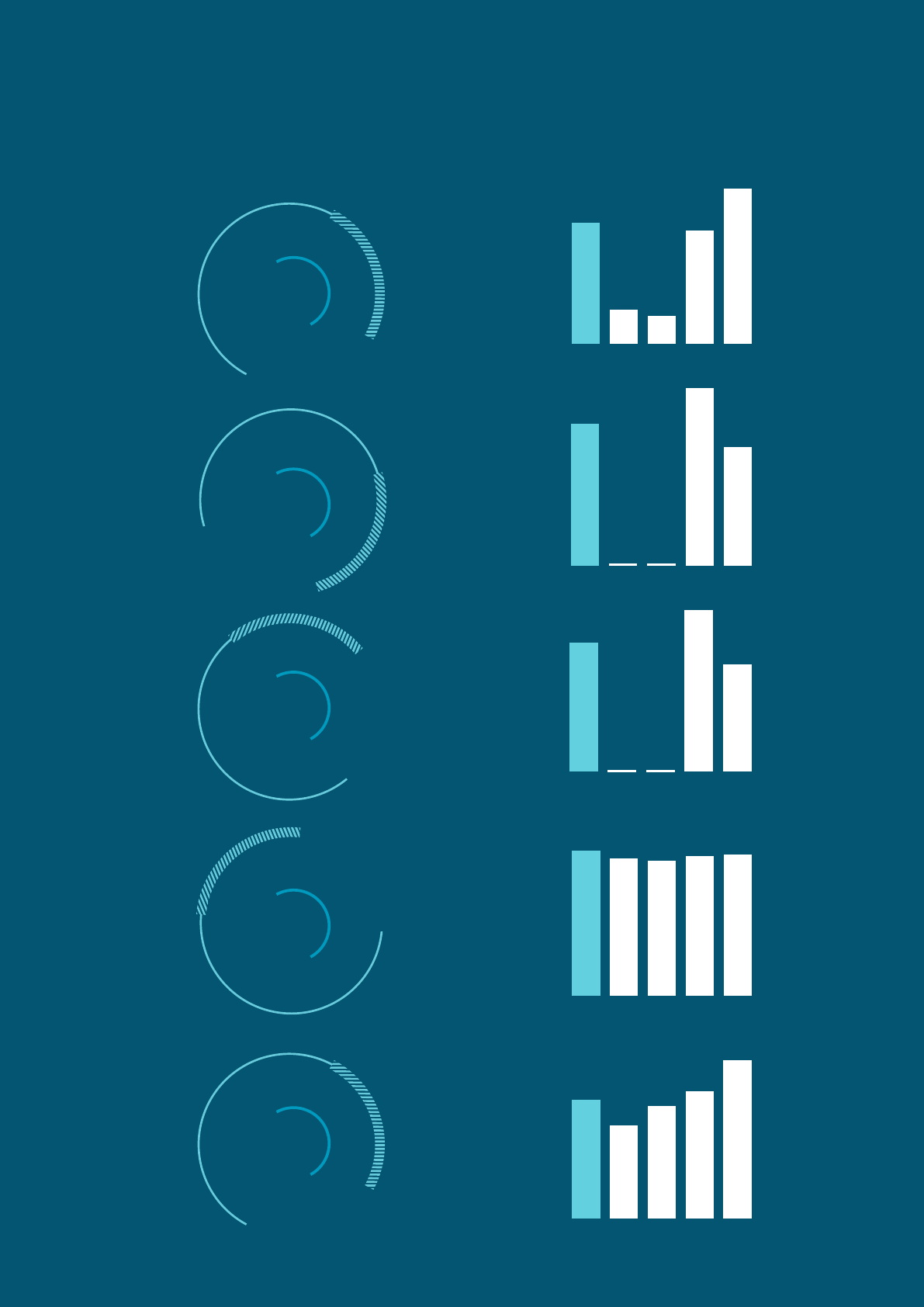
4,207
15,127
19,433
14,211
3,455
5,500
8,250
0,000
0,000
6,600
5 %
7.5 %
0,000
0,000
6 %
160,242
160,179
156,892
159,876
168,355
1.17
0.94
0.83
0.69
0.88
15,127
6,600
%6
168,355
0.88
20202021 2019 20172018
20202021 2019 20172018
20202021 2019 20172018
20202021 2019 20172018
20202021 2019 20172018
T
h
o
u
s
a
n
d
J
D
P
r
e
t
a
x
P
r
o
fi
t
s
o
r
(
l
o
s
s
)
T
h
o
u
s
a
n
d
J
D
D
i
s
t
r
i
b
u
t
e
d
P
r
o
fi
t
s
T
h
o
u
s
a
n
d
J
D
T
o
t
a
l
S
h
a
r
e
h
o
l
d
e
r
s
’
E
q
u
i
t
y
%
D
i
v
i
d
e
n
d
s
P
e
r
S
h
a
r
e
%
S
h
a
r
e
P
r
i
c
e
19
BANK ABC IN JORDAN ANNUAL REPORT 2021

Owners of 1% or more of Bank ABC in
Jordan shares
Name Nationality
Number of
shares
%
Blocked
shares
Mortgaged
shares
% of the
mortgaged
shares from
the total
contribution
Mortgaging
party
Beneciary
Arab
Banking
Corporation
(B.S.C.),
Bahrain
Bahraini 95,676,826 86.979 1,500* - - -
Central Bank of Libya
59.37% – Libya -
Government
Kuwait Investment
Authority 29.69% –
Kuwait - Government
Social
Security
Corporation
Jordanian 2,256,124 2.051 - - - -
Social Security
Corporation
Kuwait
International
Investment
Company
Kuwaiti 1,460,244 1.328 - - - -
Kuwait Investment
Authority 31.911% -
Kuwait - Government
HH Sheikh Saad
Abdullah Al Salem Al
Sabah 9.933% - Kuwait
Kuwait Real Estate
Company KPSC
(AQARAT) 5.747 % –
Kuwait
Shareholder owning
5% and more shares:
• Kuwait International
Investment Company,
owns (18.20% ) –
Kuwait.
• Al-Raghd & Al-Manar
Real Estate Co. owns
(11.90%) – Kuwait.
• Group of Med
Al-Bahar Holding Co.
(AlDahiya Investment
Co., Kuwait Holding Co.,
Al-Rana Gen., Trad. &
Cont. Co., AlShamiya
Investment Co.,
Masader Al-Ofoq Gen.
Trad. and Cont. Co.,
Mawared Al-Ofoq Gen.
Trad. and Cont. Co.,
Al-Deera Holding. Co)
(11.79%) – Kuwait.
* Membership shares
20

21
BANK ABC IN JORDAN ANNUAL REPORT 2021

strategic
report
2021
22

24 Directors’ Report
28 Board of Directors
31 Executive Management
33 ABCI’s Executive Management
23
BANK ABC IN JORDAN ANNUAL REPORT 2021

Directors’ Report
Dear distinguished shareholders,
On behalf of my fellow members of the Board of Directors
of Bank ABC in Jordan (Arab Banking Corporation-
Jordan), it is my pleasure to present the 2021 Annual
Report, which highlights the Bank’s achievements and
consolidated nancial performance for the year ending
December 31, 2021.
Despite the unprecedented challenges and repercussions
of the COVID-19 pandemic, which is still looming over
economies worldwide, including the Jordanian economy,
Bank ABC in Jordan continued its success journey and
managed to maintain its solid nancial position, positive
results and sustainable operations, by continuing to
provide exceptional banking services and products
through multiple digital and conventional channels. This
continued success reects the tangible eorts exerted
by all members of the Bank’s executive management,
guided by the Board’s vision and directives for expanding
the Bank’s operations, enhancing risk management
frameworks and protecting the Bank’s capital and
shareholders’ interests.
The Jordanian economy showed signs of recovery
during the rst nine months of 2021 with a 2.1% increase
in GDP, compared to a -1.5% decrease during the same
period in 2020, as the reopening and resumption of
normal operation in various economic sectors stimulated
movement in the economy. On the other hand, the
ination rate in 2021 increased by 1.2%, compared to 0.3%
during the same period in 2020.
The nancial results for
2021 show that Bank ABC
in Jordan has achieved
good nancial results; as
net prot aer tax reached
JD9.6 million.
Sael Fayez Al Waary
Chairman of the Board of Directors
Directors’
Report
24

Financial Results
Bank ABC in Jordan preserved its solid capital base; as
the capital adequacy ratio reached 19.50% and nancial
leverage ratio reached 10.73%, which signicantly exceed
the ratios required by the Central Bank of Jordan.
Moreover, for the year 2021, Bank ABC in Jordan achieved
robust nancial results; as net prot aer tax reached
JD9.6 million, compared to JD1.22 million in the previous
year. The total income for 2021 grew by 8.5% to JD45
million, compared to JD41.4 million in 2020. This is due to
the increase in interest margin caused primarily by the
decrease in the rate of interest on sources of funds and
increase in other commissions and prots as a result
of the growth in the facilities portfolio, as interest and
banking commissions reached JD40.5 million, compared
to JD37.1 million in 2020; with a 9% increase.
In relation to its nancial position, the Bank’s assets grew
to JD1.23 billion in 2021, with a 4% increase; shareholders’
equity grew by 5% to JD168 million, compared to JD160
million in 2020; and return on equity reached 6%, while
the return on the Bank’s assets reached 0.8%.
Despite all challenges, the Bank’s keenness and prudent
policy for managing its credit portfolios enabled it
to perform well in 2021, as the Bank’s management
continued its eorts to increase the volume of credit
facilities, while maintaining low risk levels by ensuring
all elements of a sound credit decision. As a result, the
credit facilities portfolio in 2021 grew by 6.7% to JD693
million, compared to JD650 million in the previous
year. The qualitative development and improvement
that accompanied this increase conrms the Bank’s
success in maintaining the quality of its credit portfolio
and enhances its ability to manage its assets and
optimize available funds utilisation opportunities, while
maintaining the balance between liquidity, protability
and risk. Furthermore, the Bank was able to increase its
credit facilities portfolio by entering new risk-managed
nancing transactions to improve the quality of its credit
portfolio. This increase was the result of the expansion in
the retail and corporate sectors. The Bank also continued
its eorts to improve the quality of the portfolio by
closely monitoring all facilities accounts.
By the end of 2021, customer deposits grew by 5.6% to
JD723 million, compared to JD684 million in the previous
year; with current and savings accounts making up 15.7%
of the Bank’s total customer deposits; which reects our
customers’ trust in and strong relationship with the Bank.
This growth helped maintain a healthy liquidity ratio of
111.9% by the end of 2021.
These results demonstrate the Bank’s strong nancial
position and its ability to continue to grow and achieve
further protability, despite the challenges presented
by the COVID-19 pandemic. They also reect the
tremendous eorts of the Bank’s Board of Directors,
executive management and employees to implement the
Bank’s strategic plans, in order to maintain this growth
and implement the Bank’s policy of prudent management
of risks and banking liabilities, as part of its strategic
agenda aimed at oering the best-in-class banking
products and meeting customers’ needs in the best
possible way in line with the technological advances in
this sector.
Key Achievements & Main Activities
The Wholesale Banking Group contributed to the national
programmes launched by the Central Bank of Jordan to
support the Jordanian economic sectors aected by the
COVID-19 outbreak. This entailed granting loans to these
sectors, under the National Programme to Contain the
Repercussions of the COVID-19 Pandemic, in addition to
adhering to the directives of the Central Bank of Jordan
regarding the postponement of instalments payable by
businesses adversely impacted by this pandemic.
In collaboration with our Parent Bank in Bahrain, the
Bank is launching a new digital platform for its corporate
customers in line with the rapid advancements in the
elds of digital payments, international trade solutions
The Bank’s total income for
2021 grew by 8.5% to JD45
million, compared to JD41.4
million in 2020.
25
BANK ABC IN JORDAN ANNUAL REPORT 2021

and cash and liquidity management. As part of the Bank’s
Wholesale Banking Digitisation Programme, in-house
solutions will be launched to automate trade and cash
management products, including initiating and approving
requests besides enquiring about foreign trade services,
in addition to cash and liquidity management solutions,
which include several solutions related to payment,
collection, liquidity management and account reporting
services.
Therefore, the provision of digital services and products
will be a qualitative shi in the nature of the services
oered to corporate customers, which will strengthen the
Bank’s status in the local market and positively impact its
market share and prots.
The Wholesale Banking Group will also be launching a
seamless digital onboarding service which will enable
corporate and institutional clients to open an account
with the Bank and complete the “Know Your Customer
(KYC)” journey in under several hours. Through this
user-friendly self-service solution, our corporate banking
clients can track their application status in real-time and
swily access the Bank’s various products and services.
Furthermore, the Bank continued to develop its business
on multiple fronts. Retail Banking Group continued to
develop the Bank’s digital banking services; enhancing the
accessibility and eciency of ABC Digital, our core digital
banking platform, while encouraging customers to use
this service. Through Digital Banking, Bank ABC in Jordan
also launched instant money transfer and receipt services
using “CliQ” system, which features the most advanced
and state-of-the-art instant payment system in Jordan;
allowing customers to send and receive funds between
accounts with all participating banks, besides to and from
electronic wallets in Jordan, instantly and free of charge.
To keep pace with the rapid technological and customer
service advancements, Bank ABC is on track to launch “ila
application”, the digital mobile-only application, in Jordan
in 2022. With the support of Bank ABC in Jordan, this
customer-centric mobile-only oering, aided by cutting-
edge Articial Intelligence and sophisticated Data Analytics,
is expected to appeal to all consumer generations, from
millennials to older age groups, and segments of society.
In the same context, the Bank’s Treasury Department
continued to oer a variety of new services as part of
its strategy of providing outstanding services that meet
our diverse customers’ needs. The Treasury Department
also managed the Bank’s liquidity eectively by providing
the Bank’s nancing needs, while continuing to full its
responsibility in terms of managing interest rate and
foreign exchange risks, keeping them within Group’s
adopted risk appetite.
Social Responsibility
Social responsibility is an essential focus of Bank ABC in
Jordan. It reects the Bank’s corporate identity and is
driven by our belief in the importance of supporting the
local community to achieve social solidarity. Therefore, the
Bank continued to support local community, focusing on
sustainable development activities by, passionately and
with the spirit of giving, adopting several initiatives aimed
at supporting the local community in line with the Bank’s
values and objectives.
Future Outlook & Objectives
At the beginning of 2022, the Bank moved into the new
Head Oce and Main Branch, which meets our current and
future needs and reects Bank ABC in Jordan’s identity
and commitment to putting customers rst. Our new
oces will enable us to maintain our steady performance
as a team; thus, enhancing our success and further
cementing our mark as one of the biggest banking groups
in the region.
Bank ABC in Jordan was
able to maintain its solid
capital base; as the capital
adequacy ratio reached
19.50% and nancial
leverage ratio reached
10.73%, which signicantly
exceed the ratios required
by the Central Bank of
Jordan.
26

The new building has all the necessary elements of
a comfortable and motivating work environment and
provides adequate spaces for various departments to
bolster work performance and communication eciency.
In addition, it boasts state-of-the-art service facilities that
enhance communication and cooperation to the benet
of the Bank’s employees and customers alike.
The new Head Oce was designed in accordance with
the best energy-ecient practices that help reduce the
Bank’s power bill, particularly as the Bank established
a solar power station to power all its buildings and
branches. The building is also equipped with an
environment-friendly lighting system, which further
reduces the Bank’s power bill and meets the Bank’s
sustainability objectives.
In line with its future vision and strategy, the Bank
is striving to strengthen its capital base, enhance
its nancial position and increase its market
competitiveness. It also seeks to maximize its
shareholders’ equity, continue to develop its risk
management practices, and expand its activities
and services in line with technological and digital
advancements. This will see the Bank further embrace
disruptive technologies to improve its oering and invest
in the broad international network of Bank ABC Group.
Finally
Considering the nancial results achieved in 2021, the
Bank’s Board of Directors submitted a recommendation
to the general assembly to distribute dividends to
shareholders at the rate of 6% of the subscribed capital.
On this occasion, I would like to express my heartfelt
gratitude to our shareholders and customers for their
support and trust, which we deeply value and take pride
in. I would also like to extend my appreciation to my
fellow Board members for their sincere commitment and
cooperation, and the Bank’s management and employees
for their dedication in oering our customers the best-
in-class services and tireless eorts, which enabled the
Bank to grow and prosper. I pray to Allah the Almighty to
make 2022 another year of growth and progress for our
beloved organisation and precious country.
May the peace and mercy of Allah be upon you.
Sael Fayez Al Waary
Chairman of the Board of Directors
27
BANK ABC IN JORDAN ANNUAL REPORT 2021

Board of Directors
B.Sc. (Hons) degree
in Computer Sciences,
University of Reading,
United Kingdom.
Mr. Al Waary is the Deputy
Group Chief Executive
Ocer of Bank ABC Group,
with over 30 years of
banking, leadership and
management experience
garnered from the many
senior positions he has
held in both London and
Bahrain.
In addition to his
Chairmanship, Mr. Al
Waary represents the
Bank as Chairman of the
Arab Financial Services
Company, Chairman of ila
Bank Advisory Board and
Chairman of Bank ABC’s
newly acquired subsidiary
in Egypt, BLOM Bank Egypt.
He has previously served
on the Boards of Bank
ABC Egypt and Banco ABC
Brasil.
Mr. Sael Al Waary
Chairman
RC GC TC ‡ ð
MBA in Financial
Management University of
Hull, England.
Bachelor’s degree in
Accounting, Garyounis
University, Benghazi,
Libya.
Mr. Matok is currently
General Manager Long
Term Portfolio since 2012.
Mr. Matok previously held
the position of Deputy
General Manager (Capital
Market) Long Term
Portfolio from 2004 to
2012. During the period
from 1998 to 2004, he was
the senior vice president
(Head of Portfolio
Department) Pak Libya
Holding Co. before that he
was a Financial Analyst
in the Libyan Foreign
Investment Co. Mr. Matok
is the Chairman of ABCI
and also Member of the
board of directors of Bank
ABC Bsc and Pak Libya
Holding Co. Previously he
was the Deputy Chairman
of ABCI and Member of
the board of directors
of Libyan Foreign Bank,
Libyan Foreign Investment
Co., Iskan Co. for Touristic &
Hotel and Asian stock fund.
Mr. Bashir Matok
Deputy Chairman
AC GC NC ‡ ð
Master’s degree in
Economics and Statistics,
University of Jordan.
Bachelor’s degree in
Economics and Statistics,
University of Jordan.
Mr. Al- Halaseh is
currently on the Board of
Directors of Arab Banking
Corporation (Jordan) and
he is the Head of the Audit
Committee. He is also a
Board Member of ABCI.
He had previously held
several senior positions
in the banking sector,
beginning his career at
the Arab Bank – Jordan
and progressing within
the Bank until becoming
branch manager. During
the years from 2001 to
2005, he worked as Chief
Credit Ocer of Credit
Management at Bank ABC
in Jordan, from which he
moved to assume the role
of Head of Credit and Risk
at Bank ABC in Tunisia.
In 2008, Mr. Al- Halaseh
moved to National Bank
of Abu Dhabi as the Head
of Credit and later as the
Head of Banking Business
Risk and Stressed Assets.
In 2013, he became the
Head of Commercial Risk
for the Gulf Region at
the National Bank of Abu
Dhabi.
Mr. Ra’fat Al Halaseh
Director
AC GC RC NC TC ‡ §
Bachelor’s degree in
Finance, Boston College,
Chestnut Hill, MA.
Mr. Zawaideh started his
career as a Credit Ocer
in Banque Francaise De
L’Orient, London- United
Kingdom during the period
from 1995 to 1996, where
his last position was in
International Marketing.
During the period from
1997 to 2012, he worked
at United Iron & Steel
Mfg. Co. plc. as the Chief
Financial Ocer. In 2014,
Mr. Zawaideh joined Steel
Mesh Industry Co., where
he is currently holding
the position of General
Manager. Mr. Zawaideh is
a Board Member of ABCI
and previously was a
Board Member of United
Iron & Steel Mfg. Co. plc.,
Investment House for
Financial Services Co. plc
and First Finance Co. plc.
Mr. Hakam Zawaideh
Director
AC GC NC ‡ §
28

Bachelor’s degree in
Mechanical Engineering,
University of Bridgeport,
Connecticut USA.
H.E. Eng. Amer Hadidi’s
experience extends
across the public, private
and business sectors in
Jordan. H.E. Eng. Hadidi
took on the role of Chief
Executive Ocer at Royal
Jordanian (2012-2014). He
also served as Economic
Advisor to His Majesty
King Abdullah II (2011-
2012), preceded by service
as Minister of Industry and
Trade in three consecutive
cabinets (2007-2011). H.E.
Eng. Hadidi’s previous
experience included
roles at the Ministry of
Transport, the Ministry of
Industry and Trade and
the banking sector.
H.E. Eng. Amer Hadidi
Director
AC GC NC CC ‡ §
Master of Public
Administration, Economic
Policy Management,
Columbia University,
School of International &
Public Aairs - 2016 / USA.
Master of Science,
Banking & International
Finance, City University,
Cass Business School -
2011 / United Kingdom.
Bachelor of Science,
International Business
Studies with Professional
Development, Brunel
University, Brunel
Business School - 2009/
United Kingdom.
Mr. Breish is currently
the Deputy Director
of Financial Markets
Department at Central
Bank of Libya. He was the
Head of External Portfolios
Unit at Central Bank of
Libya and had previously
held the position of
Investment Analyst. Prior
to joining Central Bank
of Libya, Mr. Breish was
Research Intern at Ubs Ag
- Investment Bank in 2008.
Mr. Breish began his career
in 2005 at Libyan Foreign
Bank as Analyst – Intern
and in 2007; he had held
the same position at Aibel
Limited. Mr. Breish has
recently joined the Board
of Directors of Moamalat
Financial Services in Libya
(owned by CBL).
Mr. Abdulrahim Breish
Director
RC CC ‡ ð
MBA in Finance, Fordham
University – 1999, New
York, NY.
BSc. in Mechanical
Engineering, NYU
Polytechnic University –
1991, New York, NY.
Mr. Ammar Khalil has over
20 years of experience in
banking across institutions
in the US and GCC.
Currently he is the Senior
Executive Ocer for Bank
ABC, leading their business
strategy for the UAE.
Prior to this, he served
as the Managing Director
and Head of Coverage for
MENA at Natixis Dubai
leading their Corporate,
Public Sector, Financial
Sponsors, Islamic Banking,
and Financial Institutions
teams. Before Natixis, he
was Head of Institutional
Banking for the MENA
region at HSBC Middle
East Bank. At HSBC, he
was tasked with building
the coverage of Banks,
NBFIs, and Public-Sector
clients. In Kuwait, he held
the position of Group
Head of Institutional
Banking at National Bank
of Kuwait. In the US, he
held various roles at The
Bank of New York, Arab
Banking Corporation NY
Branch, and Arab American
bank looking aer the
correspondent banking
business between the
MENA and US regions.
Mr. Ammar Khalil
Director
RC AC ‡ ð
Higher Diploma in Public
Law, University of Jordan –
1986, Jordan.
Bachelor of Arts in Public
Law, University of Jordan –
1983, Jordan.
Mrs. Nabulsi has long
experience in senior
managerial positions and
consultancies in the banking
industry, she also embodies
strong ties to community
and non-prot organisations
focusing on Educational and
Youth Development Programs.
Currently, she continues her
pursuit of this passion by
serving as a member of the
board of the YMWA where
she is actively engaged in
the management of the
Princess Sarvath Community
College and the Bunnayat
Centre for Special Education.
Formerly, she was CEO of
Jordan Education Initiative
(JEI) between 2013-2017.
She was also the Founder
& Managing Director of
Horizon Banking Consultants
between 2008-2013. Over
her long experience, Mrs.
Nabulsi has held senior
managerial positions at
several banks including
Capital Bank of Jordan as
a Chief Operating Ocer
(AGM-Ops & IT) through
2002-2007, Cairo Amman
Bank from 1990-2001 where
she served as Executive
Manager in Internal Audit &
Credit Risk, Documentation
& Credit Control as well as
Legal, having previously held
many other senior positions
including the position of Credit
Ocer at Bank of Jordan.
Mrs. Nabulsi started her
career with the Ministry of
Transportation Queen Alia Int.
Airport Project as the Head of
Legal Department in 1986 and
with the Ministry of Finance –
Income Tax Dept before that
in 1983. Mrs. Nabulsi is also
a non-practicing Lawyer by
original degree and training.
Mrs. Nermeen Nabulsi
Director
AC GC NC CC ‡ §
29
BANK ABC IN JORDAN ANNUAL REPORT 2021

AC Member of the Audit Committee
GC Member of the Corporate Governance Committee
RC Member of the Risk Committee
NC Member of the Nominations & Compensation Committee
TC Member of the IT Governance Committee
CC Member of the Compliance Committee
‡ Non-Executive
æ Executive
§ Independent
ð Non-Independent
Master’s degree in
Management - Economic,
Sciences and Management
University - Tunisia.
Bachelor’s degree in science
and Mathematics - 1989 /
Tunisia
Mr. Mokhtar is currently the
Group Chief Operating Ocer at
Bank ABC Bahrain, appointed in
May 2019 from Regional Chief
Operating Ocer for MENA to a
new role, Group Chief Operating
Ocer to support the delivery
of the key support areas across
the Group and oversees the
functional and Country COOs
across the Group.
Ismail Mokhtar has had several
senior positions in the banking
sectors and senior roles with
Bank ABC for over two decades.
He served Bank ABC in Tunisia
as the Deputy General Manager
and Chief Operating Ocer
before moving to the Head
Oce in Bahrain as Business
Catalyst and Project coordinator
at Group level in 2015.
Mr. Mokhtar has held past key
positions in ABC in Tunisia,
including being Commercial
Banking Head from 2009 till
2011, General Management
Coordinator and Board of
Directors Secretary from
2006 till 2015. Mr. Mokhtar was
appointed Chief Operating
Ocer and Deputy General
Manager of ABC in Tunisia from
2012 to 2015.
Before joining Bank ABC, Mr.
Mokhtar was the Head of the
Government Bond Desk at the
Treasury Department of Banque
Nationale Agricole (Tunisia) from
which he moved on to Bank ABC
in Tunisia in 2001.
Mr. Mokhtar joined the Board of
Directors of ABCJ in May 2015
and board member of ABCI from
01/03/2016 to 30/4/2018.
Mr. Ismail Mokhtar
Director
AC NC TC RC ‡ ð
Master’s degree
in Commercial and
Administrative Sciences,
Université Saint-Esprit de
Kaslik – 1986, Lebanon.
BA in Elementary
Mathematics, College de la
Sagesse – 1980, Lebanon.
Mr. Touma is currently
the First Vice President
/ Group Retail & Digital
Banking Head at Bank ABC
Bahrain. He had previously
held the positions of FVP
/ Group Retail & Digital
Banking Coordinator and
FVP/ Group Retail Banking
Planning & Development.
Before joining Bank ABC,
he started his banking
career in 1982 with
Banque Libanaise Pour Le
Commerce SAL- Lebanon
where he assumed several
positions from which
he moved to Omnilife
Insurance Company–
Cyprus (UK registered)
as the Head of Business
Development in 1991. He
moved to Banque Libanaise
Pour Le Commerce SAL-
Lebanon (BLCBANK) in 1994
as Head of Retail Products
Division. Mr. Touma served
on the Board of Directors
for Bank ABC in Tunisia
from 2009 until 2014
and Bank ABC in Jordan
from 2015 until 2017. Mr.
Touma joined the Board of
Directors of ABCJ in May
2019.
Mr. Elie Touma
Director
RC ‡ ð
MBA, Ecole Supérieure
des Aaires (ESA) - 1999,
Lebanon.
Bachelor’s degree in
economics, Université
Saint Joseph (USJ) - 1992,
Lebanon.
Mr. Sacre started his
career in 1992 with BNP
PARIBAS “BNP”- Beirut
where he graduated in
positions until he held the
position of Deputy Head
of Corporate Banking. Mr.
Sacre joined Bank ABC in
Tunisia in 2005 as Senior
Credit & Risk Ocer, and
then in 2007 he moved to
Bank ABC Bahrain where
his position was Senior
Remedial Loan Ocer. In
2013, he moved to Bank
ABC in Algeria to assume
the role of Deputy CEO. Mr.
Sacre joined Bank ABC in
Jordan’s Board of Directors
in May 2019. He served
on the Board of Directors
of Bank ABC in Tunisia
(2009-2019) and was the
Chairman of the Audit
Committee - Bank ABC in
Tunisia (2011-2016).
Mr. Jawad Sacre
Director
RC ‡ ð
30

Executive
Management
Mr. George Soa
General Manager
B. Sc. in Business
Administration,
Management, London, U.K.
Mr. George Soa began his
career in banking at HSBC
Jordan in 1990, holding
various positions in Retail and
Corporate Banking until 2001,
when he moved to Societe
Generale de Banque – Jordanie,
where he assumed several
roles in Retail banking, ending
with Retail Banking Manager.
In 2005, Mr. George Soa joined
Capital Bank as Assistant
General Manager / Head of
Personal Banking where he
stayed until joining Bank ABC
in Jordan in August 2009 as
Executive Vice President /
Head of the Retail Banking
Group. Mr. George Soa’s
career progressed at Bank
ABC in Jordan and starting
2015, he began deputizing the
General Manager until being
appointed as Deputy General
Manager in August 2019. Mr.
George Soa assumed the role
of Acting General Manager
starting November 2019
until January 2020, when Mr.
George Soa was appointed as
the General Manager of Bank
ABC in Jordan.
In addition to his roles, Mr.
George Soa has been a Board
Director at ABC Investments
since August 2018, later
becoming Deputy Chairman of
the Board in November 2019,
and was also a Board Member
of Visa Jordan Services
Company from May 2010 until
July 2011.
Mr. Adnan Al Shoubky
EVP/ Head of Support Group
BA in Public Administration
(Major) Computer
Science (Minor), Yarmouk
University; Certied
Internal Auditor (CIA).
Mr. Al Shoubky worked in
Amman Bank for Investment
from 1994- 1996 as an Internal
Auditor. During 1996 – 2006 Mr.
Al Shoubky worked with Arab
Banking Corporation (Jordan)
where his last position was
a Manager in Internal Audit
Department. Then he joined
the Arab Cooperation for
Financial Investments Co.
(ABCI) as the Deputy CEO for
Operations. In February 2009,
Mr. Al Shoubky joined again
Arab Banking Corporation
(Jordan) as Head of Internal
Audit. Since 2014, Mr. Al
Shoubky became Head of
Support Group. He was a
Board Member of ABCI for the
period 1/2014 till 8/2018, Mr.
Al shoubky reappointed as
Board Member of ABCI from
3/11/2019 till now.
Mr. Fadi Haddad
SVP/ Head of Wholesale
Banking Group
MSc. in Financial
Management, Arab
Academy for Financial and
Banking Studies.
Diploma in Financial
Analysis, Institute of
Banking Studies.
BA in General
Management, Mu’tah
University.
Mr. Haddad commenced his
career in the banking sector
in 2000 starting with the
International Islamic Arab Bank
until 2003, where he moved
across several departments
there. In 2004, Mr. Haddad
joined the Arab Banking
Corporation (Jordan) as a
manager in the Corporate
Department, where he stayed
until late 2007, aer which he
moved to the UAE, joining Arab
Bank as a Team Leader within
Corporate Banking division. In
2010, Mr. Haddad joined the
Arab Banking Corporation
(Jordan) once again as a First
Vice President in Corporate
Banking until 2018, when he
assumed his current position
as Senior Vice President/ Head
of Wholesale Banking Group.
Mr. Taj Khomosh
SVP/ Head of Retail Banking
Group
B.Sc. in Business
Administration & Political
science, University of
Jordan
Certied Innovation
Strategy (Global
Innovation Institute)
Executive leadership from
PMI.
Mr. Khomosh started his
career with ANZ Grindlay
Bank in 1999 as a Marketing
Ocer then moved to
Standard Chartered Bank
covering several posts. In
2003 he joined Mashreq Bank
Qatar as Head of Cards &
Marketing Manager, followed
by a tenure at Jordan Ahli
Bank as Head of the Direct
Sales Centers till 2007 when
he joined Arab Bank –Syria
as Head of Branches. Mr.
Khomosh later became
District Manager at Arab
Bank Jordan and Head of
Consumer Banking for Arab
Bank – Syria in 2010. From
2012 to 2016 Mr. Khomosh
was the Deputy CEO - Chief
of Retail Banking at Jordan
Dubai Islamic Bank and in
2016 moved to Mashreq Bank
UAE until 2019 as VP Regional
Manger Dubai. Thereaer, Mr.
Khomosh joined the Housing
Bank of Jordan until April
2020 when he moved to the
Arab Banking Corporation
(Jordan) as Head of the Retail
Banking Group. During his
career, Mr. Khomosh held
board memberships in the
Specialized Leasing Company
from August 2019 to March
2020, and previously in Misk
Brokerage Company from
April 2016 to July 2019
Mr. Khaldoun Ziadat
SVP/ Head of Internal Audit
MBA in Banking and
Finance, University of
Wales / UK.
Mr. Ziadat had worked in
Arab Bank as a Credit Ocer,
Credit Facilities Division/
International Branches from
2000 till 2003. Then he Joined
Cairo Amman Bank to work
in the Audit Department
till 2006. Aer that, Mr.
Ziadat joined Arab Banking
Corporation (Jordan) as Senior
Internal Auditor, where during
the said period he mingled
across many positions until
holding the current position as
SVP/ Head of Internal Audit.
Mr. Khaled Nassraween
SVP / Head of Compliance
Secretary of the Board’s
Compliance Committee
B.Sc. in Accounting,
U n i v e r s i t y o f J o r d a n .
Certied Compliance
Ocer/ Fellow of the
American Academy of
Financial Management
(FAAFM).
Certied Anti-Money
Laundering Specialist.
Fellow of ACAMS.
Mr. Nassraween had worked
across many positions in
External Audit companies
during the period 1985 till
1991, following which he
Joined Cairo Amman Bank
and worked in the Audit
Department until 1998.
Thereaer, Mr. Nassraween
joined Bank of Jordan as
Head of following up Audit’s
Report Unit until 2004 when
he joined the Arab Banking
Corporation (Jordan) as the
Head of Compliance, the role
which he continues to assume
to this date.
31
BANK ABC IN JORDAN ANNUAL REPORT 2021

Mrs. Yara Baddar
SVP / Head of Human
Resources
Secretary of the Board’s
Nominations and
Compensation Committee
Secretary of the Board’s
Corporate Governance
Committee
Master’s in Business
Administration (MBA),
University of Manchester.
M.Sc. HR & Industrial
Relations, University of
Manchester.
Mrs. Baddar began her
career in HR in 2007 when
she joined KADDB as a
Training and Development
Specialist. She later moved
to eSense Soware as a
Training Lead, and later joined
ABC Investments as HR
Manager and Acting Head of
Administration in 2010. Mrs.
Baddar subsequently moved
to Bank ABC in Jordan as Head
of Training & Organisational
Development in 2012, with
her career progressing until
assuming the role of Head of
HR in September 2019.
Mr. Husam Liswi
SVP/ Head of Operations
Management
B.Sc. in Accounting &
Business Administration,
University of Jordan.
Mr. Liswi started his career
in the banking sector in 1989
when he joined Arab Bank. Mr.
Liswi built his career in several
departments, culminating
in becoming VP / Head of
Centralized Trade Finance
Services in 2006, then Head
of Operations Department in
Arab Bank – Algeria in 2010. In
2015, Mr. Liswi joined the Arab
Banking Corporation (Jordan)
as FVP/ Banking Operations,
and he was appointed as SVP
/ Head of Operations in 2016.
Mrs. Aida Saeed
SVP / Head of Consumers
Credit
MBA in Management,
University of Jordan.
Mrs. Saeed joined Bank ABC
in Jordan in 1995 where her
career progressed across
several departments,
the majority being in
the Consumers Credit
Department. In 2009, Mrs.
Saeed became the Retail
& Credit Risk Department
Manager. In October 2015,
she became the Acting
Head of Consumers
Credit Department and
was appointed as FVP
/ Consumers Credit
Department in 2016.
Mrs. Saeed took over as
SVP / Consumers Credit
Department in 2018.
Mr. Fahed Ibrahim
SVP / Head of Treasury
B.Sc. in Economic, Al-
Yarmouk University,
Chartered Financial
Analyst (CFA).
Mr. Fahed joined Bank ABC
in Jordan in 1998 where his
career progressed across
several positions in The
Treasury department. In
October 2018, Mr. Fahed
assumed the role Acting Head
of Treasury until January
2020 he was appointed as
Head of Treasury.
Mrs. Eman Abu Hait
SVP/ Head of Risk
Management
B.Sc. in Banking and
Financial Science, Yarmouk
University.
Ms. Eman Abu-Hait built
an extensive career in
Risk Management at Cairo
Amman Bank, where her
tenure spanned over 20
years. Ms. Abu-Hait’s career
grew in Cairo Amman Bank
where it culminated by
being appointed as Credit
and Market Risk Manager in
2007. In 2013, Ms. Abu-Hait
moved to the Arab Banking
Corporation (Jordan) as Risk
Department Manager, until
2017 when she was appointed
as the Bank’s Head of Risk
Management.
Mr. Faisal Abu Znemah
FVP/ Head of Legal Aairs
The Secretary of the Board
of Directors
Secretary of the Board’s
Audit Committee
B.Sc. in Law, Babel
University – Iraq.
Mr. Abu Znemah started
his career as a legal trainee
during the years 1997 – 1999,
followed by employment
as a freelancer lawyer until
2001, when he worked for the
Housing Bank for Trade and
Finance as a lawyer and legal
advisor until 2006. Thereaer,
Mr. Abu Znemah joined the
Arab Banking Corporation
(Jordan) as lawyer and legal
advisor until June 2017 when
he was appointed as the
acting Head of the Legal
Aairs Department and was
appointed as the Head of the
Legal Aairs Department in
2018. In September 2019, he
became the Secretary of the
Board of Directors of the Arab
Banking Corporation (Jordan)
in addition to his current role.
Mr. Ali Etawi
FVP / Acting Head of
Information Technology
MA in Mathematics,
University of Mou’ta.
Mr. Etawi started his career
as a team leader in R&D
department with Batelco
during the years 1999 – 2002,
then he moved to ABC
Investments covering several
posts in 2002. In 2009 he
joined Bank ABC in Jordan
as Systems & Applications
Development Manager, In
May 2021, Mr. Etawi assumed
the role Acting Head of
Information Technology.
Mrs. Nisreen Hamati
SVP/ Chief Financial Ocer
B.Sc. in Accounting,
Philadelphia University.
Certied Public
Accountant.
Project Management
Professional.
Prior to joining the Arab
Banking Corporation (Jordan)
in April 2016 as CFO, Ms.
Hamati occupied the position
of CFO for Jordan and Iraq
during a 3-year tenure at
Citibank. Ms. Hamati’s career
began in 2000 at Deloitte as
an auditor, from which she
moved on to the banking
sector, occupying the role
of AVP - Country Product
Controller & Deputy MENA
Product Controller at Citibank
Dubai from 2003 until 2007,
at which point she was
appointed as Deputy CFO-VP
in addition to her previous
role. In 2008, Ms. Hamati
joined the Jordan Investment
Trust P.L.V as EVP-Finance &
Administration, later followed
by 3 years as a Program
Support Component Leader
at USAID Jordan Tourism
Development Project. From
2012 till 2013, Ms. Hamati
served as Head of Managerial
Accounting at Bank Al Etihad.
She has been sitting on
the board of JAMA (Jordan
Association for Management
Accounting) an aliate of IMA
since 2018 to date and was
recently appointed as the
board Treasurer.
Mr. Nabeel Qazzaz
SVP / Chief Credit Ocer
MA in Accounting &
Finance, Arab Academy
for Banking and Financial
Sciences.
BA in Banking and
Financial Sciences,
Yarmouk University.
Mr. Qazzaz started his
career in banking with Arab
Bank in 1995 where his
career progressed across
several departments, the
majority being at the Credit
Department. In 2010, he
moved to Capital Bank of
Jordan as the Corporate
Banking Department Manager
aer which he joined Bank
ABC in Jordan in 2012 as the
Credit Review Department
Manager. In March.2019, Mr.
Qazzaz became Acting Chief
Credit Ocer until December
2019 when he was appointed
as the Bank’s Chief Credit
Ocer.
32

Mr. Moataz Maraqa
CEO
BA in Business
Administration,
University of Jordan;
MA in Banking &
Finance, Arab Academy
for Banking Studies.
Mr. Maraqa has more than
29 years’ of experience in
investments and private
banking at Banks and
Financial Institutes. He
is holding the position of
CEO, ABCI.
Board of Directors
• Mr. Bashir Matok – Chairman.
• Mr. George Soa - Deputy Chairman.
• Mr. Hakam Zawaideh.
• Mr. Ra’fat Al Halaseh.
• Mr. Adnan Al Shoubky.
Brief on ABC Investments (ABCI)
ABC Investments was incorporated as a limited liability company
(LLC) in Amman on 25 January 1990. It owns the trademark (ABC
Investments). It is one of the premier nancial institutions of Bank
ABC Group based in Bahrain, and it is fully owned by Bank ABC
in Jordan. Its capital amounts to een million and six hundred
thousand Jordanian Dinars JD15,600,000 divided into 15,600,000
shares, each valued at one Jordanian Dinar. ABC Investments
is a member of the capital market institutions that performs
its activities through qualied and accredited technical and
administrative personnel of very high eciency.
ABC Investments was one of the rst nancial service companies
licensed by the Jordan Securities Commission (JSC) to work as:
- Financial broker in local, regional and international markets.
- Margin nancing.
- Financial advisory.
- Issuance Management/ best eorts.
- Dealer.
- Investment Management.
ABC Investments (ABCI) Executive
Management
33
BANK ABC IN JORDAN ANNUAL REPORT 2021

operations
Review of
34

operations
36 2021 Business Results
44 Future Developments Plan for 2022
46 Shareholdings of the Chairman and Members
of the Board
47 Representation of the Board of Directors
35
BANK ABC IN JORDAN ANNUAL REPORT 2021

Review of Operations
Despite all challenges,
the Bank’s keenness
and prudent policy for
managing its credit
portfolios enabled it to
perform well in 2021.
Bank’s Achievements in the Fiscal Year
Directors’ Report on the Bank’s Business Results in
2021
The Board of Directors of Bank ABC in Jordan is pleased
to extend its thanks and appreciation to the Bank’s
shareholders and present to you its report on the
nancial statement for 2021, Bank’s achievements and
the activities, services and products oered during the
previous year. The Bank continued to implement its
strategy of oering its customer the best services in
accordance with the international best practices and
technologies by developing its electronic services and
making them more user-friendly and ecient through
ABC Digital.
Despite the ongoing economic and political challenges
imposed by the COVID-19 pandemic on the Jordanian and
global economy, Bank ABC in Jordan has demonstrated
a high level of resilience in dealing with the pandemic;
as it was able to sustain its operations in an ecient
and eective manner that ensures the safety of its
employees and provision of the best services to its
customers, while complying with the instructions of the
Central Bank Of Jordan, including continuing to postpone
the installments payable by the sectors aected by
the COVID-19 pandemic. The Bank also implemented a
number of measures to maintain the quality of its credit
36

facilities portfolio and ensure comfortable liquidity ratios,
in addition to increasing its investment in digital banking
solutions and electronic banking services oered to
individuals and corporates alike.
These results conrm the Bank’s solid position and its
ability to continue to grow and achieve further prots,
despite the fact that the Bank’s performance has been
aected by the prevailing economic climate in the
Kingdom and the region in general due to the COVID-19
pandemic. These results reect the great eorts exerted
by the Bank’s Board of Directors, executive management
and employees to achieve the Bank’s strategic plan, in
order to continue this growth and implement the Bank’s
policy of prudent management of risks and banking
liabilities, as part of its future strategies and plans
aimed at oering more banking products and meeting
customers’ needs using the best methods in line with the
technological advances in this area.
At the beginning of 2022, the Bank moved to the new
Head Oce and main branch which meets its current and
future needs and reects Bank ABC in Jordan’s identity
and well-established values that put customers rst,
while continuing its steady performance as a team; thus
enhancing our success and distinction as one of the
biggest banking groups in the region. The new building
has all the necessary elements of a comfortable and
motivating work environment and provides adequate
spaces for various departments to increase working and
communication eciency, in addition to customer and
employee service facilities that enhance communication
and cooperation to the benet of the Bank and its
customers alike. The new Head Oce was designed in
accordance with the best energy-ecient practices that
help reduce the Bank’s power bill, particularly as the
Bank established a solar power station to provide power
to all Bank’s building and branches, in addition to the
environment-friendly lighting system in the new building
and Main Branch to further reduce the electricity bill and
enhance the sustainability of the Bank’s objectives.
Financial Results
Bank ABC in Jordan continued to maintain its solid and
healthy nancial position; as the capital adequacy ratio
reached 19.50% and nancial leverage ratio reached
10.73%, which signicantly exceed the ratios required by
the Central Bank of Jordan. Moreover, the nancial results
for 2021 show that Bank ABC in Jordan has achieved
good nancial results; as net prot aer tax reached
JD9.6 million, compared to JD1.22 million in the previous
year and the total income for 2021 grew by 8.5% to
JD45 million, compared to JD41.4 million in 2020; due to
the increase in interest margin caused primarily by the
decrease in the rate of interest on sources of funds and
increase in other commissions and prots as a result
of the growth in the facilities portfolio, as interest and
banking commissions reached JD40.5 million, compared
to JD37.1 million in 2020; with a 9% increase.
In terms of the nancial position, The Bank’s assets grow
to JD1.23 billion in 2021, with a 4% increase, shareholders’
equity grow by 5% to JD168 million, compared to JD160
million in 2020, and return on equity reached 6%, while
the return on Bank’s assets reached 0.8%.
By the end of 2021, customer deposits grew by 5.6% to
JD723 million, compared to JD684 million in the previous
year; with current and savings accounts making up 15.7%
of the Bank’s total customer deposits; which reects
customers’ trust in and strong relationship with the Bank.
This growth helped maintain a healthy liquidity ratio of
111.9% by the end of 2021.
37
BANK ABC IN JORDAN ANNUAL REPORT 2021

Credit Facilities Portfolio
Despite all challenges, the Bank’s keenness and prudent
policy for managing its credit portfolios enabled it
to perform well in 2021, as the Bank’s management
continued its eorts to increase the volume of credit
facilities; while maintain low risk levels by ensuring all
elements of a sound credit decision. Therefore, the
credit facilities portfolio in 2021 grew by 6.7% to JD693
million, compared to JD650 million in the previous year, in
addition to the qualitative development and improvement
that accompanied this increase, which conrms the
Bank’s success in maintaining the quality of its credit
portfolio and enhances its ability to manage its assets
and optimize available funds utilisation opportunities,
while maintaining balance between liquidity, protability
and risk. Furthermore, the Bank was able to increase
its credit facilities portfolio by interring into new risk-
managed nancing transactions to improve the quality
of its credit portfolio. This increase was the result of the
expansion in the retail and corporate sectors. The Bank
also continued its eorts to improve the quality of the
portfolio by closely monitoring all facilities accounts and
taking the necessary action to address accounts with
indicators of possible default.
Retail Banking
Despite the challenges that had been imposed
by COVID-19 pandemic in 2021, the Bank remained
committed, through its Retail Banking Group (RBG), to
implementing its strategic plans, aiming at developing
its products and services to meet the various needs of
its customers from, both, the public and private sectors,
which eventually served the Jordanian society.
RBG continued developing its electronic banking services
and encouraged its customers to use them, such as ABC
Digital, which enables customers to remotely carry out
their banking transactions in a user-friendly and safe
manner. Moreover, customers were motivated to use
contactless payment tools by not only providing them
with advanced banking cards that oer latest security
features and that can be used wirelessly, but also by
educating them on how to use them.
Having mentioned the above, it should be emphasized
that in 2021, RBG also oered its customers highly
ecient Automated Teller Machines (ATMs) with
advanced features that align with the Bank’s digitization
strategy and launched the CliQ service that has become
the most advanced and state-of-the-art payment service
in Jordan, that allows funds transfer either between
accounts held with all participating banks, or between
electronic wallets in Jordan instantly and free of charge.
To keep pace with the rapid technological and digital
development and for a better customer service, plans
were set, and necessary measurement were put in place
to launch “ila” application, which is a digital user-friendly
application that is based on articial intelligence and
data analysis technologies, which will be available in 2022
using smart phones only. This revolution is expected to
allow the bank to attract and serve a wider customer
base, starting with millennials, and ending with other
segments of the Jordanian society.
It is worth mentioning that RBG includes the Credit
Department, the Collection Department, Branches’
management and Business Development Department,
the Product Development and Marketing Department,
Sales Department, and Digitization Department, through
which the Group has been able to oer a variety of
distinctive services to individuals from all groups of the
Jordanian society that meet their banking needs.
The mentioned retail divisions have also enabled the
Group to acquire new customers and strengthen the
loyalty of existing ones, which helped in the achievement
of a signicant growth in sales and in an improvement
in customer satisfaction while maintaining risk at low
level, which was translated into an increase in the bank’s
prots despite the dicult situation imposed on various
economic sectors by the COVID-19 pandemic.
The Retail Banking
Group continued its
development of its digital
banking services; making
them more accessible and
ecient, by developing
its online banking service
(ABC Digital).
38

The Bank also continued oering its traditional banking
services and products to individuals through its twenty-
four branches that are located across the Kingdom, such
as deposits, remittances, loans, in addition to products
that are tailor-made for specic segments, such as the
clinic nancing loan for doctors, Ultimate account, Innite
and Signature cards that target the elite segment,
through which customers receive worldwide privileges,
such as free access to VIP lounges at airports, concierge
services and travel insurance, and more and more
privileges that met their aspirations.
On the other hand, in 2021 the Bank through its
RBG focused on social media (SM) platforms due to
their signicance in communication and engagement
creation by launching several promotional campaigns
on the Bank’s ocial Facebook and Instagram brand
pages, such as “Fawazir Ramadan”, “Eid Al Adha” and
“Answer and Win” campaigns, which called the public
to subscribe to the Bank’s SM pages and to participate
in those campaigns in order to win many prizes. This
contributed unprecedently to a noticeable increase in the
number of the bank’s fans on SM and to the elevation of
engagement level with the public.
Finally, in 2021 the Bank was as active in supporting
local community as it was in supporting its customers.
This was evident through RBG’s sponsorship to several
social and developmental events and activities in Amman
and other governorates including, but not limited to
its sponsorship to IFEX, the celebration of the rst
centenary of the Jordanian state “Centennial Backpack
Initiative” and the COVID-19 Media Observatory of the
National Forum for Awareness and Development.
Wholesale Banking
The Wholesale Banking Group includes the Large
Enterprises Department and SMEs Department, in
addition to the Financial Institutions Department and
Transaction Banking Unit.
The Group oers a distinctive set of comprehensive
banking solutions and services that cater to the needs
and activities of the Bank’s customers operating in
various economic sectors, as well as all small, medium
and large enterprises in Jordan and abroad, through a
network of local branches and Bank ABC Group’s external
branches across the world, in addition to a network of
correspondent banks in various countries.
In line with the Bank’s approach, the Wholesale Banking
Group’s strategy seeks to expand its customer base
by attracting new customers from promising economic
sectors, with a focus on companies that operate in
devensive sectors as well as blue-chip companies and
government and quasi-government corporations, while
maintaining the quality of the portfolio. The Wholesale
Banking Group also aims to increase its share of
operating accounts and focus on trade nance and
ancillary business that generate commissions and prots
from indirect facilities. The Group aspires to develop
digital banking channels with a key focus on increasing
the number of customers interacting through these
channels; in order to save them time, and enable them to
carry out a wide array of nancial transactions anytime
and anywhere in a secure and innovative manner.
The Group will continue to upgrade existing services
and launch new services to keep pace with the rapidly
changing business environment.
Considering the ongoing impact of the COVID-19
pandemic on the various economic sectors in the
Kingdom, the Bank continued to oer loans as part of
the National Program to Contain the Repercussions of
COVID-19 launched by the Central Bank of Jordan. Further,
and in line with CBJ’s instructions and circulars regarding
the postponement of installments payable by aected
companies, the Bank has complied with said instructions.
Treasury
The Treasury Department oers a range of services to
retail and corporate customers to meet their various
nancial requirements, including foreign exchange,
money market, capital market and safe custody of their
securities, in addition to providing various investment
solutions to hedge for market risks of uctuations in
exchange and interest rates.
In light of the challenges imposed on the local and
global market in 2021 as a result of COVID-19 pandemic,
which aected many economic sectors, the Treasury
Department was able to eectively manage the Bank’s
liquidity by providing the Bank’s nancing needs, while
continuing to full its responsibility in terms of managing
interest rate and foreign exchange risks in order to
keep them within the Group’s adopted risk appetite. The
Treasury Department continuously strives to oer a
variety of new services as part of its strategy of oering
outstanding services that meet the various needs of
Bank’s customers.
39
BANK ABC IN JORDAN ANNUAL REPORT 2021

Risk Management and Internal Systems’ Control
Bank ABC in Jordan has solid and eective control
systems, in addition to its prudent policies in terms
of credit granting, nonperforming debt management,
provisions policy, expected credit loss volume and
liquidity and risk management, as well as policies relating
to the business continuity management plan to ensure
the continuity of the Bank’s businesses during times of
crisis.
The Bank’s Board of Directors has emphasized the
importance of the control role by setting up several
committees of the Board of Directors, including the
Risk Management Committee, Corporate Governance
Committee, Nomination and Remuneration Committee
and Audit Committee, all of which have clear control
functions that assist the Bank in periodically and
eectively assessing the control role.
In 2021, the Risk Management Department continued to
implement the risk strategy developed and approved by
the Bank’s Board of Directors for the years 2021-2023,
which addresses methods of measuring and managing
all nancial and non-nancial risks, including credit risk,
market risk, liquidity risk, interest rate risk, concentration
risk, operational risk and IT risk, in addition to ensuring
that the business results relating to these risks remain
within the Bank’s acceptable risk appetite and in line with
relevant regulations.
In addition, the Bank was able to maintain a solid capital
base by maintaining regulatory capital adequacy and
liquidity ratios that exceed the minimum ratios required
by the Central Bank of Jordan and Basel Committee, as
well as stress testing (sensitivity analysis) and scenario
testing in accordance with relevant instructions of the
Central Bank of Jordan.
In 2021, the Bank continued to apply IFRS9 requirements
by implementing the policies and methodologies
developed by the parent organisation in Bahrain to
comply with the requirements of this standard, as
well as the Board of Directors’ approval of the policies,
methodologies and bases related to the calculation of
expected credit loss (provisions) in accordance with IFRS9
requirements and in line with the relevant instructions of
the Central Bank of Jordan.
Technological Developments
Based on Bank ABC’s comprehensive strategy and future
vision of the need to provide its services to its customers
anywhere and at any time and keep pace with the
latest technological developments in all sectors in line
with the customers’ desires and conduct, as well as the
importance of adapting to the digital and technological
trends in place, the Bank’s IT Department has developed
and improved the bank’s infrastructure in accordance
with international best practices, and provided
technological and technical support through the serious
work of the IT team in various departments and sections,
in addition to ensuring the continuity and sustainability
of the bank’s outstanding services in a exible manner to
enable the Bank to carry out its business to serve as a
model by delivering strong performance levels across all
its channels and branches. Bank ABC’s IT Department is
moving quickly to lead the digitisation of Jordan’s banking
sector as part of consistent and comprehensive scientic
methodologies to ensure the provision of better and
timely services to the Bank’s customers in Jordan.
Human Capital Management and Focus On Talent
Driven by its belief in the importance of human resources
as the key pillar of business success, and to keep pace
with the realities and conditions of the market and the
challenges of recruiting talents and in order to retain
its competent employees, Bank ABC in Jordan updated
a number of its policies relating to human resources, in
order to encourage the retention of competent sta.
The Bank also amended and updated the subsidiary
organisational structures of a number of departments
and amended the relevant job description cards in line
with work requirements, which achieved a more uid
ow of work and better advancement opportunities
for employees, while also ensuring compliance with the
requirements of regulatory and control bodies.
The Human Resources Department also ensured the
continuity of self-development and enhancement and
development of knowledge and competencies in light
of the limited face-to-face training opportunities, while
observing social distancing requirements under the
current circumstances created by the COVID-19 pandemic.
40

This was done by increasing distance interactive training
activities for employees, including training programmes
that cover new developments in the banking industry and
relevant regulations, which resulted in optimal utilisation
of all the abilities of the Bank’s human resources as was
reected in their performance.
In light of business continuity requirements and public
interest, the Human Resources Department has
constantly kept employees up to speed on the defense
orders related to the COVID-19 pandemic, and provided
them with the necessary explanations and clarications
to ensure full compliance and implementation of these
orders, in addition to providing health and safety
guidelines and explaining the correct procedures to be
followed, as well as the extensive education on infection
prevention measures through regular circulars.
To keep its ongoing approach of fully and thoroughly
implementing the instructions of control bodies,
particularly the instructions of the Central Bank
of Jordan, the Bank has continued to implement
its executive action plan in order to implement the
instructions of the Corporate Governance Code, by
updating and implementing all the required policies
in accordance with this Code, in addition to taking
the necessary steps to full the requirements of the
Governance and Management of Information and Related
Technologies Instructions.
Business Continuity Management
Bank ABC in Jordan continuously strives to be a leading
bank that oers its customers with uninterrupted
banking services by adopting a crisis management
and business continuity strategy that includes a set of
objectives based on the Bank’s strategic vision that will
be completed this year.
Furthermore, the Bank periodically updates its business
continuity plan, which is based on a set of operational
principles and rules that ensure immediate response to
emergencies in the event of any crisis or disaster, in order
to continue the provision of reliable banking services to
customers with high eciency that ensures customer
satisfaction. This is achieved by communicating with
the relevant employees in various departments of the
Bank to update the business continuity plans and review
the results of the business impact analysis of Bank’s
regulations and procedures.
Since the rst outbreak of COVID-19, Bank ABC in Jordan
has been managing the pandemic through the Crisis
Management Team of the executive management, which
has been managing and operating the Bank in line with
the directions and guidelines issued by the Central Bank
of Jordan during this pandemic. The team also addressed
the COVID-19 pandemic and implemented a number of
decisions and actions to ensure the continuity of Bank’s
activities and operations under the following main
themes:
· Operational Resilience: The Bank has activated
the COVID-19 emergency plan which includes
implementing the best health practices and relevant
precautions in all Bank’s buildings and branches. In
accordance with CBJ’s instructions regarding the
maximum permissible operating capacity during the
pandemic, the Bank divided its employees into three
teams in various locations, such that the rst team
works in the Head Oce, the second in the Bank’s
The Bank is keen on
technological innovation
and the provision
of the latest digital
banking services to its
customers.
41
BANK ABC IN JORDAN ANNUAL REPORT 2021

business continuity site and the third one works
remotely (from home).
· Financial Resilience and the Impact of COVID-19 on
Bank Customers: The Bank has been monitoring its
nancial situation, particularly liquidity, as well as
liquidity ratios; in order to ensure that they remain
within the Bank’s acceptable risk appetite. In addition,
the Bank has been in constant communication with
its customers, in order to meet their needs and
provide the necessary support and nancing to
aected customers in accordance with the relevant
instructions of the Central Bank of Jordan.
Information and Cyber Security
Cyber security is a top priority of Bank ABC in Jordan, in
order to create a safe banking environment to protect the
nancial and personal data of customers and employees.
In line with the instructions of its parent organisation in
Bahrain and laws and legislations enforced by legislative
authorities and the Central Bank of Jordan, the Bank has
adopted the ISSP programme to support and protect
the main pillars of information security and protection.
This programme will be implemented in the upcoming
period in accordance with international best practices and
standards in this eld.
The Bank always ensures that it provides its employees
with the best training courses and workshops; to develop
their security sense, in addition to delegating relevant
employees to participate in local and international
conferences relating to information security and
protection, including the Bank’s participation in
workshops on the development of a national strategy for
dealing with cyber threats.
Bank ABC in Jordan’s Share Performance in 2021
Opening
Price
0.70
Day trading
Volume High
117.028
shares
Closing
Price
0.88
Day Trading
Volume Low
3
shares
Change 26% High Days 69
Year High 0.95 Low Days 67
Year Low 0.63
Days without
Change
72
Trading
Volume
JD1,378,578
Traded
Shares
1,759,271
shares
Trading
Days
208 days
- Bank ABC in Jordan’s share year-end price for
2021 was JD0.88 / share, with an increase of
JD0.18 / share compared to JD0.70 / share at the
beginning of the year.
- The highest share price was JD0.95 / share on
8/7/2021, and the lowest share price was JD0.63 /
share on 22/3/2021.
- The share trading volume was JD1,378,578, and
the number of traded shares was 1,759,271 shares
through 1,692 contracts traded in 208 days.
- The day high was 117,028 shares, and the day low
was 3 shares.
- The share closing price was up in 69 days and
down in 67 days, and the number of days without
change was 72 days.
ABC Investments (ABCI)
The Arab Co-operation Financial Investments Co. is a
wholly owned subsidiary of the Arab Banking Corporation
(Jordan) and its investment arm in the Amman Stock
Exchange, regional and international nancial markets,
and is licensed by the Jordan Securities Commission (JSC)
to oer all nancial brokerage services in local, regional,
and international markets. Since its establishment, the
Company has been occupying a leading position among
brokerage companies in Jordan, and is characterised by
its diversied products, professional team and leading
services. Its purposes include conducting brokerage
activities on behalf of its customers in all markets
worldwide, in addition to providing nancial advice for
investment in securities and management of new issues
of securities.
The Company has continued its progress as a key
brokerage company in the local market, in line with its
vision of becoming the rst choice for investment and
brokerage locally, regionally, and globally, despite the
ongoing diculties and challenges in the region in light of
the global crisis. In line with this vision and leadership in
product oerings, the Company continues to develop its
product base and update its systems to provide the best
services for its customers and maximize their options to
meet all their investment needs.
Despite the dicult conditions worldwide, particularly
those caused by the COVID-19 pandemic, and the
diculties faced by the nancial sector in general and the
Jordanian nancial market in particular, the Company was
able to maintain its prot patterns and achieved JD3.8
million in revenue in 2021. The Company’s management
achieved its objectives by eciently managing its
42

assets and liabilities and minimizing its credit, liquidity
and protability risks, so as to increase its prots and
maintain the level of services provided to its customers.
Despite the erce competition in the market, the
Company maintained its position as a leading brokerage
company in the nancial sector, ranking sixth among the
y-ve brokerage companies operating in the Amman
Stock Exchange. It also increased its market share to
4.7%; as its trading volume in 2021 reached approximately
JD190 million, thanks to the Company’s leading policy in
the eld of brokerage and investment management, its
consistent services and its eorts to develop its product
base and meet all the investment needs of its customers,
thus enhancing their trust in it and encouraging them to
continue to invest through it.
The Company also continued its hedging policy to avoid
the repercussions of the COVID-19 pandemic and the
resulting nancial crisis, making sure that it maintains
the required liquidity throughout the previous year and
continuing to provide the best services for its clients at
all times, which helped the Company run its operations
according to its cash ow management plan. The
Company also created a provision for expected credit loss
in accordance with IFRS9, which; by the end of the year;
reached JD4.3 million.
43
BANK ABC IN JORDAN ANNUAL REPORT 2021

The Bank as part of its future vision and strategy aspires
to achieve the following objectives in the upcoming years:
· Maximizing shareholders’ equity and return.
· Strengthen the Bank’s capital base and enhance its
nancial position.
· Enhancing Bank’s competitiveness and increasing its
market share in the banking sector.
· Building a wide customer base that is focused on
attracting stable low-cost deposits.
· Expanding the activities of the Bank in Jordan and
growing its business throughout the Kingdom.
· Increasing the bank’s retail loans portfolio and its
market share in this area.
· Expanding SME banking services and increasing
nancing for self-employed customers.
· Expanding the corporate facilities portfolio
notwithstanding the quality of this portfolio, to
better manage the size of non-performing loans by
maintaining a subdued level of risk.
· Expanding the qualitative and quantitative investment
services to service local and international investors.
· Upgrading certain branches to provide better
customer services.
· Utilising bank ABC’s multinational network to provide
wider packages of banking services.
· Increasing eciency whilst maintaining the highest
quality of services,
· Keeping pace with technological and digital advances
utilising modern technology to ensure better services.
· Keeping pace with digital services and advancements
through launching the latest technologies for Bank’s
customers applications, such as “ila application” and
other applications.
· Continuation of risk management development in line
with the Basel requirements raising awareness on all
types of banking risks.
· Strengthening and stimulating our human resources
by securing continuous professional development
opportunities.
· Increasing training and qualication activities in order
to achieve high levels of performance.
· Highlighting competencies and leadership qualities in
the Bank’s human resources, and working to retain,
enhance, develop and polish their abilities and skills in
the best possible way.
· Participating in local community development.
· Implementing the necessary precautionary measures
to safeguard the bank’s employees and customers
by following the instructions of the ocial authorities
regarding the COVID-19 pandemic.
· Continuously striving to mitigate the burdens of the
COVID-19 pandemic on aected customers, complying
with relevant instructions of the Central Bank of
Jordan.
Future Developments Plan for 2022
44

45
BANK ABC IN JORDAN ANNUAL REPORT 2021

Shareholdings of the Chairman and
Members of the Board
Name Nationality Number of Shares
As of
31/12/2021
As of
31/12/2020
Arab Banking Corporation (B.S.C.) Bahrain, represented
by Mr. Sael Al Waary
Chairman Bahraini
Jordanian
Arab Banking
Corporation
(B.S.C.) shares
95,676,826
Arab Banking
Corporation
(B.S.C.) shares
95,676,826
Arab Banking Corporation (B.S.C.) Bahrain, represented
by Mr. Ismail Mokhtar
Director Bahraini
Tunisian
Arab Banking Corporation (B.S.C.) Bahrain, represented
by Mr. Elie Touma
Director Bahraini
Lebanese
Mr. Bashir Matok Deputy Chairman Libyan 550 550
Mr. Ra’fat Al Halaseh Director Jordanian 12,425 12,425
Mr. Hakam Zawaideh Director Jordanian 350,000 330,000
H.E. Eng. Amer Hadidi Director Jordanian 2,000 2,000
Mr. Abdulrahim Breish Director Libyan 500 500
Mr. Ammar Khalil Director American 500 500
Mrs. Nermeen Nabulsi Director Jordanian 500 500
Varner Holdings Limited, represented by:
Mr. Jawad Sacre
Director Jersey
Lebanese
694 694
46

Representation of the Board of Directors
The Board of Directors of Bank ABC in Jordan represents, as far as it knows and believes, that there are no fundamental
issues that could aect the Bank’s ability to continue its activity throughout the next scal year of 2022. The Board also
represents its responsibility for preparing the nancial statements; that the information cited in the Board of Directors’
Report is in line with the enclosed nancial statements; and that the Bank has an eective and ecient Internal Control
System. The Board of Directors of Bank ABC in Jordan acknowledge that they have not received personally or any of their
relatives any materialistic or in-kind benets during their work at the Bank and have not disclosed them for the year 2021.
Arab Banking Corporation
(B.S.C.) Bahrain, represented
by Sael Al Waary
Chairman
Bashir Matok
Deputy Chairman
Ra’fat Al Halaseh
Director
Hakam Zawaideh
Director
Nermeen Nabulsi
Director
H.E. Eng. Amer Hadidi
Director
Abdulrahim Breish
Director
Ammar Khalil
Director
Arab Banking Corporation (B.S.C.)
Bahrain,
represented by
Ismail Mokhtar
Director
Arab Banking Corporation (B.S.C.)
Bahrain,
represented by
Elie Touma
Director
Varner Holdings Limited,
represented by
Jawad Sacre
Director
Representation of the Authenticity of the Financial Statements
The Management of Bank ABC in Jordan represents the authenticity, accuracy and precision of the information and
nancial statements cited in this report.
Sael Al Waary
Chairman
George Soa
General Manager
Nisreen Hamati
Financial Controller
47
BANK ABC IN JORDAN ANNUAL REPORT 2021

results
Financial
48

50 Independent Auditors’ Report
56 Consolidated Statement of Financial Position
57 Consolidated Statement of Prot or Loss
58 Consolidated Statement of Comprehensive Income
59 Consolidated Statement of Changes in Owners’ Equity
60 Consolidated Statement of Cash Flows
61-153 Notes to the Consolidated Financial Statements
49
BANK ABC IN JORDAN ANNUAL REPORT 2021

Independent Auditors’ Report
Report on the Audit of the Consolidated Financial
Statements
Opinion
We have audited the consolidated nancial statements
of Arab Banking Corporation (Jordan) (the “Bank”) and
its subsidiary (together the “Group”), which comprise
the consolidated statement of nancial position as at
December 31, 2021, and the consolidated statement
of prot or loss and other comprehensive income,
consolidated statement of changes in equity, and
consolidated statement of cash ows for the year and
notes to the consolidated nancial statements, including
a summary of signicant accounting policies.
In our opinion, the accompanying consolidated nancial
statements present fairly, in all material respects,
the consolidated nancial position of the Group as
of December 31, 2021, and its consolidated nancial
performance and its cash ows for the year in accordance
with International Financial Reporting Standards (IFRSs)
as adopted by the Central Bank of Jordan.
Basis for Opinion
We conducted our audit in accordance with International
Standards on Auditing (ISA). Our responsibilities under
those standards are further described in the Auditor’s
Responsibilities for the Audit of the Consolidated
Financial Statements section of our report. We are
independent of the Group in accordance with the
International Ethics Standards Board for Accountants’
Code of Ethics for Professional Accountants (IESBA Code)
together with the ethical requirements that are relevant
to our audit of the nancial statements in Jordan, and
we have fullled our other ethical responsibilities in
accordance with these requirements and the IESBA Code.
We believe that the audit evidence we have obtained
is sucient and appropriate to provide a basis for our
opinion.
Other Matter
The accompanying consolidated nancial statement
are a translation of the original consolidated nancial
statements, which are in the Arabic language, to which
reference should be made.
Key Audit Matters
Key audit matters are those matters that, in our
professional judgment, were of most signicance in
our audit of the consolidated nancial statements of
the current year. These matters were addressed in
the context of our audit of the consolidated nancial
statements as a whole, and in forming our opinion
thereon, and we do not provide a separate opinion on
these matters.
We have fullled the responsibilities described in the
Auditor’s responsibilities for the audit of the consolidated
nancial statements section of our report, including in
relation to these matters. Accordingly, our audit included
the performance of procedures designed to respond to
our assessment of the risks of material misstatement of
the consolidated nancial statements. The results of our
audit procedures, including the procedures performed
to address the matters below, provide the basis for our
audit opinion on the accompanying consolidated nancial
statements.
AM/ 003305
To the Shareholders
Arab Banking Corporation (Jordan)
(A Public Shareholding Limited Company)
Amman – The Hashemite Kingdom of Jordan
50

Independent Auditors’ Report
For each matter below, our description of how our audit addressed the matter is provided in that context.
Key Audit Matters How Our Audit Addressed the Key Audit Matter
1- Impairment of carrying value of the credit
facilities in accordance with IFRS 9
The Group’s credit facilities are stated in the statement
of nancial position at JD693 million as at December 31,
2021. The expected credit loss (ECL) allowance was JD61
million as at this date, which comprised an allowance
of JD16 million against Stage 1 and 2 exposures and an
allowance of JD45 million against exposures classied
under Stage 3.
The audit of the impairment of credit facilities is a key
area of focus because of their size (representing around
56% of total assets) and due to the signicance of the
estimates made and judgments applied in classifying
credit facilities into various stages, and determining
related allowance requirements and the complexity of
the judgements, assumptions, and estimates used in
the Expected Credit Loss models. Refer to Note (2) to
the consolidated nancial statements for the accounting
policy, Note (4) for critical judgements and estimates
used by management, and Note (40) for disclosures
about credit risk.
The Group recognizes allowances for expected credit
losses (ECLs) at an amount equal to 12-month ECL (Stage
1) or full lifetime ECL (Stage 2).
A loss allowance for full lifetime ECL is required for a
nancial instrument if the credit risk on that nancial
instrument has increased signicantly since initial
recognition. It is compared to the ECL amount calculated
according to the instructions of the Central Bank of
Jordan, and the higher of the two amounts is recorded
aer excluding credit exposures with/guaranteed
by the Jordanian government, or any other special
arrangements with the Central Bank of Jordan.
We obtained a detailed understanding of the Group’s
credit facilities and nancing, investing assets business
processes, and the accounting policies, including the
critical accounting estimates and judgments used. We
have involved our subject matter experts to assist us in
auditing the IFRS 9 ECL models as at December 31, 2021.
We tested the design, implementation, and operating
eectiveness of the relevant controls which included
testing:
• System-based and manual controls over the
timely recognition of impaired credit facilities and
nancing and investing assets and advances;
• Controls over the ECL calculation models;
• Controls over collateral valuation estimates;
• Controls over governance and approval process
related to impairment provisions and ECL Models,
including continuous reassessment by the
management.
51
BANK ABC IN JORDAN ANNUAL REPORT 2021

Independent Auditors’ Report
Key Audit Matters How Our Audit Addressed the Key Audit Matter
ECLs are a probability-weighted estimate of the present
value of credit losses. These are measured as the present
value of the dierence between the cash ows due to
the Group under the contract and the cash ows that
the Group expects to receive arising from the weighting
of multiple future economic scenarios, discounted at the
asset’s eective prot rate. The Group employs statistical
models for ECL calculations, and the key variables used
in these calculations are probability of default (PD), loss
given default (LGD) and exposure at default (EAD), which
are dened in Note (40) to the consolidated nancial
statements.
The Corporate portfolio of credit facilities and Investing
assets is assessed individually for the signicant
increase in credit risk (SICR) and measurement of ECL.
This requires management to capture all qualitative and
quantitative reasonable and supportable forward-looking
information while assessing SICR, or while assessing
credit-impaired criteria for the exposure. Management’s
judgement may also be involved in manual staging
override in accordance with the Group’s policies.
The measurement of ECL amounts for retail exposures
classied as Stage 1 and Stage 2 are calculated using
manual models.
Retail exposures are classied as impaired as soon
as there is doubt about the borrower’s ability to meet
payment obligations to the Group in accordance with the
original contractual terms.
Impaired credit facilities are measured on the basis
of the present value of expected future cash ows
including observable market price or fair value of the
collateral. The impairment loss is calculated based on the
shortfall in the credit facilities carrying value compared
to the net present value of future cash ows using the
original eective prot rate aer comparing it with the
ECL amount calculated according to the instructions of
the Central Bank of Jordan and recording the higher of
the two amounts, excluding credit exposures with or
guaranteed by the Jordanian government, and any other
special arrangements with the Central Bank of Jordan.
The factors considered when determining impairment
losses on individually assessed accounts include the
customer’s aggregate borrowings, risk rating, value of the
collateral, probability of successful repossession, and the
costs involved to recover the debts.
We understood and evaluated the theoretical
soundness of the ECL model by involving our subject
matter experts to determine its compliance with the
minimum requirements of the standard. We also
tested the mathematical integrity of the ECL model by
performing recalculations. We determined if the ECL
amount recorded was according to the instructions of
the Central Bank of Jordan, and the higher of the two
amounts is recorded aer excluding credit exposures
with or guaranteed by the Jordanian government, or
any other special arrangements with the Central Bank of
Jordan. We assessed the consistency of various inputs
and assumptions used by the Group’s management to
determine impairment.
For allowances against exposures classied as Stage
1 and Stage 2, we obtained an understanding of the
Group’s methodology to determine the allowance,
assessed the reasonableness of the underlying
assumptions and the suciency of the data used by the
management. We assessed the appropriateness of the
Group’s determination of signicant increase in credit risk
and the resultant basis for classication of exposures into
various stages. For samples of exposures, we checked
the appropriateness of the Group’s staging.
For forward-looking assumptions used by the Group’s
management in its ECL calculations, we held discussions
with management and corroborated the assumptions
using publicly available information.
We selected samples of credit facilities and investing
assets and assessed the accuracy of the Exposure at
Default (EAD), appropriateness of the Probability of
Default (PD) and calculations of the Loss Given Default
(LGD) used by management in their ECL calculations.
For exposures determined to be individually impaired,
we tested samples of credit facilities, and examined
management’s estimate of future cash ows, assessed
their reasonableness and assessed the resultant
allowance calculations. Further, we challenged the
estimates and assumptions used by management
around the LGD calculation for individually impaired
exposures by testing the enforceability and adequacy
of valuation of underlying collaterals and estimated
recovery on default.
We assessed the accuracy of disclosures in the
consolidated nancial statements to determine if they
were in compliance with the requirements of IFRSs.
52

Independent Auditors’ Report
Key Audit Matters How Our Audit Addressed the Key Audit Matter
As disclosed in Note (47) the COVID-19 pandemic
signicantly impacted management’s determination
of the ECL and required the application of heightened
judgment. To address the uncertainties inherent in
the current and future environment and to reect all
relevant risk factors not captured in the Group’s modelled
results, management applied quantitative and qualitative
adjustments for the impacts of the unprecedented
macroeconomic scenarios arising from the pandemic,
the temporary eects of the Group and government led
payment support programs, which may not completely
mitigate future losses, and the impacts to particularly
vulnerable sectors aected by COVID-19.
The Group made amendments to the expected credit
loss calculation models (including management overlays)
to take into consideration the potential impact of the
COVID-19 pandemic to address the impact on certain
sectors or specic customers based on relative cash ow
forecasts.
We obtained an understanding of the amendments made
by the Group to the expected credit loss calculation as
a result of the COVID-19 pandemic. We assessed those
amendments by evaluating the model adjustments in
relation to macroeconomic factors and forward-looking
scenarios, which were incorporated into the impairment
calculations, by utilizing our internal specialists to
challenge the chosen scenarios and weights applied to
capture non-linear losses.
We determined if the amount recorded as the allowance
for expected credit losses was determined in accordance
with the instructions of the Central Bank of Jordan.
We have tested, utilizing our internal IT specialists, the
IT application used in the credit impairment process and
have veried the integrity of data used as input to the
models, including the transfer of data between source
systems and the impairment models. We have evaluated
system-based and manual controls over the recognition
and measurement of the allowance for expected
credit loss, including the consideration of the economic
disruptions caused by COVID-19.
53
BANK ABC IN JORDAN ANNUAL REPORT 2021

Independent Auditors’ Report
IT systems and controls over nancial reporting
We identied IT systems and controls over the Bank’s
nancial reporting as an area of focus due to the
extensive volume and variety of transactions which are
processed daily by the Bank and rely on the eective
operation of automated and IT dependent manual
controls. There is a risk that automated accounting
procedures and related internal controls are not
accurately designed and operating eectively. In
particular, the incorporated relevant controls are essential
to limit the potential for fraud and error as a result of
change to an application or underlying data.
Our audit approach relies on automated controls, and
therefore, the following procedures were designed to test
access and control over IT systems.
We tested IT general controls relevant to automated
controls and computer-generated information covering
access security, program changes, data center and
network operations.
We reviewed computer-generated information used
in nancial reports from relevant applications and key
controls over their report logics.
We performed testing on the key automated controls on
signicant IT systems relevant to business processes.
Other Information
Management is responsible for other information. The
other information consists of information provided in
the annual report other than the consolidated nancial
statements and the related auditor’s report. We expect
that the annual report will be provided to us aer the
date of our report. Our opinion on the consolidated
nancial statements does not include other information,
and we do not express any form of assurance or
conclusion thereon.
In connection with our audit of the consolidated nancial
statements, our responsibility is to read the other
information and, in doing so, consider whether the
other information is materially inconsistent with the
consolidated nancial statements or our knowledge
obtained in the audit, or otherwise appears to be
materially misstated.
Responsibilities of Management and Those Charged
with Governance for the Consolidated Financial
Statements
Management is responsible for the preparation and fair
presentation of the consolidated nancial statements in
accordance with IFRSs as adopted by the Central Bank
of Jordan. and for such internal control as management
determines necessary to enable the preparation of
consolidated nancial statements that are free from
material misstatement, whether due to fraud or error.
In preparing the consolidated nancial statements,
management is responsible for assessing the Group’s
ability to continue as a going concern, disclosing,
as applicable, matters related to going concern and
using the going concern basis of accounting unless
management either intends to liquidate the Group or to
cease operations, or has no realistic alternative but to do
so.
Those charged with governance are responsible for
overseeing the Group’s nancial reporting process.
Auditor’s Responsibilities for the Audit of the
Consolidated Financial Statements
Our objectives are to obtain reasonable assurance about
whether the consolidated nancial statements as a
whole are free from material misstatement, whether due
to fraud or error, and to issue an auditor’s report that
includes our opinion. Reasonable assurance is a high
level of assurance, but is not a guarantee that an audit
conducted in accordance with ISAs will always detect a
material misstatement when it exists. Misstatements can
arise from fraud or error and are considered material if,
individually or in the aggregate, they could reasonably
be expected to inuence the economic decisions of
users taken on the basis of these consolidated nancial
statements.
As part of an audit in accordance with ISAs, we exercise
professional judgment and maintain professional
skepticism throughout the audit. We also:
• Identify and assess the risks of material misstatement
of the consolidated nancial statements, whether due
to fraud or error, design and perform audit procedures
responsive to those risks, and obtain audit evidence
that is sucient and appropriate to provide a basis
for our opinion. The risk of not detecting a material
misstatement resulting from fraud is higher than the
one resulting from error, as fraud may involve collusion,
forgery, intentional omissions, misrepresentations, or the
override of internal control.
• Obtain an understanding of internal control relevant to
the audit in order to design audit procedures that are
appropriate in the circumstances, but not for the purpose
of expressing an opinion on the eectiveness of the
Group’s internal control.
• Evaluate the appropriateness of accounting policies
used and the reasonableness of accounting estimates
and related disclosures made by management.
54

Independent Auditors’ Report
• Conclude on the appropriateness of management’s use
of the going concern basis of accounting and based
on the audit evidence obtained, whether a material
uncertainty exists related to events or conditions
that may cast signicant doubt on the Group’s ability
to continue as a going concern. If we conclude that
a material uncertainty exists, we are required to
draw attention in our auditor’s report to the related
disclosures in the nancial statements or, if such
disclosures are inadequate, to modify our opinion. Our
conclusions are based on the audit evidence obtained
up to the date of our auditor’s report. However, future
events or conditions may cause the Group to cease to
continue as a going concern.
• Evaluate the overall presentation, structure and content
of the consolidated nancial statements, including the
disclosures, and whether the consolidated nancial
statements represent the underlying transactions and
events in a manner that achieves fair presentation.
• Obtain sucient and appropriate audit evidence
regarding the consolidated nancial information of
the entities or business activities within the Group
(“The Company and its subsidiaries”) to express an
opinion on the consolidated nancial statements. We
are responsible for the direction, supervision and
implementation of the Group’s audit. We remain solely
responsible for our audit opinion.
We communicate with those charged with governance
regarding, among other matters, the planned scope and
timing of the audit and signicant audit ndings, including
any signicant deciencies in internal control that we
identify during our audit.
We also provide those charged with governance with a
statement that we have complied with relevant ethical
requirements regarding independence, and communicate
with them about all relationships and other matters that
may reasonably be thought to bear on our independence,
and, where applicable, related safeguards.
From the matters communicated with those charged with
governance, we determine those matters that were of
most signicance in the audit of the consolidated nancial
statements of the current period, and are therefore,
the key audit matters. We describe these matters in
our auditor’s report, unless law or regulation precludes
public disclosure about the matter or when, in extremely
rare circumstances, we determine that a matter should
not be communicated in our report because the
adverse consequences of doing so would reasonably be
expected to outweigh the public interest benets of such
communication.
Report on Other Legal and Regulatory Requirements
The Group maintains proper books of accounts, which
are in agreement with the consolidated nancial
statements. We recommend that the General Assembly
of Shareholders approve these consolidated nancial
statements.
Amman – Jordan
Deloitte & Touche (M.E.) – Jordan
February 28, 2022
55
BANK ABC IN JORDAN ANNUAL REPORT 2021

Note
2021 2020
JD JD
Assets:
Cash and balances at the Central Bank of Jordan 5 55,272,058 52,217,487
Balances at banks and nancial institutions 6 57,218,887 89,979,061
Deposits at banks and nancial institutions 7 23,978,806 7,343,135
Direct credit facilities-net 8 693,329,197 649,941,932
Financial assets at fair value through other comprehensive income 9 135,633,909 135,570,467
Financial assets at amortized cost 10 139,314,408 126,843,748
Financial assets at amortized cost - Mortgaged 11 51,926,112 62,631,159
Property and equipment - net 12 32,969,697 30,037,561
Intangible assets - net 13 1,556,131 1,519,806
Right of use assets 14 2,826,245 2,844,640
Deferred tax assets 21/B 9,067,586 9,226,618
Other assets 15 26,938,190 15,445,012
Total Assets
1,230,031,226 1,183,600,626
Liabilities and Owners' Equity
Liabilities:
Banks and nancial institutions deposits 16 144,058,639 157,160,531
Customers’ deposits 17 722,694,875 684,291,947
Margin accounts 18 52,762,184 51,320,703
Loans and borrowings 19 103,527,869 93,484,141
Sundry provisions 20 3,378,824 3,545,381
Income tax provision 21/A 7,256,848 6,456,452
Deferred tax liabilities 21/B 2,337,442 3,076,163
Lease contracts liabilities 14 2,762,365 2,755,325
Other liabilities 22 22,897,585 21,633,675
Total Liabilities
1,061,676,631 1,023,724,318
Owners' Equity
Bank shareholders' equity:
Issued and paid-in capital 23 110,000,000 110,000,000
Additional paid-in capital 23 66,943
66,943
Statutory reserve 24 29,892,408
28,379,747
Voluntary reserve 24 197,281
197,281
Fair value reserve 25 3,570,478
4,705,107
Retained earnings 26 24,627,485
16,527,230
Total Owners' Equity
168,354,595 159,876,308
Total Liabilities and Owners' Equity
1,230,031,226 1,183,600,626
The accompanying notes from (1) to (47) constitute an integral part of these consolidated nancial statements and
should be read with them and with the audit report.
Consolidated Statement of Financial Position
Year ended 31 December 2021
56

The accompanying notes from (1) to (47) constitute an integral part of these consolidated nancial statements and
should be read with them and with the audit report.
Note
2021 2020
JD JD
Interest income
28 63,194,422 62,282,196
Interest expense
29 (26,429,725) (28,504,057)
Net Interest Income
36,764,697 33,778,139
Net commission income
30 3,720,565 3,335,686
Net Interest and Commission Income
40,485,262 37,113,825
Gain from foreign currencies
31 959,729 826,498
Gain from nancial assets at fair value through other comprehensive income
32 4,000 31,875
Other income - Net
33 3,511,635 3,464,660
Total Income
44,960,626 41,436,858
Expenses
Employees’ expenses
34 14,709,596 13,335,076
Depreciation and amortization
12, 13, 14 2,363,275 2,356,293
Other expenses
35 7,648,575 7,828,465
Provision for expected credit loss on nancial assets
27 4,773,802 13,115,650
Impairment provision for assets seized by the Bank
15 100,661 -
Sundry provisions
20 238,103 593,884
Total expenses
29,834,012 37,229,368
Prot for the period before income tax expense
15,126,614 4,207,490
Income tax expense
21/A (5,524,190) (2,985,277)
Prot for the Year
9,602,424 1,222,213
Fills/JD Fills/JD
Basic and diluted earnings per share for the period attributable
to the
Bank's Shareholders
36 0.087
0.011
Consolidated Statement of Prot or Loss
Year ended 31 December 2021
57
BANK ABC IN JORDAN ANNUAL REPORT 2021

The accompanying notes from (1) to (47) constitute an integral part of these consolidated nancial statements and
should be read with them and with the audit report.
2021 2020
JD JD
Prot for the year 9,602,424 1,222,213
Other comprehensive income items which may be reclassied to prot or loss in the
subsequent year:
Net Change in valuation reserve of nancial assets at fair value through
comprehensive income aer tax – Debt Instruments
(1,419,561) 1,649,183
Gain (loss) in the fair value of derivatives 116,143 (109,197)
Items not to be subsequently transferred to statement of prot or loss:
Net Change in valuation reserve of nancial assets at fair value through
comprehensive income aer tax – Equity Instruments
168,789 221,813
Total Comprehensive Income for the Year
8,467,795 2,984,012
Consolidated Statement of Comprehensive Income
Year ended 31 December 2021
58

The accompanying notes from (1) to (47) constitute an integral part of these consolidated nancial statements and
should be read with them and with the audit report.
- An amount of JD9,067,586 as of December 31, 2021 is restricted from retained earnings (JD9,226,618 as of December 31,
2020), which represents deferred tax assets, which represents the negative fair value reserve according to the instruc-
tions of the Jordan Securities Commission and the Central Bank of Jordan instructions.
- Included in retained earnings is an amount of JD2,761 as of December 31, 2021 (JD2,761 as of December 31, 2020) which is
restricted, representing the eect of IFRS (9) early adoption, except for the amounts realized through the actual sale.
Consolidated Statement of Changes in Owners’ Equity
Year ended 31 December 2021
Reserves
Issued and
Paid-in
Capital
Additional
Paid-in
Capital
Statutory Voluntary Fair Value
Retained
Earnings
Total
JD JD JD JD JD JD JD
2021
Beginning balance for the year 110,000,000 66,943 28,379,747 197,281 4,705,107 16,527,230 159,876,308
Total Comprehensive Income - - - - (1,134,629) 9,602,424 8,467,795
Gain from the sale of nancial assets through OCI - - - - - 10,492 10,492
Transferred to reserves - - 1,512,661 - - (1,512,661) -
Ending Balance for the Year 110,000,000 66,943 29,892,408 197,281 3,570,478 24,627,485 168,354,595
2020
Beginning balance for the year 110,000,000 66,943 27,958,998 197,281 2,943,308 15,725,766 156,892,296
Total Comprehensive Income - - - - 1,761,799 1,222,213 2,984,012
Transferred to reserves - - 420,749 - - (420,749) -
Ending Balance for the Year 110,000,000 66,943 28,379,747 197,281 4,705,107 16,527,230 159,876,308
59
BANK ABC IN JORDAN ANNUAL REPORT 2021

Note
2021 2020
JD JD
Operating Activities:
Prot before income tax 15,126,614 4,207,490
Adjustments for non-cash items
Depreciation and amortization 12,13,14 2,363,275 2,356,293
Provision for expected credit loss on nancial assets 27 4,773,802 13,115,650
Impairment provision for assets seized by the Bank 15 100,661 -
(Gain) from sale of assets seized by the Bank - (34,630)
Accrued interests 2,344,765 (4,296,516)
(Gain) Loss from disposal of property and equipment (2,195) 4,929
Sundry provisions expense 238,103 593,884
Provisions of lands available for sale - 153,116
Exchange rate uctuation eect on cash and cash equivalents 140,292 (349,724)
Cash ows from operating activities before changes in assets and liabilities 25,085,317 15,750,492
Changes in assets and liabilities:
(Increase) in deposits at banks and nancial Institutions maturing aer three months
(16,639,515) (4,739,261)
(Increase) in direct credit facilities (48,588,646) (42,334,381)
(Increase) decrease in other assets (13,434,291) 17,295,151
Increase in customers’ deposits 38,402,928 17,930,912
Increase in margin accounts 1,441,481 1,896,626
Increase (decrease) in other liabilities 752,668 (2,508,123)
Net Cash Flows (Used In) from Operating Activities before income tax (12,980,058) 3,291,416
Income tax paid 2 21 1 (4,608,066) (1,137,194)
Sundry provisions paid 2 20 0 (404,660) (488,952)
Net Cash Flows from Operating Activities (17,992,784) 1,665,270
Investing Activities
(Purchase) of nancial assets at amortized cost 10 (23,003,697) (54,043,169)
(Purchase) of nancial assets at fair value through comprehensive income (39,036,351)
(13,140,711)
Matured and Sale of nancial assets at fair value through comprehensive income 36,972,320
29,421,630
Matured and sale nancial assets at amortized cost and amortized cost - mortgaged
21,249,735
37,032,784
(Purchase) of property and equipment (4,223,729)
(8,850,638)
Proceeds from sale of property and equipment 5,176
321
(Increase) of intangible assets (476,532)
(262,020)
Net Cash Flow (used in) Investing Activities (8,513,078)
(9,841,803)
Financing Activities
Dividends paid to shareholders (28,347)
(16,655)
Increase (decrease) in borrowed funds 10,043,728 35,617,827
Net Cash Flows from Financing Activities 10,015,381 35,601,172
Net (decrease) increase in cash and cash equivalents (16,490,481) 27,424,639
Exchange rate uctuation eect on cash and cash equivalents (140,292) 349,724
Cash and cash equivalents - Beginning of the year (14,928,943) (42,703,306)
Cash and cash equivalents - Ending of the Year 37 (31,559,716) (14,928,943)
Non Cash Transactions:
Transferred from project under construction to property plant and equipment 17,161,749 -
The accompanying notes from (1) to (47) constitute an integral part of these consolidated nancial statements and
should be read with them and with the audit report.
Consolidated Statement of Cash Flows
Year ended 31 December 2021
60

1. General Information
Arab Banking Corporation (Jordan) was established as a
public shareholding limited company on 21 January 1990,
in accordance with the Companies Law No (1) of 1989,
with headquarters in Amman.
The Bank provides banking services through its head
oce in Amman and its 24 branches in Jordan and the
subsidiary company.
The Bank’s shares are listed on Amman Stock Exchange.
The nancial statements of the Bank and its subsidiary
“the Group” are consolidated in the Arab Banking
Corporation – Bahrain nancial statements.
The Group’s Board of Directors approved the
consolidated nancial statements for issuance on 24
February 2022 These nancial statements are subject to
the approval of the General Assembly of Shareholders.
2. Signicant Accounting Policies:
Basis of Preparation
- The accompanying consolidated nancial statements of
the Bank and its subsidiary are prepared in accordance
with the International Accounting Standards Board (IASB),
the interpretations issued by the International Financial
Reporting Interpretation Committee of the IASB, the
prevailing rules of the countries where the Bank operates,
and the instructions of the Central Bank of Jordan.
The main dierences between the IFRSs as they should
be applied and what has been approved by the Central
Bank of Jordan are as follows:
a. Provisions for expected credit losses are calculated
in accordance with IFRS (9) and the Central Bank of
Jordan’s, whichever is tougher. The material dierences
are as follows:
- Elimination of debt instrument issued or guaranteed
by the Jordanian government, in addition to other
credit exposures with the Jordanian government
or guaranteed, in which credit exposures over the
Jordanian government are ammended and guaranteed
without any credit losses.
- When calculating the credit losses against credit
exposures, the calculation results according to IFRS 9
are compared with those according to the Central Bank
of Jordan’s Instructions No. (2009/47) dated December
10, 2009 for each stage separately and the toughest
results are taken.
- In some special cases Central Bank of Jordan agrees
on special arrangements related to the calculation of
the expected credit losses’ provision of direct credit
facilities customers over the determined period.
Notes to the Consolidated Financial Statements
Year ended 31 December 2021
The clients facilities related to governmental projects out
comes (transferred of Government dues) are excluded
from provisions calculation.
- Based on the two circulars of the Central Bank of Jordan
to banks operating in Jordan No. 10/3/4375 and No.
10/3/14960 issued on March 15, 2020, and November
22, 2020, respectively. Therefore, it is permissible for
the bank to postpone the instalments due, or which
are due on some customers without consideration is
structuring and without aecting the customer’s credit
rating.
b. Interest and commissions on non-performing
credit facilities granted to clients are suspended, in
accordance with the instructions of the Central Bank of
Jordan.
c- Assets foreclosed to the Bank are shown in the
consolidated statement of nancial position, among
other assets at their current value when it foreclosed
to the Bank or at their fair value, whichever is lower.
Furthermore, they are revaluated on the date of the
consolidated nancial statements separately, and any
decrease in its value is recorded in the consolidated
statement of prot or loss and consolidated
comprehensive income while no increase in its value
is recorded as revenue, in which, any subsequent
increase is taken to the consolidated statement of
prot or loss and other comprehensive income to
the extent of not exceeding the previously recorded
impairment value. A gradual provision has been
taken for real estate acquired in exchange for debts
according to the Central Bank of Jordan’s generalization
(10/1/16239) dated November 21, 2020, which is 5% of
the total book value of these real estates from the year
of 2021 until the required percentage is reached (50%
of these properties by the end of the year 2030).
- Additional provisions are calculated in the consolidated
nancial statements against some of the Bank’s
external investments in some neighboring countries.
- The consolidated nancial statements are prepared
under the historical cost convention, except for nancial
assets and liabilities at fair value through prot or
loss, nancial assets at fair value through other
comprehensive income, and nancial derivatives stated
at fair value as of the date of the consolidated nancial
statements. Furthermore, hedged nancial assets and
nancial liabilities are stated at fair value.
- The reporting currency of the consolidated nancial
statements is the Jordanian Dinar, which is the
functional currency of the Bank.
- The accounting policies adopted in preparing the
consolidated nancial statements are consistent with
those applied in the year ended December 31, 2020,
61
BANK ABC IN JORDAN ANNUAL REPORT 2021
except for the eect of what is stated in Note (3 – a &
3 – b).
- Basis of Consolidation of the Financial Statements
- The accompanying consolidated nancial statements
include the nancial statements of the Bank and the
subsidiary under its control. Moreover, control is
achieved when the Bank has the ability to control the
investee company, the company is exposed to variable
returns or has rights to participate in the investee
company, and the Bank is able to use its authority over
the investee company, which aects its revenue.
- The Bank reassesses whether or not it controls an
investee if facts and circumstances indicate that there
are changes to one or more of the elements of control
listed above.
- When the Bank has less than the majority of the voting
rights of an investee, it considers that it has power
over the investee when the voting rights are sucient
to give it the practical ability to direct the relevant
activities of the investee unilaterally.
- In this regard, the Bank considers all relevant facts and
circumstances in assessing whether or not the Bank’s
voting rights in an investee are sucient to give it
power, including:
• The size of the Bank’s holding of voting rights relative
to the size and dispersion of holdings of the other vote
holders;
• Potential voting rights held by the Bank;
• Rights arising from other contractual arrangements; and
• Any additional facts and circumstances that indicate
that the Bank has, or does not have, the current
ability to direct the relevant activities at the time that
decisions need to be made, including voting patterns at
previous shareholders’ meetings.
- Transactions, balances, revenues and expenses are
eliminated between the Bank and the subsidiary.
- The nancial statements of the subsidiary are prepared
for the same nancial year, using the same accounting
policies adopted by the Bank. If the accounting policies
adopted by the company are dierent from those
used by the Bank, the necessary adjustments to the
nancial statements of the subsidiary are made to
comply with the accounting policies followed by the
Bank.
- The results of the subsidiary are incorporated into
the consolidated statement of Prot or Loss from the
eective date of acquisition, which is the date on which
actual control over the subsidiaries is assumed by the
Bank. Moreover, the operating results of the disposed-
of subsidiary are incorporated into the consolidated
statement of Prot or Loss up to the eective date of
disposal, which is the date on which the Bank loses
control over its subsidiary.
- Non-controlling interests represent that part of the
equity that is not owned by the Bank. Non-controlling
interests in the net assets of the subsidiary are
presented separately in the Bank’s statement of equity.
The Bank’s subsidiary as of December 31, 2021
represents the following:
- Arab Co-operation for Financial Investments (ABCI)
- Arab Co-operation for Financial Investments is wholly
owned by the Bank, and its objective is to carry out
brokerage investments on behalf of its clients, in
addition to providing nancial consultation services on
stock exchange investing. Its paid-up capital amounted
to JD15,600,000, total assets to JD41,745,394 and total
liabilities to JD17,333,410 as at December 31, 2021.
Moreover, its total revenues amounted to JD3,825,824
and total expenses to JD2,012,511, for the year ended
December 31, 2021, before excluding any transactions,
balances, revenue, and expenses between the
Company and the Bank.
Control is achieved when the Bank:
• has the power over the investee;
• is exposed, or has rights, to variable returns from its
involvement with the investee; and
• Has the ability to use its power to aect the investee’s
returns.
The Bank reassesses whether or not it controls an
investee if facts and circumstances indicate that there
are changes to one or more of the elements of control
listed above.
When the Bank has less than the majority of the voting
rights of an investee, it considers that it has power over
the investee when the voting rights are sucient to give
it the practical ability to direct the relevant activities of
the investee unilaterally.
In this regard, the Bank considers all relevant facts and
circumstances in assessing whether or not the Bank’s
voting rights in an investee are sucient to give it power,
including:
• The size of the Bank’s holding of voting rights relative
to the size and dispersion of holdings of the other vote
holders;
• Potential voting rights held by the Bank, other vote
holders, or other parties;
• Rights arising from other contractual arrangements; and
• Any additional facts and circumstances that indicate
that the Bank has, or does not have, the current
ability to direct the relevant activities at the time that
decisions need to be made, including voting patterns at
previous shareholders’ meetings.
Notes to the Consolidated Financial Statements
Year ended 31 December 2021
62

Notes to the Consolidated Financial Statements
Year ended 31 December 2021
When the Bank loses control of the subsidiary, the Bank
performs the following:
• Derecognizes the assets (including goodwill) and
liabilities of the subsidiary.
• Derecognizes the book value of any non-controlling
interests.
• Derecognizes the transfer dierence accumulated in
Owners’ Equity.
• Derecognizes the fair value to the next controlling party.
• Derecognizes the fair value of any investment retained.
• Derecognizes any gain or loss in the Prot or Loss
statement.
• Reclassies owners’ equity already booked in other
comprehensive income to the prot or loss statement,
as appropriate.
The subsidiaries’ nancial statements are prepared under
the same accounting policies adopted by the Bank. If
the subsidiaries apply dierent accounting policies than
those used by the Bank, the necessary modications
shall be made to the subsidiaries’ nancial statements to
make them comply with the accounting policies used by
the Bank.
The non-controlling interests represent the portion
not owned by the Bank relating to ownership of the
subsidiaries.
Segment Information
- Business sectors represent a group of assets and
operations that jointly provide products or services
subject to risks and returns dierent from those of other
business sectors (measured in accordance with the
reports sent to the operations management and decision
makers in the Bank).
The geographical sector relates to providing products
or services in a specic economic environment subject
to risk and returns dierent from those of sectors
functioning in other economic environments.
Net Interest Income
Interest income and expense for all nancial instruments,
except for those classied as held for trading, or those
measured or designated as at fair value through the
statement of Prot or Loss, are recognized in ‘Net
Interest Income’ as ‘Interest Income’ and ‘Interest
Expense’ in the statement of Prot or Loss using
the eective interest method. Interest on nancial
instruments measured as at fair value through the
statement of Prot or Loss is included within the fair
value movement during the year.
The eective interest rate (EIR) is the rate that exactly
discounts the estimated future cash ows of the nancial
instrument through the expected life of the nancial
instrument or, where appropriate, a shorter period, to
the net carrying amount of the nancial asset or nancial
liability. The future cash ows are estimated, taking into
account all the contractual terms of the instrument.
The interest income/ interest expense is calculated by
applying the EIR to the gross carrying amount of non-
credit impaired nancial assets (i.e. at the amortized cost
of the nancial asset before adjusting for any expected
credit loss allowance), or to the amortized cost of nancial
liabilities. For credit-impaired nancial assets, the interest
income is calculated by applying the EIR to the amortized
cost of the credit-impaired nancial assets (i.e. the gross
carrying amount less the allowance for expected credit
losses (ECLs)).
For nancial assets originated or purchased credit-
impaired (POCI), the EIR reects the ECLs in determining
the future cash ows expected to be received from the
nancial asset.
Interest income and expense in the Group’s consolidated
statement of Prot or Loss also includes the eective
portion of fair value changes of derivatives designated
as hedging instruments in cash ow hedges of interest
rate risk. For fair value hedges of interest rate risk related
to interest income and expense, the eective portion of
the fair value changes of the designated derivatives, as
well as the fair value changes of the designated risk of
the hedged item, are also included in interest income and
expense.
Net commission income
Fee and commission income and expense include fees
other than those that are an integral part of EIR. The
fees stated in this part of the Group’s consolidated
statement of Prot or Loss include, among other things,
fees charged for servicing a loan, non-utilization fees
relating to loan commitments when it is unlikely that
these will result in a specic lending arrangement, and
loan syndication fees.
Fee and commission expenses concerning services are
accounted for as the services are received.
Dividend Income
Dividend income is recognized when the right to receive
payment is established. This is the ex-dividend date
for listed equity securities, and usually the date when
shareholders approve the dividend for unlisted equity
securities.
The presentation of dividend income in the consolidated
statement of Prot or Loss depends on the classication
and measurement of the equity investment:
63
BANK ABC IN JORDAN ANNUAL REPORT 2021
• For equity instruments which are held for trading,
dividend income is presented in the statement of Prot
or loss within gain (loss) of the nancial assets at fair
value through prot or loss;
• For equity instruments designated at fair value
through other comprehensive income, dividend income
is presented in the statement of Prot or loss within
dividends from nancial assets through OCI; and
• For equity instruments not designated at fair value
through other comprehensive income and not held for
trading, dividend income is presented as net income
from other instruments at fair value through the
statement of Prot or Loss.
Financial Instruments
Initial Recognition and measurement:
Financial assets and nancial liabilities are recognized in
the Bank’s consolidated statement of nancial position
when the Bank becomes a party to the contractual
provisions of the instrument, customers loans and
facilities are recognized once they are recorded to the
customers account.
Recognized nancial assets and nancial liabilities are
initially measured at fair value. Transaction costs that are
directly attributable to the acquisition or issue of nancial
assets and nancial liabilities (other than nancial assets
and nancial liabilities at fair value through the statement
of Prot or Loss) are added to, or deducted from, the
fair value of the nancial assets or nancial liabilities,
as appropriate, on initial recognition. Transaction costs
directly attributable to the acquisition of nancial assets
or nancial liabilities at fair value through the statement
of Prot or Loss are recognized immediately in prot or
loss.
If the transaction price diers from the fair value at initial
recognition, the Bank will account for such dierence as
follows:
• If fair value is evidenced by a quoted price in an active
market for an identical asset or liability or based
on a valuation technique that uses only data from
observable markets, then the dierence is recognized
in the statement of Prot or Loss on initial recognition
(i.e. day 1 prot or loss);and
• In all other cases, the fair value will be adjusted to bring
it in line with the transaction price (i.e. day 1 prot or
loss will be deferred by including it in the initial carrying
amount of the asset or liability).
Aer initial recognition, the deferred gain or loss will be
released to the statement of Prot or Loss on a rational
basis, only to the extent that it arises from a change in
a factor (including time) that market participants would
take into account when pricing the asset or liability or
when derecognizing the instruments.
Financial Assets
Initial Recognition:
All nancial assets are recognized on the trading date
when the purchase or sale of a nancial asset is under
a contract whose terms require delivery of the nancial
asset within the timeframe established by the market
concerned. They are initially measured at fair value,
plus transaction costs, except for those nancial assets
classied as at fair value through the statement of Prot
or Loss. Transaction costs directly attributable to the
acquisition of nancial assets classied as at fair value
through the statement of Prot or Loss are recognized
immediately in the consolidated statement of Prot or
Loss.
Subsequent Measurement
All recognized nancial assets that are within the scope
of IFRS 9 are required to be subsequently measured at
amortized cost or fair value on the basis of the entity’s
business model for managing the nancial assets and
the contractual cash ow characteristics of the nancial
assets. Specically:
• Debt instruments held within a business model whose
objective is to collect the contractual cash ows,
and that have contractual cash ows that are solely
payments of principal and interest on the principal
amount outstanding (SPPI), are subsequently
measured at amortized cost;
• Debt instruments held within a business model whose
objective is both to collect the contractual cash ows
and to sell the debt instruments, and that have
contractual cash ows that are SPPI, are subsequently
measured at fair value through other comprehensive
income; and
• All other debt instruments (e.g. debt instruments
managed on a fair value basis, or held for sale) and
equity investments are subsequently measured at fair
value through the statement of Prot or Loss.
However, the Bank may irrevocably make the following
selection /designation at initial recognition of a nancial
asset on an asset- by-asset basis:
• The Bank may irrevocably select to present subsequent
changes in fair value of an equity investment
that is neither held for trading nor for contingent
consideration recognized by an acquirer in a business
combination to which IFRS 3 applies, in other
comprehensive income; and
• The Bank may irrevocably designate a debt instrument
Notes to the Consolidated Financial Statements
Year ended 31 December 2021
64

that meets the amortized cost or fair value through
other comprehensive income criteria as measured
at fair value through the statement of Prot or Loss,
if doing so eliminates or signicantly reduces an
accounting mismatch (referred to as the fair value
option).
Debt Instruments at Amortized Cost or at Fair Value
through Other Comprehensive Income
The Bank assesses the classication and measurement
of a nancial asset based on the contractual cash ow
characteristics of the asset and the Bank’s business
model for managing the asset.
For an asset to be classied and measured at amortized
cost or at fair value through other comprehensive income,
its contractual terms should give rise to cash ows that
are solely payments of principal and interest on the
principal outstanding (SPPI).
For the purpose of SPPI test, principal is the fair value
of the nancial asset at initial recognition. That principal
amount may change over the life of the nancial asset
(e.g. if there are repayments of principal). Interest
consists of the consideration for the time value of money,
for the credit risk associated with the principal amount
outstanding during a particular period of time, and for
other basic lending risks and costs, as well as a prot
margin. The SPPI assessment is made in the currency in
which the nancial asset is denominated.
Contractual cash ows that are SPPI are consistent
with a basic lending arrangement and the interest on
the base outstanding amount which comply with the
primary funding arrangement. Moreover, contractual
terms that introduce exposure to risks or volatility in
the contractual cash ows that are unrelated to a basic
lending arrangement, such as exposure to changes
in equity prices or commodity prices, do not give rise
to contractual cash ows that are SPPI. An originated
or an acquired nancial asset can be a basic lending
arrangement irrespective of whether it is a loan in its
legal form.
Assessment of Business Models
An assessment of business models for managing
nancial assets is fundamental to the classication of
a nancial asset. In this regard, the Bank determines
the business models at a level that reects how groups
of nancial assets are managed together to achieve a
particular business objective. Furthermore, the Bank’s
business model does not depend on management’s
intentions for an individual instrument; therefore, the
business model assessment is performed at a higher
level of aggregation rather than on an instrument-by-
instrument basis.
The Bank has more than one business model for
managing its nancial instruments, which reect how the
Bank manages its nancial assets in order to generate
cash ows. In addition, the Bank‘s business models
determine whether cash ows will result from collecting
contractual cash ows, selling nancial assets, or both.
The Bank considers all relevant information available
when making the business model assessment. However,
this assessment is not performed based on scenarios
that the Bank does not reasonably expect to occur, such
as so-called ‘worst case’ or ‘stress case’ scenarios. The
Bank takes into account all relevant evidence available
such as:
• The stated policies and objectives of the portfolio and
application of those policies whether the management
strategy focuses on obtaining contractual revenues,
maintaining specic prot rate, and matching the prot
of nancial assets with the period of nancial liabilities
that nance those assets;
• How the performance of the business model and
the nancial assets held within that business model
are evaluated and reported to the entity’s key
management personnel;
•The risks that aect the performance of the business
model (and the nancial assets held within that
business model) and, in particular, the way in which
those risks are managed; and
•How the business managers are compensated (e.g.
whether the compensation is based on the fair value of
the assets managed or on the contractual cash ows
collected).
At initial recognition of a nancial asset, the Bank
determines whether newly recognized nancial assets
are part of an existing business model or whether they
reect the commencement of a new business model. The
Bank reassess its business models each reporting period
to determine whether the business models have changed
since the preceding period. For the current and prior
reporting period, the Bank has not identied any change
in its business models.
When a debt instrument measured at fair value through
other comprehensive income is derecognized, the
cumulative gain/loss previously recognized in other
comprehensive income is reclassied from equity to the
statement of Prot or Loss. In contrast, for an equity
investment designated as measured at fair value through
other comprehensive income, the cumulative gain/
loss previously recognized in OCI is not subsequently
reclassied to prot or loss but transferred within equity.
Notes to the Consolidated Financial Statements
Year ended 31 December 2021
65
BANK ABC IN JORDAN ANNUAL REPORT 2021
Debt instruments that are subsequently measured
at amortized cost or at fair value through other
comprehensive income are subject to impairment.
Financial Assets at Fair Value through the Statement of
Prot or Loss
Financial assets at fair value through the statement of
Prot or Loss are:
• Assets with contractual cash ows that are not SPPI; or/
and
• Assets that are held in a business model other than
held to collect contractual cash ows or held to collect
and sell; or
• Assets designated at fair value through the statement
of Prot or Loss using the fair value option.
These assets are measured at fair value, with any gains/
losses arising on re-measurement recognized in the
statement of prot or loss.
Reclassications
If the business model under which the Bank holds
nancial assets changes, the nancial assets aected
are reclassied. The classication and measurement
requirements related to the new category apply
prospectively from the rst day of the rst reporting
period following the change in business model, which
results in reclassifying the Bank’s nancial assets. During
the current nancial year and previous accounting period,
there has been no change in the business model under
which the Bank holds nancial assets; and therefore,
no reclassications have been made. The changes in
the contractual cash ows are considered under the
accounting policy on the modication and de-recognition
of nancial assets described below.
Foreign Exchange Gains and Losses
The carrying amount of nancial assets denominated in
a foreign currency is determined in that foreign currency
and translated at the spot rate at the end of each
reporting period. Specically:
• For nancial assets measured at amortized cost that
are not part of a designated hedging relationship,
exchange dierences are recognized in the statement
of Prot or Loss; and
• For debt instruments measured at fair value through
other comprehensive income that are not part of a
designated hedging relationship, exchange dierences
on the amortized cost of the debt instrument
are recognized in the statement of Prot or Loss.
Other exchange dierences are recognized in other
comprehensive income in the investments revaluation
reserve;
• For nancial assets measured at fair value through
the statement of Prot or Loss that are not part of a
designated hedge accounting relationship, exchange
dierences are recognized in the statement of Prot or
Loss and,
• For equity instruments measured at fair value through
other comprehensive income, exchange dierences
are recognized in other comprehensive income in the
investments revaluation reserve.
Fair Value Option
A nancial instrument with a fair value that can be
reliably measured at fair value through the statement
of Prot or Loss (fair value option) can be classied at
initial recognition even if the nancial instruments are not
acquired or incurred principally for the purpose of selling
or repurchasing. The fair value option may be used for
nancial assets if it signicantly eliminates or signicantly
reduces the measurement or recognition inconsistency
that would otherwise have resulted in the measurement
of the asset or liability or recognized the related gain or
loss on a dierent basis (“accounting mismatch”). The fair
value option for nancial liabilities can be chosen in the
following cases:
• If the selection leads to an accounting mismatch;
• If the nancial liabilities are part of a portfolio managed
on a fair value basis, according to a documented risk
management or investment strategy; or
• If there is a derivative included in the primary nancial
or non-nancial contract, and the derivative is not
closely related to the primary contract.
These instruments cannot be reclassied from the fair
value category through the statement of Prot or Loss
while retained or issued. Financial assets at fair value
through the Prot or Loss statement are recognized at
fair value with any unrealized gain or loss arising from
changes in fair value recognized in investment income.
Impairment
The Bank recognizes loss allowances for expected credit
losses on the following nancial instruments that are not
measured at fair value through the statement of Prot or
Loss:
• Balances and deposits at banks and nancial
institutions.
• Direct credit facilities (loans and advances to
customers).
• Financial assets at amortized cost (debt instruments
securities).
• Financial assets at fair value through other
comprehensive income.
• O-statement of nancial position exposures subject to
credit risk (nancial guarantee contracts issued).
Notes to the Consolidated Financial Statements
Year ended 31 December 2021
66

No impairment loss is recognized on equity investments.
With the exception of purchased or originated
credit-impaired (POCI) nancial assets (which are
considered separately below), ECLs are required to be
measured through a loss allowance at an amount equal
to:
• 12-month ECL, i.e. lifetime ECL that results from those
default events on the nancial instrument that
are possible to happen within 12 months aer the
reporting date (referred to as Stage 1); or
• 12-month ECL, i.e. lifetime ECL that results from all
possible default events over the life of the nancial
instrument (referred to as Stage 2 and Stage 3).
A loss allowance for full lifetime ECL is required for a
nancial instrument if the credit risk on that nancial
instrument has increased signicantly since initial
recognition. For all other nancial instruments, ECLs are
measured at an amount equal to the 12-month ECL
ECLs are a probability-weighted estimate of the present
value of credit losses. These are measured as the present
value of the dierence between the cash ows due to
the Group under the contract and the cash ows that
the Group expects to receive arising from the weighting
of multiple future economic scenarios, discounted at the
asset’s EIR.
For unutilized limits, the ECL is the dierence between the
present value of the dierence between the contractual
cash ows that are due to the Group if the holder of the
commitment draws down the loan and the cash ows
that the Group expects to receive if the loan is utilized;
and
For nancial guarantee contracts, the ECL is the
dierence between the expected payments to reimburse
the holder of the guaranteed debt instrument less any
amounts that the Group expects to receive from the
holder, the client, or any other party.
The Bank measures ECL on an individual basis, or on a
collective basis for portfolios of loans that share similar
economic risk characteristics. The measurement of the
loss allowance is based on the present value of the
asset’s expected cash ows using the asset’s original
EIR, regardless of whether it is measured on an individual
basis or a collective basis.
When calculating ECL against exposures, the calculation
results as per IFRS (9) are compared with those according
to the Central Bank of Jordan’s Instructions No. (47/2009)
dated December 10, 2009 for each stage separately.
Moreover, the most severe results are taken, and the
debt instruments issued by the Jordanian government
or guaranteed by it, in addition to any other credit
exposures with the Jordanian government or guaranteed
by it, are excluded from the calculation.
Credit‑impaired Financial Assets
A nancial asset is ‘credit-impaired’ when one or more
events that have a detrimental impact on the estimated
future cash ows of the nancial asset have occurred.
Credit-impaired nancial assets are referred to as Stage
(3) assets. Evidence of credit-impairment includes
observable data about the following events:
• Signicant nancial diculty of the borrower or issuer;
• A breach of contract such as a default or past-due
event;
• The lender of the borrower, for economic or contractual
reasons relating to the borrower’s nancial diculty,
having granted to the borrower a concession that the
lender would not otherwise consider; or
• The disappearance of an active market for a security
because of nancial diculties; or
• The purchase of a nancial asset at a deep discount
that reects the incurred credit losses.
It may not be possible to identify a single discrete event.
Instead, the combined eect of several events may have
caused nancial assets to become credit-impaired. In this
regard, the Bank assesses whether debt instruments
that are nancial assets measured at amortized cost
or fair value through other comprehensive income are
credit-impaired at each reporting date. To assess if
sovereign and corporate debt instruments are credit
impaired, the Bank considers factors such as bond yields,
credit ratings, and the ability of the borrower to raise
funding.
A loan is considered credit-impaired when a concession
is granted to the borrower due to a deterioration in the
borrower’s nancial condition, unless there is evidence
that as a result of granting the concession, the risk of
not receiving the contractual cash ows has reduced
signicantly, and there are no other indicators of
impairment. For nancial assets where concessions are
contemplated but not granted, the asset is deemed
credit-impaired when there is observable evidence of
credit-impairment including meeting the denition of
default. The denition of default includes unlikeliness-to-
pay indicators and a back- stop if amounts are overdue
for 90 days or more. However, in cases where the assets
impairment is not recognized aer 90 days from their
due date, the assets are supported by reasonable
information.
Purchased or Originated Credit‑impaired (POCI) Financial
Assets
POCI nancial assets are treated dierently because
the asset has a credit-impaired at initial recognition. For
Notes to the Consolidated Financial Statements
Year ended 31 December 2021
67
BANK ABC IN JORDAN ANNUAL REPORT 2021
these assets, the Bank recognizes all changes in the
lifetime expected credit loss (ECL) since initial recognition
as a loss allowance with any changes recognized in the
statement of prot or loss. A favorable change for such
assets creates an impairment gain.
Denition of Default
Critical to the determination of ECL is the denition of
default. The denition of default is used in measuring the
amount of ECL and in the determination of whether the
loss allowance is based on 12-month or lifetime ECL, as
default is a component of the probability of default (PD)
which aects both the measurement of ECLs and the
identication of a signicant increase in credit risk below.
The Bank considers the following as constituting an
event of default:
• The borrower is past-due more than 90 days on any
material credit obligation to the Bank; or
• The borrower is unlikely to pay its credit obligations to
the Bank in full.
The denition of default is appropriately tailored to
reect dierent characteristics of dierent types of
assets. Overdras are considered as being past-due
once the customer has breached an advised limit or has
been advised of a limit smaller than the current amount
outstanding.
When assessing if the borrower is unlikely to pay its
credit obligation, the Bank takes into account both
qualitative and quantitative indicators. The information
assessed depends on the type of the asset. For example,
in corporate lending, a qualitative indicator used is the
breach of covenants, which is not relevant for retail
lending. Quantitative indicators, such as overdue status
and non-payment on another obligation of the same
counterparty, are key inputs in this analysis. The Bank
uses a variety of sources of information to assess default
that is either developed internally or obtained from
external sources.
Signicant Increase in Credit Risk
The Bank monitors all nancial assets, issued loan
commitments, and nancial guarantee contracts that
are subject to the impairment requirements to assess
whether there has been a signicant increase in credit
risk since initial recognition. If there has been a signicant
increase in credit risk, the Bank measures the loss
allowance based on lifetime rather than (12) month ECL.
The Bank does not consider that the nancial assets with
‘low’ credit risk at the reporting date does not have had
a signicant increase in credit risk. As a result, the Bank
monitors all nancial assets, issued loan commitments,
and nancial guarantee contracts that are subject to
impairment for signicant increase in credit risk.
In assessing whether the credit risk on a nancial
instrument has increased signicantly since initial
recognition, the Bank compares the risk of a default
occurring on the nancial instrument at the reporting
date, based on the remaining maturity of the
instrument, with the risk of a default occurring that was
anticipated for the remaining maturity at the current
reporting date when the nancial instrument was
rst recognized. In making this assessment, the Bank
considers both quantitative and qualitative information
that is reasonable and supportable, including historical
experience and forward-looking information that is
available without undue cost or eort, based on the
Bank’s historical experience and expert credit assessment
including forward-looking information.
Multiple economic scenarios represent the basis of
determining the probability of default at initial recognition
and at subsequent reporting dates. Dierent economic
scenarios will lead to a dierent probability of default. It is
the weighting of these dierent scenarios that forms the
basis of a weighted average probability of default that is
used to determine whether credit risk has signicantly
increased.
For corporate lending, forward-looking information
includes the future prospects of the industries in which
the Bank’s counterparties operate, and in which it is
obtained from the economic experts reports, nancial
analysts, governmental bodies, relevant think-tanks and
other similar organizations. In addition, various internal
and external sources of actual and forecast economic
information are considered. For retail lending, forward-
looking lending information includes the same economic
forecasts as corporate lending with additional forecasts
of local economic indicators, particularly for regions
with a concentration to certain industries, as well as
internally generated information of customer payment
behavior. The Bank allocates its counterparties to a
relevant internal credit risk grade depending on their
credit quality. The quantitative information is a primary
indicator of a signicant increase in credit risk and is
based on the change in lifetime PD by comparing:
• The remaining lifetime PD at the reporting date; and
• The remaining lifetime PD for this point in time that was
estimated based on facts and circumstances at the
time of initial recognition of the exposure.
The PDs used are forward looking, and the Bank uses the
same methodologies and data used to measure the loss
Notes to the Consolidated Financial Statements
Year ended 31 December 2021
68

allowance for ECL.
The qualitative factors that indicate a signicant
increase in credit risk are reected in PD models on a
timely basis. However, the Bank still considers some
qualitative factors separately to assess if credit risk
has increased signicantly. For corporate lending, there
is a particular focus on assets included in the ‘watch
list’. An exposure is watch-listed once there is concern
that the creditworthiness of the specic counterparty
has deteriorated. For retail lending, the Bank considers
the expectation of default in payment periods and
forbearance of its non-occurrence, credit scores, and
events such as unemployment, bankruptcy, divorce, or
death.
Given that a signicant increase in credit risk since
initial recognition is a relative measure, a given change,
in absolute terms, in the PD will be more signicant for
a nancial instrument with a lower initial PD than for a
nancial instrument with a higher PD.
As a back-stop when an asset’s maturity exceeds (30)
days, the Bank considers that a signicant increase in
credit risk has occurred, and the asset is in Stage (2) of
the impairment model, i.e. the loss allowance is measured
as a lifetime expected credit loss (ECL) balance.
Modication and Derecognition of Financial Assets
A modication of a nancial asset occurs when the
contractual terms governing the cash ows of a nancial
asset are renegotiated or otherwise modied between
initial recognition and the maturity of the nancial asset.
A modication aects the amount and/or timing of the
contractual cash ows either immediately or at a future
date. In addition, the introduction or adjustment of
existing covenants of an existing loan would constitute a
modication even if these new or adjusted covenants do
not yet aect the cash ows immediately but may aect
the cash ows depending on whether the covenant is or
is not met (e.g. a change to the increase in the interest
rate that arises when covenants are breached).
The Bank renegotiates loans to customers in nancial
diculty to maximize collection and minimize the risk of
default. A loan forbearance is granted in cases where
although the borrower made all reasonable eorts to
pay under the original contractual terms, there is a
high risk of default, or default has already happened,
and the borrower is expected to be able to meet the
revised terms. In most cases, the revised terms include
an extension of the maturity of the loan, changes to the
timing of the cash ows of the loan (principal and interest
repayment), reduction in the amount of cash ows due
(principal and interest forgiveness) and amendments
to covenants. The Bank has an established forbearance
policy applicable to corporate and retail lending.
When a nancial asset is modied, the Bank assesses
whether this modication results in derecognition. In
accordance with the Bank’s policy, a modication results
in derecognition when it gives rise to substantially
dierent terms. To determine if the modied terms are
substantially dierent from the original contractual terms,
the Bank considers the following:
• Qualitative factors, such as contractual cash ows aer
modication are no longer SPPI, change in currency
or change of counterparty, the extent of change in
interest rates, maturity, and covenants. If these do not
clearly indicate a substantial modication, then;
• A quantitative assessment is performed to compare
the present value of the remaining contractual cash
ows under the original terms with the contractual
cash ows under the revised terms, both amounts
discounted at the original eective interest.
In case the nancial asset is derecognized, the loss
allowance for ECL is re-measured at the date of
derecognition to determine the net carrying amount
of the asset at that date. The dierence between this
revised carrying amount and the fair value of the new
nancial asset with the new terms will lead to a gain or
loss on derecognition. The new nancial asset will have a
loss allowance measured based on 12-month ECL except
in the rare occasions where the new loan is considered
to be originated- credit impaired. This applies only in the
case where the fair value of the new loan is recognized
at a signicant discount to its revised nominal amount
because there remains a high risk of default which has
not been reduced by the modication. The Bank monitors
credit risk of modied nancial assets by evaluating
qualitative and quantitative information, such as if the
borrower is in past due status under the new terms.
When the contractual terms of a nancial asset are
modied, and the modication does not result in
derecognition, the Bank determines if the nancial
asset’s credit risk has increased signicantly since initial
recognition by comparing:
• The remaining lifetime PD estimated based on data at
initial recognition and the original contractual terms.
• The remaining lifetime PD at the reporting date based
on the modied terms.
For nancial assets modied as part of the Bank’s
forbearance policy, where modication did not result in
derecognition, the estimate of PD reects the Bank’s
ability to collect the modied cash ows taking into
Notes to the Consolidated Financial Statements
Year ended 31 December 2021
69
BANK ABC IN JORDAN ANNUAL REPORT 2021
account the Bank’s previous experience of similar
forbearance action, as well as various behavioral
indicators, including the borrower’s payment performance
against the modied contractual terms. If the credit risk
remains signicantly higher than what was expected
at initial recognition, the loss allowance will continue to
be measured at an amount equal to lifetime ECL. The
loss allowance on forborne loans will generally only be
measured based on 12-month ECL when there is evidence
of the borrower’s improved repayment behavior following
modication leading to a reversal of the previous
signicant increase in credit risk.
Where a modication does not lead to derecognition, the
Bank calculates the modication gain/loss comparing the
gross carrying amount before and aer the modication
(excluding the ECL allowance). Then the Bank measures
ECL for the modied asset, where the expected cash
ows arising from the modied nancial asset are
included in calculating the expected cash shortfalls from
the original asset.
The Bank derecognizes a nancial asset only when
the contractual rights to the asset’s cash ows expire
(including expiry arising from a modication with
substantially dierent terms), or when the nancial
asset and substantially all the risks and rewards of
ownership of the asset are transferred to another entity.
If the Bank neither transfers nor retains substantially
all the risks and rewards of ownership and continues to
control the transferred asset, the Bank recognizes its
retained interest in the asset and an associated liability
for the amounts it may have to pay. If the Bank retains
substantially all the risks and rewards of ownership
of a transferred nancial asset, the Bank continues
to recognize the nancial asset and any collateralized
borrowing for the proceeds received.
On derecognition of a nancial asset in its entirety, the
dierence between the asset’s carrying amount and the
sum of the consideration received and receivable and
the cumulative gain/loss that has been recognized in
OCI and accumulated in equity is recognized in prot or
loss, with the exception of equity investment designated
as measured at fair value through other comprehensive
income, where the cumulative gain/loss previously
recognized in OCI is not subsequently reclassied to
prot or loss.
Write‑o
Financial assets are written o when the Bank has no
reasonable expectations of recovering them, such as
failure by the customer to participate in a payment plan
with the Bank. Moreover, the Bank classies funds or
amounts due to be written o aer all possible means of
payment have been exhausted. However, if the nancing
is/receivables are written o, the Bank continues its
enforcement activity in an attempt to recover the due
receivables, which are recognized in the consolidated
statement of Prot or Loss upon recovery.
Presentation of Allowance for ECL in the Consolidated
Statement of Financial Position
Loss allowances for ECL are presented in the statement
of nancial position as follows:
• For nancial assets measured at amortized cost: as
a deduction from the gross carrying amount of the
assets;
• For debt instruments measured at fair value through
other comprehensive income: no loss allowance is
recognized in the statement of nancial position, as
the carrying amount is at fair value. However, the loss
allowance is included as part of the revaluation amount
in the investments revaluation reserve.
• For loan commitments and nancial guarantee
contracts: as a provision; and
• Where a nancial instrument includes both a drawn
and an undrawn component, and the Bank cannot
identify the ECL on the loan commitment component
separately from those on the drawn component: the
Bank presents a combined loss allowance for both
components. The combined amount is presented as
a deduction from the gross carrying amount of the
drawn component. Any excess of the loss allowance
over the gross amount of the drawn component is
presented as a provision.
Financial Liabilities and Equity
Debt and equity instruments issued are classied as
either nancial liabilities or as equity in accordance with
the substance of the contractual arrangement.
A nancial liability is a contractual obligation to deliver
cash or another nancial asset, or to exchange nancial
assets or nancial liabilities with another entity under
conditions potentially unfavorable to the Bank, or a
contract that will or may be settled in the Bank’s own
equity instruments and is a non-derivative contract for
which the Bank is or may be obliged to deliver a variable
number of its own equity instruments, or a derivative
contract over own equity that will or may be settled
other than by the exchange of a xed amount of cash (or
another nancial asset) for a xed number of the Group’s
own equity instruments.
Equity Instruments
Paid‑up Capital
An equity instrument is any contract that evidences a
residual interest in the assets of an entity aer deducting
Notes to the Consolidated Financial Statements
Year ended 31 December 2021
70

all of its liabilities. Equity instruments issued by the Bank
are recognized at the proceeds received, net of direct
issue costs.
Treasury Shares
Repurchase of the Bank’s own equity instruments is
recognized and deducted directly in equity. No gain or
loss is recognized in the statement of Prot or Loss on
the purchase, sale, issue or cancellation of the Bank’s own
equity instruments.
Compound Instruments
The component parts of compound instruments (e.g.
convertible notes) issued by the Bank are classied
separately as nancial liabilities and equity in accordance
with the substance of the contractual arrangements
and the denitions of a nancial liability and an equity
instrument. A conversion option that will be settled
by the exchange of a xed amount of cash or another
nancial asset for a xed number of the Company’s own
equity instruments is an equity instrument.
At the date of issue, the fair value of the liability
component is estimated using the prevailing market
interest rate for similar non-convertible instruments.
Moreover, non-closed related embedded derivatives,
if any, are separated rst with the remainder of the
nancial liability being recorded on an amortized
cost basis, using the eective interest method until
extinguished upon conversion or at the instrument’s
maturity date.
Financial Liabilities
Financial liabilities are classied as either nancial
liabilities ‘at fair value through the statement of Prot or
Loss or ‘other nancial liabilities’.
Financial liabilities at Fair Value through the Statement of
Prot or Loss
Financial liabilities are classied as at fair value through
the statement of Prot or Loss when the nancial liability
is (i) held for trading, or (ii) it is designated as at fair
value through the statement of Prot or Loss. A nancial
liability is classied as held for trading if:
• It has been incurred principally for the purpose of
repurchasing it in the near term; or
• On initial recognition, it is part of a portfolio of identied
nancial instruments that the Bank manages together
and has a recent actual pattern of short-term prot-
taking; or
• It is a derivative that is not designated and eective as a
hedging instrument.
A nancial liability, other than a nancial liability held for
trading, or contingent consideration that may be paid
by an acquirer as part of a business combination, may
be designated as at fair value through the statement of
Prot or Loss upon initial recognition if:
• Such designation eliminates or signicantly reduces a
measurement or recognition inconsistency that would
otherwise arise; or
• The nancial liability forms part of a group of nancial
assets or nancial liabilities or both, which is managed
and its performance is evaluated on a fair value
basis, in accordance with the Bank’s documented risk
management or investment strategy, and information
about the grouping is provided internally on that basis;
or
• It forms part of a contract containing one or more
embedded derivatives, and IFRS 9 permits the entire
hybrid (combined) contract to be designated as at fair
value through the statement of Prot or Loss.
Financial liabilities at fair value through the statement
of Prot or Loss are stated at fair value, with any gains/
losses arising on re-measurement recognized in the
statement of Prot or Loss to the extent that they are
not part of a designated hedging relationship. The net
gain/loss recognized in prot or loss incorporates any
interest paid on the nancial liability and is included in the
‘net income from other nancial instruments at fair value
through the statement of Prot or Loss line item in the
statement of Prot or Loss.
However, for non-derivative nancial liabilities designated
as at fair value through prot or loss, the amount
of change in the fair value of the nancial liability
attributable to changes in the credit risk of that liability
is recognized in OCI, unless the recognition of the eects
of changes in the liability’s credit risk in OCI would create
or enlarge an accounting mismatch in prot or loss. The
remaining amount of change in the fair value of liability
is recognized in prot or loss. Moreover, changes in
fair value attributable to a nancial liability’s credit risk
recognized in OCI are not subsequently reclassied to
prot or loss; instead, they are transferred to retained
earnings upon derecognition of the nancial liability.
For issued loan commitments and nancial guarantee
contracts designated as at fair value through prot or
loss, all gains and losses are recognized in prot or loss.
In making the determination of whether recognizing
changes in the liability’s credit risk in other
comprehensive income will create or enlarge an
accounting mismatch in prot or loss, the Bank assesses
whether it expects that the eects of changes in the
liability’s credit risk will be oset in prot or loss by a
change in the fair value of another nancial instrument
measured at fair value through the statement of Prot or
Loss.
Notes to the Consolidated Financial Statements
Year ended 31 December 2021
71
BANK ABC IN JORDAN ANNUAL REPORT 2021
Other Financial Liabilities
Other nancial liabilities, including deposits and
borrowings, are initially measured at fair value, net
of transaction costs. Other nancial liabilities are
subsequently measured at amortized cost using the
eective interest method.
The eective interest method is a method of calculating
the amortized cost of a nancial liability and of allocating
interest expense over the relevant period. The EIR is
the rate that exactly discounts estimated future cash
payments through the expected life of the nancial
liability, or, where appropriate, a shorter period, to the net
carrying amount on initial recognition. For details on EIR,
see the “net interest income section” above.
Derecognition of Financial Liabilities
The Bank derecognizes nancial liabilities when, and only
when, the Bank’s obligations are discharged, cancelled
or have expired. The dierence between the carrying
amount of the nancial liability derecognized and the
consideration paid and payable is recognized in the
statement of Prot or Loss.
When the Bank exchanges with the existing lender one
debt instrument into another one with substantially
dierent terms, such exchange is accounted for as an
extinguishment of the original nancial liability and the
recognition of a new nancial liability. Similarly, the Bank
accounts for substantial modication of terms of an
existing liability or part of it as an extinguishment of the
original nancial liability and the recognition of a new
liability. It is assumed that the terms are substantially
dierent if the discounted present value of the cash ows
under the new terms, including any fees paid net of any
fees received and discounted using the original eective
rate, is at least (10) per cent dierent from the discounted
present value of the remaining cash ows of the original
nancial liability.
Derivative Financial Instruments
The Bank enters into a variety of derivative nancial
instruments, some of which are held for trading while
others are held to manage its exposure to interest rate
risk, credit risk, and foreign exchange rate risk. Held
derivatives include foreign exchange forward contracts,
interest rate swaps, cross currency interest rate swaps,
and credit default swaps.
Derivatives are initially recognized at fair value at the
date a derivative contract is entered into, and are
subsequently re-measured to their fair value at each
balance sheet date. The resulting gain/loss is recognized
in prot or loss immediately unless the derivative is
designated and eective as a hedging instrument, in
which event the timing of the recognition in prot or
loss depends on the nature of the hedge relationship.
The Bank designates certain derivatives as either
hedges of the fair value of recognized assets, liabilities
or rm commitments (fair value hedges), hedges of
highly probable forecast transactions, hedges of foreign
currency risk of rm commitments (cash ow hedges),
or hedges of net investments in foreign operations (net
investment hedges).
A derivative with a positive fair value is recognized as a
nancial asset whereas a derivative with a negative fair
value is recognized as a nancial liability. A derivative
is presented as a non-current asset or a non-current
liability if the remaining maturity of the instrument is
more than (12) months, and it is not expected to be
realized or settled within (12) months. Other derivatives
are presented as current assets or current liabilities.
Embedded Derivatives
Derivatives embedded in nancial liabilities or other non-
nancial asset host contracts are treated as separate
derivatives when their risks and characteristics are not
closely related to those of the host contracts, and the
host contracts are not measured at fair value through
prot or loss.
An embedded derivative is presented as a non-current
asset or a non-current liability if the remaining maturity
of the hybrid instrument to which the embedded
derivative relates is more than 12 months and is not
expected to be realized or settled within (12) months.
Other embedded derivatives are presented as current
assets or current liabilities.
Financial Guarantee Contracts
A nancial guarantee contract is a contract that requires
the issuer to make specied payments to reimburse the
holder for a loss it incurs because a specied debtor fails
to make payments when due in accordance with the
terms of a debt instrument.
Financial guarantee contracts issued by a group entity
are initially measured at their fair values and, if not
designated as at fair value through prot or loss and
not arising from a transfer of a nancial asset, are
subsequently measured at the higher of:
• The amount of the loss allowance determined in
accordance with IFRS (9); and
• The amount initially recognized less, where appropriate,
the cumulative amount of income recognized in
accordance with the Bank’s revenue recognition
policies.
Notes to the Consolidated Financial Statements
Year ended 31 December 2021
72

Financial guarantee contracts not designated at fair value
through prot or loss are presented as provisions in the
consolidated statement of nancial position, and the re-
measurement is presented in other revenue.
The Bank has not designated any nancial guarantee
contracts as at fair value through prot or loss.
Commitments to Provide a Loan at a Below‑Market
Interest Rate
Commitments to provide a loan at a below-market
interest rate are initially measured at their fair values
and, if not designated as at fair value through prot or
loss, are subsequently measured at the higher of:
• The amount of the loss allowance determined in
accordance with IFRS 9; and
• The amount initially recognized less, where appropriate,
the cumulative amount of income recognized in
accordance with the Bank’s revenue recognition
policies.
Commitments to provide a loan below market rate
not designated at fair value through prot or loss are
presented as provisions in the consolidated statement of
nancial position, and the re-measurement is presented
in other revenue.
The Bank has not designated any commitments to
provide a loan below market rate designated at fair value
through prot or loss.
Hedge Accounting
The Bank designates certain derivatives as hedging
instruments in respect of foreign currency risk and
interest rate risk in fair value hedges, cash ow hedges,
or hedges of net investments in foreign operations, as
appropriate. Hedges of foreign exchange risk on rm
commitments are accounted for as cash ow hedges.
The Bank does not apply fair value hedge accounting of
portfolio hedges of interest rate risk. In addition, the Bank
does not use the exemption to continue using IAS (39)
hedge accounting rules, i.e. the Bank applies IFRS 9 hedge
accounting rules in full.
At the inception of the hedge relationship, the Bank
documents the relationship between the hedging
instrument and the hedged item, along with its risk
management objectives and its strategy for undertaking
various hedge transactions. Furthermore, at the
inception of the hedge and on an ongoing basis, the Bank
documents whether the hedging instrument is eective
in osetting changes in fair values or cash ows of the
hedged item attributable to the hedged risk, which is
when the hedging relationships meet all of the following
hedge eectiveness requirements:
• There is an economic relationship between the hedged
item and the hedging instrument;
• The eect of credit risk does not dominate the value
changes that result from that economic relationship;
and
• The hedge ratio of the hedging relationship is the same
as that resulting from the quantity of the hedged item
that the Bank actually hedges, and the quantity of the
hedging instrument that the Bank actually uses to
hedge that quantity of the hedged item.
The Bank rebalances a hedging relationship in order
to comply with the hedge ratio requirements, when
necessary. In such cases, discontinuation may apply
to only part of the hedging relationship. For example,
the hedge ratio might be adjusted in such a way that
some of the volume of the hedged item is no longer part
of a hedging relationship. Hence, hedge accounting is
discontinued only for the volume of the hedged item that
is no longer part of the hedging relationship.
If a hedging relationship ceases to meet the hedge
eectiveness requirement relating to the hedge ratio,
but the risk management objective for that designated
hedging relationship remains the same, the Bank
adjusts the hedge ratio of the hedging relationship (i.e.
rebalances the hedge) so that it meets the qualifying
criteria again.
In some hedge relationships, the Bank designates only
the intrinsic value of options. In this case, the fair value
change of the time value component of the option
contract is deferred in OCI, over the term of the hedge,
to the extent that it relates to the hedged item and is
reclassied from equity to prot or loss when the hedged
item does not result in the recognition of a non-nancial
item. The Bank’s risk management policy does not include
hedges of items that result in the recognition of non-
nancial items, because the Bank’s risk exposures relate
to nancial items only.
The hedged items designated by the Bank are time-
period related hedged items. This means that the amount
of the original time value of the option that relates to the
hedged item is amortized from equity to prot or loss on
a rational basis (e.g. straight- line) over the term of the
hedging relationship.
In some hedge relationships, the Bank excludes from the
designation the forward element of forward contracts
or the currency basis spread of cross currency hedging
instruments. In this case, a similar treatment is applied
to the one applied for the time value of options. The
treatment for the forward element of a forward contract
and the currency basis element is optional, and the
option is applied on a hedge- by- hedge basis, unlike
Notes to the Consolidated Financial Statements
Year ended 31 December 2021
73
BANK ABC IN JORDAN ANNUAL REPORT 2021
the treatment for the time value of the options which
is mandatory. For hedge relationships with forwards,
or foreign currency derivatives such as cross currency
interest rate swaps, where the forward element or the
currency basis spread is excluded from the designation,
the Bank generally recognizes the excluded element in
OCI.
The fair values of the derivative instruments used
for hedging purposes and movements in the hedging
reserve are determined in equity.
Fair Value Hedges
The fair value change on qualifying hedging instruments
is recognized in prot or loss except when the hedging
instrument hedges an equity instrument designated at
fair value through other comprehensive income in which
case it is recognized in OCI. The Bank has not designated
fair value hedge relationships where the hedging
instrument hedges an equity instrument designated at
fair value through other comprehensive income.
The carrying amount of a hedged item not already
measured at fair value is adjusted for the fair
value change attributable to the hedged risk with
a corresponding entry in prot or loss. For debt
instruments measured at fair value through other
comprehensive income, the carrying amount is not
adjusted as it is already at fair value, but the part of the
fair value gain or loss on the hedged item associated with
the hedged risk is recognized in prot or loss instead
of OCI. When the hedged item is an equity instrument
designated at fair value through other comprehensive
income, the hedging gain/loss remains in other
comprehensive income to match that of the hedging
instrument.
Where hedging gains/losses are recognized in prot or
loss, they are recognized in the same line as the hedged
item.
The Bank discontinues hedge accounting only when the
hedging relationship (or a part thereof) ceases to meet
the qualifying criteria (aer rebalancing, if applicable).
This includes instances when the hedging instrument
expires or is sold, terminated or exercised. The
discontinuation is accounted for prospectively. The fair
value adjustment to the carrying amount of hedged items
for which the EIR method is used (i.e. debt instruments
measured at amortized cost or at fair value through
other comprehensive income) arising from the hedged
risk is amortized to prot or loss commencing no later
than the date when hedge accounting is discontinued.
Cash Flow Hedges
The eective portion of changes in the fair value of
derivatives and other qualifying hedging instruments
that are designated and qualify as cash ow hedges is
recognized in the cash ow hedging reserve, a separate
component of OCI, limited to the cumulative change in fair
value of the hedged item from inception of the hedge less
any amounts recycled to prot or loss.
Amounts previously recognized in OCI and accumulated
in equity are reclassied to prot or loss in the periods
when the hedged item aects prot or loss, in the
same line as the recognized hedged item. If the Bank no
longer expects the transaction to occur, that amount is
immediately reclassied to prot or loss.
The Bank discontinues hedge accounting only when the
hedging relationship (or a part thereof) ceases to meet
the qualifying criteria (aer rebalancing, if applicable).
This includes instances when the hedging instrument
expires or is sold, terminated or exercised, or where
the occurrence of the designated hedged forecast
transaction is no longer considered to be highly probable.
The discontinuation is accounted for prospectively. Any
gain/loss recognized in OCI and accumulated in equity at
that time remains in equity and is recognized when the
forecast transaction is ultimately recognized in prot or
loss. When a forecast transaction is no longer expected to
occur, the gain/loss accumulated in equity is reclassied
and recognized immediately in prot or loss.
Hedges of Net Investments in Foreign Operations
Hedges of net investments in foreign operations
are accounted for similarly to cash ow hedges. Any
gain/loss on the hedging instrument relating to the
eective portion of the hedge is recognized in OCI and
accumulated in the foreign currency translation reserve.
Gains and losses on the hedging instrument relating to
the eective portion of the hedge accumulated in the
foreign currency translation reserve are reclassied to
prot or loss in the same way as exchange dierences
relating to the foreign operation as described above.
Property and Equipment
Property and equipment are measured at cost less
accumulated depreciation and any impairment. Property
and equipment (except land) are depreciated when
ready for use using the straight-line method over their
expected useful life.
Notes to the Consolidated Financial Statements
Year ended 31 December 2021
74

The depreciation rates used are as follows:
%
Buildings 2
Equipment, furniture and
xtures
15– 20
Vehicles 15
Computer 20– 25
Lease Hold Improvement 9 – 10
When the recoverable amount of any property and
equipment is less than its net book value, its carrying
amount is written down to its recoverable amount,
and the amount of impairment is recognized in the
consolidated statement of Prot or Loss.
The useful life of property and equipment is reviewed at
each year-end, and changes in the expected useful life
are treated as changes in accounting estimates.
An item of property and equipment is derecognized
upon disposal, or when no future economic benets are
expected from its use or disposal.
Projects under construction include the value of the work
in progress and the expenses of the related departments,
and they are charged with their related direct costs and
the costs deferred until completion of the project.
Payments for the purchase of property and equipment.
Fair value
Fair value is dened as the price at which an asset is
to be sold or paid to conver any of the liabilities in a
structured transaction between the market participants
on the measurement date, irrespective of whether the
price can be realized directly or whether it is estimated
using another valuation technique. When estimating
the fair value of an asset or liability, the Bank takes into
consideration, when determining the price of any asset
or liability, whether market participants are required to
consider these factors at the measurement date. The
fair value for measurement and / or disclosure purposes
in these nancial statements is determined on the same
basis, except for measurement procedures that are
similar to fair value procedures and are not fair value
such as fair value as used in IAS 36.
In addition, fair value measurements are classied
for the purposes of nancial reporting to levels (1),
(2) or (3) based on the extent to which the inputs are
clear concerning the fair value measurements and the
importance of inputs to the full fair value measurements.
These are as follows:
Level (1) inputs: Inputs derived from quoted (unadjusted)
prices of identical assets or liabilities in
active markets that an enterprise can
obtain on the measurement date;
Level (2) inputs: Inputs derived from data other than
quoted prices used at level (1) and
observable for assets or liabilities, either
directly or indirectly; and
Level (3) inputs: Inputs to assets or liabilities that are not
based on observable market prices.
Provisions
Provisions are recognized when the Bank has an
obligation, at the date of the consolidated statement of
nancial position, arising from a past event, and the costs
to settle the obligation are both probable and can be
reliably measured.
Income Tax
Tax expense comprises of current tax and deferred taxes.
Current tax is based on taxable prots, which may
dier from accounting prots published in the nancial
statements. Accounting prots may include non-taxable
prots or tax non- deductible expenses which may be
exempted in the current or subsequent nancial years, or
accumulated losses that are tax acceptable or items not
subject to deduction for tax purposes.
Tax is calculated based on tax rates and laws that are
applicable in the Hashemite Kingdom of Jordan.
Deferred tax is the tax expected to be paid or recovered
due to temporary dierences between the assets or
liabilities in the consolidated nancial statements and
the value on which the tax prot is calculated. Deferred
taxes are calculated using the commitment method of
the consolidated statement of nancial position. Deferred
taxes are calculated based on the tax rates expected to
be applied when the tax liability is settled or the deferred
tax asset is realized.
The carrying values of deferred tax assets are reviewed
at the date of the consolidated nancial statement and
reduced to the extent that it is no longer probable that
sucient taxable prot will be available to allow all or part
of the deferred tax asset to be utilized.
Paid‑up Capital
Cost of issuing or purchasing Bank’s shares
Any costs arising from the issue or purchase of the
Bank’s shares are charged to retained earnings net of the
tax eect of such costs, if any. If the issuance or purchase
process is not completed, these costs are recognized as
Notes to the Consolidated Financial Statements
Year ended 31 December 2021
75
BANK ABC IN JORDAN ANNUAL REPORT 2021
an expense in the consolidated statement of Prot or
Loss.
Managed Accounts for Customers
The accounts managed by the Bank on behalf of the
customers are not considered assets of the Bank. Fees
and commissions for managing such accounts are
presented in the consolidated statement of Prot or Loss.
A provision is booked for impairment of portfolios that
are managed for the benet of customers on their capital.
Osetting
Financial assets and nancial liabilities are oset, and the
net amount reported in the consolidated statement of
nancial position, when there is a legally enforceable right
to oset the recognized amounts, and the Bank intends
to either settle them on a net basis, or to realize the
asset and settle the liability simultaneously.
Revenue Recognition and Recognition of Expenses
Income and expense recognition are recognized on an
accrual basis except of the interest and commission on
non-performing credit facilities that are not recognized
as income and are credited to suspended interest and
commissions.
Commissions are recognized as a revenue when
rendering related services, and the companies’ shares
earnings are recognized when realized (Approved by the
General Assembly of Shareholders).
Date of Recognition of Financial Assets
The purchase and sale of nancial assets are recognized
on the trade date (date of the Bank’s commitment to sell
or buy nancial assets).
Financial Derivatives and Hedge Accounting
Hedge Financial Derivatives
For hedge accounting purposes, nancial derivatives are
stated at fair value, and hedges are classied as follows:
- Fair value hedges: These represent hedging the risk
of the change in the fair value of the Bank’s assets and
liabilities.
In case the eective fair value hedges are eective,
prots and losses arising from the valuation of a
hedging instrument at fair value, and from the change
in the fair value of the hedged asset or liability, are
recognized in the consolidated statement of Prot or
Loss.
In the case of eective portfolio hedge conditions,
prots or losses arising from revaluation of the hedging
instrument are recognized at fair value, and the fair
value of the asset or liability portfolio is recognized
in the consolidated statement of Prot or Loss in the
same period.
- Cash ows hedges: These represent hedging the risk
of the changes in the cash ows of the Bank’s current
and expected assets and liabilities.
In the case of eective cash ow hedge conditions, the
prots or losses on a hedging instrument is recognized
in the consolidated statement of comprehensive income
and in equity, and is transferred to the consolidated
statement of Prot or Loss in the period in which the
hedged transaction aects the consolidated statement of
Prot or Loss.
Hedging for net investment in foreign units:
In case hedge conditions apply to net investment in
foreign units, the fair value of the hedging instrument
is measured against the hedged net assets. If the
relationship is eective, the eective portion of the prots
or losses on the hedging instrument is recognized in
the consolidated statement of comprehensive income
and in shareholders’ equity, and the ineective portion
is recognized in the consolidated statement of Prot or
Loss. Moreover, the eective portion is recognized in
the consolidated statement of Prot or Loss when the
investment in the foreign investee is sold.
- For hedges that do not qualify for eective hedging,
gains or losses arising from changes in the fair value
of the hedging instrument are recognized in the
consolidated statement of Prot or Loss in the same
period.
Derivatives for Trading
The fair value of derivative nancial instruments held
for trading (such as future foreign exchange contracts,
future interest contracts, swaps contracts, foreign
exchange rate option rights) is recognized in the
consolidated statement of nancial position. Moreover,
fair value is determined at the prevailing market prices.
If these prices are not available, the assessment method
should be mentioned, and the amount of changes in fair
value should be recognized in the consolidated statement
of Prot or Loss.
Repurchase and Resale Agreements
- Assets sold with a simultaneous commitment to
repurchase at a specied future date (repos) will
continue to be recognized in the Bank’s consolidated
nancial statements. This is due to the Bank’s
continuing control of these assets and the fact that
exposure to the risks and rewards of these assets
remains with the Bank. These assets continue to be
evaluated in accordance with the applied accounting
policies (where the buyer has the right to use these
assets (sell or re-lien), they are reclassied as lined
nancial assets). The proceeds of the sale are recorded
under loans and borrowings. The dierence between
Notes to the Consolidated Financial Statements
Year ended 31 December 2021
76

the sale and the repurchase price is recognized as an
interest expense over the agreement term, using the
eective interest rate method.
- Assets purchased with a corresponding commitment
to resell at a specied future date (reverse repos) are
not recognized in the Bank’s consolidated nancial
statements since the Bank is not able to control these
assets or the associated risks and benets. The related
payments are recognized as part of deposits at banks
and nancial institutions or direct credit facilities as
applicable, and the dierence between the purchase
and resale price is recognized as interest income over
the agreement term, using the eective interest rate
method.
Assets Seized by the Bank Against Debts
Assets seized by the Bank are shown in the consolidated
statement of nancial position among other assets at
their current value when seized by the Bank or at fair
value, whichever is lower, and are individually reassessed
on the date of the consolidated nancial statements.
Any impairment loss is recorded in the consolidated
statement of prot or loss while any increase in the
value is not recorded as revenue. Subsequent increase
is taken to the consolidated statement of prot or loss
to the extent of not exceeding the previously recorded
impairment. According to the Central Bank of Jordan
Circular No. 10/3/13246 dated September 2, 2021, the
deduction of the provisions required against seized
assets should continue at a rate of 5% of the total book
values of these properties (regardless of the violation
period) from the year of 2022, untill the required
percentage of 50% is reached by the end of 2030.
Intangible Assets
- Intangible assets acquired through business
combinations are recorded at their fair value on that
date. Other intangible assets are measured on initial
recognition at cost.
- Intangible assets are classied based on the
assessment of their useful life to denite and indenite
lives. Intangible assets with denite lives are amortized
over their useful economic life, while intangible assets
with indenite useful lives are assessed for impairment
at each reporting date, and impairment loss is charged
to the consolidated Prot or Loss statement.
- Internally generated intangible assets are not
capitalized, but rather expensed in the consolidated
Prot or Loss statement.
- Indications of impairment of intangible assets
are reviewed, and their useful economic lives are
reassessed at each reporting date. Adjustments are
reected in the current and subsequent periods.
- Other intangible assets consist of computer soware,
and key-money is amortized using the straight -line
method at an annual rate of 20%.
Foreign Currencies
For the purpose of the consolidated nancial statements,
the results and nancial position of each entity of the
Group are presented in the functional currency unit of the
Bank and the presentation currency of the consolidated
nancial statements.
The stand-alone nancial statements of the Bank’s
subsidiaries are prepared. Moreover, the stand-alone
nancial statements of each entity of the Group are
presented in the functional currency with which it
operates. Transactions in currencies other than the
functional currency of the Bank are recorded at the rates
of exchange prevailing at the dates of those transactions.
At the balance sheet date, nancial assets and liabilities
denominated in foreign currencies are translated at the
rates of exchange prevailing at that date. Non-monetary
items carried at fair value and denominated in foreign
currencies are translated at the exchange rates at the
date the fair value is determined. Non-monetary items
measured at historical cost in a foreign currency are not
reclassied.
Exchange dierences are recognized in the consolidated
statement of Prot or Loss in the period in which they
arise except for:
• Foreign exchange dierences on transactions made in
order to hedge foreign exchange risk.
• Foreign exchange dierences on monetary items
required to / from a foreign operation that are not
planned to be settled, are unlikely to be settled in the
near future (and therefore, these dierences form part
of the net investment in the foreign operation), and are
initially recognized in the comprehensive Prot or Loss
statement and reclassied from equity to the Prot or
Loss statement when selling or partially disposing of
net investment.
In order to present the consolidated nancial statements,
the assets and liabilities of the Bank’s foreign operations
are translated at the rates of exchange prevailing at
the statement of nancial position date. Income is also
converted to average exchange rates for the period,
unless exchange rates change signicantly during that
period, in which case the exchange rates are used on
the date of the transactions. The resulting exchange
dierences, if any, are recognized in the consolidated
statement of other comprehensive income and stated in
a separate line item of equity.
When foreign operations are disposed of (i.e. disposal
of the Bank’s entire share from foreign operations,
or results from the loss of control of a subsidiary in
foreign operations, or partial exclusion by its share
in a joint arrangement, or an associate company of
Notes to the Consolidated Financial Statements
Year ended 31 December 2021
77
BANK ABC IN JORDAN ANNUAL REPORT 2021
a foreign nature in which the share held is a nancial
asset), all foreign exchange dierences accumulated in a
separate item under equity in respect of that transaction
attributable to the Bank owners are reclassied to the
consolidated statement of Prot or Loss.
In respect of the partial disposal of a subsidiary involving
foreign operations that do not result in the Bank losing
control of the subsidiary, its share of the accumulated
exchange dierences is credited to net comprehensive
income at a rate that is derecognized and not recognized
in the consolidated statement of Prot or Loss. For all
other partial liquidation (such as partial liquidation of
associates or joint ventures that do not result in the Bank
losing signicant inuence or joint control), the share of
accumulated exchange dierences is reclassied to the
consolidated statement of Prot or Loss.
Leases
Leases are classied as nance leases when the terms
of the lease provide for substantially all the risks and
rewards of ownership of the lessee. All other leases are
classied as operating leases.
Lease Contracts
The Bank as a Lessee
The Bank assesses whether the contract contains
lease when starting the contract. Moreover, the Bank
recognizes the right-of-use assets and the corresponding
lease obligations in relation to all lease arrangements to
which the lessee is a party, except for short-term lease
contracts (dened as leases of 12 months or less) and
low-value asset leases. For these contracts, the Bank
recognizes the lease payments as an operating expense
on a straight-line basis over the period of the lease,
unless another regular basis is more representative of
the time pattern in which the economic benets from the
leased assets are utilized.
The lease obligation is initially measured at the present
value of the lease payments that were not paid on the
start date of the lease, and is discounted using the
price implicit in the lease. If this rate cannot be easily
determined, the Bank uses its additional expected rate.
The lease payments included in the rental obligation
measurement include:
• Fixed rental payments (essentially including xed
payments), minus accrued receivable rental incentives;
• Variable rental payments that depend on an index or
rate, initially measured using the indicator or the rate at
the date the contract begins;
• The amount expected to be paid by the lessee under
the residual value guarantees;
• The price of the exercise of purchase options, if the
lessee is reasonably certain of the exercise of the
options; and
• Payment of the contract termination nes, if the lease
reects the exercise of the lease termination option.
Rental obligations are presented as a separate note in
the consolidated statement of nancial position.
Subsequently, lease obligations are measured by
increasing the book value to reect the interest in the
rental obligations (using the eective interest method)
and by reducing the book value to reect the rental
payments paid.
The lease obligations (and a similar adjustment to the
related right-of-use assets) are
re-measured whenever:
• The lease term has changed, or there is an event
or important change in the conditions that lead to
a change in the exercise of the purchase option
assessment, in which case the lease obligations are
re-measured by deducting the adjusted lease payment
using the adjusted discount rate.
• Lease payments change due to changes in an index,
rate, or change in expected payments under the
guaranteed residual value, in which cases the lease
obligation is re-measured by deducting the modied
rental payments using a non-variable discount rate
(unless the rental payments change due to a change
in the oating interest rate. In this case, the adjusted
discount rate is used.
• The lease contract is adjusted, and the lease
amendment is not accounted for as a separate lease,
in which case the lease obligation is re-measured
based on the duration of the adjusted lease contract
by deducting the adjusted rental payments, using the
adjusted discount rate at the actual price at the date of
the amendment.
The right-of-use assets are depreciated over the life
of the lease or the useful life of the asset (whichever is
shorter). If the lease contract transfers the ownership
of the underlying asset or the cost of the right to use,
which reects that the company expects to exercise the
purchase option, then the relevant value of the right
to use is depreciated over the useful life of the asset.
Depreciation begins on the date the commencement of
the lease.
The right-of-use assets are presented as a separate note
in the consolidated statement of nancial position.
The Bank applies International Accounting Standard (36)
to determine whether the value of the right to use has
decreased its value and calculates any impairment losses
as described in the policy of “property and equipment”.
Notes to the Consolidated Financial Statements
Year ended 31 December 2021
78

Variable rents that are not dependent on an index
or rate are not included in the measurement of lease
obligations and right-of-use assets. Related payments
are recognized as an expense in the period in which
the event or condition that leads to these payments
occurs and are included in “Other Expenditures” in the
statement of prot or loss.
The Bank as a Lessor
The Bank enters into lease contracts as a lessor
regarding some investment properties.
Leases in which the Bank is a lessor are classied as
operating or nance leases. In the event that the terms
of the lease contract transfer all risks and rewards of
ownership to the lessee, the contract is classied as
a nance lease, and all other leases are classied as
operating leases.
When the Bank is an intermediary lessor, it represents
the main lease and sub-contract as two separate
contracts. The sublease contract is classied as a nance
or operating lease by reference to the original right of
use arising from the main lease.
Rental income from operating leases is recognized on a
straight-line basis over the period of the relevant lease.
The primary direct costs incurred in negotiating and
arranging an operating lease are added to the book value
of the leased asset and are recognized on a straight-line
basis over the lease term.
The amounts due from the lessee under nance leases
are recognized as receivables with the amount of the
company’s net investment in the rental contracts. Finance
lease income is allocated to accounting periods to reect
a constant periodic rate of return on the Bank’s existing
net investment with respect to lease contracts.
When the contract includes leasing components and
other components other than leasing, the Bank applies
IFRS 15 to distribute the amounts received or to be
received under the contract for each component.
The Bank as a Lessor
Under nance lease contracts, the amounts due from
the lessee are recognized as receivables at the net
investment amount in the lease contracts. Moreover, the
nance lease income is allocated to accounting periods to
reect a constant periodic return on the net investment
as regards rental leases.
Operating lease income is recognized using the straight-
line method over the life of the lease. The initial direct
costs incurred in the discussion and arrangement of the
operating contract are added to the carrying amount of
the leased assets and recognized in accordance with the
straight-line method over the lease term.
The Bank as a Lessee
Assets acquired through leases are recognized on initial
recognition at their fair value at the inception of the lease
or at the present value of the minimum lease payments,
whichever is lower. Financial leasing liabilities are recorded
at the same value. These obligations are presented in the
statement of nancial position as nance lease liabilities.
The lease payments are distributed between the
nancing expenses and the decreasing of the nancial
lease liabilities in order to achieve a xed rate of interest
on the remaining balance of the lease liabilities. Direct
nancing expenses are recognized in the consolidated
statement of prot or loss.
Operating lease payments are recognized as an expense
on a straight-line basis over the life of the lease, except
in situations there is another regular basis that is more
representative of the time pattern in which the economic
benets are utilized from the leased asset. Moreover,
contingent lease payments arising from operating leases
are recognized as an expense in the period in which
they are incurred. In the event that lease incentives
are received to enter into an operating lease, these
incentives are recognized as an obligation. The overall
interest of incentives is recognized as a reduction in the
lease expense on a straight-line basis, unless there is
a systematic basis that is more representative of the
time pattern in which economic benets from the leased
assets are utilized.
Cash and Cash Equivalents
Cash and cash equivalents comprise cash on hand and
cash balances with central banks and balances with
banks and nancial institutions that mature within three
months, less banks’ and nancial institutions’ deposits
that mature within three months and restricted balances.
3. Adoption of new and revised Standards
The accounting policies used in the preparation of these
consolidated nancial statements are consistent with
those used in the previous year except for the following
new and amended IASB Standards during the year.
a. New and amended IFRS Standards that are eective
for the current year
The following new and revised IFRSs, which became
eective for annual periods beginning on or aer January
1, 2021, have been adopted in these consolidated nancial
statements. The application of these revised IFRSs has
not had any material impact on the amounts reported
for the current and prior years but may aect the
accounting for future transactions or arrangements.
Notes to the Consolidated Financial Statements
Year ended 31 December 2021
79
BANK ABC IN JORDAN ANNUAL REPORT 2021
Interest Rate Benchmark Reform
In the prior year, the Group adopted the Phase 1
amendments Interest Rate Benchmark Reform—
Amendments to IFRS 9/IAS 39 and IFRS 7. These
amendments modify specic hedge accounting
requirements to allow hedge accounting to continue for
aected hedges during the period of uncertainty before
the hedged items or hedging instruments are amended
as a result of the interest rate benchmark reform.
In the current year, the Group adopted the Phase
2 amendments Interest Rate Benchmark Reform—
Amendments to IFRS 9, IAS 39, IFRS 7, IFRS 4 and IFRS
16. Adopting these amendments enables the Group to
reect the eects of transitioning from interbank oered
rates (IBOR) to alternative benchmark interest rates (also
referred to as ‘risk-free rates’ or RFRs) without giving
rise to accounting impacts that would not provide useful
information to users of nancial statements.
Both the Phase 1 and Phase 2 amendments are not
relevant to the Group because the Group has no nancial
instrument linked to IBOR.
The amendments also introduce new disclosure
requirements to IFRS 7 for hedging relationships that are
subject to the exceptions introduced by the amendments
to IFRS 9.
During the year 2021, the group identied the nancial
instruments that may be impacted as a result of
theInterest Rate Benchmark Reform. The Group
completed the process of enhancement a banking
system related to the IBOR transition, noting that the
system became ready forimplementing the new interest
rate benchmark, whether on the loans or nancial
derivatives levels. The Group determined the action
plan regarding the IBOR transition for all outstanding
contracts, which includes a gradual transition and
according to the date of the account review from January
1,2022 until the end of Jun2023(for contracts in US
dollars), while all the fallback language was included in all
outstanding contracts until the transition to the Alternate
Reference Rate (ARR).
The group agreed to use the Interest rate benchmark
reform as a basis to pricing all the new contracts starting
from 1/1/2022 and approve the legal documentation for
the new contracts where the Interest rate benchmark as
a basis for pricing. Noting that the Bank has implemented
many workshops for the Relationship Managers (RMs)
and to those involved in the transition process to the
Alternate Reference Rate (ARR). The group policies and
work procedures have been reviewed to ensure that
they have been updated (if needed) in the matter of the
transition to the ARR.
The total derivative contracts for which the interest
rate benchmark is expected to be modied in the future
amounted to around JD7M as of December 31, 2021, and
as for the exposure of the non- derivative contracts it
amounted to around JD72M as of December 31, 2021.
The impact of the expected amendments on the interest
rates benchmark have been studied and there was no
material impact on the amounts and disclosures included
in the consolidated nancial statementsfor both the
Phase 1 and Phase 2 amendments as the group does not
have material nancial instruments linked to IBOR.
COVID‑19‑Related Rent Concessions beyond June 30,
2021 ‑ Amendment to IFRS 16
In the prior year, the Group early adopted Covid-19-
Related Rent Concessions (Amendment to IFRS 16) that
provided practical relief to lessees in accounting for
rent concessions occurring as a direct consequence of
COVID-19, by introducing a practical expedient to IFRS 16.
This practical expedient was available to rent concessions
for which any reduction in lease payments aected
payments originally due on or before June 30, 2021.
In March 2021, the Board issued Covid-19-Related Rent
Concessions beyond June 30, 2021 (Amendment to
IFRS 16) that extends the practical expedient to apply to
reduction in lease payments originally due on or before
June 30, 2022.
The practical expedient permits a lessee to elect not to
assess whether a COVID-19-related rent concession is a
lease modication. A lessee that makes this election shall
account for any change in lease payments resulting from
the COVID-19-related rent concession applying IFRS 16 as
if the change were not a lease modication
The practical expedient applies only to rent concessions
occurring as a direct consequence of COVID-19 and only if
all of the following conditions are met:
• The change in lease payments results in revised
consideration for the lease that is substantially the
same as, or less than, the consideration for the lease
immediately preceding the change
• Any reduction in lease payments aects only payments
originally due on or before 30 June 2022 (a rent
concession meets this condition if it results in reduced
lease payments on or before 30 June 2022 and
increased lease payments that extend beyond 30 June
2022)
• There is no substantive change to other terms and
conditions of the lease
Their adoption has not had any material impact on
the disclosures or on the amounts reported in these
Notes to the Consolidated Financial Statements
Year ended 31 December 2021
80

consolidated nancial statements as the Group did not
have any leases impacted by the amendment.
b. Standards issued but not eective
At the date of authorization of these nancial
statements, the Group has not applied the following new
and revised IFRS Standards that have been issued but
are not yet eective:
New and revised IFRSs Eective date
IFRS 17 Insurance Contracts (including the June 2020 amendments to IFRS 17)
IFRS 17 establishes the principles for the recognition, measurement, presentation
and disclosure of insurance contracts and supersedes IFRS 4 Insurance Contracts.
IFRS 17 outlines a general model, which is modied for insurance contracts with direct
participation features, described as the variable fee approach. The general model is
simplied if certain criteria are met by measuring the liability for remaining coverage
using the premium allocation approach.
The general model uses current assumptions to estimate the amount, timing
and uncertainty of future cash ows and it explicitly measures the cost of
that uncertainty. It takes into account market interest rates and the impact of
policyholders’ options and guarantees.
In June 2020, the Board issued Amendments to IFRS 17 to address concerns and
implementation challenges that were identied aer IFRS 17 was published. The
amendments defer the date of initial application of IFRS 17 (incorporating the
amendments) to annual reporting periods beginning on or aer January 1, 2023.
At the same time, the Board issued Extension of the Temporary Exemption from
Applying IFRS 9 (Amendments to IFRS 4) that extends the xed expiry date of the
temporary exemption from applying IFRS 9 in IFRS 4 to annual reporting periods
beginning on or aer January 1, 2023.
For the purpose of the transition requirements, the date of initial application is the
start of the annual reporting period in which the entity rst applies the Standard,
and the transition date is the beginning of the period immediately preceding the date
of initial application.
The amendments are applied
retrospectively for annual
periods beginning on or
aer January 1, 2023, unless
impracticable, in which case
the modied retrospective
approach or the fair value
approach is applied.
Amendments to IFRS 10 and IAS 28 - Sale or Contribution of Assets between an
Investor and its Associate or Joint Venture
The amendments to IFRS 10 and IAS 28 deal with situations where there is a sale
or contribution of assets between an investor and its associate or joint venture.
Specically, the amendments state that gains or losses resulting from the loss
of control of a subsidiary that does not contain a business in a transaction with
an associate or a joint venture that is accounted for using the equity method, are
recognised in the parent’s prot or loss only to the extent of the unrelated investors’
interests in that associate or joint venture. Similarly, gains and losses resulting
from the remeasurement of investments retained in any former subsidiary (that
has become an associate or a joint venture that is accounted for using the equity
method) to fair value are recognised in the former parent’s prot or loss only to the
extent of the unrelated investors’ interests in the new associate or joint venture.
The directors of the Company anticipate that the application of these amendments
may have an impact on the Group’s consolidated nancial statements in future
periods should such transactions arise.
The eective date is yet to
be set. Earlier application is
permitted.
Notes to the Consolidated Financial Statements
Year ended 31 December 2021
81
BANK ABC IN JORDAN ANNUAL REPORT 2021

Notes to the Consolidated Financial Statements
Year ended 31 December 2021
New and revised IFRSs Eective date
Amendments to IAS 1 – Classication of Liabilities as Current or Non-current
The amendments to IAS 1 aect only the presentation of liabilities as current or
non-current in the statement of nancial position and not the amount or timing of
recognition of any asset, liability, income or expenses, or the information disclosed
about those items.
The amendments clarify that the classication of liabilities as current or noncurrent
is based on rights that are in existence at the end of the reporting period, specify
that classication is unaected by expectations about whether an entity will
exercise its right to defer settlement of a liability, explain that rights are in existence
if covenants are complied with at the end of the reporting period, and introduce a
denition of ‘settlement’ to make clear that settlement refers to the transfer to the
counterparty of cash, equity instruments, other assets or services.
The amendments are applied
retrospectively for annual
periods beginning on or aer
January 1, 2023, with early
application permitted.
Amendments to IFRS 3 – Reference to the Conceptual Framework
The amendments update IFRS 3 so that it refers to the 2018 Conceptual Framework
instead of the 1989 Framework. They also add to IFRS 3 a requirement that, for
obligations within the scope of IAS 37, an acquirer applies IAS 37 to determine
whether at the acquisition date a present obligation exists as a result of past events.
For a levy that would be within the scope of IFRIC 21 Levies, the acquirer applies
IFRIC 21 to determine whether the obligating event that gives rise to a liability to pay
the levy has occurred by the acquisition date.
Finally, the amendments add an explicit statement that an acquirer does not
recognise contingent assets acquired in a business combination.
The amendments are eective
for business combinations for
which the date of acquisition is
on or aer the beginning of the
rst annual period beginning
on or aer January 1, 2022.
Early application is permitted if
an entity also applies all other
updated references.
Amendments to IAS 16 – Property, Plant and Equipment—Proceeds before
Intended Use
The amendments prohibit deducting from the cost of an item of property, plant
and equipment any proceeds from selling items produced before that asset is
available for use, i.e. proceeds while bringing the asset to the location and condition
necessary for it to be capable of operating in the manner intended by management.
Consequently, an entity recognises such sales proceeds and related costs in prot
or loss. The entity measures the cost of those items in accordance with IAS 2
Inventories.
The amendments also clarify the meaning of ‘testing whether an asset is functioning
properly. IAS 16 now species this as assessing whether the technical and physical
performance of the asset is such that it is capable of being used in the production or
supply of goods or services, for rental to others, or for administrative purposes.
If not presented separately in the statement of comprehensive income, the nancial
statements shall disclose the amounts of proceeds and cost included in prot or
loss that relate to items produced that are not an output of the entity’s ordinary
activities, and which line item(s) in the statement of comprehensive income include(s)
such proceeds and cost.
The amendments are applied retrospectively, but only to items of property, plant
and equipment that are brought to the location and condition necessary for them
to be capable of operating in the manner intended by management on or aer the
beginning of the earliest period presented in the nancial statements in which the
entity rst applies the amendments.
The entity shall recognise the cumulative eect of initially applying the amendments
as an adjustment to the opening balance of retained earnings (or other component
of equity, as appropriate) at the beginning of that earliest period presented.
January 1, 2022, with early
application permitted.
82

Notes to the Consolidated Financial Statements
Year ended 31 December 2021
New and revised IFRSs Eective date
Amendments to IAS 37 – Onerous Contracts—Cost of Fullling a Contract
The amendments specify that the ‘cost of fullling’ a contract comprises the ‘costs
that relate directly to the contract’. Costs that relate directly to a contract consist
of both the incremental costs of fullling that contract (examples would be direct
labour or materials) and an allocation of other costs that relate directly to fullling
contracts (an example would be the allocation of the depreciation charge for an item
of property, plant and equipment used in fullling the contract).
The amendments apply to contracts for which the entity has not yet fullled all
its obligations at the beginning of the annual reporting period in which the entity
rst applies the amendments. Comparatives are not restated. Instead, the entity
shall recognise the cumulative eect of initially applying the amendments as an
adjustment to the opening balance of retained earnings or other component of
equity, as appropriate, at the date of initial application.
January 1, 2022, with early
application permitted.
IFRS 1 First-time Adoption of International Financial Reporting Standards
The amendment provides additional relief to a subsidiary which becomes a rst-time
adopter later than its parent in respect of accounting for cumulative translation
dierences. As a result of the amendment, a subsidiary that uses the exemption in
IFRS 1:D16 (a) can now also elect to measure cumulative translation dierences for
all foreign operations at the carrying amount that would be included in the parent’s
consolidated nancial statements, based on the parent’s date of transition to IFRS
Standards, if no adjustments were made for consolidation procedures and for the
eects of the business combination in which the parent acquired the subsidiary. A
similar election is available to an associate or joint venture that uses the exemption
in IFRS 1:D16 (a).
January 1, 2022, with early
application permitted.
IFRS 9 Financial Instruments
The amendment claries that in applying the ‘10 per cent’ test to assess whether to
derecognise a nancial liability, an entity includes only fees paid or received between
the entity (the borrower) and the lender, including fees paid or received by either the
entity or the lender on the other’s behalf.
The amendment is applied prospectively to modications and exchanges that occur
on or aer the date the entity rst applies the amendment.
The amendment is eective for
annual periods beginning on
or aer January 1, 2022, with
early application permitted.
IFRS 16 Leases
The amendment removes the illustration of the reimbursement of leasehold
improvements.
As the amendment to IFRS
16 only regards an illustrative
example, no eective date is
stated.
IAS 41 Agriculture
The amendment removes the requirement in IAS 41 for entities to exclude cash ows
for taxation when measuring fair value. This aligns the fair value measurement in
IAS 41 with the requirements of IFRS 13 Fair Value Measurement to use internally
consistent cash ows and discount rates and enables preparers to determine
whether to use pretax or post-tax cash ows and discount rates for the most
appropriate fair value measurement.
The amendment is applied prospectively, i.e. for fair value measurements on or aer
the date an entity initially applies the amendment.
January 1, 2022, with early
application permitted.
83
BANK ABC IN JORDAN ANNUAL REPORT 2021

New and revised IFRSs Eective date
Amendments to IAS 1 and IFRS Practice Statement 2 Making Materiality
Judgements - Disclosure of Accounting Policies
The amendments change the requirements in IAS 1 with regard to disclosure of
accounting policies. The amendments replace all instances of the term ‘signicant
accounting policies’ with ‘material accounting policy information’. Accounting policy
information is material if, when considered together with other information included
in an entity’s nancial statements, it can reasonably be expected to inuence
decisions that the primary users of general purpose nancial statements make on
the basis of those nancial statements.
The supporting paragraphs in IAS 1 are also amended to clarify that accounting
policy information that relates to immaterial transactions, other events or conditions
is immaterial and need not be disclosed. Accounting policy information may
be material because of the nature of the related transactions, other events or
conditions, even if the amounts are immaterial. However, not all accounting policy
information relating to material transactions, other events or conditions is itself
material.
The Board has also developed guidance and examples to explain and demonstrate
the application of the ‘four-step materiality process’ described in IFRS Practice
Statement 2.
January 1, 2023, with earlier
application permitted and are
applied prospectively.
The amendments to IFRS
Practice Statement 2 do not
contain an eective date or
transition requirements.
Amendments to IAS 8 - Denition of Accounting Estimates
The amendments replace the denition of a change in accounting estimates with a
denition of accounting estimates. Under the new denition, accounting estimates
are “monetary amounts in nancial statements that are subject to measurement
uncertainty”.
The denition of a change in accounting estimates was deleted. However, the Board
retained the concept of changes in accounting estimates in the Standard with the
following clarications:
• A change in accounting estimate that results from new information or new
developments is not the correction of an error
• The eects of a change in an input or a measurement technique used to
develop an accounting estimate are changes in accounting estimates if they
do not result from the correction of prior period errors
The Board added two examples (Examples 4-5) to the Guidance on implementing IAS
8, which accompanies the Standard. The Board has deleted one example (Example 3)
as it could cause confusion in light of the amendments.
January 1, 2023, with earlier
application permitted
Notes to the Consolidated Financial Statements
Year ended 31 December 2021
84

New and revised IFRSs Eective date
Amendments to IAS 12 - Deferred Tax related to Assets and Liabilities arising
from a Single Transaction
The amendments introduce a further exception from the initial recognition
exemption. Under the amendments, an entity does not apply the initial recognition
exemption for transactions that give rise to equal taxable and deductible temporary
dierences.
Depending on the applicable tax law, equal taxable and deductible temporary
dierences may arise on initial recognition of an asset and liability in a transaction
that is not a business combination and aects neither accounting nor taxable
prot. For example, this may arise upon recognition of a lease liability and the
corresponding right-of-use asset applying IFRS 16 at the commencement date of a
lease.
Following the amendments to IAS 12, an entity is required to recognise the related
deferred tax asset and liability, with the recognition of any deferred tax asset being
subject to the recoverability criteria in IAS 12.
The Board also adds an illustrative example to IAS 12 that explains how the
amendments are applied.
The amendments apply to transactions that occur on or aer the beginning of the
earliest comparative period presented. In addition, at the beginning of the earliest
comparative period an entity recognises:
• A deferred tax asset (to the extent that it is probable that taxable prot
will be available against which the deductible temporary dierence can be
utilised) and a deferred tax liability for all deductible and taxable temporary
dierences associated with:
- Right-of-use assets and lease liabilities
- Decommissioning, restoration and similar liabilities and the corresponding
amounts recognised as part of the cost of the related asset
• The cumulative eect of initially applying the amendments as an adjustment
to the opening balance of retained earnings (or other component of equity,
as appropriate) at that date.
January 1, 2023, with earlier
application permitted
Management anticipates that these new standards, interpretations and amendments will be adopted in the Group’s
consolidated nancial statements as and when they are applicable and adoption of these new standards, interpretations
Notes to the Consolidated Financial Statements
Year ended 31 December 2021
85
BANK ABC IN JORDAN ANNUAL REPORT 2021
Notes to the Consolidated Financial Statements
Year ended 31 December 2021
and amendments, may have no material impact on the
consolidated nancial statements of the Group in the
period of initial application.
4. Signicant Accounting Judgments and key Sources of
Uncertainty Estimates
Preparation of the consolidated nancial statements
and application of the accounting policies require the
Bank’s management to make judgments, estimates, and
assumptions that aect the amounts of nancial assets
and nancial liabilities and to disclose potential liabilities.
Moreover, these estimates and judgments aect
revenues, expenses, provisions, in general, expected
credit losses, as well as changes in fair value that appear
in the consolidated statement of comprehensive income
and within shareholders’ equity. In particular, the Bank’s
management requires judgments to be made to estimate
the amounts and timing of future cash ows. These
estimates are necessarily based on multiple hypotheses
and factors with varying degrees of estimation and
uncertainty. Meanwhile, the actual results may dier from
estimates due to the changes arising from the conditions
and circumstances of those estimates in the future.
Judgments, estimates, and assumptions are reviewed
periodically. Moreover, the eect of the change in
estimates is recognized in the nancial period in which
the change occurs if the change aects only the nancial
period. On the other hand, the eect of the change
in estimates is recognized in the nancial period in
which the change occurs and in future periods if the
change aects the nancial period and future nancial
periods. Management believes that its estimates in the
consolidated nancial statements are reasonable. The
details are as follows:
Signication Judgement for the Implementation of the
Bank’s accounting policies
The following are the key judgements, other than the
estimates (disclosed below), which has been used by
the management in the implementation of the Bank’s
accounting policies that has a signicant impact on
the recognized amounts in the consolidated nancial
statements.
Evaluation of the business model
The classication and measurement of nancial assets
depend on the results of the principal, interest payments
test on the principal outstanding, and the business model
test. The Bank denes a business model at a level that
reects how the groups of nancial assets are managed
together to achieve a particular business objective. This
assessment includes judgment that reects all relevant
evidence, including how to assess the performance of
the assets and measure their performance, the risks
that aect the performance of assets and how they are
managed, and how asset managers are compensated.
The Bank monitors nancial assets measured at
amortized cost or fair value through other comprehensive
income and derecognized before maturity to understand
the reason for derecognition, and whether the reasons
are consistent with the objective of the business held.
In this respect, control is part of the Bank’s continuous
assessment of whether the business model under which
the remaining nancial assets are retained is appropriate,
and whether it is inappropriate if there is a change in the
business model, and therefore, a future change is made in
the classication of those assets.
Signicant increase in credit risk
The expected credit loss is measured as an allowance
equivalent to the expected credit loss of 12 months
for the assets of the rst stage, or the credit loss over
the life of the assets of the second or third stage. The
asset moves to the second stage if credit risk increases
signicantly since initial recognition. IFRS (9) does
not specify what constitutes a signicant increase
in credit risk. In assessing whether the credit risk of
any asset has increased signicantly, the Bank takes
into account reasonable and reliable quantitative and
qualitative information. The estimates used by the Bank’s
management concerning the signicant change in credit
risk that result in a change in the classication within the
three stages (1, 2 and 3) are shown in details in note (40).
Establishing groups of assets with similar credit risk
characteristics
When the expected credit losses are measured
on a collective basis, the nancial instruments are
grouped on the basis of common risk characteristics
(e.g. instrument type, credit risk, collateral type, initial
recognition date, remaining maturity period, industry,
borrower’s geographic location, etc.). The Bank monitors
the appropriateness of credit risk characteristics on an
ongoing basis to assess whether they are still similar.
This is required to ensure that, in the event of a change
in the credit risk characteristics, the asset is properly
reallocated. This may result in the creation of new
portfolios or the transfer of assets to an existing portfolio
that better reects the credit risk characteristics of that
group of assets.
Re‑division of portfolios and movements between
portfolios
The re-division of portfolios and movements between
portfolios is more common when credit risk increases
signicantly (or when such a large increase is reected).
Therefore, assets are transferred from expected credit
losses of between (12) months to another portfolio or vice
86

Notes to the Consolidated Financial Statements
Year ended 31 December 2021
versa. However, this may happen within the portfolios
that continue to be measured on the same basis as
expected credit losses for a 12-month period or a lifetime,
but the amount of the expected credit loss changes due
to the varying credit risks of portfolios.
Models and assumptions used
The Bank uses various models and assumptions in
measuring the fair value of nancial assets as well
as in assessing the expected credit loss described in
note (40). The judgment is applied when determining
the best models for each type of asset as well as for
the assumptions used in those models, which include
assumptions regarding the main drivers of credit risk.
a. Classication and measurement of nancial assets and
liabilities
The Bank classies nancial instruments or
components of nancial assets at initial recognition
either as a nancial asset or a nancial liability, or as
an equity instrument in accordance with the substance
of the contractual agreements and the denition
of the instrument. The reclassication of a nancial
instrument is subject to the substance of the nancial
statements and not to its legal form.
The Bank shall determine the classication at initial
recognition and reassess such determination,
if possible and appropriate, at each date of the
consolidated statement of nancial position.
When measuring nancial assets and liabilities, certain
assets and liabilities of the Bank are re-measured at
fair value for nancial reporting purposes. In assessing
the fair value of any assets or liabilities, the Bank uses
available observable market data. In the absence of
Tier 1 inputs, the Bank conducts evaluations using
professionally qualied independent evaluators.
Moreover, the Bank works closely with qualied
external evaluators to develop appropriate valuation
and data valuation techniques.
b. Fair value measurement
If the fair values of nancial assets and nancial
liabilities included in the consolidated statement of
nancial position cannot be obtained from active
markets, these fair values are determined using a
range of valuation techniques involving the use of
accounting models. If possible, the entered data for
those models will be extracted from the market data.
In the absence of such market data, fair values are
determined by making judgments. These provisions
include liquidity considerations and model data such
as derivative volatility, longer-term discount rates,
pre-payment ratios and default rates on asset-backed
securities. Management believes that the valuation
techniques used are appropriate to determine the fair
value of nancial instruments.
c. Derivative nancial instruments
The fair values of derivative nancial instruments
measured at fair value are generally obtained by
reference to quoted market prices, discounted cash
ow models and, where appropriate, recognized
pricing models. In the absence of prices, fair values
are determined using valuation techniques that reect
observable market data. These techniques include
comparison with similar instruments at observable
market prices, discounted cash ow analysis, pricing
option models, and other valuation techniques
commonly used by market participants. The main
factors that Management takes into consideration
when applying the model are:
- The expected timing and probability of future cash
ows on the instrument where such cash ows are
generally subject to the terms of the instrument,
although Management’s judgment may be required
where the counterparty’s ability to repay the
instrument in accordance with contractual terms is in
doubt; and
- An appropriate discount rate for the instrument.
Management determines the instrument discount rate
at a rate higher than the non-risk rate. In assessing the
instrument by reference to comparative instruments,
Management considers the maturity, structure, and
degree of classication of the instrument based on
the system in which the existing position is compared.
When evaluating tools on a model basis using the
fair value of the main components, Management also
considers the need to make adjustments for a number
of factors, such as bid dierences, credit status,
portfolio service costs, and uncertainty about the
model.
Determining the duration of the lease
When determining the duration of the lease, management
takes into account all the facts and circumstances
that create an economic incentive extension option, or
no termination option. Extension options (or periods
following termination options) are included only in the
lease term if the lease is reasonably assured that it will be
extended (or not terminated). The evaluation is reviewed
in the event of a signicant event or signicant change
in the circumstances aecting this assessment that are
under the control of the tenant.
Key Sources of Uncertainty Estimates
The principal estimates used by Management in
applying the Bank’s accounting policies that have the
most signicant eect on the amounts recognized in the
87
BANK ABC IN JORDAN ANNUAL REPORT 2021
Notes to the Consolidated Financial Statements
Year ended 31 December 2021
consolidated nancial statements are as follows:
Determining the number and relative weight of scenarios
of the outlook for each type of product / market and
the identication of future information relevant to each
scenario
When measuring the expected credit loss, the Bank uses
reasonable and supported future information based on
the assumptions of the future movement of the various
economic engines and how these aect each other.
Probability of default
The potential for default is a key input in measuring
the expected credit loss. The probability of default is
an estimate of the probability of default over a given
period of time, which includes the calculation of historical
data, assumptions, and expectations relating to future
circumstances.
Loss given default
Loss given default is an estimate of the loss arising
from default. It is based on the dierence between the
contractual cash ows due and those that the nancer
expects to collect, taking into account cash ows from
collateral and integrated credit adjustments.
Fair value measurement and valuation procedures
When estimating the fair value of nancial assets and
nancial liabilities, the Bank uses available observable
market data. In the absence of level (1) inputs, the Bank
conducts evaluations using appropriate valuation models
to determine the fair value of nancial instruments.
Provision for expected credit losses
Management is required to use signicant judgments and
estimates to estimate the amounts and timing of future
cash ows and assess the risks of a signicant increase in
credit risk for nancial assets aer initial recognition and
future measurement information for the expected credit
losses. The most important policies and estimates used
by the Bank’s management are detailed in Note (40).
Impairment of Seized Assets
Impairment in the value of properties acquired is
recognized based on recent real estate valuations
by qualied independent evaluators for calculating
the asset impairment, which is reviewed periodically.
Furthermore, any decrease in its value is recorded in the
consolidated statement of prot or loss and consolidated
comprehensive income while no increase in its value is
recorded as revenue.
A gradual provision has been taken for real estate
acquired in exchange for debts according to the Central
Bank of Jordan’s generalization (10/1/16239) dated
November 21, 2020, which is 5% of the total book value
of these real estates from the year of 2021 until the
required percentage is reached (50% of these properties
by the end of the year 2030).
Productive lifespan of tangible assets and intangible
assets
The Bank’s management periodically recalculates the
useful lives of tangible assets and intangible assets for
calculating annual depreciation and amortization based
on the general condition of those assets and estimated
future useful lives. The impairment loss is recognized in
the consolidated statement of prot or loss for the year.
Income tax
The scal year is charged with income tax expense
in accordance with accounting regulations, laws, and
standards. Moreover, deferred tax assets, liabilities, and
provision are recognized.
Provision for lawsuits
A provision for lawsuits is taken to meet any legal
obligations that might arise based on the legal study
prepared by the Bank’s legal advisor. The study identies
risks that might occur in the future and is reviewed
periodically.
Assets and liabilities at cost
Management periodically reviews the assets and liabilities
at cost for estimating any impairment in value, which
is recognized in the consolidated statement of Prot or
Loss for the year.
Lease Extension and Termination Options
Extension and termination options are included in a
number of leases. These conditions are used to increase
operational exibility in terms of contract management.
Most of the held extension and termination options are
renewable by both the Bank and the lessor.
Discounting rental payments
Lease payments are discounted using the Bank’s
incremental borrowing rate (“IBR”). Management
applied the judgments and estimates to determine the
incremental borrowing rate at the start of the lease
Listing the Future Outlook Information:
The Bank’s management uses the future available
information without any unjustied eort or cost for their
evaluation on the signicant increase in the credit risk,
in addition during its measure for the expected credit
losses indicator. The Bank uses the external and internal
information to prepare the basic scenario for the future
expectations of the related economic variables, including
a presentable group of the other probable expectation
88

Notes to the Consolidated Financial Statements
Year ended 31 December 2021
scenario. The used external information includes the
economic data and the expectations issued by the
governmental bodies and the monetary authorities.
The Bank management conducts the expectations on the
determined expected scenarios. The base scenario which
is the only most likely result that includes the information
used for strategic planning and budgeting. The Bank has
determined and documented the main indicators for the
credit risks and credit losses related to each nancial
instrument, noting that using statistical analysis of the
historical data it has estimated the relationship between
the macroeconomics, credit risks, and the credit losses.
The Bank has redeveloped the macroeconomic models
to solve the limitations identied in the previous models
using an ecient macroeconomic model. The group has
determined and documented the main macroeconomic
factors which lead to a change in the payment default
rates for each nancial instrument. The Banks has used
the macroeconomic data and expectations which was
issued by the governmental and monetary authorities
such as the Central Bank of Jordan, the International
Monetary Fund, and the National Bank to merge the
future outlook information in the probability of default
model for each scenario.
The expected relationships between the key
macroeconomic factors and the payment default rates
for the concerned nancial instruments based on the
historical data analysis for the prior ve years period. The
models are controlled and reviewed to ensure from its
adequacy as at the end of each report period.
The table below summarizes the key macroeconomic
factors included in the economic scenarios used on
December 31, 2021 for the years from 2022 to 2026, for
the Hashemite Kingdom of Jordan, which is the main
country in which the Bank operates, and therefore it
is the country which has a signicant impact on the
expected credit losses
Expected change rate in the Gross
Domestic Product
2022 2023 2024 2025 2026
(GDP) % % % % %
Base scenario 1.74 4.11 6.54 9.16 11.94
Downside scenario 4.81 8.04 10.47 12.94 15.76
Upside scenario (2.37) (1.34) 1.05 3.90 6.63
Expected change rate in 2022 2023 2024 2025 2026
Owner’s Equity (Share Price) % % % % %
Base scenario 0.68 (0.23) 1.73 4.99 7. 3 4
Downside scenario 9.96 8.51 9.13 10.01 11.81
Upside scenario (17.35) (10.63) (3.99) 0.75 3.59
The Bank has conducted a sensitivity analysis for the corporate facilities portfolio on how the expected credit losses
change for the major portfolios if the main assumptions for the calculation of the change of the expected credit losses
by 5% has been used. The table below summarizes the total expected credit losses for each portfolio as of December
31, 2020, in case those assumptions remain as expected (the amounts as it has been presented in the consolidated
statement of nancial position), in addition if all of these used main assumptions change by 5% increasingly or
decreasingly. The changes are applied individually, and it is applied on each weighted scenario based on the probabilities
used to estimate the expected credit losses for stage one and stage 2. In fact, there will be a correlation between
dierent economic data, and the exposure to sensitivity will vary with the variation of the economic scenarios.
89
BANK ABC IN JORDAN ANNUAL REPORT 2021

2021
Balances and
deposits at
Banks and
Financial
Institutions
Financial assets
at fair value
through other
comprehensive
income
Financial
assets at
amortized
cost
Direct credit
facilities
Indirect credit
facilities
(contingent
liabilities)
Other asset
JD JD JD JD JD JD
Gross Domestic
Product (GDP)
5% 10,270 2,082 6,868 5,216,549 443,956 108
(5)% 14,487 4,048 10,596 6,032,612 625,534 108
Owners’ Equity
5% 11,644 2,830 7,70 3 5,279,645 477,884 105
(5)% 12,087 2,830 8,881 5,774,013 551,700 112
Notes to the Consolidated Financial Statements
Year ended 31 December 2021
5. Cash and Balances at the Central Bank of Jordan
The details of this item are as follows:
2020
JD
2021
JD
6,694,630 5,854,467 Cash on hand
Balances at central banks:
13,020,146 7,152,768 Current accounts and demand deposits
32,502,711 35,264,823 Statutory cash reserve
- 7,000,000 Term deposits
45,522,857 49,417,591 Cash and balances at Central Bank of Jordan
52,217,487 55,272,058 Total Balances
- The cash reserve amounted to JD35,264,823 as of December 31, 2021 (JD32,502,711 as of December 31, 2020).
- There are no restricted balances as of December 31, 2021 and 2020.
- There are no deposit certicates for more than 3 months as of December 31, 2021 and December 31, 2020.
- The movement on cash and balances at central banks during the year:
90

Notes to the Consolidated Financial Statements
Year ended 31 December 2021
20202021
Stage (3)Stage (2)Stage (1)
TotalTotalIndividualIndividual
JDJDJDJDJD
60,607,832 45,522,856 - - 45,522,856 Balance - beginning of the year
- 3,894,733 - - 3,894,733 New balances during the year
(15,084,975)- - - - Settled balances
45,522,857 49,417,589 - - 49,417,589 Balance - End of the Year
6. Balances at Banks and Financial Institutions
The details of this item are as follows:
Foreign Banks andLocal Banks and
TotalFinancial InstitutionsFinancial Institutions
202020212020202120202021Description
JDJDJDJDJDJD
24,724,098 23,143,953 24,723,523 23,030,284 575 113,669 Current accounts and demand deposits
65,290,003 34,082,912 29,840,003 12,296,182 35,450,000 21,786,730
Deposits maturing within or less than 3
months
90,014,101 57,226,865 54,563,526 35,326,466 35,450,575 21,900,399 Total
(35,040) (7,978)(5,920) (1,994) (29,120) (5,984) Provision for expected credit loss
89,979,061 57,218,887 54,557,606 35,324,472 35,421,455 21,894,415 Net
- Non-interest bearing balances at banks and nancial institutions amounted to JD5,955,544 as of December 31, 2021 (JD4,951,278 as of
December 31, 2020).
- These are no restricted balances as of December 31, 2021 and 2020.
The movement on balances at banks and nancial institutions as follows:
20202021
Stage (3)Stage (2)Stage (1)
TotalTotalIndividualIndividual
JDJDJDJDJD
59,264,917 89,979,061 - - 89,979,061 Balance - beginning of the year
62,981,365 6,177,094 - - 6,177,094 New balances during the year
(32,232,181) (38,929,290) - - (38,929,290)Balances settled during the year
90,014,101 57,226,865 - - 57,226,865 Total
(35,040) (7,978) - - (7,978 ) Provision for expected credit losses
89,979,061 57,218,887 - - 57,218,887 Balance at year-end
91
BANK ABC IN JORDAN ANNUAL REPORT 2021

Notes to the Consolidated Financial Statements
Year ended 31 December 2021
Disclosures on the provision for impairment loss:
20202021
Stage (3)Stage (2)Stage (1)
TotalTotalIndividualIndividual
JDJDJDJDJD
2,808 35,040 - - 35,040 Balance - beginning of the year
35,040 7,978 - - 7,978
Impairment loss on new balances and deposits during
the year
(2,808) (35,040)- - (35,040) Reversed from impairment loss on settled balances
- - - - - Transferred to stage (1)
- - - - - Transferred to stage (2)
- - - - - Transferred to stage (3)
- - - - -
Eect on the provision- as at year-end due to transfers
between stages
- - - - - Eect of adjustment
- - - - - written-o balances and deposits
- - - - - Changes due to rates of exchange
- - - - - Total balance as at year-end
35,040 7,978 - - 7,978 Balance – End of the Year
7. Deposits at Banks and Financial Institutions
The details of this item are as follows:
Total
Foreign Banks and
Financial Institutions
Local Banks and
Financial Institutions
202020212020202120202021
JDJDJDJDJDJD
Description
7,343,135 15,952,500 7,343,135 15,952,500 - - Deposits maturing from 3 months to 6 months
- - - - - - From 6 months to 9 months
- 8,030,150 - 8,030,150 - - From 9 months to 12 months
7,343,135 23,982,650 7,343,135 23,982,650 - - Total
- (3,844) - (3,844) - - Provision for impairment loss
7,343,135 23,978,806 7,343,135 23,978,806 - - Net of Deposits at Banks and Financial Institutions
- The following represents the movement on deposits at banks and nancial institutions for the year ended December 31, 2021:
20202021
TotalTotal
Stage (3)Stage (2)
Individual
Stage (1)
Individual
JDJDJDJDJD
2,603,874 7,343,135 - - 7,343,135 Balance – beginning of the year
7,343,135 23,982,650 - - 23,982,650 New deposits during the year
(2,603,874) (7,343,135) - - (7,343,135) Deposits settled during the year
7,343,135 23,982,650 - - 23,982,650 Balance - End of the Year
92

Notes to the Consolidated Financial Statements
Year ended 31 December 2021
- The following represents the movement on the provision at Banks and nancial Institutions:
20202021
TotalTotal
Stage (3)Stage (2)
Individual
Stage (1)
Individual
JDJDJDJDJD
- - - - - Balance – beginning of the year
- 3,844 - - 3,844 New deposits during the year
- - - - - Settled Deposits
- 3,844 - - 3,844 Balance - End of the Year
B- Direct Credit Facilities at Amortized Cost - Net.
The details of this item are as follows:
2021 2020
JD JD
Individuals (retail)
overdra * 25,992,294 23,108,211
Loans and bills ** 351,947,836 302,087,344
Credit cards 3,844,485 3,830,702
Mortgage loans 68,314,219 72,118,408
Corporates
Overdras * 70,826,444 81,537,727
Loans and bills ** 175,746,958 181,620,076
Small to Medium Enterprises “SME’s”
Overdras * 5,271,851 4,888,584
Loans and bills ** 20,723,245 20,694,534
Government and Public Sector ** 49,098,506 30,119,417
Total 771,765,838 720,005,003
Less: Interest in suspense (17,340,134) (14,149,904)
Less: Expected credit loss (61,096,507) (55,913,167)
Direct Credit Facilities at Amortized Cost - Net 693,329,197 649,941,932
* Net aer deducting the interest and commissions received in advance which amounted to JD13,480 as of
December 31, 2021 (JD14,183 as of December 31, 2020).
* * Net aer deducting interest and commissions received in advance which amounted to JD82,935 as of
December 31, 2021 (JD80,669 as of December 31, 2020).
- The non performing credit facilities within stage (3) amounted to JD66,258,023 which equates to 8.585% of
the total direct credit facilities as of December 31, 2021 (JD62,889,091, which equates to 8.735% of the total
direct credit facilities as of December 31, 2020).
93
BANK ABC IN JORDAN ANNUAL REPORT 2021

Notes to the Consolidated Financial Statements
Year ended 31 December 2021
- The non performing credit facilities aer deducting interest in suspense amounted to JD48,917,889 which
equates to 6.484% of the total direct credit facilities aer deducting interests in suspense as of December 31,
2021 (JD48,739,187 which equates to 6.905% of the total direct credit facilities aer deducting interests in
suspense as as of December 31, 2020).
- The total credit facilities granted to and guaranteed by the Jordanian government amounted to JD49,098,506
which equates to 6.362% of the total direct credit facilities as at December 31, 2021 (JD30,119,417, which
equates to 4.183% of the total direct credit facilities as at December 31, 2020).
The movement on credit facilities:
2021 2020
Stage (1) Stage (2) Stage (3)
Individual collective Individual collective Total Total
JD JD JD JD JD JD JD
Balance - beginning of the year 215,656,551 354,271,541 57,982,731
29,205,089
62,889,091 720,005,003 674,261,072
New credit facilities during the year 61,517,986 178,915,914 19,106,832 2,520,469 4,176,828 266,238,029 234,251,213
Settled credit facilities (58,625,478)
(125,459,760)
(17,805,089)
(4,661,002)
(6,685,894)
(213,237,223)
(180,820,277)
Transferred to stage (1) 8,016,996 7,919,275 (8,016,996) (7,397, 342 ) (521,933) - -
Transferred to stage (2) (2,567,971) (6,701,879) 2,567,971 6,901,770 (199,891) - -
Transferred to stage (3) - (1,274,806) (1,553,372)
(4,320,927)
7,149,105 - -
Eect of adjustment (562,588) (431,771) 133,130 170,541 (383,473) (1,074,161) (7,448,178)
Written-o credit facilities - - - - (165,810) (165,810) (238,827)
Balance - End of the Year 223,435,496 407,238,514 52,415,207 22,418,598 66,258,023 771,765,838 720,005,003
The movement on impairment loss collectively as of the year end:
2021 2020
Stage (1) Stage (2) Stage (3)
Individual collective Individual collective Total Total
JD JD JD JD JD JD JD
Balance - beginning of the year 2,243,122 1,958,144 6,870,848 2,362,843 42,478,210 55,913,167 42,545,193
New credit facilities during the year 615,909 1,100,495 5,591,945 471,730 2,109,460 9,889,539 13,869,131
Settled credit facilities during the year (1,161,725) (823,329) (1,687,879) (776,430) (2,625,346) (7,074,709) (4,429,287)
Transferred to stage (1) 61,114 26,122 (61,114) (22,379) (3,743) - -
Transferred to stage (2) (105,942) (670,067) 105,942 690,344 (20,277) - -
Transferred to stage (3) - (885,753) (1,322,762)
(2,013,980)
4,222,495 - -
Eect on total exposures due to
change in the
classication between stages 76,194 1,513,112 646,391 945,198 (794,345) 2,386,550 3,900,201
Written-o exposures - - - - (18,040) (18,040) 27,929
Balance - End of the Year 1,728,672 2,218,724 10,143,371 1,657,326 45,348,414 61,096,507 55,913,167
94
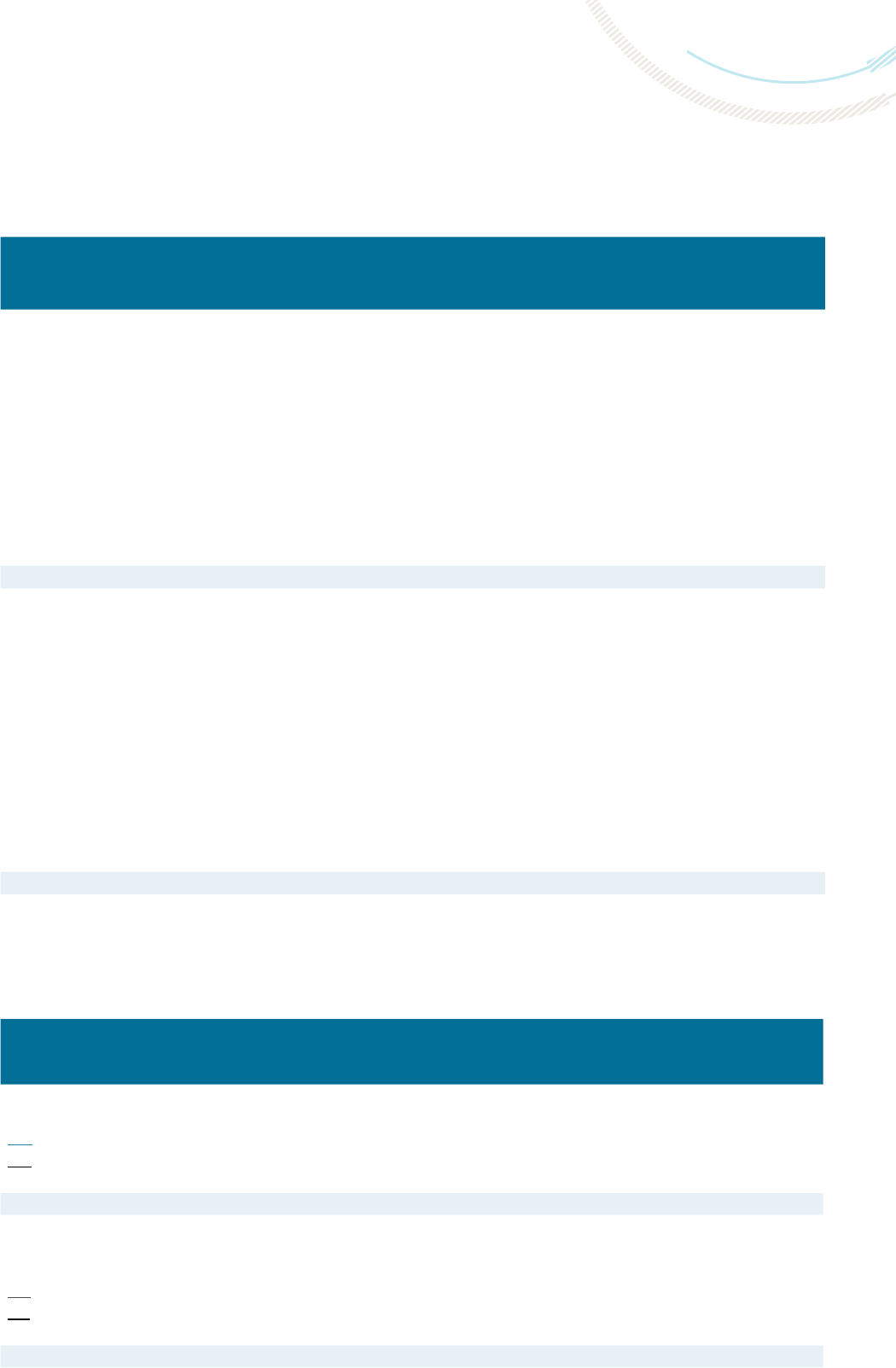
Notes to the Consolidated Financial Statements
Year ended 31 December 2021
The following is the movement on the impairment of direct credit facilities:
Corporates
Government
and Public
Sector
Retail
Real
Estate
Large
corporate
SME’s Total
JD JD JD JD JD JD
2021
Balance at the beginning of the year 20,260,675 724,144 32,824,783 2,103,565 - 55,913,167
Impairment loss on the new credit facilities during the
year
2,155,396 59,846 7,398,414 275,882 - 9,889,538
Interest transferred from income (2,653,241) (191,191) (3,749,659) (480,617) - (7,074,708)
Transferred to stage (1) (1,258,483) (8,621) (35,334) (9,494) - (1,311,932)
Transferred to stage (2) (810,279) (44,985) (1,194,795) (83,139) - (2,133,198)
Transferred to stage (3) 2,068,762 53,606 1,230,129 92,633 - 3,445,130
Eect on the provision as of the period end - due to
change in the classication between the three stages
during the period
1,748,939 (25,621) 581,020 82,212 - 2,386,550
Adjustments due to changes - - - - - -
Written-o loans (18,040) - - - - (18,040)
Balance at the End of the Year 21,493,729 567, 178 37,054,558 1,981,042 - 61,096,507
2020
Balance at the beginning of the year 18,445,617 563,231 21,765,141 1,662,281 108,923 42,545,193
Impairment loss on the new credit facilities during the
year
2,306,292 164,106 10,839,190 559,542 - 13,869,130
Interest transferred from income (1,968,978) (128,764) (2,052,797) (113,966) (108,923) (4,373,428)
Transferred to stage (1) (953,246) (100,406) (28,571) (14,115) - (1,096,338)
Transferred to stage (2) (663,959) 56,176 (3,176,969) 14,086 - (3,770,666)
Transferred to stage (3) 1,617,205 44,230 3,205,540 29 - 4,867,004
Eect on the provision as of the period end - due to
change in the classication between the three stages
during the period
1,505,673 125,571 2,273,249 (4,292) - 3,900,201
Adjustments due to changes - - - - - -
Written-o loans (27,929) - - - - (27,929)
Balance at the End of the Year 20,260,675 724,144 32,824,783 2,103,565 - 55,913,167
The provisions no longer needed due to settlements or debts payment and transferred against other debts amounted to JD2,684,260
as of December 31, 2021 (JD1,867,845 as of December 31, 2020).
Interest in Suspense
The following is the movement on interest in suspense:
Corporates
Retail Real Estate Large corporate SME’s Total
JD JD JD JD JD
2021
Balance at the beginning of the year 7,874,768 322,459 4,986,869 965,808 14,149,904
Add: Suspended interests during the year 1,519,969 64,333 2,626,285 133,503 4,344,090
less: interest transferred from income (511,344) - (465,121) (29,625) (1,006,090)
Written-o interest in suspense (145,598) - (2,172) - (147,7 70)
Balance at the Ending of the Year 8,737,795 386,792 7,145,861 1,069,686 17,340,134
2020
Balance at the beginning of the year 6,995,654 238,862 2,748,638 729,271 10,712,425
Add: Suspended interests during the year 1,426,377 87,614 2,329,856 241,601 4,085,448
less: interest transferred from income (363,264) - (69,103) (4,704) (437,071)
Written-o interest in suspense (183,999) (4,017) (22,522) (360) (210,898)
Balance at the Ending of the Year 7,874,768 322,459 4,986,869 965,808 14,149,904
95
BANK ABC IN JORDAN ANNUAL REPORT 2021

Notes to the Consolidated Financial Statements
Year ended 31 December 2021
The following are the credit exposures according /to IFRS (9):
Stage (1) Stage (2) Stage (3) Total
Direct Credit
Facilities
Provision
for
Expected
Credit
Loss
Interest
in
Suspense
Direct
Credit
Facilities
Provision for
Expected
Credit Loss
Interest in
Suspense
Direct
Credit
Facilities
Provision for
Expected
Credit Loss
Interest in
Suspense
Direct
Credit
Facilities
Provision for
Expected
Credit Loss
Interest in
Suspense
JD JD JD JD JD JD JD JD JD JD JD JD
2021
Retail 342,524,406 (2,174,273) - 11,162,745 (1,435,195) -
28,097,464
(17,884,261) (8,737,795) 381,784,615 (21,493,729) (8,737,795)
Real Estate Loans 57,518,235 (34,175) - 9,542,785 (66,680) - 1,253,199 (466,323) (386,792) 68,314,219 (567,178) (386,792)
Large Corporate Entities 164,219,747
(1,661,553)
- 48,536,746 (10,161,997) -
33,816,909
(25,231,008) (7,145,861) 246,573,402 (37,054,558) (7,145,861)
SME’s 17,313,116 (77,395) - 5,591,529 (136,825) - 3,090,451 (1,766,822) (1,069,686) 25,995,096 (1,981,042) (1,069,686)
Government and Public Sector 49,098,506 - - - - - - - - 49,098,506 - -
630,674,010 (3,947,396) - 74,833,805 (11,800,697) - 66,258,023 (45,348,414) (17,340,134) 771,765,838 (61,096,507) (17,340,134)
According to the IFRS number (9)
2020
Retail 291,356,914 (1,918,739) - 12,772,095 (1,994,952) - 24,897,248 (16,346,984) (7,874,768) 329,026,257 (20,260,675) (7,874,768)
Real Estate Loans 56,105,620 (24,285) - 14,827,633 (264,059) - 1,185,155 (435,800) (322,459) 72,118,408 (724,144) (322,459)
Large Corporate Entities 174,884,718 (2,145,790) - 55,319,310 (6,855,090) - 32,953,775 (23,823,903) (4,986,869) 263,157,803 (32,824,783) (4,986,869)
SME’s 17,461,423 (112,452) - 4,268,782 (119,590) - 3,852,913 (1,871,523) (965,808) 25,583,118 (2,103,565) (965,808)
Government and Public Sector 30,119,417 - - - - - - - - 30,119,417 - -
569,928,092 (4,201,266) - 87,187,820 (9,233,691) - 62,889,091 (42,478,210) (14,149,904) 720,005,003 (55,913,167) (14,149,904)
The distribution of total facilities according to the Bank’s internal credit rating for retails is:
20202021
TotalTotal
Stage (3)
Individual
Stage (2)
Collective
Stage (2)
Individual
Stage (1)
Collective
Stage (1)
Individual
JDJDJDJDJDJDJD
Credit rating categories based on the
Bank’s internal system:
11,412,492 13,954,317 - 49,808 - 13,904,509 - 1
- - - - - - - 2
1,467,193 1,024,373 - 8,421 - 1,015,952 - 3
29,229,217 24,445,110 - 268,579 - 24,176,531 - 4
223,666,233 275,970,704 - 2,828,582 - 273,142,122 - 5
32,221,805 32,190,531 - 2,221,673 - 29,968,858 - 6
5,647,602 5,687,948 - 5,431,997 - 255,951 - 7
484,467 414,168 - 353,685 - 60,483 - 8
1,316,868 1,166,885 1,166,885 - - - - 9
736,301 2,829,992 2,829,992 - - - - 10
22,844,079 24,100,587 24,100,587 - - - - 11
329,026,257 381,784,615 28,097,464 11,162,745 - 342,524,406 - Total
96

Notes to the Consolidated Financial Statements
Year ended 31 December 2021
The movement on the retail facilities is as follows:
20202021
Stage (3)Stage (2)Stage (1)
TotalTotalCollectiveIndividualCollectiveIndividual
JDJDJDJDJDJDJD
287,909,320 329,026,257 24,897,248 12,772,095 - 291,356,914 - Balance - beginning of the year
152,018,897 173,986,830 1,125,698 1,689,135 - 171,171,997 - New exposures during the year
(108,990,113) (120,835,639) (1,197,058) (2,965,226) -
(116,673,355)
- Settled exposures during the year
- - (521,933) (3,028,710) - 3,550,643 - Transferred to stage (1)
- - (199,891) 5,498,151 - (5,298,260) - Transferred to stage (2)
- - 4,540,511 (3,286,904) - (1,253,607) - Transferred to stage (3)
(1,699,919) (229,195) (383,473) 484,204 - (329,926) -
Eect on total exposures due to
change in the classication between
stages
- - - - - - - Eect of adjustment
(211,928) (163,638) (163,638) - - - - Written o exposures
329,026,257 381,784,615 28,097,464 11,162,745 - 342,524,406 - Balance - End of the Year
The movement on provision for credit loss for retail credit facilities is as follows:
18,445,617 20,260,675 16,346,984 1,994,952 - 1,918,739 - Balance - beginning of the year
2,306,292 2,155,396 730,023 337,231 - 1,088,142 -
Impairment losses on the new
exposures during the year
(1,968,978) (2,653,241) (1,200,071) (639,083) - (814,087) -
Recovered from impairment losses on
the paid exposures during the year
- - (3,743) (19,783) - 23,526 - Transferred to stage (1)
- - (20,277) 680,536 - (660,259) - Transferred to stage (2)
- - 2,843,730 (1,959,386) - (884,344) - Transferred to stage (3)
1,505,673 1,748,939 (794,345) 1,040,728 - 1,502,556 -
Eect on the impairment losses due to
change in the classication between
stages
- - - - - - -
Eect on the provision due to
adjustment
(27,929) (18,040) (18,040) - - - -
Impairment loss on the written o
exposures
20,260,675 21,493,729 17,884,261 1,435,195 - 2,174,273 -
Balance of the Provision for Expected
Credit Losses at Year End
97
BANK ABC IN JORDAN ANNUAL REPORT 2021

Notes to the Consolidated Financial Statements
Year ended 31 December 2021
The distribution of total facilities according to the Bank’s internal credit rating for real estates:
20202021
TotalTotal
Stage (3)
Individual
Stage (2)
Collective
Stage (2)
Individual
Stage (1)
Collective
Stage (1)
Individual
JDJDJDJDJDJDJD
Credit rating categories based on the
bank’s internal system:
1,901,751 1,877,313 - 84,274 - 1,793,039 - 1
- - - - - - - 2
2,099,220 1,508,807 - 42,467 - 1,466,340 - 3
5,793,107 5,215,643 - 105,676 - 5,109,967 - 4
44,911,490 44,100,724 - 1,173,209 - 42,927,515 - 5
14,219,215 12,248,083 - 6,026,709 - 6,221,374 - 6
1,834,695 2,110,450 - 2,110,450 - - - 7
173,775 - - - - - - 8
57,891 21,199 21,199 - - - - 9
- 88,904 88,904 - - - - 10
1,127,264 1,143,096 1,143,096 - - - - 11
72,118,408 68,314,219 1,253,199 9,542,785 - 57,518,235 - Total
The movement on the real estates facilities is as follows:
20202021
Stage (3)Stage (2)Stage (1)
TotalTotalCollectiveIndividualCollectiveIndividual
JDJDJDJDJDJDJD
75,441,342
72,118,408
1,185,155 14,827,633 - 56,105,620 - Exposures balance - beginning of the year
5,239,085 5,874,746 34,902 115,530 - 5,724,314 - New exposures during the year
(8,158,488)(9,131,635)(282,191) (1,695,776) - (7,153,668) - Settled exposures during the year
- - -
(4,368,632)
- 4,368,632 - Transferred to stage (1)
- - - 1,403,619 - (1,403,619) - Transferred to stage (2)
- - 315,333 (294,134) - (21,199) - Transferred to stage (3)
Eect on total exposure due to change in the
classications
(399,514) (547,300)- (445,455) - (101,845) - between stages
- - - - - - - Eect of adjustment
(4,017) - - - - - - Written-o exposures
- - - - - - - Adjustments due to change in exchange rates
72,118,408 68,314,219 1,253,199 9,542,785 - 57,518,235 - Exposures Balance - End of the Year
98

Notes to the Consolidated Financial Statements
Year ended 31 December 2021
The movement on provision for credit loss for real estates is as follows:
20202021
Stage (3)Stage (2)Stage (1)
TotalTotalCollectiveIndividualCollectiveIndividual
JDJDJDJDJDJDJD
563,231 724,144 435,800 264,059 - 24,285 - Balance - beginning of the year
164,106 59,846 50,130 - - 9,716 -
Impairment losses on new exposures during
the year
(128,764) (191,191) (73,213) (116,217) - (1,761) -
Recovered from impairment losses on
matured paid exposures during the year
- - - (2,596) - 2,596 - Transferred to stage (1)
- - - 9,808 - (9,808) - Transferred to stage (2)
- - 53,606 (52,197) - (1,409) - Transferred to stage (3)
Eect on total exposure due to change in the
classications
125,571 (25,621) - (36,177) - 10,556 - between stages
- - - - - - -
Eect of adjustment on the resulted
provision
- - - - - - - Impairment loss on the written o exposures
- - - - - - -
Adjustments due to change in exchange
rates
724,144 567,178 466,323 66,680 - 34,175 -
Balance of the provision Expected Credit
Losses at Year End
The distribution of total facilities according to the Bank’s internal credit rating for Corporates:
20202021
TotalTotal
Stage (3)
Individual
Stage (2)
Collective
Stage (2)
Individual
Stage (1)
Collective
Stage (1)
Individual
JDJDJDJDJDJDJD
Credit rating categories based on the
bank’s internal system:
- - - - - - - 1
- - - - - - - 2
- - - - - - - 3
- - - - - - - 4
40,626,965 24,835,638 - - - - 24,835,638 5
183,327,783 195,137,327 - - 13,850,700 - 181,286,627 6
13,357,020 17,957, 173 - 1,713,067 9,048,118 7,195,873 115 7
23,011,677 23,924,861 - - 23,924,861 - - 8
2,700,780 739,889 739,889 - - - - 9
5,672,554 - - - - - - 10
24,580,441 33,077,020 33,077,020 - - - - 11
293,277,220 295,671,908 33,816,909 1,713,067 46,823,679 7,195,873 206,122,380 Total
99
BANK ABC IN JORDAN ANNUAL REPORT 2021

Notes to the Consolidated Financial Statements
Year ended 31 December 2021
The movement on the Corporate facilities for is as follows:
20202021
Stage (3)Stage (2) Stage (1)
TotalTotalCollectiveIndividualCollectiveIndividual
JDJDJDJDJDJDJD
291,383,369 293,277,220 32,953,775 1,605,362 53,713,948 6,808,991 198,195,144 Exposures balance - beginning of the year
65,924,423 76,226,097 2,832,158 715,802 16,246,485 2,019,619 54,412,033 New exposures during the year
(59,257,513) (73,439,309)(4,083,216)- (16,146,599) (1,632,737) (51,576,757) Settled exposures during the year
- - - - (7,883,423) - 7,883,423 Transferred to stage (1)
- - 739,889 (739,889)2,158,505 - (2,158,505) Transferred to stage (2)
- - 1,376,475 - (1,376,475) - - Transferred to stage (3)
(4,750,537) (389,928) - 131,792 111,238 - (632,958)
Eect on total exposure due to change in the
classications between stages
- - - - - - - Eect of adjustment
(22,522) (2,172) (2,172) - - - - Written-o exposures
- - - - - - - Adjustments due to change in exchange rates
293,277,220 295,671,908 33,816,909 1,713,067 46,823,679 7,195,873 206,122,380 Exposures Balance - End of the Year
The movement on provision for credit loss for Corporate is as follows:
20202021
Stage (3)
Stage (2)Stage (1)
TotalTotalCollectiveIndividualCollectiveIndividual
JDJDJDJDJDJDJD
21,874,064 32,824,783 23,823,903 103,828 6,751,262 15,120 2,130,670 Balance - beginning of the year
10,839,190 7,398,414 1,158,420 134,500 5,523,149 2,639 579,706
Impairment losses on new exposures during the
year
(2,161,720) (3,749,659) (983,841) (21,130) (1,644,962) (7,481) (1,092,245)
Recovered from impairment losses on paid
exposures during the year
- - - - (60,795) - 60,795 Transferred to stage (1)
- - 2,397 (2,397) 96,129 - (96,129) Transferred to stage (2)
- - 1,230,129 - (1,230,129) - - Transferred to stage (3)
2,273,249 581,020 - (59,353) 571,895 - 68,478
Eect on the impairment losses due to change in
the classications between stages
- - - - - - - Eect of adjustment on the resulted provision
- - - - - - - Impairment loss on the written o exposures
- - - - - - - Adjustments due to change in exchange rates
32,824,783 37,054,558 25,231,008 155,448 10,006,549 10,278 1,651,275
Balance of the Provision for Expected Credit
Losses at Year End
100

Notes to the Consolidated Financial Statements
Year ended 31 December 2021
The distribution of total facilities according to the Bank’s internal credit rating for Small to Medium entities (SME’s) is as follows:
20202021
TotalTotal
Stage (3)
Individual
Stage (2)
Collective
Stage (2)
Individual
Stage (1)
Collective
Stage (1)
Individual
JDJDJDJDJDJDJD
Credit rating categories based on the bank’s
internal system:
- - - - - - - 1
- - - - - - - 2
- - - - - - - 3
- - - - - - - 4
2,973,987 612,348 - - - - 612,348 5
17,116,996 18,185,092 - - 1,484,324 - 16,700,768 6
1,639,222 4,107,205 - - 4,107,205 - - 7
- - - - - - - 8
105,642 - - - - - - 9
- 176,897 176,897 - - - - 10
3,747, 27 1 2,913,554 2,913,554 - - - - 11
25,583,118 25,995,096 3,090,451 - 5,591,529 - 17,313,116 Total
The movement on the Small and Medium entities (SME’s) facilities is as follows:
20202021
Stage (2)Stage (1)
TotalTotalStage (3)CollectiveIndividualCollectiveIndividual
JDJDJDJDJDJDJD
19,527,041 25,583,118 3,852,913 - 4,268,782 - 17,461,423 Balance - beginning of the year
11,068,808 10,150,356 184,070 - 2,860,349 - 7,105,937 New credit facilities during the year
(4,414,164) (9,830,640)(1,123,429) - (1,658,490) - (7,048,721) Settled credit facilities
- - - - (133,573) - 133,573 Transferred to stage (1)
- - - - 409,466 - (409,466) Transferred to stage (2)
- - 176,897 - (176,897) - - Transferred to stage (3)
(598,207) 92,262 - - 21,892 - 70,370
Eect on total exposure due to change in the
classications between stages
- - - - - - - Eect of adjustment
(360) - - - - - - Written-o credit facilities
- - - - - - - Adjustments due to change in exchange rates
25,583,118 25,995,096 3,090,451 - 5,591,529 - 17,313,116 Total exposures at year end
101
BANK ABC IN JORDAN ANNUAL REPORT 2021
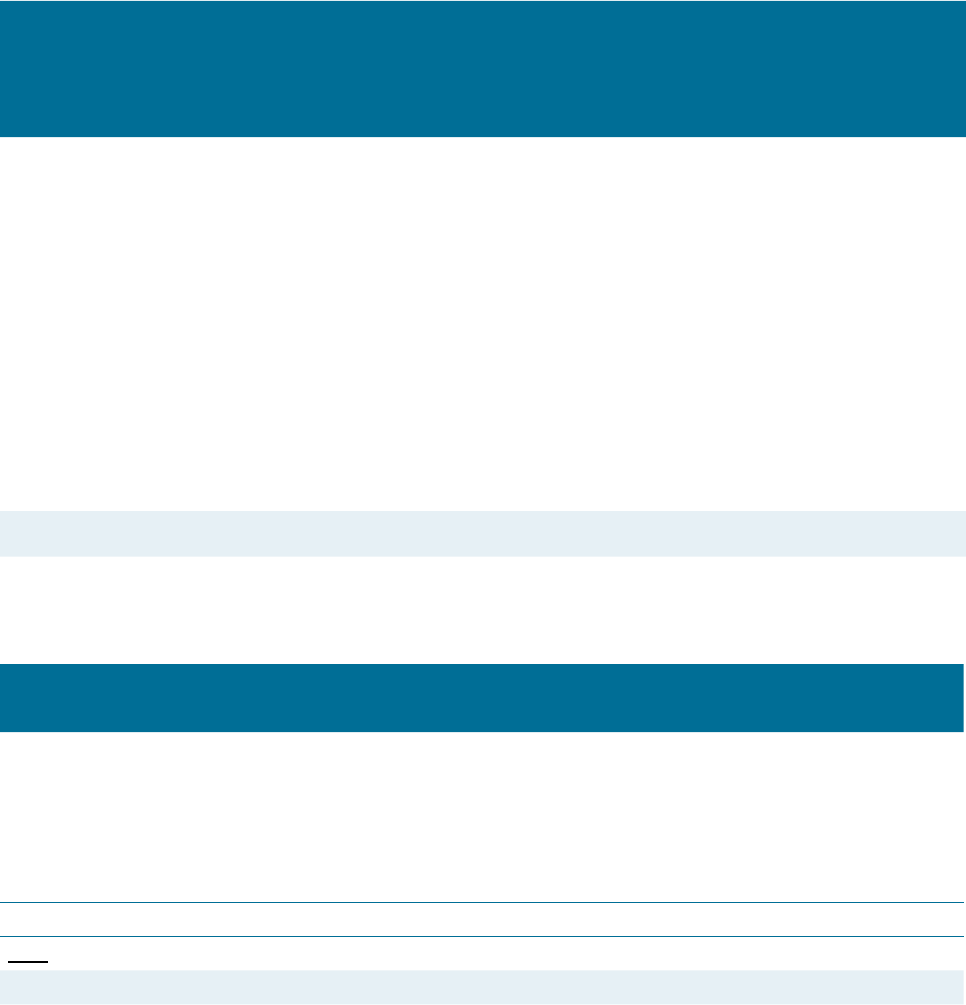
Notes to the Consolidated Financial Statements
Year ended 31 December 2021
The movement on provision for impairment loss for Small and Medium entities (SME’s) is as follows:
20202021
Stage (3)Stage (2)Stage (1)
TotalTotalCollectiveIndividualCollectiveIndividual
JDJDJDJDJDJDJD
1,662,281 2,103,565 1,871,523 - 119,590 - 112,452 Balance - beginning of the year
559,542 275,882 170,887 - 68,795 - 36,200
Impairment losses on new exposures during the
year
(113,966) (480,617) (368,221) - (42,917) - (69,479)
Recovered from impairment losses on paid expo
-
sures during the year
- - - - (319) - 319 Transferred to stage (1)
- - - - 9,813 - (9,813) Transferred to stage (2)
- - 92,633 - (92,633) - - Transferred to stage (3)
(4,292) 82,212 - - 74,496 - 7,716
Eect on the impairment losses due to change in
the classications between stages
- - - - - - - Eect of adjustment on the resulted provision
- - - - - - - Impairment loss on the written o exposures
- - - - - - - Adjustments due to change in exchange rates
2,103,565 1,981,042 1,766,822 - 136,825 - 77,395
Balance of the Provision for Expected Credit Losses
at Year End
9. Financial Assets at Fair Value through Other Comprehensive Income
The details of this item are as follows:
2021 2020
JD JD
Quoted shares in active markets 1,133,643 869,844
Unquoted shares in active markets 2,450,379 2,368,267
Governmental and guaranteed nancial bonds 117,799,629 117,941,021
Jordanian treasury bills 7,018,458 7,018,586
Other nancial bonds 7,234,630 7,381,874
Total 135,636,739 135,579,592
Less: Provision of expected credit loss (2,830) (9,125)
Total 135,633,909 135,570,467
102

Notes to the Consolidated Financial Statements
Year ended 31 December 2021
- The following represents the movement on the provision for expected credit losses of the nancial assets through other
comprehensive income:
2021 2020
Stage (1)
Individual
Stage (2)
Individual
Stage (3)
Individual
Total Total
JD JD JD JD JD
Balance – beginning of the year 9,125 - - 9,125 20,563
New investment during the year - - - - 4,027
Matured investments (6,295) - - (6,295) (15,465)
Transferred to stage (1) - - - - -
Transferred to stage (2) - - - - -
Transferred to stage (3) - - - - -
Changes in fair value - - - - -
Eect of changes in the investment adjust-
ment
- - - - -
Written-o investment - - - - -
Balance – End of the Year 2,830 - - 2,830 9,125
- The following represents the movement on nancial assets through other comprehensive income:
2021 2020
Stage (1)
Individual
Stage (2)
Individual
Stage (3)
Individual
Total Total
JD JD JD JD JD
Balance – beginning of the year 135,579,592 - - 135,579,592 148,842,776
New investment during the period 39,036,351 - - 39,036,351 13,149,834
Matured investments (44,873,458) - - (44,873,458) (34,324,647)
Transferred to stage (1) - - - - -
Transferred to stage (2) - - - - -
Transferred to stage (3) - - - - -
Changes in fair value 5,894,254 - - 5,894,254 7,911,629
changes in the adjustment of investment - - - - -
Written-o investment - - - - -
Balance – End of the Year 135,636,739 - - 135,636,739 135,579,592
10. Financial Assets at Amortized Cost
103
BANK ABC IN JORDAN ANNUAL REPORT 2021
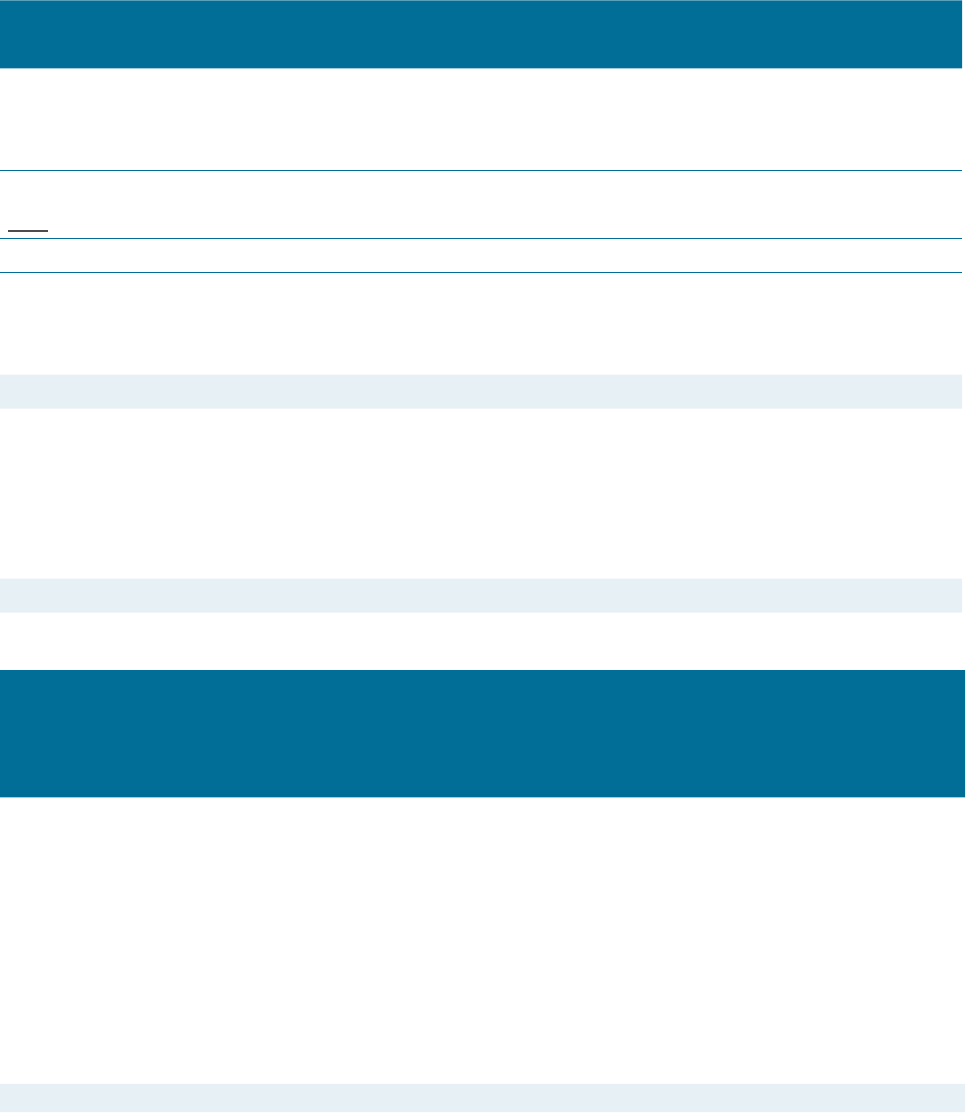
Notes to the Consolidated Financial Statements
Year ended 31 December 2021
The details of this item are as follows:
20202021
JDJD
Financial assets available at market value
111,863,616 124,322,625 Governmental and guaranteed bonds
15,000,000 15,000,000 Other nancial bonds
126,863,616 139,322,625 Total
(19,868) (8,217)
Less: Provision for nancial assets at amortized cost
126,843,748 139,314,408 Total
Bonds Analysis:
119,863,616 139,322,625 With xed rate
7,000,000 - With oating rate
126,863,616 139,322,625 Total
Bonds Analysis in accordance with IFRS (9)
126,863,616139,322,625Stage 1
- - Stage 2
- - Stage 3
126,863,616139,322,625Total
The following is the movement on nancial assets at amortized cost:
20202021
TotalTotal
Stage (3)
Individual
Stage (2)
Individual
Stage (1)
Individual
JDJDJDJDJD
137,471,590 126,863,616 - - 126,863,616 Balance – beginning of the year
54,043,169 23,003,697 - - 23,003,697 New investment during the year
(64,651,143) (10,544,688) - -
(10,544,688)
Settled investment *
- - - - - Change in fair value
- - - - - Transferred to stage 1
- - - - - Transferred to stage 2
- - - - - Transferred to stage 3
- - - - - Changes in fair value
- - - - - Eect of adjustment in investment
- - - - - Written o investment
126,863,616 139,322,625 - - 139,322,625 Balance - end of the year
104

Notes to the Consolidated Financial Statements
Year ended 31 December 2021
- The following is the movement on provision for expected credit losses for nancial assets at amortized cost:
20202021
TotalTotal
Stage (3)Stage (2)
Individual
Stage (1)
Individual
JDJDJDJDJD
10,129 19,868 - - 19,868 Balance – beginning of the year
19,868 - - - - Credit losses on new investments during the year
(10,129) (11,651) - - (11,651) Recovered amount from losses on paid investments
- - - - - Transferred to stage (1)
- - - - - Transferred to stage (2)
- - - - - Transferred to stage (3)
- - - - - Changes in fair value
- - - - - Changes resulting from adjustments
- - - - - Written-o investments
19,868 8,217 - - 8,217 Balance - End of the Year
11. Financial Assets at Amortized Cost - Mortgaged
The details of this item are as follows:
20202021
JDJD
62,631,159 51,926,112 Governmental and guaranteed bonds
62,631,159 51,926,112
- On April 4, 2021, the Bank three bonds of the Jordanian treasury bonds with a nominal value of JD31,000,000 to Arab Bank. The
amount of the repurchase agreement was JD34,455,130, and the amount received was JD33,766,027 as borrowed money at an interest
rate of 3.97% per annum, as stated in Note (19).
Moreover, the Bank did not recognize this transaction as a sale transaction, because the Bank reserves the right to repurchase these
bonds on April 4, 2024.
- On October 18, 2021, the Bank sold one bond of the Jordanian treasury bond with a nominal value of JD9,808,000 to Central Bank of
Jordan. The amount of the bond repurchase agreement was JD9,970,674, and the amount received was JD9,920,957 as a loan at an
interest rate of 2% per annum, as stated in Note (19).
Moreover, the Bank did not recognize this transaction as a sale transaction, because the Bank reserves the right to repurchase these
bonds on January 17, 2022.
- On December 6, 2021, the Bank sold one bond of the Jordanian treasury bond with a nominal value of JD11,144,000 to Central Bank of
Jordan. The amount of the bond repurchase agreement was JD11,392,404, and the amount received was JD11,374,925 as a loan at an
interest rate of 2% per annum, as stated in Note (19).
Moreover, the Bank did not recognize this transaction as a sale transaction, because the Bank reserves the right to repurchase these
bonds on January 3, 2022.
105
BANK ABC IN JORDAN ANNUAL REPORT 2021

Notes to the Consolidated Financial Statements
Year ended 31 December 2021
12. Property and Equipment
The details of this item are as follows:
Equipment Decorations
and and Leasehold
Lands Buildings Furniture Vehicles Computers Improvements Total
JD JD JD JD JD JD JD
2021
Cost:
Balance - beginning of the year 5,473,330 5,909,553 6,411,907 504,600 3,898,689 4,903,856 27,101,935
Additions * - 13,389,020 5,750,617 - 708,789 1,537,054 21,385,480
Disposals - - (1,013,301) - (322,437) (122,065) (1,457,803)
Balance - End of the Year 5,473,330 19,298,573 11,149,223 504,600 4,285,041 6,318,845 47,029,612
Accumulated Depreciation:
Balance - beginning of the year - 3,824,571 4,880,026 407,840 3,426,631 4,217,476 16,756,544
Annual depreciation - 94,456 766,759 26,310 229,318 171,769 1,288,612
Disposals - - (1,011,620) - (321,747) (121,455) (1,454,822)
Balance - End of the Year - 3,919,027 4,635,165 434,150 3,334,202 4,267,790 16,590,334
Net book value of property and
equipment
5,473,330 15,379,546 6,514,058 70,450 950,839 2,051,055 30,439,278
Advance payment on property and
equipment
- - 170,480 - 104,344 - 274,824
Projects under construction - 677,100 1,578,495 - - - 2,255,595
Net Book Value – End of the Year 5,473,330 16,056,646 8,263,033 70,450 1,055,183 2,051,055 32,969,697
2020
Cost:
Balance - beginning of the year 3,374,438 5,909,553 6,154,029 504,600 3,704,737 4,579,404 24,226,761
Additions 2,098,892 - 291,419 - 197,149 493,314 3,080,774
Disposals - - (33,541) - (3,197) (168,862) (205,600)
Balance - End of the Year 5,473,330 5,909,553 6,411,907 504,600 3,898,689 4,903,856 27,101,935
Accumulated Depreciation:
Balance - beginning of the year - 3,743,106 4,291,817 362,369 3,136,189 4,155,797 15,689,278
Annual depreciation - 81,465 618,338 45,471 293,210 229,133 1,267,617
Disposals - - (30,129) - (2,768) (167,454) (200,351)
Balance - End of the Year - 3,824,571 4,880,026 407,840 3,426,631 4,217,476 16,756,544
Net book value of property and
equipment
5,473,330 2,084,982 1,531,881 96,760 472,058 686,380 10,345,391
Advance payment on property and
equipment
- - 970,069 - 4,775 - 974,844
Projects under construction - 16,203,160 1,860,217 - 649,310 4,639 18,717,326
Net Book Value – End of the Year 5,473,330 18,288,142 4,362,167 96,760 1,126,143 691,019 30,037,561
Annual Depreciation Rate % - 2-15 9-20 15
9-25 9-10
* This item includes an amount of JD17,161,749 which represents the transferred from the project under construction related to the new management
building as of December 31, 2021.
- The fully depreciated assets on Property and equipment amounted to JD11,074,071 as of December 31, 2021 (JD11,507,177 as of December 31, 2020).
106
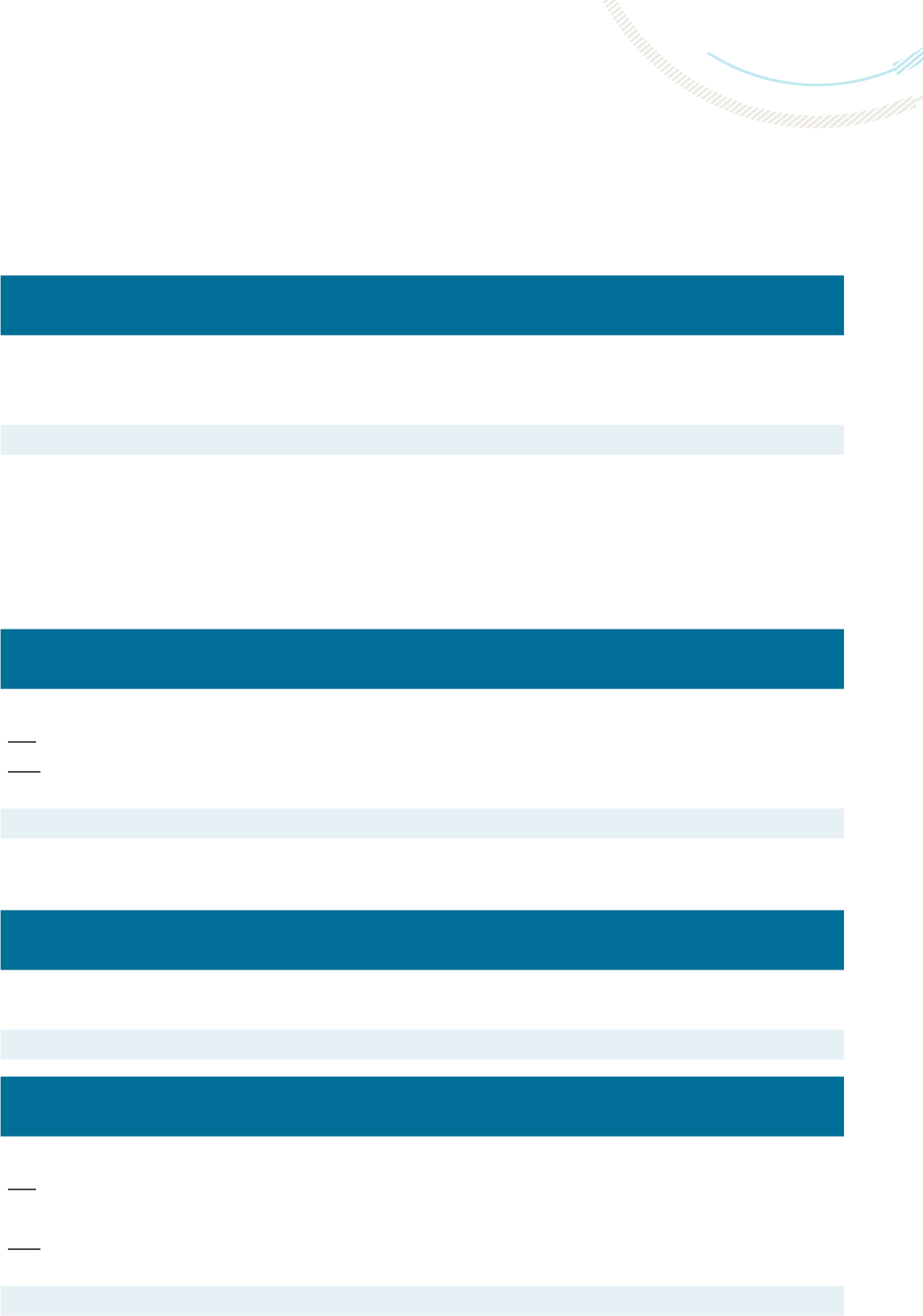
Notes to the Consolidated Financial Statements
Year ended 31 December 2021
13. Intangible Assets - Net
The details of this item are as follows:
2021 2020
JD JD
Balance - beginning of the year 1,519,806 1,699,612
Additions 476,532 262,020
Amortization of the year (440,207) (441,826)
Balance - End of the Year 1,556,131 1,519,806
Amortization Rate % 20 20
14. Lease Contracts
Right-of-use assets:
The Bank leases many assets including land and buildings, noting that the average lease term is 5 years. The following is
the movement on the right- of-use assets’ during the year:
2021 2020
JD JD
Balance - beginning of the year 2,844,640 3,357,169
Add: Additions during the year 647,535 521,885
Less: Depreciation the year (62,951) (607,023)
Cancelled contracts (602,980) (4 27, 3 9 1 )
Balance - End of the Year 2,826,244 2,844,640
The amounts recorded on the statement of prot & loss
2021 2020
JD JD
Depreciation of the year 634,456 646,850
Interest of the year 160,921 164,543
Lease expense during the year 795,377 811,393
Lease liabilities: 2021 2020
JD JD
Balance - beginning of the year 2,755,325 3,223,659
Add: Additions during the year 647,536 521,885
Interest during the year 160,921 164,543
Less: paid during the year (782,632) (789,186)
Cancelled contracts (18,785) (365,576)
Balance - End of the Year 2,762,365 2,755,325
107
BANK ABC IN JORDAN ANNUAL REPORT 2021

Notes to the Consolidated Financial Statements
Year ended 31 December 2021
15. Other Assets
The details of this item are as follows:
2021 2020
JD JD
Accrued revenues and interest 5,825,423 7,071,454
Prepaid expenses 805,119 611,454
Assets seized by the Bank against outstanding debts * 3,270,042 2,449,555
Unrealized derivatives gain / assets 23,662 85,468
Other receivables / Brokerage company 121,531 519,167
Lands held for sale / Brokerage company 1,696,734 1,696,734
Discounted LC’s 8,795,719 724,107
Seized Assets Sold in installments 3,822,675 -
Others 2,577,285 2,287,073
Total 26,938,190 15,445,012
* The regulations of the Central Bank of Jordan require disposing of the assets seized by the Bank outstanding against debts on the
clients during a maximum period of two years from the date of its acquisition. In exceptional cases , the Central Bank may extend this
period to a maximum two consecutive years.
- The following is a summary of the movement on assets seized by the Bank due to outstanding debt:
2021 2020
JD JD
Balance - beginning of the year 2,449,555 2,429,211
Additions 4,743,823 227,714
Disposals (3,822,675) (207,370)
(Provision) for Assets seized during the year (100,661) -
Balance - End of the Year 3,270,042 2,449,555
The provision of assets seized by the Bank amounted to JD201,322 as at December 31, 2021 (JD100,661 as at December 31, 2020) for the
assets seized by the Bank for a period of more than 4 years.
16. Bank and Financial Institutions Deposits
The details of this item are as follows:
2021 2020
Inside
Jordan
Outside
Jordan
Total
Inside
Jordan
Outside
Jordan
Total
JD JD JD JD JD JD
Current accounts and demand deposits - 1,440,100 1,440,100 - 1,747,479 1,747,479
Deposits due within 3 months - 142,618,539 142,618,539 26,309,250 129,103,802 155,413,052
Total - 144,058,639 144,058,639 26,309,250 130,851,281 157,160,531
108

Notes to the Consolidated Financial Statements
Year ended 31 December 2021
17. Customers’ Deposits
The details of this item are as follows:
Government and
Retail Corporate SMEs Public Sector Total
JD JD JD JD JD
2021
Current accounts and demand deposits 48,907,680 26,258,180 11,962,018 953,209 88,081,087
Saving deposits 24,487,154 314,040 521,866 221,335 25,544,395
Time and notice deposits 309,099,497 195,000,941 16,925,138 88,043,817 609,069,393
Total 382,494,331 221,573,161 29,409,022 89,218,361 722,694,875
2020
Current accounts and demand deposits 49,546,697 16,550,085 13,615,008 775,685 80,487,475
Saving deposits 29,648,573 364,501 216,291 201,987 30,431,352
Time and notice deposits 297,239,130 197,904,084 11,339,921 66,889,985 573,373,120
Total 376,434,400 214,818,670 25,171,220 67,867,657 684,291,947
- The deposits of the governmental and public sector inside Jordan amounted to JD89,218,361 representing 12.345% of total deposits
as of December 31, 2021 (JD67,867,657 representing 9.918% of total deposits as of December 31, 2020).
- Non-interest bearing deposits amounted to JD89,503,466 representing 12.385% of total deposits as of December 31, 2021
(JD88,910,349, representing 12.993% as of December 31, 2020).
- Restricted deposits amounted to JD97,642,364 representing 13.511% of total deposits as of December 31, 2021 (JD96,559,289, repre-
senting 14.111% of total deposits as of December 31, 2020).
- Dormant accounts amounted to JD33,268,206 as of December 31, 2021 (JD20,189,962 as of December 31, 2020).
18. Margin Accounts
The details of this item are as follows:
2021 2020
JD JD
Margins on direct credit facilities 43,393,626 43,512,259
Margins on indirect credit facilities 6,086,745 5,020,693
Other margins 3,281,813 2,787,751
Total 52,762,184 51,320,703
109
BANK ABC IN JORDAN ANNUAL REPORT 2021

Notes to the Consolidated Financial Statements
Year ended 31 December 2021
19. Loans and Borrowings
The details of this item are as follows:
Number of Payments
Amount
Total Number
of Payments
Outstanding
Payments
Instalments
Maturity
Collaterals
Interest
Rate
JD
2021
Arab Bank loan * 33,766,027 1 1 36 Months
Mortgage bonds - The Central
Bank of Jordan
3.970%
Central Bank of Jordan loan ** 499,986 30 14 semi annual - 2.500%
Central Bank of Jordan loan *** 608,250 180 180 semi annual - 3.000%
Central Bank of Jordan loan 509 30 1 Monthly - 1.750%
Jordanian Real Estate Mortgage Re-fund Co. **** 254,145 236 12 Monthly - 6.85%
Jordanian Real Estate Mortgage Re-fund Co. 15,007,836 1 1 24 Months Mortgage deeds loan portfolio 4.250%
Jordanian Real Estate Mortgage Re-fund Co. 10,000,000 1 1 7 years Mortgage deeds loan portfolio 4.900%
Jordanian Real Estate Mortgage Re-fund Co. 7,000,815 1 1 24 Months Mortgage deeds loan portfolio 4.250%
Central Bank of Jordan loan ***** 9,920,957 1 1 Quarterly
Mortgage bonds - The Central
Bank of Jordan
2.000%
Central Bank of Jordan loan ****** 11,374,925 1 1 Monthly
Mortgage bonds - The Central
Bank of Jordan
2.000%
Central Bank of Jordan loan 727,004 48 48 Monthly - 1.000%
Central Bank of Jordan loan ******** 6,568,415 1776 1093 Monthly - 0.000%
ABC (Bahrain) ******* 7,799,000 1 1 2 weeks - 1.000%
Total 103,527,869
2020
Arab Bank loan 14,576,373 1 1 36 Months
Mortgage bonds - The Central
Bank of Jordan
5.290%
Arab Bank loan 19,378,304 1 1 36 Months
Mortgage bonds - The Central
Bank of Jordan
5.500%
Central Bank of Jordan loan 689,489 30 17 semi annual - 2.500%
Central Bank of Jordan loan 607,888 34 34 semi annual - 3.000%
Central Bank of Jordan loan 23,666 30 13 Monthly - 1.75%
Jordanian Real Estate Mortgage Re-fund Co. 508,411 236 24 Monthly - 6.850%
Jordanian Real Estate Mortgage Re-fund Co. 15,000,000 1 1 24 Months Mortgage deeds loan portfolio 4.250%
Jordanian Real Estate Mortgage Re-fund Co. 5,000,692 1 1 24 Months Mortgage deeds loan portfolio 5.050%
Central Bank of Jordan loan 7,280,586 1 1 Quarterly
Mortgage bonds - The Central
Bank of Jordan
2.000%
Central Bank of Jordan loan 8,320,548 1 1 Monthly
Mortgage bonds - The Central
Bank of Jordan
2.000%
Central Bank of Jordan loan 12,263,312 1 1 Monthly
Mortgage bonds - The Central
Bank of Jordan
2.000%
Central Bank of Jordan loan 6,644,372 792 777 Monthly - 0.000%
ABC (Bahrain) 3,190,500 1 1 2 weeks - 1.000%
Total 93,484,141
* The fund borrowed from the Arab Bank amounted to JD33,766,027 represents an agreement to repurchase treasury bonds with a
nominal value of JD31 million.
Meanwhile, the Bank holds the right to repurchase these bonds on of April 4, 2024.
** The fund borrowed from the Central Bank amounted to JD499,986 , as at December 31, 2021, represents the convention on the loan of
the Arab Fund for Economic and Social Development to nance the corporate sector, micro & SME’s (JD689,489 as at December 31, 2020).
*** The fund borrowed from the Central Bank amounted to JD608,250 , as at December 31, 2021, represents the convention on the loan
of the Arab Fund for Economic and Social Development to nance the corporate sector, micro & SME’s (JD607,888 as at December 31,
2020).
**** The borrowed funds as at December 31, 2021 amounted to JD254,154 , at an average interest rate of 6.85% (508,411 at an average of
6.85% as at December 31, 2020).
***** The fund borrowed from the Central Bank of Jordan amounted to JD9,920,957 represents an agreement to repurchase treasury
bonds with a nominal value of JD9.808 million.
Meanwhile, the Bank holds the right to repurchase these bonds on the of January 17, 2022.
110

Notes to the Consolidated Financial Statements
Year ended 31 December 2021
****** The fund borrowed from the Central Bank of Jordan amounted to JD11,374,925 represents an agreement to repurchase treasury
bonds with a nominal value of JD11.144 million.
Meanwhile, the Bank holds the right to repurchase these bonds on the of January 3, 2022.
******** The fund borrowed from the Central Bank of Jordan amounted to JD6,568,415 represents a loans agreement to support the
Companies due to the COVID pandemic.
********* The fund borrowed from ABC (Bahrain) amounted to JD7,799,000 represents an agreement to fund its subsidiary (Arab
Cooperation Company).
20. Sundry Provisions
The details of this item are as follows:
Balance -
Beginning
of the Year
Additions
During the
Year
Paid
During the
Year
Transferred
from
Provisions
Recovered
to Income
Balance -
End
of the
Year
JD JD JD JD JD JD
2021
Provision for lawsuits against the Group and other liabilities 638,413 - - - - 638,413
Other provisions 2,906,968 238,103 (404,660) - - 2,740,411
Total 3,545,381 238,103 (404,660) - - 3,378,824
2020
Provision for lawsuits against the Group and other liabilities 638,413 - - - - 638,413
Other provisions 2,802,035 593,884 (641,500) 152,549 - 2,906,968
Total 3,440,448 593,884 (641,500) 152,549 - 3,545,381
21. Income Tax
a. Income tax provision
The movement on the income tax provision is as follows:
2021 2020
JD JD
Balance - beginning of the year 6,456,452 2,478,661
Income tax paid (4,649,029) (1,137,194)
Accrued income tax 5,408,462 5,114,985
Prior years tax refundable deposits 40,963 -
Balance - End of the Year 7,256,848 6,456,452
The income tax expense appearing in the consolidated income statement represents the following:
2021 2020
JD JD
Accrued income tax on the Prot of the year 5,408,462 5,114,985
Deferred tax assets for the year (1,346,000) (2,176,055)
Amortization of deferred tax assets 1,461,728 46,347
Total 5,524,190 2,985,277
111
BANK ABC IN JORDAN ANNUAL REPORT 2021

Notes to the Consolidated Financial Statements
Year ended 31 December 2021
b. Deferred Tax Assets / Liabilities
The details of this item are as follows:
2021 2020
Beginning
Balance
Amounts
Released
Amounts
Added
Ending
Balance
Deferred
Tax
Deferred
Tax
JD JD JD JD JD
JD
Deferred tax assets
Provision of non performing loans from prior years
9,057 (155) - 8,902 3,383
3,442
loss on valuation of nancial instruments available
for sale
322,746 (187, 327 ) - 135,419 51,459
122,643
Dierence in credit facilities provision
4,401,539 (3,664,632) - 736,907 280,025
1,672,585
Fair value reserve of bound nancial assets
179,085 (12,522) - 166,563 63,294
68,052
Fair value reserve of shares nancial assets
- - 85,892 85,892 32,639
-
Deered tax assets resulted from the adoption of
IFRS (9)
17,785,952 - 2,013,079 19,799,031 7,093,294
6,332,848
Employees provision
205,139 (205,140) 1,326,099 1,326,099 503,918
77,953
Others
2,497,619 (10,057) 248,160 2,735,721 1,039,574
949,095
Total
25,401,137 (4,079,833) 3,673,230 24,994,534 9,067,586
9,226,618
Deferred tax liabilities
Unrealized gain of nancial assets resulted from
the adoption of IFRS (9)
4,453 - - 4,453 1,692
1,692
Gain of nancial assets at fair value through other
comprehensive income
7,860,623 (2,203,723) - 5,656,900 2,149,622
2,987,037
Fair value reserve of nancial assets shares
through other comprehensive income
230,091 - 259,720 489,811 186,128
87,434
Total
8,095,167 (2,203,723) 259,720 6,151,164 2,337,442
3,076,163
The movement on the deferred income tax assets / liabilities is as follows:
2021 2020
Assets Liabilities Assets Liabilities
JD JD JD JD
Balance - beginning of the year 9,226,618 3,076,163 7,078,498 1,977,939
Additions 1,391,304 98,063 2,242,982 1,098,224
Released (1,550,336) (836,784) (94,862) -
Balance - End of the Year 9,067,586 2,337,442 9,226,618 3,076,163
c. The reconciliation between taxable prot and accounting prot is as follows:
2021 2020
JD JD
Accounting prot 15,126,614 4,207,490
Non-taxable prot (5,546,506) (2,675,912)
Non-taxable expenses 3,930,682 6,747,018
Realized gain in retained earnings 10,489 -
Tax prot 13,521,279 8,278,596
Eective income tax rate 35.74% 83.77%
- The legal tax rate for banks in Jordan is 35%, plus 3% as national contribution & for subsidiaries, it is 24%, plus 4% as national
contribution.
- A nal settlement has been reached with the Income and Sales Tax Department for the Bank for the years 2018. In addition, the tax
return for 2019 and 2020 was submitted, and no nal decision has been issued thereon by the Income and Sales Tax Department yet.
- A nal settlement has been reached with the Income and Sales Tax Department for the subsidiary company up to the year 2020
112

Notes to the Consolidated Financial Statements
Year ended 31 December 2021
22. Other Liabilities
The details of this item are as follows:
20202021
JDJD
4,375,733 5,474,467 Accrued interest expense
80,092 46,909 Revenue received in advance
9,571,829 7,466,748 Accounts payable
1,043,227 2,306,674 Accrued expenses
372,812 239,193 Unrealized derivatives loss/ liability
621,152 898,284 Certied checks draed over the Bank
903,995 539,221 Provision for indirect facilities’ expected credit loss
140,500 89,243 Board of Directors’ remunerations
3,053,255 3,303,113 Incoming transfers
52,685 66,128 Deferred revenue
1,418,395 2,467,605Other liabilities
21,633,675 22,897,585 Total
Below is the movement on indirect facilities:
20202021
Stage (3)Stage (2)Stage (1)
TotalTotalCollectiveIndividualCollectiveIndividual
JDJDJDJDJDJDJD
180,590,493
160,051,195 4,914,055 3,688 6,354,889 7, 367,28 9 141,411,274 Balance at the beginning of the year
88,120,064
60,460,034 159,389 78,525 1,353,021 1,412,263 57,456,836 New exposure during the year
(108,676,193)
(86,250,360)(136,278) (2,918) (3,231,838) (2,271,964)(80,607,362)Accrued exposure
- - - (4,523) (2,307,302) 4,523 2,307,302 Transferred to stage (1)
- - - - 23,580 - (23,580) Transferred to stage (2)
- - 7,500 - (7, 500 ) - - Transferred to stage (3)
16,831
821,579 - 1,018 831,508 - (10,947) Eect of the reclassication
160,051,195
135,082,448 4,944,666 75,790 3,016,358 6,512,111 120,533,523 Balance at the End of the Year
Below is the movement on the expected credit loss for indirect facilities during the year:
20202021
Stage (3)Stage (2)Stage (1)
TotalTotalCollectiveIndividualCollectiveIndividual
JDJDJDJDJDJDJD
1,216,771 903,995 - 475 171,101 36,263 696,156 Balance at the beginning of the year
532,372 196,220 - 1,734 74,797 3,847 115,842 New exposure during the year
(824,802)(542,039) - (80) (85,654) (13,389) (442,916) Matured exposure
- - - (17) (7,50 0 ) 17 7,500 Transferred to stage (1)
- - - - 1,260 - (1,260) Transferred to stage (2)
-- - - - - - Transferred to stage (3)
(20,346)(18,955) - (379) (19,582) - 1,006 Eect of adjustment
903,995 539,221- 1,733134,42226,738 376,318Balance at year End
113
BANK ABC IN JORDAN ANNUAL REPORT 2021

Notes to the Consolidated Financial Statements
Year ended 31 December 2021
The distribution of total indirect credit facilities (letters of guarantee) according to the Bank’s internal credit rating is as follows:
20202021
TotalTotal
Stage (3)
Individual
Stage (2)
Collective
Stage (2)
Individual
Stage (1)
Collective
Stage (1)
Individual
JDJDJDJDJDJDJD
Credit rating categories based on the Bank’s
internal system:
12,425 9,425 - - - - 9,425 1
- - - - - - - 2
2,000 - - - - - - 3
- - - - - - - 4
59,537,641 42,830,006 - - 61,367 - 42,768,639 5
34,781,493 31,340,171 - - 71,529 - 31,268,642 6
502,297 1,005,027 - - 571,850 - 433,177 7
54,500 5,500 - - 500 - 5,000 8
967,881 - - - - - - 9
- - - - - - - 10
3,946,174 4,944,666 4,944,666 - - - - 11
99,804,411 80,134,795 4,944,666 - 705,246 - 74,484,883 Total
The movement on indirect credit facilities - letters of guarantee
20202021
Stage (3)Stage (2)Stage (1)
TotalTotalCollectiveIndividualCollectiveIndividual
JDJDJDJDJDJDJD
115,546,864 99,804,411 4,914,055 - 2,714,020 - 92,176,336 Balance - Beginning of the year
53,997,692 28,384,740 159,389 - 5,000 - 28,220,351 New exposures during the year
(69,596,459)
(48,056,356) (136,278) - (1,010,334) -
(46,909,744)
Paid exposures
- - - - (1,002,940) - 1,002,940 Transferred to stage (1)
- - - - 5,000 - (5,000) Transferred to stage (2)
- - 7,500 - (7,500) - - Transferred to stage (3)
(143,686) 2,000 - - 2,000 - -
Eect of total exposure due to change in
the classietion between stages
- - - - - - - Eect of adjustment
- - - - - - - Written-o facilities
- - - - - - -
Adjustments due to change in exchange
rates
99,804,411 80,134,795 4,944,666 - 705,246 - 74,484,883 Balance - End of the Year
The movement on provision for the indirect credit facilities - letters of guarantee
20202021
Stage (3)Stage (2)Stage (1)
totaltotalCollectiveIndividual CollectiveIndividual
JDJDJDJDJDJDJD
204,415 131,633 - - 13,138 - 118,495 Balance - beginning of the year
96,477 26,981 - - 4,138 - 22,843
Impairment losses on new exposures during
the year
(168,733) (45,596) - - (1,859) - (43,737)
recoveries on impairment losses on matured
exposure
- - - - (1,637) - 1,637 Transferred to stage (1)
- - - - 50 - (50) Transferred to stage (2)
- - - - - - - Transferred to stage (3)
(526) (475) - - (499) - 24
Eect on the provision - at year end - due to
change in classications between stages
- - - - - - - Eect of adjustment
- - - - - - - Written-o credit facilities
- - - - - - - Adjustments due to change in exchange rates
131,633 112,543 - - 13,331 - 99,212 Balance - End of the Year
114

Notes to the Consolidated Financial Statements
Year ended 31 December 2021
The distribution of the total indirect credit facilities ( unutilized limit facilities) according to the Bank’s internal credit rating is as follows:
20202021
Stage (3)Stage (2)Stage (1)
TotalTotalCollectiveIndividualCollectiveIndividual
JDJDJDJDJDJDJD
Credit rating categories based on the Bank’s
internal system:
842,689 915,325 - - - 915,325 - 1
- - - - - - - 2
228,924 183,029 - - - 183,029 - 3
293,515 219,977 - - - 219,977 - 4
7,417,039 6,206,658 - - - 4,761,496 1,445,162 5
33,501,735 23,784,875 - 1,073 846,630 1,354,398
21,582,774
6
618,382 559,488 - 77,452 475,654 6,382 - 7
- 133,313 - - 133,313 - - 8
- - - - - - - 9
- - - - - - - 10
- - - - - - - 11
42,902,284 32,002,665 - 78,525 1,455,597 7,440,607 23,027,936 Total
The movement on indirect credit facilities - unutilized limit facilities
20202021
Stage (3)Stage (2)Stage (1)
TotalTotalCollective IndividualCollectiveIndividual
JD JD JD JD JD JD JD
50,126,063 42,902,284 - 6,423 2,727,204 8,295,785 31,872,872 Balance - Beginning of the year
17,428,048 9,517,603 - 78,525 520,829 1,412,263 7,505,986 New exposures during the year
(24,812,344)(21,236,801)- (2,918) (1,336,162) (2,271,964)(17,625,757)Paid exposures
- - - (4,523) (1,304,362) 4,523 1,304,362 Transferred to stage (1)
- - - - 18,580 - (18,580) Transferred to stage (2)
- - - - - - - Transferred to stage (3)
160,517 819,579 - 1,018 829,508 - (10,947)
Eect of total exposure due to change in
the classietion between stages
- - - - - - - Eect of adjustment
- - - - - - - Written-o facilities
- - - - - - -
Adjustments due to change in exchange
rates
42,902,284 32,002,665 - 78,525 1,455,597 7,440,607 23,027,936 Balance - End of the Year
The movement on indirect credit facilities’ provision - unutilized limit facilities
20202021
Stage (3)Stage (2)Stage (1)
TotalTotalCollective IndividualCollectiveIndividual
JDJDJDJDJDJDJD
962,025 712,029 - 475 151,571 36,263 523,720 Balance - beginning of the year
375,666 122,299 - 1,734 65,476 3,847 51,242
Impairment losses on new exposures during the
year
(605,842)(436,143)- (80) (77,411) (13,389) (345,263)
recoveries on impairment losses on matured
exposure
- - - (17) (5,863) 17 5,863 Transferred to stage (1)
- - - - 1,210 - (1,210) Transferred to stage (2)
- - - - - - - Transferred to stage (3)
(19,820) (18,480) - (379) (19,083) - 982
Eect on the provision - at year end - due to
change in classications between stages
- - - - - - - Eect of adjustment
- - - - - - - Written-o credit facilities
- - - - - - - Adjustments due to change in exchange rates
712,029 379,705 - 1,733 115,900 26,738 235,334 Balance - End of the Year
115
BANK ABC IN JORDAN ANNUAL REPORT 2021

Notes to the Consolidated Financial Statements
Year ended 31 December 2021
The distribution of the total indirect credit facilities (letters of credit) according to the Bank’s internal credit rating is as follows:
20202021
Stage (3)Stage (2)Stage (1)
TotalTotalCollectiveIndividualCollectiveIndividual
JDJDJDJDJDJDJD
Credit rating categories based on the Bank’s
internal system:
- - - - - - - 1
- - - - - - - 2
- - - - - - - 3
- - - - - - - 4
8,497,642 16,035,742 - - - - 16,035,742 5
8,846,858 6,909,246 - - 855,519 - 6,053,727 6
- - - - - - - 7
- - - - - - - 8
- - - - - - - 9
- - - - - - - 10
- - - - - - - 11
17,344,500 22,944,988 - - 855,519 - 22,089,469 Total
The movement on the indirect credit facilities- Letters of credit
20202021
Stage (3)Stage (2)Stage (1)
TotalTotal Collective IndividualCollective Individual
JDJDJDJDJDJDJD
14,917,567 17,344,500 - - 913,669 - 16,430,831 Balance - Beginning of the year
16,694,324 22,607,689 - - 827,192 - 21,780,497 New exposures during the year
(14,267,391)(17,007, 201)- - (885,342) -
(16,121,859)
Paid exposures
- - - - - - - Transferred to stage (1)
- - - - - - - Transferred to stage (2)
- - - - - - - Transferred to stage (3)
- - - - - - -
Eect of total exposure due to change in the
classietion between stages
- - - - - - - Eect of adjustment
- - - - - - - Written-o facilities
- - - - - - - Adjustments due to change in exchange rates
17,344,500 22,944,988 - - 855,519 - 22,089,469 Balance - End of the Year
The movement on indirect credit facilities- Letters of credit
20202021
Stage (3)Stage (2)Stage (1)
TotalTotalCollective IndividualCollectiveIndividual
JDJDJDJDJDJDJD
50,332 60,333 - - 6,392 - 53,941 Balance - beginning of the year
60,228 46,940 - - 5,183 - 41,757
Impairment losses on new exposures during the
year
(50,227) (60,300)- - (6,384) - (53,916)
recoveries on impairment losses on matured
exposure
- - - - - - - Transferred to stage (1)
- - - - - - - Transferred to stage (2)
- - - - - - - Transferred to stage (3)
- - - - - - -
Eect on the provision - at year end - due to
change in classications between stages
- - - - - - - Eect of adjustment
- - - - - - - Written-o credit facilities
- - - - - - - Adjustments due to change in exchange rates
60,333 46,973 - - 5,191 - 41,782 Balance - End of the Year
116

Notes to the Consolidated Financial Statements
Year ended 31 December 2021
23. Paid-up and Issued Capital
The paid-up capital amounted to JD110,000,000, divided
into 110,000,000 shares at a par value of JD1 per share as
of December 31, 2021 and 2020.
Proposed Dividends
The Board of Directors decided on February 24, 2022 as
they recommended to the General Assembly to distribute
cash dividends amounted to JD6,600,0000 at 6% of the
paid up and subscribed capital.
24. Reserves
The details of the reserves as of December 31, 2021 and
2020 is as follow:
a. Statutory Reserves
The amounts accumulated in this account represent
transfers from the annual prots before tax at a rate of
10% during the year and prior years according to the
Bank’s regulations, and the reserve amounts may not be
distributed to shareholders.
b. Voluntary Reserves
The amounts accumulated in this account represent
transfers from the annual prots before tax at a rate
not exceeding 20% during the year and prior. The
voluntary reserve is used for the purposes determined
by the Board of Directors, and the General Assembly of
Shareholders have the right to distribute it, wholly or
partially, as dividends to shareholders.
Reserve Type 2021 2020 Nature of Restriction
JD JD
Statutory reserve 29,892,408 28,379,747
According to the Bank’s regulations
and the Companies Law
25. Fair Value Reserve - Net
This item’s details are as follows:
2021 2020
Hedging
Shares Bonds Derivatives Total Total
Balance – beginning of the year 31,624 4,873,586 (200,103) 4,705,107 2,943,308
Unrealized gain (losses) 272,241 (2,289,615) 187,327 (1,830,047) 2,841,610
Deferred tax liabilities (98,694) 837,415 - 738,721 (1,098,223)
Deferred tax assets (4,758) 32,639 (71,184) (43,303) 18,412
Balance at the End of the Year 200,413 3,454,025 (83,960) 3,570,478 4,705,107
The reserve is shown at fair value aer deducting the deferred tax assets balance of JD43,303 and tax liabilities of JD738.721 as of
December 31, 2021 (Deferred tax assets are JD18,412 as of December 31, 2020 & oset tax liabilities are JD1,098,223 as of December 31,
2020).
The restricted reserves are as follows:
117
BANK ABC IN JORDAN ANNUAL REPORT 2021

Notes to the Consolidated Financial Statements
Year ended 31 December 2021
26. Retained Earnings
The movement on retained earnings is as follows:
2021 2020
JD JD
Balance - beginning of the year 16,527,230 15,725,766
Gain from sale stocks (OCI) 10,492 -
Income for the year - statement 9,602,424 1,222,213
Transferred from reserves (1,512,661) (420,749)
Balance – End of the Year 24,627,485 16,527,230
- Retained earnings includes a restricted amount of JD9,067,586 -as of December 31, 2021, which represents deferred tax assets
(JD9,226,618 as of December 31, 2021 including capitalization or distribution only to the extent of what is actually recognized according
to the instructions of the Central Bank of Jordan and the Jordanian Securities Commission.
- Retained earnings includes an amount of JD2,671 as of December 31, 2021 (JD2,761 as an income for the year 2020) which is restricted
and represents the eect of early implementation of IFRS No. (9).
27. Expected Credit Loss(Surplus) Provision
This item’s details are as follow:
2021 2020
JD JD
Deposits balances at banks and nancial institutions (23,218) 2 7,78 7
Financial assets at fair value from other comprehensive income (6,295) (11,438)
Financial assets at amortized cost (11,651) 9,739
Direct credit facilities 5,201,380 13,395,903
Discounted letters of credit (290) (15,524)
Interests and revenues under collection (21,350) 21,959
Contingent liabilities and commitments (364,774) (312,776)
Total 4,773,802 13,115,650
118
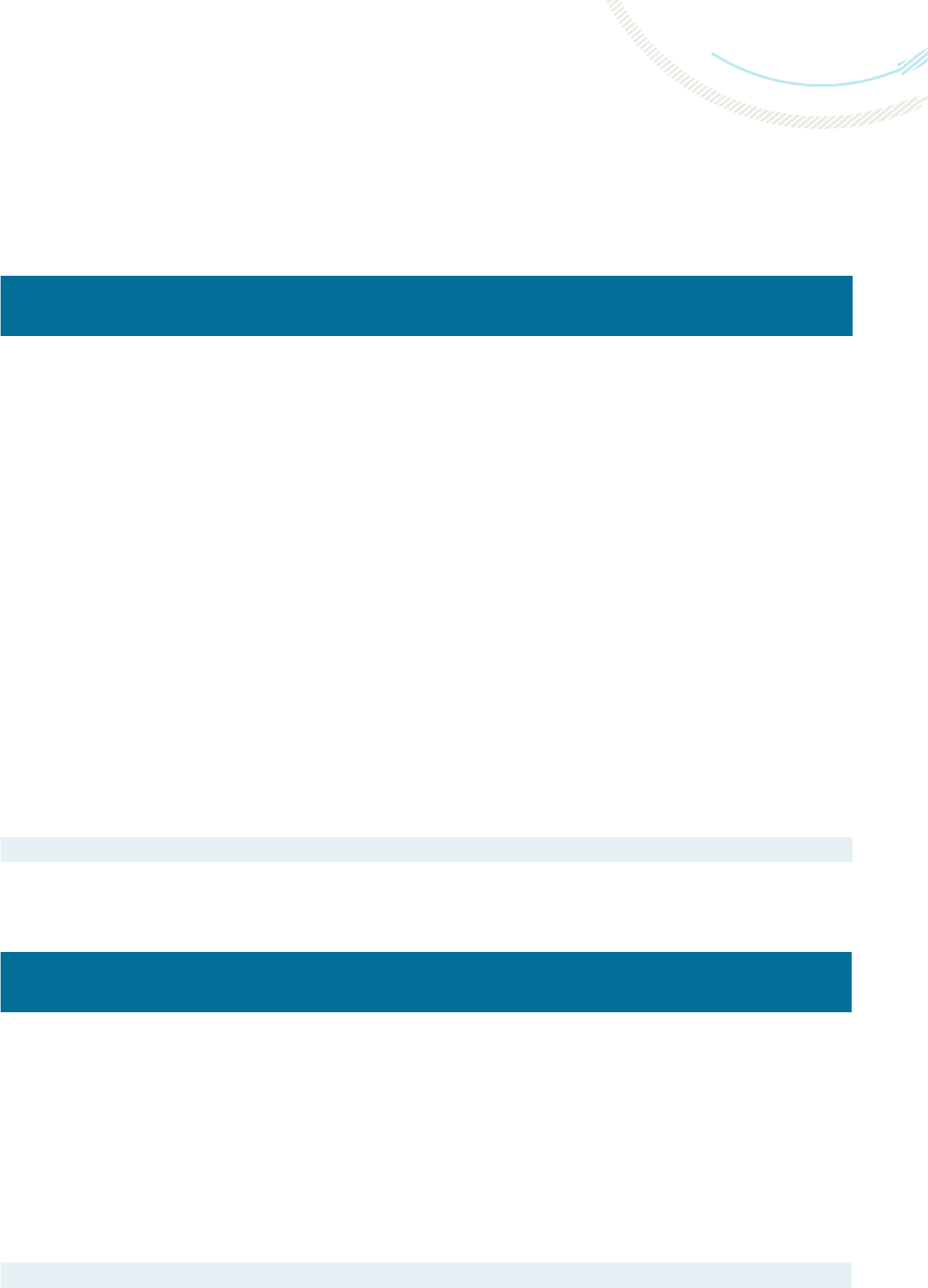
Notes to the Consolidated Financial Statements
Year ended 31 December 2021
28. Interest Income
The details of this item are as follows:
2021 2020
JD JD
Direct Credit Facilities
Individual (retail)
Overdra 113,751 161,019
Loans and discounted bills 23,730,837 21,810,913
Credit cards 627,162 666,515
Real estate mortgages 4,137,159 4,707,700
Corporate lending
Overdra 3,418,508 4,002,209
Loans and discounted bills 9,783,652 9,947,538
Small and medium enterprises lending “SME’s
Overdra 341,882 378,356
Loans and discounted bills 987,229 856,774
Government and Public Sector 2,119,478 1,035,269
Balances at central banks 16,301 135,662
Balances and deposits at banks and nancial institutions 333,741 582,765
Financial assets at fair value through other comprehensive income 6,217,814 6,950,177
Financial assets at amortized cost 8,569,565 8,256,785
Interest income on margin trading nancing for the subsidiary customer 2,668,881 2,583,016
Interest income on interest rate swap contracts 128,462 207,498
Total 63,194,422 62,282,196
29. Interest Expense
The details of this item are as follows:
2021 2020
JD JD
Banks and nancial institutions’ deposits 1,810,534 2,544,453
Customers deposits :
Current accounts and demand deposits 111,773 43,086
Saving deposits 19,111 24,088
Time and notice deposits 17,936,730 19,167,799
Margin accounts 1,394,390 1,456,136
Borrowed funds 3,371,767 3,454,757
Deposits guarantee fees 865,242 865,678
Interest paid on lease liabilities (Rents) 160,921 164,543
Interest paid on interest rate swap contracts 759,257 783,517
Total 26,429,725 28,504,057
119
BANK ABC IN JORDAN ANNUAL REPORT 2021
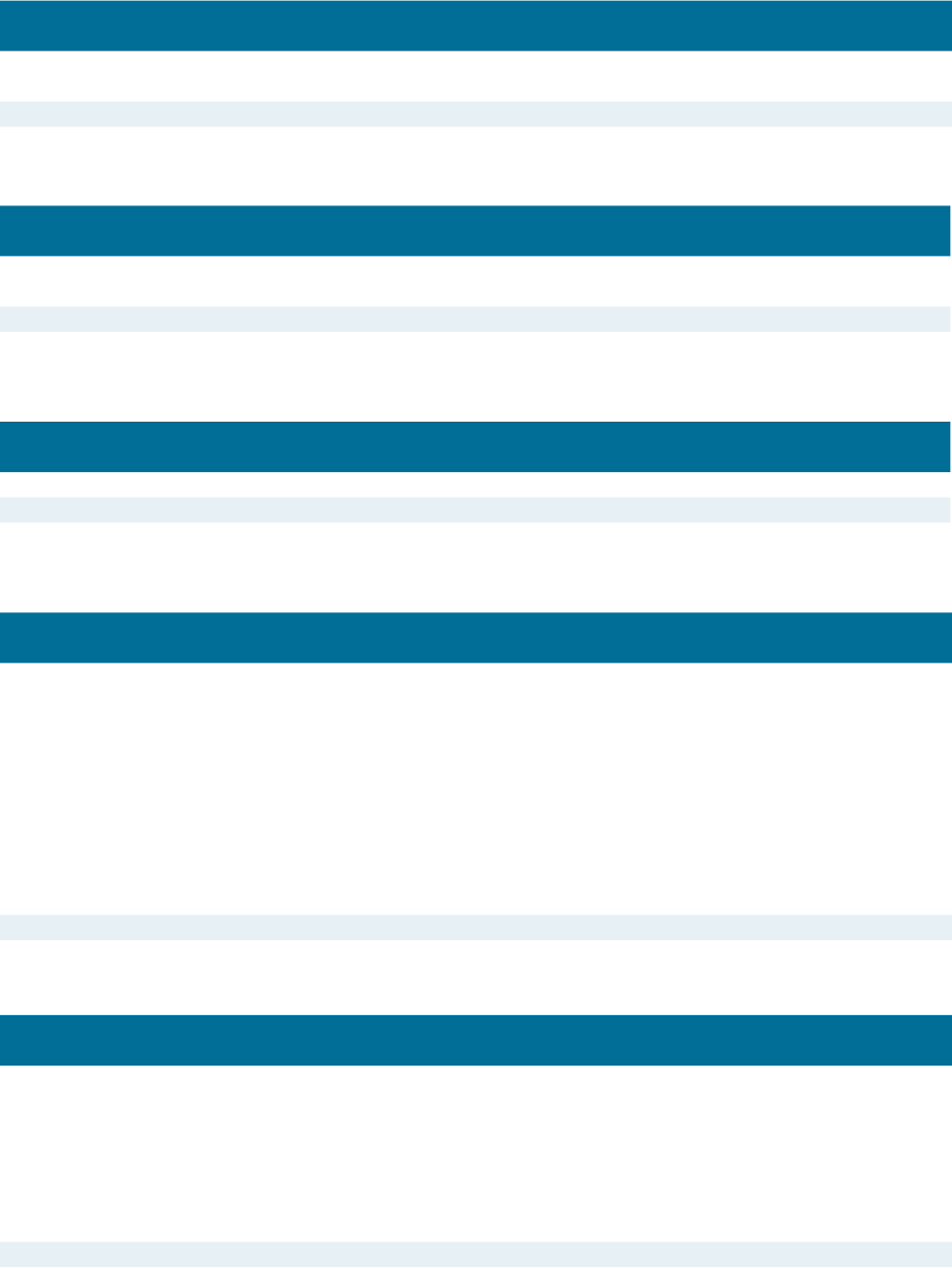
Notes to the Consolidated Financial Statements
Year ended 31 December 2021
30. Net Income Commission
The details are as follows:
2021 2020
JD JD
Direct facilities commissions 2,149,524 1,936,007
Indirect facilities commissions 1,571,041 1,399,679
Total 3,720,565 3,335,686
31. Gain on Foreign Currency Exchange
The details are as follows:
2021 2020
JD JD
Resulted from trading 1,100,021 476,774
Resulted from revaluation (140,292) 349,724
Total 959,729 826,498
32. Gain on Financial Assets at Fair Value from Other Comprehensive Income
The details are as follows:
2021 2020
JD JD
Dividends distribution income for corporations shares 4,000 31,875
Total 4,000 31,875
33. Other Income
The details of this item are as follows
2021 2020
JD JD
Brokerage commissions at nancial markets 1,182,119 1,388,408
Visa Income 517,081 469,118
Management and consulting fees 17,950 14,537
Transfers commission 196,527 163,398
Recovery of written-o debts 193,081 117,423
Capitalized Gain 2,195 29,702
Returned cheques commission 38,656 19,216
Salaries transfer commission 303,065 287,379
Postal fees 558,231 524,027
Others 502,730 451,452
Total 3,511,635 3,464,660
34. Employees Expenses
The details of this item are as follows:
2021 2020
JD JD
Salaries, benets and allowances 10,984,533 10,861,518
Employees’ bonuses 1,534,115 289,858
Social security contributions 1,348,882 1,361,789
Medical expenses 618,197 585,703
Training expenses 65,689 63,935
Travel and transportation expenses 9,198 6,651
Other 148,982 165,622
Total 14,709,596 13,335,076
120

Notes to the Consolidated Financial Statements
Year ended 31 December 2021
35. Other Expenses
The details of this item are as follows:
20202021
JDJD
668,770 781,007 Tax and fees
1,420,667 1,525,562 Computer expenses
1,033,434 381,330 Advertising and marketing expenses
2,373 9,720 Travel expense
238,509 212,476 General administration expenses (Bahrain)
962,154 954,370 Telecommunication expenses
599,148 631,260 Building Services and benets expenses
402,213 385,026 Board of Directors’ expenses
379,471 425,471 Oce supplies expenses
425,812 711,019 Borrowers transactions fees
66,152 96,381 Consulting fees
8,965 6,389 Magazines and newspapers subscription
427,922 579,383 Work-related and statutory fees
85,500 30,500 Board of Directors’ bonuses
213,057 157,986 ATM expenses
194,158 208,454 International Visa fees
153,116 - Provisions of lands prepared for sale
547,044 552,241 Other
7,828,465 7,648,575 Total
36. Earning per Share for the Bank’s Shareholders
The details are as follows:
20202021
JDJD
1,222,213 9,602,424 Prot for the year
110,000,000 110,000,000 Weighted average of the number of shares
-/011-/087 Basic and diluted earnings per share (JD/Fils)
The basic earnings per share from the prots for the year is equivalent to the diluted earnings per share from the prots for the year.
37. Cash and Cash Equivalent
The details for this item are as follows:
20202021
JDJD
Cash and balances with the Central Bank of Jordan maturing
52,217,48755,272,058 within three months
90,014,10157,226,865
Add: Balances at banks and nancial maturing within 3 months
Less: Banks and nancial institutions’ deposits maturing
(157,160,531)(144,058,639) within 3 months
(14,928,943)(31,559,716)
121
BANK ABC IN JORDAN ANNUAL REPORT 2021

Notes to the Consolidated Financial Statements
Year ended 31 December 2021
38. Derivatives
The following schedule represents the positive and negative fair value of nancial derivatives, and thedistribution of their nominal value
avccording to their maturity :
Nominal Value Maturity, according to Maturity Dates
Positive Fair
Value
Negative Fair
Value
Total Nominal
Value
Within 3
months
3-12
months
1-3 years
More than 3
years
Thousand
JD
Thousand
JD
Thousand
JD
Thousand
JD
Thousand
JD
Thousand
JD
Thousand
JD
2021
Foreign currencies derivatives held for trading 24 104 47,977 47,977 - - -
Hedge interest rate swap contracts - 135 7,090 3,545 - 3,545 -
24 239
2020
Foreign currencies derivatives held for trading 85 50 87,012 87,012 - - -
Hedge interest rate swap contracts - 323 7,090 - - 3,545 3,545
85 373
The nominal value represents the value of the current transaction for the year-end, and does not reect market risk and credit risk.
39. Related Party Transactions
Paid-up Capital
Company’s Name Ownership Percentage 2021 2020
% JD JD
Arab Co-operation for Financial Investments Company Ltd 100 15,600,000 15,600,000
All the balances and transactions between the Bank and the subsidiary company were eliminated.
The bank entered into transactions with parent and aliated companies, directors, senior management and their related concerns in the
ordinary course of business at commercial interest and commission rates. All credit facilities granted to related parties are performing
loans and are free of any provision for impairment.
The details for this item are as follows:
Related Party December 31,
Parent /
Subsidiary
Company
Executive
Management
Bank’s
Employees
Board of
Directors
2021 2020
JD JD JD JD JD JD
Consolidated Statement of Financial Position Items:
Direct credit facilities
- 1,861,435 10,701,496 17,215 12,580,146 11,645,658
Balances at banks and nancial institutions
11,687,324 - - - 11,687,324 11,987,761
Deposits at banks and nancial institutions
41,449,877 - - - 41,449,877 37,452,830
Customers’ deposits
- 2,874,493 1,956,663 1,864,597 6,695,753 5,524,875
Loans and borrowings
7,799,000 - - - 7,799,000 3,190,500
O-Consolidated Statement of Financial Position Items:
Letters of guarantee
23,285,931 - - - 23,285,931 41,549,882
letters of credit
7,813,299 - - - 7,813,299 3,815,790
Interest rate swap contracts
7,090,000 - - - 7,090,000 7,090,000
Currency swap contracts
10,635,000 - - - 10,635,000 32,018,000
2021 2020
Consolidated Statement of Income Items:
JD JD
Interest and commission income
345,815 34,743 240,072 - 620,630 1,112,871
Interest and commissions expense (330,522) (134,373) (329,997) (47,657) (842,549) (710,865)
122

Notes to the Consolidated Financial Statements
Year ended 31 December 2021
* Interest rates on credit facilities range from 3% to8.872%, and interest rates on customers’ deposits range from 0.01% to 4.5%.
** In addition to what was disclosed in the above table, the total balance of the credit facilities provided to the Bank’s related parties,
numbering 125 clients, amounted to JD5,271,788 as of December 31, 2021, against acceptable guarantees of JD3,297,468 as of December
31, 2021. The interest rates payable on these credit facilities range from 2% to 14%, while the commission rates range from .05% to 1%.
Summary of the Bank’s Executive Management’s Remunerations:
2021 2020
JD JD
Salaries and bonuses 2,451,831 2,372,229
Total 2,451,831 2,372,229
40. Risk Management
Based on the importance of managing the various risks
that surround the Bank’s business activities to which
the Bank is or may be exposed in the future, the Bank
continues to follow a risk management strategy in
line with the direction of the Board of Directors, senior
management, legislations, and laws issued by the
Central Bank of Jordan, as well as with the policies and
procedures of the parent institution in Bahrain, where the
best international practices and the latest methods and
techniques of risk management are applied. Moreover,
risk management at the Bank is directly linked to the risk
Management Committee of the Board of Directors.
The risk management process involves identication,
measurement, evaluation and monitoring of nancial and
non-nancial risks that can negatively aect the overall
performance of the Bank. It is the responsibility of senior
management to determine the main principles of risks
and the amount of risks that the Group can accept, as
well as their optimal distribution to the Bank’s various
business activities and sectors. During 2021, internal
capital adequacy assessment process ICAAP, which
included an assessment of the level of internal capital
adequacy, legal liquidity ratios and other ratios, was
continued on the basis of the expected business strategy
for the next three years.
The Bank has been able to maintain a high level of
capital adequacy as well as a comfortable liquidity
ratio in anticipation of any stressful situations that
may occur. It has also been able to maintain the Bank’s
durability according to ICAAP and Basel III requirements
and to keep up with any modications to the Basel
requirements.
The Central Bank of Jordan (CBJ) has released the Stress
Testing Instructions, hence the bank has developed
a methodology, Policy and Procedure and approved
by Board Risk Committee in order to apply these
instructions, where Stress tests are considered a key
element in risk management process at various level, as
follows:
- Considered a major quantitative tool for understanding
the bank’s risk prole and the ability of the bank to
withstand various types of shocks, and high risks.
- An important part of the capital planning process
through Internal Capital Adequacy Assessment Process
(ICAAP).
- Help the bank to estimate the size of future capital that
must be available in the coming years in accordance
with its established strategy.
- An important part of identifying, measuring, and
controlling liquidity risks in order to assess the bank’s
liquidity and the adequacy of liquidity shocks mitigating
tools.
These tests are designed to assess the bank’s nancial
situation in stress but possible scenario, where the
necessary reports have been made and submitted to
the Board Risk Committee, which adopt the assumptions
and scenarios used, discuss the results of the tests, and
adopt the actions to be taken based on these results.
Governance of Stress Testing
Stress tests must be a key part of risk governance and
risk management culture of the bank in order to enhance
the ability of the bank to identify and control risks.
The Role of the Board of Directors:
• The board of directors must ensure the existence of
an eective framework for stress tests to evaluate the
ability of the bank to withstand shocks and confront
high risks. In this regard, the stress testing program at
the bank will be the ultimate responsibility of the board
of directors, and approve of the related policies and
procedures.
123
BANK ABC IN JORDAN ANNUAL REPORT 2021
Notes to the Consolidated Financial Statements
Year ended 31 December 2021
• The board of directors must verify that the risk
management department conducts the stress tests
on a periodic basis. The board of directors must
have a major role in setting the assumptions and the
scenarios used, analyzing the stress testing results, and
approving the procedures to be implemented based on
the stress testing outcomes.
The Role of the Senior Executive Management:
• Executing and monitoring the stress testing program
and in line with the methodology adopted by the
board of directors which is in line with the determined
stress testing based on the Central Bank of Jordan
instructions.
• Ensuring the availability of a qualied sta at the risk
management department to conduct the stress testing
and that the department does possess the appropriate
tools and means for the tests.
• Ensuring the availability of a suitable number of possible
scenarios that are related to the business of the bank,
given that these scenarios are well- understood and
documented.
• Using the results of the stress tests in setting and
identifying the bank’s risk appetite statement, and in
planning for capital and liquidity.
The Role of the Risk Management:
To adopt the Central Bank of Jordan instructions related
to the design of stress testing program and use of forms
and methodologies to determine their impact on the bank
to cover, but not be limited to, the following aspects:
• Stress tests must encompass scenarios ranging from
the lowest impact to the highest impact
• Making sure that the tests cover all the complex
nancial products as needed
• Taken into consideration the possible changes in the
market circumstances that might adversely impact the
bank’s exposure to concentration risks
• Stress tests shall include scenarios to evaluate the size
and impact of the o- balance sheet assets on other
types of risks
• including some scenarios that are related to the
reputational risks in stress tests, by reecting the
risks outcome which may have an impact of the Bank’s
reputation and in which it also reect on the Bank’s
liquidity, it’s liquid assets, through withdrawals of
deposits by some customers.
• The tests used must be appropriate to the degree of
risk appetite that the bank has set for itself so that the
scenarios selected by the bank commensurate with the
size, nature, and complexity of the bank’s business as
well as the risks associated with the bank.
• The stress testing program must include both
quantitative and qualitative methods to improve the
comprehensiveness of these tests and make them
supportive and complementary to the patterns and
approaches of risk management used in the bank.
• The tests must range from simple sensitivity tests
that are based on the change(s) in a single risk factor
analysis sensitivity and to scenarios that are based on
statistical methods which take into consideration the
relationships among the drivers of systemic risks in
times of crises, noting that the part related to scenario
analysis is annually determined by the Central Bank of
Jordan.
• Set a suitable dialogue format among the various
related parties in order to obtain their views and
opinions regarding the possible shocks and stressful
situations in case of it occurrence so that it can then
identify the assumptions and scenarios suitable for
the internal and external risks that the bank might be
exposed to. All concerned parties in the bank, such as
Compliance Department, Internal Audit Department,
Central Operation Department, Legal Department and
Businesses Departments and others involved must
participate in this dialogue in order to identify the
possible shocks for Operational Risk on an annual basis
and according to the instructions of the Central Bank of
Jordan.
• The results of the tests should be submitted to the
Local Assets and Liability Committee and the local Board
Risk Committee and the Risk Committee stemmed by
the Bank’s Board of Directors and on an annual basis.
The Role of the Internal Audit:
The internal audit department is responsible for
reviewing and evaluating the stress testing framework
at least once a year, and for reporting the results of the
review and evaluation to the board of directors.
During 2020, the Bank reviewed and updated all risk
policies based on the determined period for this and
in which it ensures all the monitoring and internal
requirements to be adopted by the Board of Directors,
noting that the Bank keen on periodically reviewing the
various policies in order to deal with the surrounding
risks and limit their impact.
During 2021, the Bank continued to implement IFRS
(9) requirements through applying the methodology
adopted by the parent institution in Bahrain with some
124

Notes to the Consolidated Financial Statements
Year ended 31 December 2021
adjustments to suit the requirements of the Central Bank
of Jordan in this regard. Moreover, the expected credit
losses (ECL) have been calculated based on the stages of
classication of assets within the stages specied in this
standard in accordance with Bank’s nancial statements
for the year 2021. These results were presented to the
Board of Directors, Board Risk Committee, and the Local
Committee of the Bank. The following represents a
background of this methodology:
1. Denition of the Bank’s implementation of default
and the mechanism of dealing with default
The Bank follows and applies the Central Bank of
Jordan’s Instructions No. (2009/47) dated December
10, 2009 for the classication of the non-performing
accounts for the outstanding Bank’s credit portfolio,
where it classies the non-performing debts and
interest in suspense automatically within the used
Bank’s system, and according to the classications
included in the instructions (sub-standard, doubtful
debts, and loss debts).
1) Bank’s application of default:
The Central Bank of Jordan’s instructions are applied
with regards to the classication of impaired debts and
suspension of interest. As for provisions, the Central
Bank of Jordan’s instructions and the internal Bank’s
policies are applied, whereby the most conservative
results are taken.
2) Mechanism of default treatment:
• Scheduling of indebtedness according to the
scheduling principles stated in the instructions of the
Central Bank of Jordan.
• Final payments and deducting part of the debt.
• Taking legal procedures to collect the Bank’s rights.
• Manually transferring non-performing accounts to
performing accounts.
Taking into consideration the instructions of the Central
Bank of Jordan and the internal policy adopted by the
Bank, where the more conservative and strict procedures
are adopted. The classication of risk ratings for non-
performing accounts is adopted as follows:
Classication
Segment
Internal Classication for
Non-performing Facilities
Sub-standard 9
Doubtful debts 10
Loss debts 11
2. Detailed explanation of the Bank’s internal credit
classication system and its working mechanism
The Bank evaluates corporate customers based on
Moody’s internal evaluation system. Moreover, the
evaluation relies on the evaluation of the nancial
elements and the non-nancial elements where the
nancial statements relating to the results of corporate
clients are entered into the internal rating system
when granting, reviewing, or modifying the ceilings of
the facilities granted to the client within the ratios and
nancial indicators specied on the system. In addition,
there are standards and non-nancial requirements
entered into the system to extract the customer’s degree
of risk classication based on the risk classication
degree listed below. This degree is entered through the
Bank’s system, indicating that the classication degrees 7
& 8 also include watch-list facilities accounts. On the other
hand, the classication ratings of (9, 10, and 11) relate
to the non-performing facilities accounts based on the
Central Bank of Jordan’s Instructions No. (47/2009). In this
respect, the classication related to the watch list and
non-performing accounts are performed automatically in
the system.
Internal Risk Grade Description
1 Exceptional
2 Excellent
3 Superior
4 Good
5 Satisfactory
6 Adequate
7 Marginal/Watch list
8 Special mention
(NPLs (9,10 &11 Sub-Standard, Doubtful and Loss
125
BANK ABC IN JORDAN ANNUAL REPORT 2021
Notes to the Consolidated Financial Statements
Year ended 31 December 2021
3. Mechanism adopted for calculating the expected
credit losses (ECL) based on nancial instruments for
each individual item.
• The expected credit losses are calculated based on
nancial instruments classied under the amortized
cost portfolio or through the other comprehensive
income statement based on an individual basis, on debt
instruments. The calculation is performed according to
the Treasury Department’s business model adopted
by the Bank’s Board of Directors, where these tools
are subject to impairment calculation (Expected credit
losses) according to IFRS (9) requirements. Meanwhile,
loss is recorded in the consolidated statement of Prot
or Loss.
• The debt instruments issued or guaranteed by the
Government of Jordan are excluded from the expected
credit loss.
4. Regulatory requirements for the implementation of
International Financial Reporting Standard (9) including
the responsibilities of the Board of Directors and
Executive Management in ensuring compliance with the
said requirements.
• The Bank’s Board of Directors shall adopt the
policies and documents relating to the standards,
methodologies, and the basis for calculating the
requirements of IFRS (9) according to the Central Bank
of Jordan’s instructions, including periodically reviewing
the results of the expected credit losses calculation and
standing up on the developments and updates related
to these results, in addition to the basis and other
matters related to the calculation.
• The Board of Directors approves any exceptional case
in which an allowance is made or expected credit losses
are taken, and the adjustments concerning the expected
credit losses calculation results according to clear and
reliable justications.
• The Bank’s Steering Committee for managing the
application of IFRS (9) is chaired by the CEO, and its
membership consists of each of the heads of the
executive departments concerned with the application.
The members represent the heads of the business
units, backing and support group, risk management,
nancial control, and information system management.
This Committee supervises the application of IFRS
(9) requirements, and is responsible for applying
it to ensure that the concerned departments shall
implement this plan according to the competence of
each to comply with the roles assigned; implement the
procedures related to the implementation steps and
stages of applying this standard in the Bank; present
the completion results once ready; and coordinate with
the various credit committees in the Bank to obtain
the necessary approvals for the cases that require an
adjustment to the results of calculating the volume
of the expected losses, and reviewing the result of
calculating the volume of credit facilities.
•The Credit Committee presents and reviews the list of
accounts that need to be monitored closely and under
control in order to verify that the size of the provisions
calculated are in accordance with the required standard
commensurate with the credit risk related to these
accounts.
• The requirements of IFRS (9) has been implemented
through the Arab Banking Corporation/parent company
in Bahrain. Moreover, agreement has been reached
d to apply this standard at the Group’s level through
Moody’s Company.
5. Denition of the mechanism for calculating and
controlling the probability of default (PD), credit
exposure at default (EAD), and loss given default (LGD).
• According to IFRS(9), the expected credit loss
measurement model has been applied using the
following framework:
• Expected Credit Losses = Credit Exposure at Default *
Probability of Default * Loss Given Default.
• Credit exposure is calculated according to the Central
Bank of Jordan’s instructions as follows: loans and credit
facilities (direct and indirect), debt instruments recorded
at amortized cost, debt instruments recorded at fair
value through the statement of comprehensive income,
nancial guarantees, credit exposures to bank and
nancial institution, the unutilized direct limits, taking
into consideration the conversion factor for indirect
requirements. A rate of 100% has been adopted for
calculating the exposure at default.
• The Probability of Default ratios have been calculated
according to the results of the evaluation of the risk
degree of the credit portfolio of the customers during
the past years. Moreover, the required review has been
conducted regarding the customer’s risk assessment
forms for all corporates and banks through Moody’s
system according to the following table:
126

Notes to the Consolidated Financial Statements
Year ended 31 December 2021
Moody’s Rating Notch ABC – Rating
Aaa 1 1
Aa1 2 2+
Aa2 3 2
Aa3 4 2-
A1 5 3+
A2 6 3
A3 7 3-
Baa1 8 4+
Baa2 9 4
Baa3 10 4-
Ba1 11 5+
Ba2 12 5
Ba3 13 5-
B1 14 6+
B2 15 6
B3 16 6-
Caa1 17 7+
Caa2 18 7
Caa3 19 7-
Ca 20 8
Sub-Standard 9
Doubtful 10
Loss 11
• The loss given default ratio is calculated using the
systems approved by the external supplier of Moody’s
company, assuming that the default happens aer
calculating the recoverable amount of the credit
exposure and the timing of the recovery, taking into
consideration the collaterals provided against the credit
exposure and the application of the deduction ratios
determined in accordance with the internal standards
adopted by the Bank.
• The methodology for calculating the expected credit
loss in the stage one and two was adopted on a
Collective Basis level for the retail portfolio (personal
loans, housing loans, credit cards and auto nancing
loans). Moreover, the Roll Rate Approach was adopted.
Such portfolios or products carry similar credit risk and
share several elements such as (type of product, quality
of collateral provided, nature of nancing, duration of
nancing, sector, etc.)
• The stress tests required in accordance with IFRS (9),
which is part of the expected credit loss calculation
process, were adopted in three scenarios to study
the future forecasts and their eect on the variables
of the expected credit loss measurement model,
represented by a base scenario, downside scenario, and
upside scenario, since we have adopted the weighted
probability value for these scenarios.
• As for the calculation of the credit loss under Stage
3, we continue to follow the Central Bank of Jordan’s
Instructions No. (47/2009) for the classication of non-
performing debts, suspension of interest, calculation
of provisions and acceptable haircut rates for collateral
based on these instructions and the volume of credit
losses are calculated based on IFRS 9 in which the more
conservative is taken.
6. Determinants of the signicant change in the
credit risk on which the Bank relies for calculating the
expected credit losses
To calculate the size of the credit loss for the facilities
of corporate customers and nancial institutions (the
Banks) of all types to be classied as part of the stage
two, the investment portfolio, indirect liabilities on
individual basis, the determinants of the signicant
change in credit risk (SICR) were adopted as follows:
• A decrease or deterioration in the actual internal credit
rating of the borrower according to the internal rating
system applied by the Bank related to comparison
127
BANK ABC IN JORDAN ANNUAL REPORT 2021
Notes to the Consolidated Financial Statements
Year ended 31 December 2021
with the internal rating of the borrower at the time of
granting the loan.
• Accounts with no risk rating degree on the system at
the facility granting and their current degree of risk
rating 5+ or worse classied in stage two.
• The unpaid accruals on one of the client accounts or the
borrower equal to or greater than 30 days.
• Accounts classied as watch list (internal ratings 7 and
8).
• Accounts that need to be actively monitored by the
Bank within the account.
• Accounts that have restructured the debtor’s
obligations (structuring obligations).
• As for the credit portfolio for retail facilities of all types,
the customers’ loans with dues for more than or equal
to 30 and less than 90 days are classied in the stage
two, in addition to the restructured accounts.
7. The Bank’s policy in identifying the common
elements (characteristics) on which the credit risk and
expected loss are based on a collective basis
• The methodology for calculating the expected credit
loss in stage one and two was adopted at the Collective
Base level for the retail portfolio (personal loans,
personal loans against cash margins, housing loans,
credit cards, and auto nancing loans). Moreover, the
Roll Rate Approach was adopted. Such portfolios or
products carry similar credit risks and share several
elements such as (type of product, quality of collateral
provided, nature of nancing, duration of nancing,
sector, etc.).
• The roll-rate approach was used to calculate the
probability of default for retail products for each
product based on the reports extracted from the Bank
during the past years and monthly to determine the
distribution of dues. The loss given default ratio was
calculated by reference to the size of the realized
recoveries of the NPL portfolio for each type of the retail
portfolio, including the overdrawn account during the
previous years.
• Recently, an independent and more detailed
methodology has been developed to calculate the
expected credit loss of the credit portfolio granted
by the subsidiary “Arab Co-operation for Financial
Investments”, representing the nancing of shares
within margin trading and Spot trading products for
Stage (1), Stage (2), and Stage (3). In this regard, the risk
rating of the performing portfolio customers classied
within Stage (1) has been considered one notch less
than the risk rating of the country (Jordan). Meanwhile,
the risk rating of the customers classied within Stage
(2) has been considered four notches less the risk
rating of the country (Jordan). As for the maturity of
the credit facilities, the maturity date of the margin
trading product has been considered one whole year
for the credit facilities classied within Stage (1). At
the same time, 4 years have been added to the credit
facilities classied within stage (2). As for Spot trading
product, the maturity of these facilities is 3 months,
whereas for the loss given default, 5 %( LGD Floor) has
been adopted for the facilities classied within Stage
(1) (calculated according to the coverage percentage of
the existing credit facilities), and 10% for the LGD Floor
for the customers classied within Stage (2). As for
the classication of Stage (3) (Defaulted accounts), the
Company adopts the approved internal policy in this
regard.
8. Primary economic indicators used by the Bank in
calculating the expected credit loss probability of
default (PD)
The parent institution in Bahrain used an external
supplier to conduct the calculation of expected credit
loss by adopting three scenarios to study the future
forecasts and their impact on the variables of the credit
loss measurement model. The economic factors used in
the calculation were the economic growth ratios in Jordan
and the stock price index.
The banking signicant risk for the Group and
management tools to handle it:
(40/a) Credit Risk
Credit risk represents the other party’s default or inability
of the nancial instrument to meet its obligations toward
the Group which could result in a loss. The Bank divides
the direct credit facilities portfolio into four sections
comprising credit facilities for governments and nancial
institutions, including banks and companies, consisting
of both corporate and medium-size facilities; as well as
retail facilities, including personal loans, housing loans
and other products such as credit cards and personal
car loans. These policies include rules and procedures
that must be adhered to when granting or renewing
facilities. They also include a special evaluation for each
customer through rating, whereby CreditLens is currently
used to classify the facilities of corporates and medium
companies, and in which is performed automatically. In
addition, a Credit Scoring model is adopted to assess
customers included in the retail portfolio.
The Bank is also pursuing a policy of diversication at the
level of customers, economic sectors and geographical
regions, which contributes to reducing the degree of
128

Notes to the Consolidated Financial Statements
Year ended 31 December 2021
credit risk. In order to control the risks of lending, the
Risk Management Committee of the Board of Directors
holds periodic meetings to discuss all matters related to
credit risk, and is provided with quarterly reports on the
distribution of the facility portfolio in terms of economic
distribution, credit rating, geographical distribution, tenor
for facilities, volume of expected credit losses, review of
the results of regulatory and internal capital adequacy
ratios, and the results of stress testing and risk appetite
limits, which determine the direction of the Bank in the
upcoming period. The adequacy of the impairment
provision for the credit facilities is reviewed periodically in
accordance with the instructions of the Central Bank of
Jordan. Moreover, the volume of expected credit losses is
reviewed in accordance with IFRS (9).
The details of the direct credit facilities portfolio are
stated in Note (8). In addition, the Group’s o-balance
sheet nancial position obligations carrying credit risks
are detailed in Note (40).
Rescheduled Debts:
These represent the debts pre-classied as non-
performing credit facilities and derecognized as
non-performing credit facilities according to assets
rescheduling, and recognized as stage 2 debts. The total
rescheduled debts amounted to JD799,863 during 2021
(JD527,977 during 2020).
Restructured Debts:
Restructuring means rearranging the credit facilities
through amending the installments, prolonging the
facilities, postponing some other installments, increasing
the grace period, or classifying the credit facilities as
debts under Watch list. Restructured debts totaled
JD30,152,227 including some accounts that have been
restructured twice during the year totaling JD6,021,777
as of December 31, 2021 (a total of JD16,037,230 as of
December 31, 2020 , including some accounts that have
been restructured twice during the year with a total of
JD9,374,285).
1 - Credit Exposures Distributions
Internal
Rating
for the Bank
External
Institutions
Classication
Category Classication
According to (2009/47)
Total
Exposure
Value
Expected
Credit
Loss
Probability of Default
Exposure
when Default
Average Loss
on Default
JD JD % JD %
1 Aaa Performing Loans 16,734,801 12,280 from 0.0016 - to 0.0515 16,746,956 from 0.01-to 0.6
2 Aa1 , Aa2 , Aa3 Performing Loans 13,693,109 11 from 0.000187082 - to 0.5042 13,693,119 from 0.01-to 0.6
3 A1 , A2 , A3 Performing Loans 43,254,090 15,591 from -0.000318583 to 0.001550364 43,269,681
from 0.320586355-to
0.493614057
4 Baa1 , Baa2 , Baa3 Performing Loans 34,466,239 205,853 from 0.002149292-to 0.004905712 34,672,092
from 0.417631802-to
0.496370387
5 Ba1 , Ba2 , Ba3 Performing Loans 411,191,499 2,303,502 from 0.006539735-to 0.014563547 359,320,074 from 0.02-to 0.499269072
6 B1 , B2 , B3 Performing Loans 730,905,718 2,976,277 from 0.015529212-to 0.05133581 722,965,223 from 0.02-to 0.571400534
7 Caa1 , Caa2 , Caa3 Performing Loans 22,276,972 1,872,333 from 0.049041311-to 0.167857161 22,952,093 from 0.02-to 0.519752535
8 Ca Performing Loans 15,561,554 8,927,481 from 0.1556617-to 0.224509044 24,484,035 from 0.02-to 0.520075952
Total
1,288,083,982
16,313,328 1,238,103,273
Non-performing exposures
9 Non Performing 1,362,696 514,892 100% 1,877,589
10 Non Performing 1,009,218 1,852,389 100% 2,861,606,216
11 Non Performing 6,142,229 42,981,133 100% 49,123,361
Total 8,514,143 45,348,414 2,912,607,166
Net total 1,296,598,125 61,661,742 4,150,710,439
129
BANK ABC IN JORDAN ANNUAL REPORT 2021

Notes to the Consolidated Financial Statements
Year ended 31 December 2021
2. Credit risk according to economic sectors:
a. Distributions according to nancial instruments exposure:
2021 2020
Financial Industrial Trading Real Estate Agriculture Stock Individuals
Government
and Public
Other
Services
Total Total
JD JD JD JD JD JD JD JD JD JD JD
Cash at central Banks
- - - - - - - 49,417,591 - 49,417,591 45,522,857
Balances at banks and nancial
institutions
57,218,887 - - - - - - - - 57,218,887 89,979,061
Deposits at banks and nancial
institutions
23,978,806 - - - - - - - - 23,978,806 7,343,135
Direct Credit facilities
10,981,439 99,227,166 40,061,307 82,250,103 3,422,895 30,596,210 330,431,966 49,098,506 47,259,605 693,329,197 649,941,932
Bonds and bills:
Within: Financial assets at amortized cost
14,991,783 - - - - - - 124,322,625 - 139,314,408 126,843,748
Within: Financial Assets through other
comprehensive income
7,231,800 - - - - - - 124,818,087 - 132,049,887 132,332,356
Within: Mortgaged nancial assets
- - - - - - - 51,926,112 - 51,926,112 62,631,159
Other Assets
9,017,304 152,313 322,626 128,151 216 - 605,153 4,581,778 12,469 14,820,010 8,005,899
Total for the year
123,420,019 99,379,479 40,383,933 82,378,254 3,423,111 30,596,210 331,037,119 404,164,699 47,272,074 1,162,054,898 1,122,600,147
Letter of guarantees
39,879,131 6,272,966 10,295,399 9,824,256 60,019 - - -
13,690,481
80,022,252 99,672,778
Letter of credit
7,918,710 8,835,703 4,140,607 224,888 1,778,107 - - - - 22,898,015 17,284,167
Other Liabilities
7,146,017 2, 507,731 7,542,060 1,769,621 194,986 855,119 6,635,544 - 4,971,882 31,622,960 42,190,255
Total
178,363,877 116,995,879 62,361,999 94,197,019 5,456,223 31,451,329 337,672,663 404,164,699 65,934,437 1,296,598,125 1,281,747,347
b. Distribution of exposure according to staging IFRS (9)
2021 2020
Stage (1) Stage (2) Stage (3)
Individual Collective Individual Collective Total Total
JD JD JD JD JD JD JD
Financial 178,341,326 - - - 22,551 178,363,877 199,085,056
Industrial 95,549,794 - 20,495,828 - 950,257 116,995,879 132,208,241
Trading 40,740,371 - 20,730,365 - 891,263 62,361,999 77,749,845
Real Estates 20,092,272 57,484,055 2,840,397 9,476,109 4,304,186 94,197,019 100,981,128
Agriculture 5,335,942 - 23,227 - 97,054 5,456,223 1,721,592
Stock - 25,875,078 - 3,976,130 1,600,121 31,451,329 27,349,530
Individual 567,849 329,111,832 - 7,385,825 607, 157 337,672,663 291,041,442
Government and public sector 404,164,699 - - - - 404,164,699 379,929,573
Other Services 64,828,930 - 1,063,953 - 41,554 65,934,437 71,680,940
Total 809,621,183 412,470,965 45,153,770 20,838,064 8,514,143 1,296,598,125 1,281,747,347
130
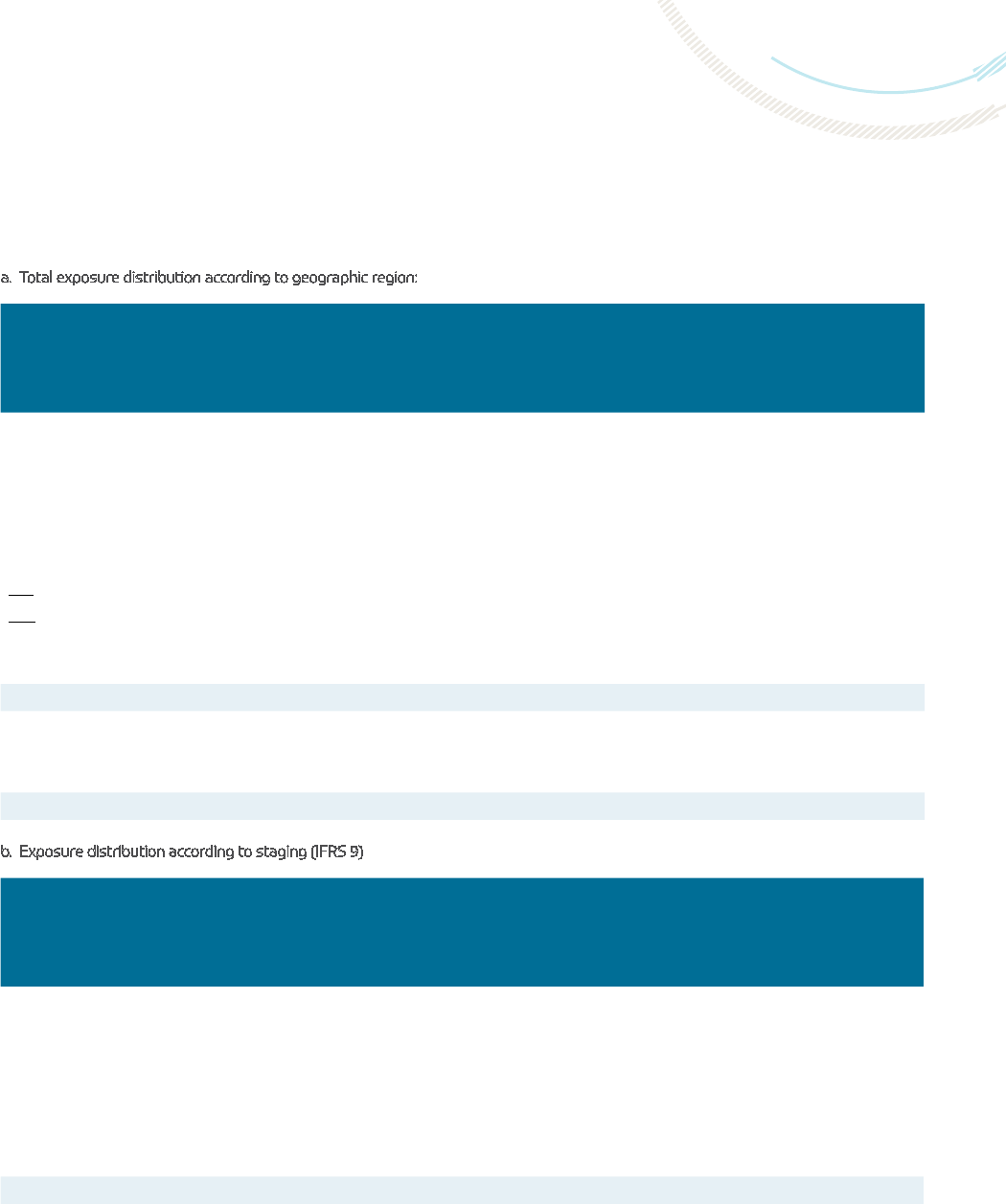
Notes to the Consolidated Financial Statements
Year ended 31 December 2021
3. Exposure distribution according to geographical distribution
a. Total exposure distribution according to geographic region:
2021 2020
Other Middle
Inside Jordan
East
Countries
Europe Asia Africa America
Other
Countries
Total Total
JD JD JD JD JD JD JD JD JD
Cash and balances at central banks 49,417,591 - - - - - - 49,417,591 45,522,857
Balances at banks and nancial institutions 21,894,416 11,143,723 10,021,711 2,259,059 68,668 11,831,310 - 57,218,887 89,979,061
Deposits at banks and nancial institutions - 17, 597,806 - - - 6,381,000 - 23,978,806 7,343,135
Direct Credit facilities 693,329,197 - - - - - - 693,329,197 649,941,932
Bonds and bills:
Within: Financial assets through other comprehensive income 124,818,087 7,231,800 - - - - - 132,049,887 132,332,356
Within: Financial assets at amortized cost 139,314,408 - - - - - - 139,314,408 126,843,748
Mortgaged nancial assets (liabilities) 51,926,112 - - - - - - 51,926,112 62,631,159
Other assets 5,887,353 131,409 - 8,795,828 - 5,420 - 14,820,010 8,005,899
Total for the year 1,086,587,164 36,104,738 10,021,711 11,054,887 68,668 18,217,730 - 1,162,054,898 1,122,600,147
Letters of guarantees 40,522,360 9,521,793 17,247,049 - 460,963 6,076,304 6,193,783 80,022,252 99,672,778
Letters of credit 14,928,979 - 1,700,963 - 6,268,073 - - 22,898,015 17,284,167
Other Liabilities 31,622,960 - - - - - - 31,622,960 42,190,255
Total 1,173,661,463 45,626,531 28,969,723 11,054,887 6,797,704 24,294,034 6,193,783 1,296,598,125 1,281,747,347
b. Exposure distribution according to staging (IFRS 9)
2021 2020
Stage (1) Stage (2) Stage (3)
Individual Collective Individual Collective Total Total
JD JD JD JD JD JD JD
Inside Jordan 686,684,521 412,470,965 45,153,770 20,838,064 8,514,143 1,173,661,463 1,151,174,021
Other Middle East countries 45,626,531 - - - - 45,626,531 49,580,060
Europe 28,969,723 - - - - 28,969,723 47,715,978
Asia 11,054,887 - - - - 11,054,887 539,982
Africa 6,797,704 - - - - 6,797,704 351,802
America 24,294,034 - - - - 24,294,034 25,492,358
Other Countries 6,193,783 - - - - 6,193,783 6,893,146
Total 809,621,183 412,470,965 45,153,770 20,838,064 8,514,143 1,296,598,125 1,281,747,347
131
BANK ABC IN JORDAN ANNUAL REPORT 2021
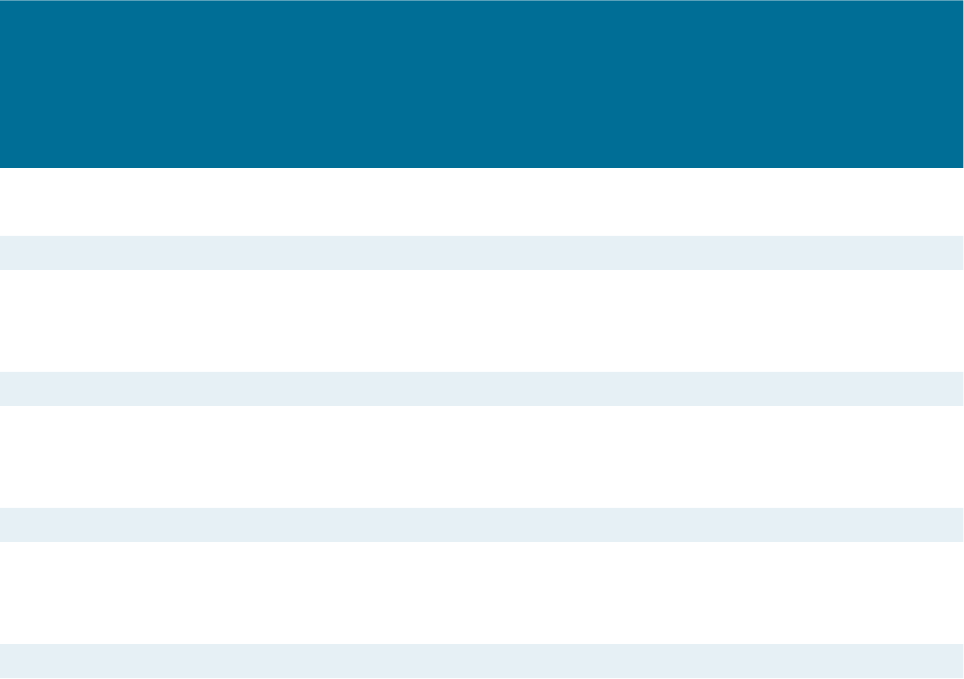
Notes to the Consolidated Financial Statements
Year ended 31 December 2021
4. Credit exposures that have been reclassied
a. Total credit exposures that have been reclassied:
Stage (2) Stage (3)
Total
Exposures
Amount
Exposures
that
have been
Reclassied
Total
Exposures
Amount
Exposures
that
have been
Reclassied
Total
Exposures
that have
been
Reclassied
Percentage
of
Exposures
that have
been
Reclassied
JD JD JD JD JD %
2021
Direct credit facilities 63,033,105 8,673,456 3,569,477 2,415,319 11,088,774 1.18%
Total 63,033,105 8,673,456 3,569,477 2,415,319 11,088,774 1.18%
Letters of guarantee 691,913 4,950 4,944,666 7,500 12,450 0.0013%
Letters of credit 850,328 - - - - 0.0000%
Other liabilities 1,377,810 25,361 - - 25,361 0.0027%
Net Total 65,953,156 8,703,767 8,514,143 2,422,819 11,126,586 1.1795%
2020
Direct credit facilities 77,954,122 13,284,821 6,262,998 1,625,426 14,910,247 0.85%
Total 77,954,122 13,284,821 6,262,998 1,625,426 14,910,247 0.85%
Letters of guarantee 2,700,878 2,385,891 4,914,055 967,881 3,353,772 0.19%
Letters of credit 907,278 - - - - 0.00%
Other liabilities 3,167,593 70,778 - - 70,778 0.04%
Net Total 84,729,871 15,741,490 11,177,053 2,593,307 18,334,797 1.05%
132
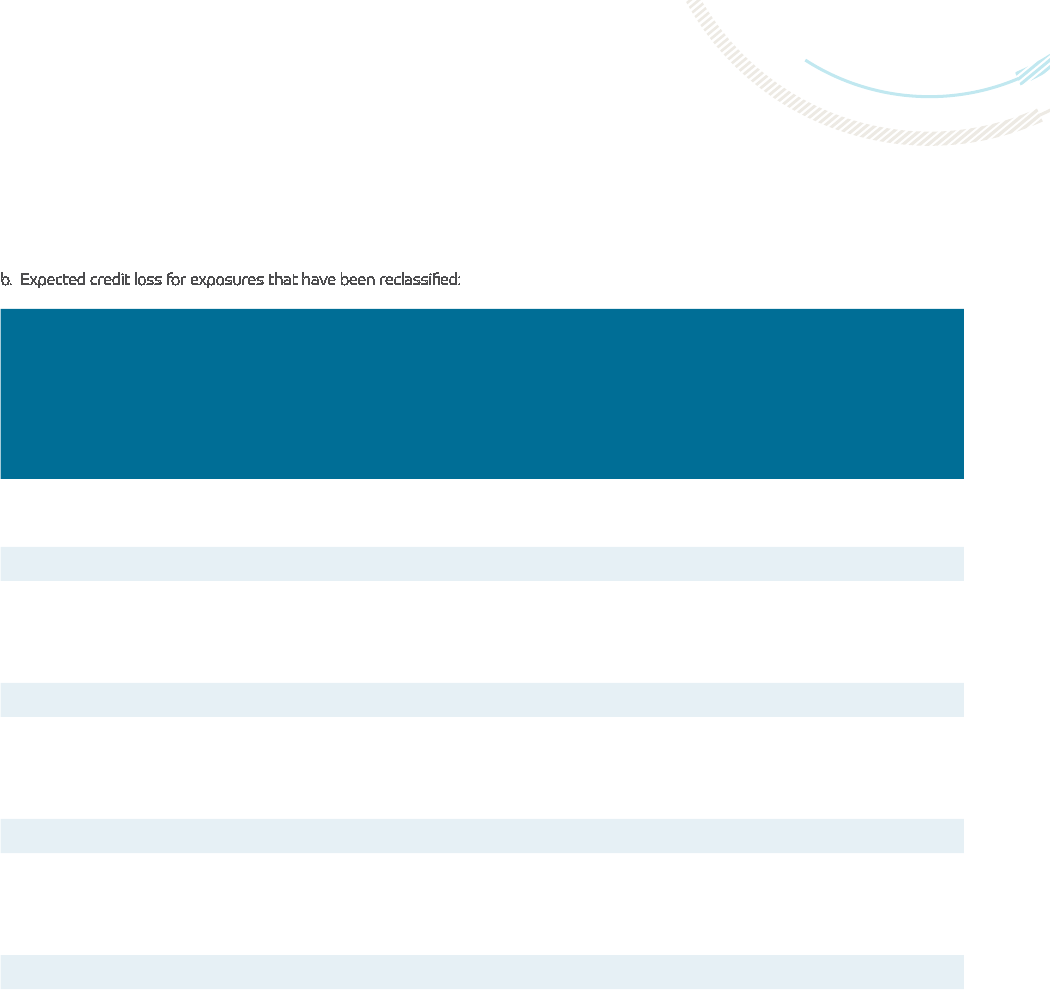
Notes to the Consolidated Financial Statements
Year ended 31 December 2021
Reclassied credit exposures
b. Expected credit loss for exposures that have been reclassied:
Exposures that have been reclassied Expected credit loss due to reclassied exposures
Exposure Exposure
Reclassied Reclassied Stage (2) Stage (3)
from Stage (2)
from Stage
(3)
Total Individual Collective Individual Collective Total
Description JD JD JD JD JD JD JD JD
2021
Direct credit facilities 8,673,456 2,415,319 11,088,774 105,942 1,396,752 1,322,762 3,746,492 6,571,948
Total 8,673,456 2,415,319 11,088,774 105,942 1,396,752 1,322,762 3,746,492 6,571,948
Letters of guarantee 4,950 7,500 12,450 50 - - - 50
Letters of credit - - - - - - - -
Other liabilities 25,361 - 25,361 1,278 - - - 1,278
Net Total 8,703,767 2,422,819 11,126,586 107,269 1,396,752 1,322,762 3,746,492 6,573,275
2020
Direct credit facilities 13,284,821 1,625,426 14,910,247 83,059 559,510 4,911,406 296,703 5,850,678
Total 13,284,821 1,625,426 14,910,247 83,059 559,510 4,911,406 296,703 5,850,678
Letters of guarantee 2,385,891 967,881 3,353,772 10,453 - - - 10,453
Letters of credit - - - - - - - -
Other liabilities 70,778 - 70,778 940 - - - 940
Net Total 15,741,490 2,593,307 18,334,797 94,452 559,510 4,911,406 296,703 5,862,071
133
BANK ABC IN JORDAN ANNUAL REPORT 2021

Notes to the Consolidated Financial Statements
Year ended 31 December 2021
5. Credit Risk Exposures (aer provision for impairment, outstanding interest and before collateral and other risk
mitigators):
2021 2020
JD JD
Consolidated Financial Position Items
Balances at central banks 49,417,591 45,522,857
Balances at banks and nancial institutions 57,218,887 89,979,061
Deposits at banks and nancial institutions 23,978,806 7,343,135
Credit facilities at amortized costs- net:
Individual 351,553,091 300,890,814
Real estate mortgages 67,360,249 71,071,805
Companies
Corporates 202,372,983 225,346,151
SME’s 22,944,368 22,513,745
Government and Public Sector 49,098,506 30,119,417
Bonds, bills and debentures:
Within: Financial Assets through other comprehensive income 132,049,887 132,332,356
Within: Financial assets at amortized cost 139,314,408 126,843,748
Mortgaged nancial assets 51,926,112 62,631,159
Other Assets 14,820,010 8,005,899
Total 1,162,054,898 1,122,600,147
Items o-consolidated statement of nancial Position
Letters of guarantees 80,022,252 99,672,778
Letters of credit 14,891,849 14,198,421
Acceptances 8,006,166 3,085,746
Un-utilized facilities limits 31,622,960 42,190,255
Total 134,543,227 159,147,200
Net total 1,296,598,125 1,281,747,347
The guarantees against the loans and facilities are as follows:
- Real Estate Mortgage
- Financial Instruments Mortgage, such as shares
- Bank Guarantee
- Cash Warranty
- Governmental Guarantee
The management observes the market value of collaterals periodically. In case there is a decline in the value of the
collaterals, the Bank requests additional collaterals to cover the deciency in value. In addition, the Group evaluates
the collaterals against non-performing credit facilities periodically.
134
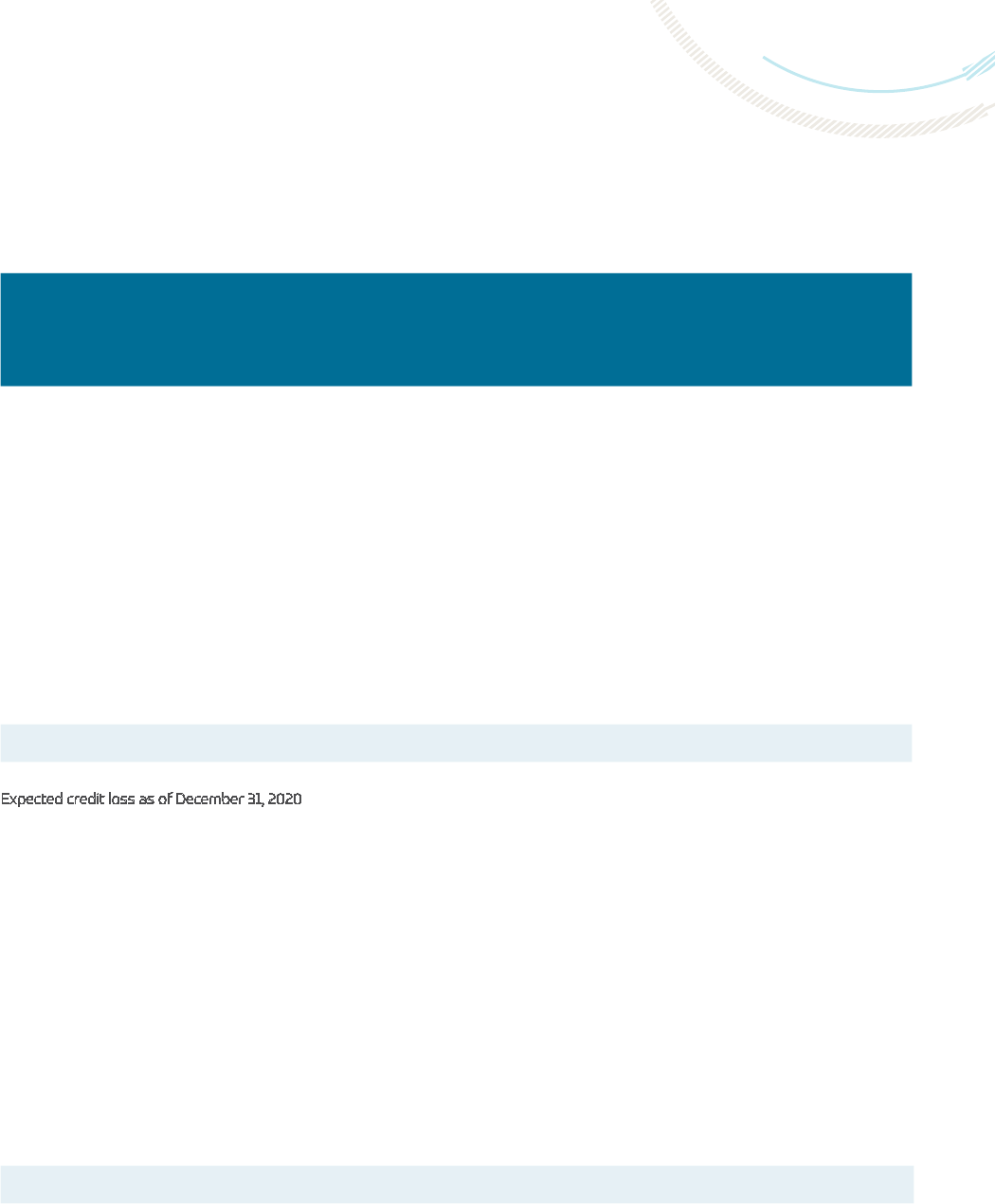
6. Expected credit loss as of December 31 2021:
Stage (1) Stage (2) Stage (3)
Individual Collective Individual Collective Total
JD JD JD JD JD JD
Description
Balances at banks and nancial institutions 11,822 - - - - 11,822
Direct Credit facilities 1,728,672 2,218,724 10,143,371 1,657,326 45,348,414 61,096,507
Debt instruments within nancial assets portfolio at
amortized cost
8,217 - - - - 8,217
Debt instruments within nancial assets at fair value
through other comprehensive income
2,830 - - - - 2,830
Letters of guarantee 99,212 - 13,331 - - 112,543
Un-utilized limits 235,334 26,738 115,900 1,733 - 379,705
Letters of credit 41,782 - 5,191 - - 46,973
Other 2,514 - 631 - - 3,145
Total 2,130,383 2,245,462 10,278,424 1,659,059 45,348,414 61,661,742
Expected credit loss as of December 31, 2020
Description
Balances at banks and nancial institutions 35,040 - - - - 35,040
Direct Credit facilities 2,243,122 1,958,144 6,870,848 2,362,843 42,478,210 55,913,167
Debt instruments within nancial assets portfolio at
amortized cost
19,868 - - - - 19,868
Debt instruments within nancial assets at fair value
through other comprehensive income
9,125 - - - - 9,125
Letters of guarantee 118,495 - 13,138 - - 131,633
Un-utilized limits 523,720 36,263 151,571 475 - 712,029
Letters of credit 53,941 - 6,392 - - 60,333
Other 4,278 - 20,507 - - 24,785
Total 3,007,589 1,994,407 7,062,456 2,363,318 42,478,210 56,905,980
Notes to the Consolidated Financial Statements
Year ended 31 December 2021
135
BANK ABC IN JORDAN ANNUAL REPORT 2021

Notes to the Consolidated Financial Statements
Year ended 31 December 2021
Collaterals maintained as an Insurance and other credit supporting:
The Bank maintains collaterals or other credit supporting to reduce from the credit risks related to nancial assets. The Group maintains
of nancial assets with a total amount of JD1,297 millions as of December 31, 2021 (against JD1.282 millions as of December 31,2020). The
total maintained collaterals at the end of the report equales to JD187 as of December 31, 2021 (against JD185 millions as of December
31, 2020). Noting that the collaterals value are not recognized less than the amount which will reduce from the credit risk. No changes
occurred in collaterals polices at Bank during the current year.
The following the collateral fair value distribution against the total credit exposure:
Collateral Fair Value
Description
Total
exposure
Cash
Margins
Trading
shares
Real
Estate
Cars &
Vehicles
Others
Total
Collateral
Value
Net Exposed
-Post
collateral
Expected
Credit
Loss
JD JD JD JD JD JD JD JD JD
2021
Balances at central banks 49,417,591 - - - - - - 49,417,591 -
Balances at banks and nancial institutions 57,218,887 - - - - - - 57,218,887 11,822
Deposits at banks and nancial institutions 23,978,806 - - - - - - 23,978,806 -
Individuals
Real estate Loans 351,553,091 23,391,367 22,254,045 69,200 467,775 2,918 46,185,305 305,367,786 21,493,729
Corporates 67,360,249 537,119 - 64,372,232 - 2,348,078 67,257,429 102,820 567,178
Corporate enterprises 202,372,983 5,895,183 12,815,961 11,472,529 5,000,000 435,998 35,619,671 166,744,203 36,945,635
Small and medium enterprises (SME’s) 22,944,368 6,769,868 - 4,727,135 518,360 6,010,047 18,025,410 4,918,958 1,981,042
Governments and public sector 49,098,506 - - - - - - 49,098,506 108,923
Bonds, bills and debentures as follows:
Within Financial assets at fair value through
other
comprehensive income 132,049,887 - - - - - - 132,049,887 2,830
Within Financial assets at amortized cost 139,314,408 - - - - - - 139,314,408 8,217
Mortgaged nancial assets (Debt
Instruments)
51,926,112 - - - - - - 51,926,112 -
Other assets 14,820,010 - - - - - - 14,820,010 3,145
Total 1,162,054,898 36,593,537 35,070,006 80,641,096 5,986,135 8,797,041 167,087,815 994,957,974 61,122,521
Letters of guarantees 80,022,252 4,084,263 - 4,183,706 - 61,902 8,329,871 71,692,381 112,543
Letters of credits 22,898,015 114,640 - - - - 114,640 22,783,375 46,973
Other liabilities 31,622,960 1,449,024 - 1,599,747 10,404 209,847 3,269,022 28,353,938 379,705
Net Total 1,296,598,125 42,241,464 35,070,006 86,424,549 5,996,539 9,068,790 178,801,348 1,117,787,668 61,661,742
Net Total for the Previous Year 1,281,747,347 41,945,874 30,260,310 95,198,480 8,701,505 9,087,205 185,203,483 1,096,553,973 56,905,979
136

Notes to the Consolidated Financial Statements
Year ended 31 December 2021
The following the collateral fair value distribution against the total credit exposure:
Collateral Fair Value
Description
Total
exposure
Cash
Margins
Trading
shares
Accepted
Bank
Guarantees
Real
Estate
Cars &
Vehicles
Others
Total
Collateral
Value
Net Exposed
-Post
collateral
Expected
Credit Loss
JD JD JD JD JD JD JD JD JD JD
2020
Balances at central banks 45,522,857 - - - - - - - 45,522,857 -
Balances at banks and nancial
institutions
89,979,061 - - - - - - - 89,979,061 35,040
Deposits at banks and nancial
institutions
7,343,135 - - - - - - - 7,343,135 -
Individuals 300,890,814 22,721,179 18,905,331 112,807 399,521 3,059 42,141,897 258,748,917 20,260,675
Real estate Loans 71,071,805 602,981 - - 67,958,786 - 2,838,391 71,400,158 (328,353) 724,144
Corporates
Corporate enterprises 225,346,151 4,820,256 11,354,979 10,109 15,332,898 7,828,109 212,854 39,559,205 185,786,946 32,715,860
Small and medium enterprises (SME’s) 22,513,745 6,566,927 - - 6,002,840 450,926 5,656,921 18,677,614 3,836,131 2,103,565
Governments and public sector 30,119,417 529,754 - - - - - 529,754 29,589,663 108,923
Bonds, bills and debentures as follows:
Within Financial assets at fair value
through other
comprehensive income 132,332,356 - - - - - - - 132,332,356 9,125
Within Financial assets at amortized
cost
126,843,748 - - - - - - - 126,843,748 19,868
Mortgaged nancial assets (Debt
Instruments)
62,631,159 - - - - - - - 62,631,159 -
Other assets 8,005,899 - - - - - - - 8,005,899 24,785
Total 1,122,600,147 35,241,097
30,260,310
10,109 89,407,331
8,678,556
8,711,225
172,308,628
950,291,519 56,001,985
Letters of guarantees 99,672,778 4,879,472 - - 4,011,891 - - 8,891,363 90,781,415 131,633
Letters of credits 17,284,167 143,344 - - - - - 143,344 17,140,823 60,333
Other liabilities 42,190,255 1,681,961 - - 1,779,258 22,949 365,871 3,850,039 38,340,216 712,029
Net Total 1,281,747,347 41,945,874 30,260,310 10,109 95,198,480 8,701,505 9,077,096 185,193,374 1,096,553,973 56,905,980
Net Total for the Previous Year 1,266,641,213 40,613,215 28,485,785 147,725
104,421,437
8,430,528
3,557,193 185,655,883 1,080,985,330 43,818,259
The following is the collaterals fair value distribution against the total credit exposure for stage (3) :
Collateral Fair Value
Description
Total
Exposure
Cash
Margins
Trading
Shares
Real Estate
Cars &
Vehicles
Others
Total
Collateral
Value
Net
Exposed
-Post
collateral
Expected
Credit Loss
JD JD JD JD JD JD JD JD JD
2021
Credit facilities:
Individuals 1,475,404 - 1,352,108 - 57,306 1,409,414 65,990 17,884,263
Real estate loans 400,086 47,130 - 660,802 - - 707,932 (307,846) 466,323
Corporate enterprises 1,440,043 - 739,889 1,518,761 - 2,258,650 (818,607) 25,231,006
Small and medium enterprises 253,944 48,997 - 317,608 37,500 9,109 413,214 (159,270) 1,766,822
Total 3,569,477 96,127 2,091,997 2,497,171 94,806 9,109 4,789,210 (1,219,733) 45,348,414
Letters of guarantee 4,944,666 787,320 - - - - 787,320 4,157,346 -
Net Total 8,514,143 883,447 2,091,997 2,497,171 94,806 9,109 5,576,530 2,937,613 45,348,414
Net Total for the Previous
Yea r
11,175,037 982,661 39 7,841,921 96,415 10,109 8,931,145 2,243,892 42,478,210
137
BANK ABC IN JORDAN ANNUAL REPORT 2021

Notes to the Consolidated Financial Statements
Year ended 31 December 2021
7 ‑ bonds and Treasury bills the table below shows the classications of bounds and treasury bills according to the
external clasication ratings (S&P):
Classication grade
Within nancial
assets at
mortgaged cost
Financial assets
through other
comprehensive income
Within other
nancial assets
at amortized cost
Total
JD JD JD JD
2021
AAA - - - -
AA+ - - - -
AA - 3,668,579 - 3,668,579
AA- - - - -
A+ - - - -
A - - - -
A- - - - -
BBB+ - 3,563,221 - 3,563,221
BBB - - - -
BBB- - - - -
BB+ - - - -
BB - - - -
BB- - - - -
B+ - - - -
B - - - -
B- - - - -
CCC- - - - -
C - - - -
Unclassied - - 14,991,783 14,991,783
Governmental or guaranteed from government 51,926,112 124,818,087 124,322,625 301,066,824
Total 51,926,112 132,049,887 139,314,408 323,290,407
2020
AAA - - - -
AA+ - - - -
AA - 3,716,188 - 3,716,188
AA- - - - -
A+ - - - -
A - - - -
A- - - - -
BBB+ - 3,656,561 - 3,656,561
BBB - - - -
BBB- - - - -
BB+ - - - -
BB - - - -
BB- - - - -
B+ - - - -
B - - - -
B- - - - -
CCC- - - - -
C - - - -
Unclassied - - 14,980,132 14,980,132
Governmental or guaranteed from government 62,631,159 124,959,607 111,863,616 299,454,382
Total 62,631,159 132,332,356 126,843,748 321,807,263
138

Notes to the Consolidated Financial Statements
Year ended 31 December 2021
(40/B) Market risk
Market risk relates to the losses from the nancial
positions on- and o- the statement of nancial
position arising from the changes in interest rates,
exchange rates, and shares’ prices. Moreover, market
risk is monitored and managed by the Market
Risks Department related to the Risk Management
Department, in addition to other committees and
regulatory entities, including the Assets and Liabilities
Committee and Risk Management Committee which
comprises of some members of the Board of Directors
and the Risk management supervisors.
The Bank manages market risks from the Bank’s
investments in bonds and shares, exchange of foreign
currencies swap contracts, and certicates of deposit
using multiple advanced techniques in order to achieve
comprehensive management for this kind of risks such
as VaR (Value at Risk) which the Bank calculates daily,
in a way that includes all the Bank’s portfolios subject
to risks (Interest rates instruments, Equity instruments
for trade, and the foreign currencies centers), by using
the (Historical Simulation) which is based on several
assumptions such as calculation for one day (one-day
time horizon) and a condence level of 99%. In this
respect, VaR results are compared daily with the portfolio
realized prot and losses.
The Bank also calculates the eect of the sensitivity of
the change in interest rates for the nancial instruments
that change in accordance with the change in interest
rates; and for the main currencies that the Bank deals
with according to Basis Point Value (BPV) based on
calculating the expected possible losses for the change in
interest rate at one basis point
(DV01).
The table below shows the eect of the nancial
instruments exposures risks on the statement of Prot
or Loss according to the sensitivity analysis if the interest
rate declines by one percent:
For the year 2021
According to the nancial instruments (BPV=DV01)
Financial Instrument DV01 value
JD
Bonds (67,686)
Gaps in bond’s maturity -
Finance Market 70
Interest / Currency swaps 1,308
Certicates of deposits -
For the year 2020
According to the nancial instruments (BPV=DV01)
Financial Instrument DV01 value
JD
Bonds (72,459)
Gaps in bond’s maturity -
Finance Market 70
Interest / Currency swaps 2,054
Certicates of deposits -
The table below shows the eect of currency risk on the
statement of Prot or Loss according to the sensitivity
analysis if the currency rate declines by one percent:
For the year 2021
According to currencies
Currency DV01 value
JD
Euro (433)
Sterling Pound (24)
For the year 2020
According to currencies
Currency DV01 value
JD
Euro (438)
Sterling Pound (139)
139
BANK ABC IN JORDAN ANNUAL REPORT 2021
Notes to the Consolidated Financial Statements
Year ended 31 December 2021
(40/C) Liquidity Risk
Liquidity risk is the risk that the Bank will not be able
to provide the necessary funding to meet its liabilities
in its maturity dates due to the inability to liquidate the
assets. To minimize these risks, the Bank’s management
diversies its sources of funds, manages and aligns
the maturities of assets and liabilities, and maintains
a sucient balance of cash and cash equivalents and
securities available for trade .
Within the framework of the general strategy to achieve a
return on its investments, the Bank reviews and manages
liquidity at various levels, including the Treasury, Financial
Audit Department, Risks Management Department, as
well as the Assets and Liabilities Committee which is
specialized in this regard. The cash ow review includes
an analysis of the maturity prole of assets and liabilities
in an integrated manner. It analyzes the sources of funds,
which include customers, correspondent banks, aliates
and associates, the Bank’s branches in Jordan, and the
distribution and concentrations of customer deposits by
sector.
The Bank follows a liquidity management strategy
approved by the Board of Directors aimed at
implementing a comprehensive concept for managing
the liquidity risk and associated dependencies eciently
and eectively. It also takes into consideration the
diversication and appropriate distribution between
sources and uses of funds.
The liquidity contingency plan has been developed and
approved and is an integral part of the liquidity risk
management policy, which would be activated for the
management of liquidity risk and in case the bank is
exposed to any unexpected withdrawals of customers’
deposits exceeding the accepted liquidity ratios.
The contractual maturity dates of the assets have been
determined based on the remaining period from the
date of the consolidated statement of nancial position
until the contractual maturity date regardless of the
actual maturities reected by historical events relating to
maintaining deposits and the availability of liquidity.
The Bank complies with the instructions of the Central
Bank of Jordan stipulating that the foreign currency
ratios should not become lower than 100% and not less
than 70% for the Jordan Dinar. In addition, the liquidity
ratios are reserved at levels higher than the minimum
imposed by the Central Bank of Jordan.
In the previous period, the Bank has conducted studies
on the calculation of the size of the deposits (the Core
Deposits) according to the historical behavior of the
customers’ deposits over the past ve years, and
reected the results of this study in the reports on the
management of liquidity risk.
140

Notes to the Consolidated Financial Statements
Year ended 31 December 2021
Liquidity Risk( 40/C)
Firstly: The table below summarizes the maturities of nancial derivatives as of the date of the nancial statements:
Less than
one month
Thousand
of JD’S
1-3
months
Thousand
of JD’S
3-6
months
Thousand
of JD’S
6 months-1
year
Thousand
of JD’S
1-3 years
Thousand
of JD’S
More than
3 years
Thousand
of JD’S
without
maturity
Thousand
of JD’S
Total
Thousand
of JD’S
2021
Liabilities
Deposits at banks and nancial institutions 76,710 67, 556 - - - - - 144,266
Deposits from customers 349,862 165,351 110,535 102,240 - - - 727,987
Cash credit 39,669 274 997 1,311 2,549 8,921 - 53,722
Borrowings 30,018 984 1,378 18,102 46,269 12,133 - 108,884
Other provisions - - - - - 3,379 - 3,379
Income tax provision 6,883 - 373 - - - - 7,257
Deferred tax liability - - - 2,337 - - - 2,337
Leases contracts liabilities (Rents) - - - 54 98 2,885 - 3,037
Other liabilities 15,338 3,070 1,273 2,533 11 816 - 23,042
Total 518,480 237,235 114,556 126,577 48,927 28,134 - 1,073,909
Total assets (as its expected maturity) 183,026 122,636 81,329 160,908 230,980 416,627 34,526 1,230,032
2020
Liabilities
Deposits at banks and nancial institutions 94,911 62,511 - - - - - 157,422
Deposits from customers 334,134 168,873 98,762 86,851 - - - 688,620
Cash credit 38,541 481 640 2,110 998 9,262 - 52,031
Borrowings 36,394 671 911 37, 3 4 9 20,215 794 - 96,334
Other provisions - - - - - 3,545 - 3,545
Income tax provision 5,993 158 306 - - - - 6,456
Deferred tax liability - - - 3,076 - - - 3,076
Leases contracts liabilities (Rents) 255 185 31 475 1,043 2,052 - 4,042
Other liabilities 15,070 1,652 1,206 2,470 11 1,225 - 21,634
Total 525,299 234,531 101,855 132,332 22,267 16,878 - 1,033,162
Total assets (as its expected maturity) 226,893 104,599 85,473 94,264 242,931 397,883 31,557 1,183,600
141
BANK ABC IN JORDAN ANNUAL REPORT 2021

Notes to the Consolidated Financial Statements
Year ended 31 December 2021
Gap of re-pricing interest rate:
The classication is based on interest or accrual intervals, whichever is closer:
The sensitivity of interest rate is as follows:
Less than 6 Months More than Without
One Month 1-3 Months 3-6 Months -1 Year 1-3 Years 3 Years Maturity Total
JD JD JD JD JD JD JD JD
2021
Assets
Cash and balnces at the Central Bank of Jordan 7,000,000 - - - - - 48,272,058 55,272,058
Balances at banks and nancial institutions 46,259,261 5,004,082 - - - - 5,955,544 57,218,887
Deposits at banks and nancial institutions - - 15,948,656 8,030,150 - - - 23,978,806
Financial assets at fair value from other
comprehensive income
- 3,563,904 7,018,458 - 71,298,416 50,169,109 3,584,022 135,633,909
Direct credit facilities - Net 319,930,116 203,388,725 159,402,057 2,354,231 102,818 288,132 7,863,118 693,329,197
Financial assets at amortized cost 2,856,014 14,192,019 3,000,129 40,009,706 54,268,351 24,988,189 - 139,314,408
Mortgaged nancial assets 11,144,057 9,808,140 - - - 30,973,915 - 51,926,112
Property and equipment - - - - - - 32,969,697 32,969,697
Intangible assets - - - - - - 1,556,131 1,556,131
Deferred tax assets - - - - - - 9,067,586 9,067,586
Right-of-use assets - - - - - - 2,826,245 2,826,245
Other assets 8,795,827 - - - - - 18,142,363 26,938,190
Total Assets 395,985,275 235,956,870 185,369,300 50,394,087 125,669,585 106,419,345 130,236,764 1,230,031,226
Liabilities
Banks’ and nancial institutions’ deposits 76,635,100 67,423,539 - - - - - 144,058,639
Customers’ deposits 259,468,020 164,509,023 109,276,581 99,937,785 - - 89,503,466 722,694,875
Cash credit 42,654,517 - - - - - 10,107,667 52,762,184
Borrowings 29,157,280 177,298 145,406 15,457,080 41,414,142 10,608,250 6,568,413 103,527,869
Other provisions - - - - - - 3,378,824 3,378,824
Income tax provision - - - - - - 7,256,848 7,256,848
Deferred tax liability - - - - - - 2,337,442 2,337,442
Leases contracts liabilities (Rents) - - - 52,570 92,024
2,617,771 - 2,762,365
Other Liabilities - - - - - - 22,897,585 22,897,585
Total Liability 407,914,917 232,109,860 109,421,987 115,447,435 41,506,166 13,226,021 142,050,245 1,061,676,631
Gap of re-pricing interest rate: (11,929,642) 3,847,010 75,947,313 (65,053,348) 84,163,419 93,193,324 (11,813,481) 168,354,595
2020
Total assets 412,184,815 208,894,012 158,631,768 15,185,995 121,543,587 142,143,461 125,016,988 1,183,600,626
Total liabilities 418,462,334 230,596,937 97,810,572 119,285,707 15,958,810 3,158,458 138,451,500 1,023,724,318
Gap of re-pricing interest rate (6,277,519) (21,702,925) 60,821,196 (104,099,712) 105,584,777 138,985,003 (13,434,512) 159,876,308
142

Notes to the Consolidated Financial Statements
Year ended 31 December 2021
Concentration of Foreign Currency Risk
US Dollar Euro
Sterling
Pound
Japanese
Yen
Other Total
JD JD JD JD JD JD
2021
Assets
Cash and balances at the Central Bank of Jordan 9,173,059 5,940,754 25,436 - 8,532 15,147,781
Balances at banks and nancial institutions 40,317,263 7,164,847 3,518,994 2,259,096 1,639,242 54,899,442
Deposits at banks and nancial institutions 15,952,500 8,030,150 - - - 23,982,650
Direct credit facilities 78,378,691 - - - - 78,378,691
Financial assets at fair value through other
comprehensive income
14,253,088 14,250 - - - 14,267,338
Other assets 10,002,561 11,681 - - - 10,014,242
Total assets 168,077,162 21,161,682 3,544,430 2,259,096 1,647,774 196,690,144
Liabilities
Banks’ and nancial institutions’ deposits 75,685,584 26,107 - - - 75,711,691
Customers’ deposits 113,242,320 26,665,504 2,236,382 2,257,404 197,847 144,599,457
Cash margins 4,008,639 1,358,346 1 - - 5,366,986
Borrowings 7,799,000 - - - - 7,799,000
Other liabilities 4,906,667 2,261,621 1,310,423 45 1,450,465 9,929,221
Total Liabilities 205,642,210 30,311,578 3,546,806 2,257,449 1,648,312 243,406,355
Net Concentration of Consolidated Financial
Position Items
(37,565,048) (9,149,896) (2,376) 1,647 (538) (46,716,211)
O-consolidated Financial Position Contingent
Liabilities
91,581,031 13,189,939 - 2,788,694 324,722 107,884,386
2020
Total Assets 184,091,576 22,746,016 7,548,211 539,404 2,484,645 217,409,852
Total Liabilities 213,070,351 31,479,242 7,567,250 535,163 1,626,380 254,278,386
Net Concentration of Consolidated Financial
Position Items
(28,978,775) (8,733,226) (19,039) 4,241 858,265 (36,868,534)
O-consolidated Financial Position Contingent
Liabilities
90,780,082 17,083,320 - - 2,210,928 110,074,330
143
BANK ABC IN JORDAN ANNUAL REPORT 2021
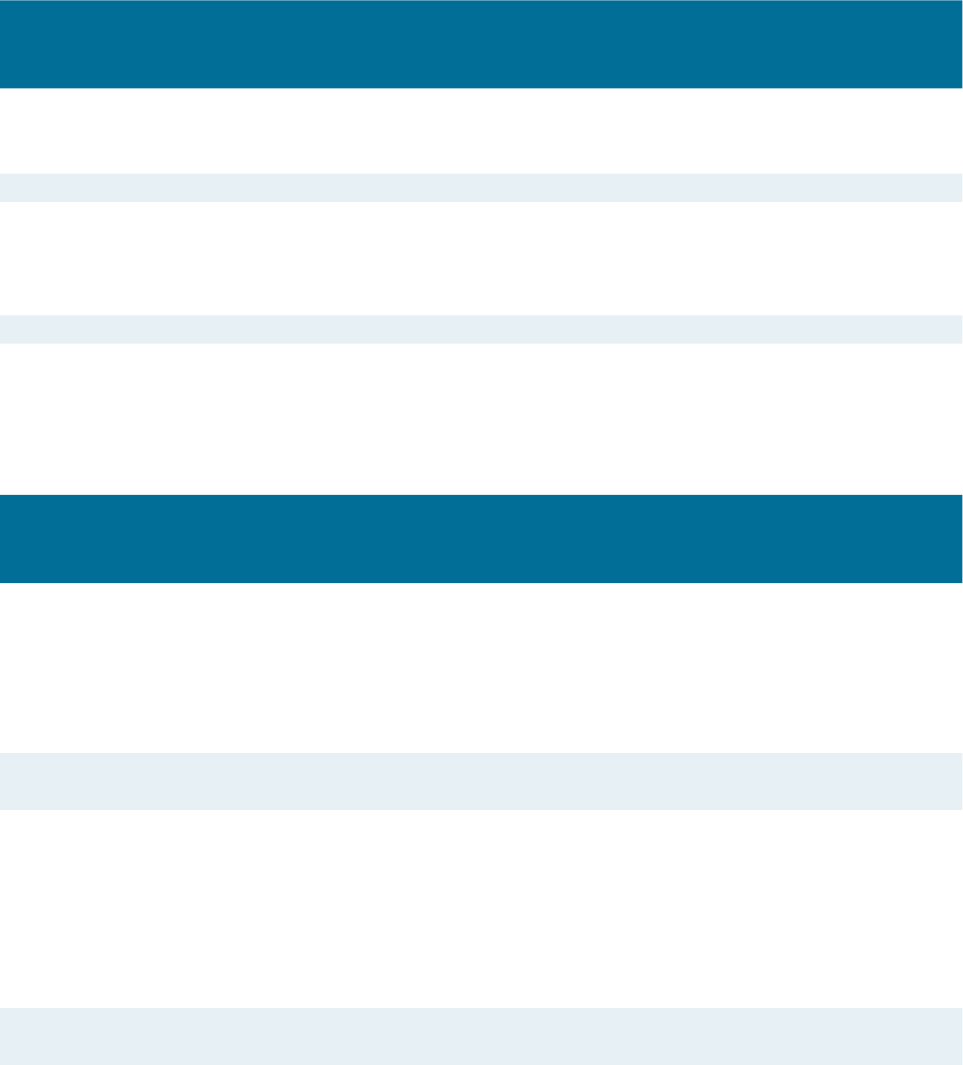
Notes to the Consolidated Financial Statements
Year ended 31 December 2021
Secondly: The table below shows the maturities of the nancial derivatives on the basis of the remaining period of
the contractual maturity from the date of the nancial statements:
(A) Financial derivatives/ liabilities settled at their net value (osetting basis) which include:
1- Interest rate derivatives: Interest rate swaps, deferred interest rates agreements, interest rate options
in informal markets , other interest rates contracts, futures contracts for interest rates traded in formal market,
contractual options for interest rates traded in formal markets.
6 months More than
1-3 months
3-6
months
-1 year 1-3 years 3 years Total
JD JD JD JD JD JD
2021
Hedging Derivatives:
Interest rate swaps (57,429) - - (77,990) - (135,419)
Total (57,429) - - (77,990) - (135,419)
2020
Hedging Derivatives:
Interest rate swaps - - - (120,201) (202,545) (322,746)
Total - - - (120,201) (202,545) (322,746)
(B) Financial Derivatives/ Liabilities that are settled at gross which include:
1- Foreign currency derivatives: futures contracts, currency exchange contracts.
6 months More than
1-3 months
3-6
months
-1 year 1-3 years 3 years Total
JD JD JD JD JD JD
2021
Description
Trading derivatives:
Currency exchange contracts
Outows 48,092,150 - - - - 48,092,150
Inows 47,976,524 - - - - 47,976,524
Total Outows 48,092,150 - - - - 48,092,150
Total Inows 47,976,524 - - - - 47,976,524
2020
Description
Trading derivatives:
Currency exchange contracts
Outows 86,974,948 - - - - 86,974,948
Inows 87,011,934 - - - - 87,011,934
Total Outows 86,974,948 - - - - 86,974,948
Total Inows 87,011,934 - - - - 87,011,934
144

Notes to the Consolidated Financial Statements
Year ended 31 December 2021
Thirdly : O-consolidated nancial position items:
Up to 1 Year 1 - 5 Years Over 5 Years Total
JD JD JD JD
2021
Letters of credit and acceptances 22,898,015 - - 22,898,015
Un-utilized limits 31,622,960 - - 31,622,960
Letters of guarantee 76,297,457 3,724,795 - 80,022,252
Total 130,818,432 3,724,795 - 134,543,227
2020
Letters of credit and acceptances 17,284,167 - - 17,284,167
Un-utilized limits 42,190,255 - - 42,190,255
Letters of guarantee 93,231,697 6,441,081 - 99,672,778
Total 152,706,119 6,441,081 - 159,147,200
(40/D) Operational risk
Operational risk is dened as the risk of loss that might
impact revenues or capital resulting from inadequate or
failed internal procedures, information systems, human
element, or due to external events that have tangible
impact on the Bank’s operations.
Operational risk also includes legal risk, excluding
reputation and strategic risk.
For reputation and other risks such as strategic and
quantitative risks that directly relate to liquidity risks,
the Bank calculates capital to face those risks through
evaluating it according to the adopted Scorecard form.
The Operational Risks Department carries out continuous
work and closely coordinates with all heads in charge
within the general management department to ensure
the continuation of implementing the concept of the
Operational Risk Management Framework eectively
through the implementation of the principle of the
three lines of defense model, which dene the tasks and
responsibilities of all departments of the bank, especially
with regard to the application , a follow-up and monitoring
the execution of the daily tasks in the remit of the rst
line of defense.
The Operational Risk Department continues to gather
the operational losses data in addition to the operational
risks indicators through the GRC-Tool, it monitors and
update and ensure from the formulation of any correction
plan around it, wherever necessary. The system objective
is to allow the utilization by all concerned departments
whether business departments, risks compliance, in
addition to internal audit, thus enabling Executive
Management to be aware of nancial and non-nancial
risks on spot.
The methodology for control-self assessment of
operational risks and the controls set against it
through conducting a review at departmental level, in
addition to the implementation of the standards from
the parent Company in Bahrain in which it determine
the required instructions to be applied according to
the best international practices in this regard, through
conducting an analysis for the gaps between what is
applied and what is required to be applied in order to
conduct the implementations plan, and the necessary
solutions around it until reaching the specied goal
for this evaluation and ensure from the availability of
the monitoring and controls methods which govern
the transactions execution at the Bank.
(40/E) Information Technology Risk
It is the risk that the Bank may face as a result of
acquiring and using information technology resources
to execute the Bank’s operations that which may lead to
nancial losses, legal proceedings, or an adverse impact
on the Bank’s reputation or the services provided to the
clients and related parties.
In order to enable the Bank’s Risk Department to
implement all the requirements stipulated in the Central
Bank of Jordan’s instructions relating to “governorship
and management of information and associated
technology”, Central Bank of Jordan’s instructions relating
to “adapt to cyber risks”, and policies and procedures
stipulated by the Bank; and in order to complete the
related work performed during 2020, the following points
have been completed in 2021:
1. Renewing and re-adopting the following policies and
procedures:
• IT Risk Policy.
• Information and systems classication and
protection policy.
• IT Risk Assessment Mechanism.
2. Updating IT risk department work procedures
by adding more details to the role of the IT risk
department relating to monitor, analyse, and asses
the risks which are managed by IT department,
information security department, and business
continuity department.
3. Updating the “Risk appetite statement and
145
BANK ABC IN JORDAN ANNUAL REPORT 2021

Notes to the Consolidated Financial Statements
Year ended 31 December 2021
framework” document related to the acceptable
risk limits and specifying the acceptable level for
operational risks and cyber risks and obtaining the
Board of Directors’ approval thereon.
4. Preparing the reports as required in Central Bank
of Jordan’s instructions relating to “governorship
and management of information and associated
technology” and share them with the concerned
parties by presenting them to the operational
resilience Committee.
5. In order to develop the skills of IT risk management
sta, those involved participated in many local
conferences, training courses, and workshops
related to IT governance and information security.
41. Segment Information
A. Information on Group business segment:
For management purposes, the Bank is organized into three major operating segments measured in accordance with the reports sent
to the chief executive decision maker:
- Retail banking.
- Corporate banking.
- Treasury.
These segments are the basis on which the Bank reports its primary segment information:
Total
Retail Corporate Treasury Other 2021 2020
JD JD JD JD JD JD
Total income 32,997,543 18,185,578 20,107,018 100,212 71,390,351 69,940,915
Provision for expected credit loss on nancial
assets
(1,088,715) (3,681,018) (4,069) - (4,773,802) (13,115,650)
Segmental results 18,900,477 8,004,852 13,095,890 (52,498) 39,948,721 2 7,727, 3 24
Unallocated segmental expenses
(24,822,107) (23,519,834)
Prot before tax
15,126,614 4,207,490
Income tax
(5,524,190) (2,985,277)
Net prot for the year
9,602,424 1,222,213
Capital expense 4,700,261 9,112,658
Depreciation and amortization 2,363,275 2,356,293
Other information
Segmental assets 410,487,679 276,385,514 497,142,878 - 1,184,016,071 1,140,834,256
Unallocated segmental assets - - - 46,015,155 46,015,155 42,766,370
Total Assets 410,487,679 276,385,514 497,142,878 46,015,155 1,230,031,226 1,183,600,626
Segmental liabilities 611,772,963 211,682,410 220,083,402 - 1,043,538,775 1,006,983,970
Unallocated segmental liabilities - - - 18,137,856 18,137,856 16,740,348
Total Liabilities 611,772,963 211,682,410 220,083,402 18,137,856 1,061,676,631 1,023,724,318
146

Notes to the Consolidated Financial Statements
Year ended 31 December 2021
42. Capital Management
a. The capital adequacy ratio as of December 31, 2021 and
2020 was calculated according to Basel III requirements
where the Bank’s regulatory capital consists of the
Common Equity Tier1 (CET1) and Additional Tier 1 (AT1),
and Tier 2 (T2)
b. The regulatory authorities’ requirements regarding
the Common Equity
The Central Bank of Jordan’s instructions require that
the minimum regulatory capital to be (12%) of the
o-balance sheet assets weighted by risks, in addition
to market risks and operational risks. This percentage
is considered the minimum for capital adequacy, as
the Bank is committed, in all cases, to maintaining
an adequacy percentage above the minimum by an
appropriate margin and in line with the requirements of
BASEL III, as well.
c. Methods for achieving the capital management
objectives
Capital management involves optimally employing
sources of funds to achieve the highest return on
capital possible within the acceptable risk limits
approved by the Board of Directors, while maintaining
the minimum limit required according to the laws
and regulations in force. Moreover, the Bank follows
a policy of striving to minimize costs of fund as
much as possible through resorting to low-cost
sources of funds, increasing the clients’ base, and
optimally employing such sources in investments with
reasonable risks to achieve the highest possible return
on capital.
d. Capital Adequacy
In addition to subscribed capital, capital includes the
statuary reserve, voluntary reserve, share premium,
retained earnings, cumulative change in fair value
, general banking risk reserve, other reserves and
treasury stocks.
The Bank is committed to applying the requirements set
forth by regulators concerning capital adequacy as
follows:
1- The Central Bank of Jordan’s instructions requiring that
capital adequacy ratio may not go below 12%.
2- Compliance with the minimum limit set for the paid
capital for Jordanian banks such that it is not less than
JD100 million.
3- The Bank’s investments in stocks and shares which
should not exceed 50% of the subscribed capital.
4- The ratio of credit limits (credit concentration) to
regulatory capital.
5- The banks and companies laws related to the
deduction of the legal reserve at a rate of 10% of the
Bank’s prot before tax.
b. Geographical distribution information
This disclosure represents the geographical distribution of the Group’s business. The Group’s operations are mainly
concentrated within the local business.
The following is the geographical distribution of the Bank’s income, assets and capital expenditures:
Inside Jordan Outside Jordan Total
2021 2020 2021 2020 2021 2020
JD JD JD JD JD JD
Gross income 66,596,989 67,266,803 4,793,362 2,674,112 71,390,351 69,940,915
Capital expenditures 4,473,791 9,053,922 226,470 58,736 4,700,261 9,112,658
Inside Jordan Outside Jordan Total
2021 2020 2021 2020 2021 2020
JD JD JD JD JD JD
Total assets 1,154,671,138 1,113,660,924 75,360,088 69,939,702 1,230,031,226 1,183,600,626
147
BANK ABC IN JORDAN ANNUAL REPORT 2021

Notes to the Consolidated Financial Statements
Year ended 31 December 2021
2021 2020
JD JD
Common Equity Shareholders’ Rights
Paid-up capital 110,000 110,000
Retained earnings less proposed dividends 18,025 16,524
Cumulative change in fair value of nancial assets 3,570 4,705
Share premium 67 67
Statuary reserve 29,892 28,380
Voluntary reserve 197 197
Total Capital of Common Stock 161,751 159,873
Regulatory amendment (deduction from capital)
Goodwill and intangible assets (1,556) (1,520)
Mutual investment in the capital of banking, nancial and insurance (within CET 1) - -
Deferred tax assets (9,068) (9,227)
Total Primary Capital 151,127 149,126
Additional capital
Total Capital (Tier 1) 151,127 149,126
Tier 2 Capital
Stage 1 (IFRS9) 4,376 5,002
Regulatory amendment (deduction from capital) / Investments in subsidiary
Total Supporting Capital 4,376 5,002
Total Regulatory Capital 155,503 154,128
Total Risk-Weighted Assets 797,281 765,466
(%) Capital Adequacy Ratio 19.50% 20.14%
(%) Primary Capital adequacy Ratio 18.96% 19.48%
Capital adequacy was calculated as of December 31, 2021 and December 31, 2020 based on the resolutions of Basel Committee III.
Liquidity Coverage ratio:
The banking group liquidity coverage ratio at the average end of each month equates 201.67% for the Banking group of the total
currencies for the year ended from January, 2021 until December, 2021.
Banking Group Total Currencies
Thousands Dinars
Total Liquid Assets High Quality 297,267
Net cash outow for the next 30 days 137,185
Percentage for covering the liability 216.70%
148

Notes to the Consolidated Financial Statements
Year ended 31 December 2021
43. Maturity Analysis of Assets and Liabilities
The following table illustrates the assets and liabilities according to the expected maturity periods:
Within in 1 Year More than 1 Year Total
JD JD JD
2021
Assets
Cash and balances at central banks 55,272,058 - 55,272,058
Balances at banks and nancial institutions 57,218,887 - 57,218,887
Deposits at banks and nancial institutions 23,978,806 - 23,978,806
Financial assets at fair value through other comprehensive income 14,166,385 121,467,524 135,633,909
Direct credit facilities 290,173,906 403,155,291 693,329,197
Financial assets at amortized cost 60,057,868 79,256,540 139,314,408
Financial assets at mortgage cost 20,952,197 30,973,915 51,926,112
Property and equipment 1,289,000 31,680,697 32,969,697
Intangible assets 440,000 1,116,131 1,556,131
Deferred tax assets 9,067,586 - 9,067,586
Right-of-use assets 634,456 2,191,789 2,826,245
Other assets 17,011,816 9,926,374 26,938,190
Total Assets 550,262,965 679,768,261 1,230,031,226
Liabilities:
Banks’ and nancial institutions’ deposits 144,058,639 - 144,058,639
Customers’ deposits 722,694,875 - 722,694,875
Margin accounts 42,120,701 10,641,483 52,762,184
Borrowed funds 49,949,463 53,578,406 103,527,869
Sundry provisions - 3,378,824 3,378,824
Income tax provision 7,256,848 - 7,256,848
Deferred tax liabilities 2,337,442 - 2,337,442
Leases contracts liabilities 160,921 2,601,444 2,762,365
Other liabilities 22,053,745 843,840 22,897,585
Total Liabilities 990,632,634 71,043,997 1,061,676,631
Net (440,369,669) 608,724,264 168,354,595
149
BANK ABC IN JORDAN ANNUAL REPORT 2021

Notes to the Consolidated Financial Statements
Year ended 31 December 2021
Within in 1 Year More than 1 Year Total
JD JD JD
2020
Assets
Cash and balances at central banks 52,217,487 - 52,217,487
Balances at banks and nancial institutions 89,979,061 - 89,979,061
Deposits at banks and nancial institutions 7,343,135 - 7,343,135
Financial assets at fair value through other comprehensive
income 40,424,553 95,145,914 135,570,467
Direct credit facilities 285,083,847 364,858,085 649,941,932
Financial assets at amortized cost 14,121,801 112,721,947 126,843,748
Financial assets at mortgage cost 7,110,676 55,520,483 62,631,159
Property and equipment 1,267,000 28,770,561 30,037,561
Intangible assets 442,000 1,077,806 1,519,806
Deferred tax assets 9,226,618 - 9,226,618
Right-of-use assets 646,850 2,197,790 2,844,640
Other assets 5,718,784 9,726,228 15,445,012
Total Assets 513,581,812 670,018,814 1,183,600,626
Liabilities:
Banks’ and nancial institutions’ deposits 157,160,531 - 157,160,531
Customers’ deposits 684,291,947 - 684,291,947
Margin accounts 41,662,423 9,658,280 51,320,703
Borrowed funds 73,867,743 19,616,398 93,484,141
Sundry provisions - 3,545,381 3,545,381
Income tax provision 6,456,452 - 6,456,452
Deferred tax liabilities 3,076,163 - 3,076,163
Leases contracts liabilities 164,543 2,590,782 2,755,325
Other liabilities 20,233,272 1,400,403 21,633,675
Total Liabilities 986,913,074 36,811,244 1,023,724,318
Net (473,331,262) 633,207,570 159,876,308
150

Notes to the Consolidated Financial Statements
Year ended 31 December 2021
44. Contingent Liabilities and Commitments
The details of this item are as follows:
a. Credit Liabilities and Commitments:
2021 2020
JD JD
Letter of Credits:
Inward
36,358,176
24,908,517
Outward
12,670,288
13,806,852
Acceptances
8,006,166
3,085,746
Letter of Guarantees:
Payment
23,008,491
22,140,259
Performance
31,369,786
51,652,717
Other
25,756,518
26,011,435
Unutilized credit facilities
32,002,665
42,902,284
Futures contracts in Foreign Currency
47,976,524
87,011,934
Interest swap contracts
7,090,000
7,090,000
Total 224,238,614 278,609,744
b. Contractual obligations
20202021
JDJD
1,198,975471,810Contracts of purchase of property and equipment
4,924,1705,712,553Construction project contracts
-27,216Other purchases contracts
6,123,1456,211,579 Total
45. Lawsuits raised against the Bank
Lawsuits against the Bank amounted to JD4,455,353 as of December 31, 2021
(JD4,394,174 as at December 31, 2020) and in the opinion of the bank’s management and legal counsel the bank would not
incur obligations in excess of the recorded provision which amounted to JD688,413 as at December 31, 2021 (JD688,413 as
at December 31, 2020).
151
BANK ABC IN JORDAN ANNUAL REPORT 2021
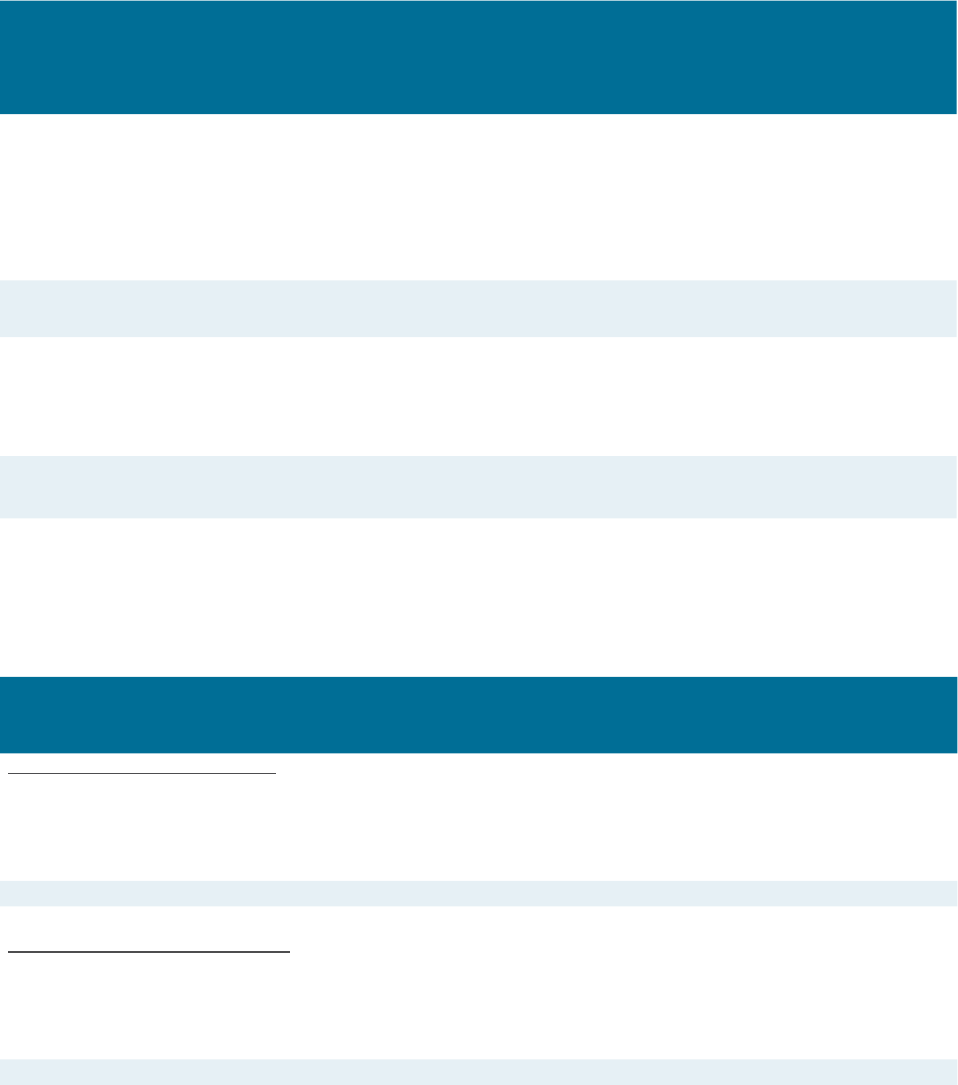
Notes to the Consolidated Financial Statements
Year ended 31 December 2021
46. Fair Value Measurement
a. Fair value of nancial assets and nancial liabilities that are measured at fair value on a recurring basis:
Some nancial assets and liabilities of the Bank are evaluated at fair value at the end of each scal period. The
following table shows the information about how to determine the fair value of these
nancial assets and liabilities (evaluation methods and inputs used).
Fair Value
The Level of Evaluation Method Signicant
Relationship of
Unobservable
Financial Assets 2021 2020 Fair Value and Inputs used
Unobservable
Inputs
Inputs to Fair
Value
JD JD
Financial Assets at Fair Value
Financial Assets at Fair Value through Other
Comprehensive Income:
Bonds 124,818,087 124,959,607 Level 2
According to last nancial
information available
N/A N/A
Quoted shares in active markets 8,365,443 8,242,593 Level 1
Quoted prices in
nancial markets
N/A N/A
Unquoted shares in active markets 2,450,379 2,368,267 Level 2
According to last nancial
information available
N/A N/A
Total 135,633,909 135,570,467
Total Financial Assets at Fair Value 135,633,909 135,570,467
Unrealized gains on nancial assets 23,662 85,468 Level 2
According to last nancial
information available
N/A N/A
Financial liabilities
Unrealized losses on nancial derivatives 239,193 372,812 Level 2
According to last nancial
information available
N/A N/A
Total liabilities at fair value 239,193 372,812
There were no transfers between level 1 and level 2 during the year ended December 31, 2021.
Except for what is set out in the table below, we believe that the carrying amount of nancial assets and liabilities shown
in the consolidated nancial statements of the Bank approximates their fair value:
2021 2020 The level of
Book value Fair value Book value Fair value Fair Value
JD JD JD JD
Financial Assets of Non-specied Fair Value
Term deposits, and certicate of deposits at the Central Bank 7,000,000 7,000,767 - - Level 2
Current accounts, and balances at Banks and Financial Institutions 81,209,515 81,265,237 93,357,236 97,427,250 Level 2
Direct credit facilities at amortized costs 771,765,838 772,950,417 720,005,003 722,193,177 Level 2
Other nancial assets at amortized costs 191,248,737 194,000,618 189,494,775 192,280,425 Level 2
Total Financial Assets of Non-specied Fair Value 1,051,224,090 1,055,217,039 1,002,857,014 1,011,900,852
Financial Liabilities of Non-specied Fair Value
Banks’ and Financial Institutions’ deposits 144,058,639 144,058,639 157,160,531 157,160,531 Level 2
Customers’ deposits 722,694,875 722,694,875 684,291,947 684,291,947 Level 2
Cash margin 52,762,184 52,762,184 51,320,703 51,320,703 Level 2
Borrowed funds 103,527,869 103,527,869 93,484,141 93,484,141 Level 2
Total Financial Liabilities of Non-specied Fair Value 1,023,043,567 1,023,043,567 986,257,322 986,257,322
152

Notes to the Consolidated Financial Statements
Year ended 31 December 2021
47. The Impact of COVID
The coronavirus (“COVID”) pandemic has spread across various geographies globally, causing disruption to business and
economic activities. COVID has brought about uncertainties in the global economic environment.
The Bank is closely monitoring the situation and has activated its business continuity planning and other risk
management practices to manage the potential business disruption the COVID outbreak may have one its operations and
nancial performance.
The Bank has performed an assessment of COVID pandemic which has resulted in the following changes to the expected
credit loss methodology and valuation estimates and judgements as at and for the year ended December 31, 2020 noted
that there are no changes to polices, estimates and judgments during the year ended on December 31, 2021:
a. Expected credit losses
The uncertainties caused by COVID, have required the Bank to update the inputs and assumptions used for the
determination of ECLs during the rst quarter of 2021. ECLs were estimated based on a range of forecast economic
conditions as at that date and considering that the situation is fast evolving, the Bank has considered the impact of
higher volatility in the forward-looking macro-economic factors, when determining the severity and likelihood of economic
scenarios for ECL determination.
In addition to the assumptions outlined above, the Bank has given specic consideration to the relevant impact of
COVID on the qualitative and quantitative factors when determining the signicant increase in credit risk and assessing
the indicators of impairment loss for sectors which may be aected. The Bank hedged against these claims through
preparing macro-economic overlay on the credit facility portfolio during the year ended December 31, 2021.
b. Valuation estimates and judgements
The Bank has also considered potential impacts of the current economic volatility in determination of the reported
amounts of the Bank’s nancial and non-nancial assets and these are considered to represent management’s best
assessment based on observable information.
c. Deferred installments and customer credit ratings
Based on the Central Bank of Jordan Circular number 10/3/4375 and 10/3/14960 issued on March 15, 2020 and November
22, 2020 to the banks operating in Jordan, during the year ended December 31, 2021 the bank had postponed the
instalments due or that would be due on some customers without considering this as a restructuring and without
aecting the customer credit rating, the postponed instalments from the beginning of the year amounted to around JD32
million during the year 2021.
153
BANK ABC IN JORDAN ANNUAL REPORT 2021
HEAD OFFICE AND MAIN BRANCH
Arab Banking Corporation (Jordan)
Shmeisani, Abdul Rahim Al-Waked Street, Bank
ABCJ
PO Box 926691 Amman 11190 Jordan
T: (962) (6) 5633500
F: (962) (6) 5686291
E: Info@bank-abc.com
E: abc.branch01@bank-abc.com
BRANCHES
Bayader Wadi Al Seer
Husni Soubar Street, Bldg 27
PO Box 926691 Amman 11190 Jordan
T: (962) (6) 5823851- 5861391 - 5861392
F: (962) (6) 5826795
E: abc.branch4@bank-abc.com
Al Wehdat
Al Muthanna Bin Al Harithah Street, Bldg 5
PO Box 926691 Amman 11190 Jordan
T: (962) (6) 4756240
F: (962) (6) 4756241
E: abc.branch7@bank-abc.com
Al Sweiyah
Ali Nasouh Al Taher Street, Al Haj Issa Al Haja
-
rat Complex 6
PO Box 926691 Amman 11190 Jordan
T: (962) (6) 5858102 – 5863796 - 5863596
F: (962) (6) 5858107
E: abc.branch9@bank-abc.com
Tla Al Ali / Al Gardens
Was Al Tal Street, Bahjat Gardens Commercial
Complex 126
PO Box 926691 Amman 11190 Jordan
T: (962) (6) 5688742 - 5688328 - 5686049
F: (962) (6) 5696342
E: abc.branch11@bank-abc.com
Jabal Amman
Ibn Khaldoun Street, Al Raja’ Medical Centre 56
PO Box 926691 Amman 11190 Jordan
T: (962) (6) 4610893- 4610894
F: (962) (6) 4610918
E: abc.branch14@bank-abc.com
Shmeisani
Thaqafa Street, Matalqa Centre 10
PO Box 926691 Amman 11190 Jordan
T: (962) (6) 5696084 -5689511 - 5679418
F: (962) (6) 5688571
E: abc.branch15@bank-abc.com
Khalda
Amer Bin Malek Street, Bldg 53, Near New
English School
PO Box 926691 Amman 11190 Jordan
T: (962) (6) 5542154 – 5510315 - 5510291
F: (962) (6) 5542153
E: abc.branch03@bank-abc.com
City Mall
Umm Summaq-King Abdallah II Street
PO Box 926691 Amman 11190 Jordan
T: (962) (6) 5853725 - 5829318
F: (962) (6) 5817437
E: abc.branch05@bank-abc.com
Al Rawnaq
Issa Al Naouri Street, Al Sahl Neighbourhood,
Tala Complex 15
PO Box 926691 Amman 11190 Jordan
T: (962) (6) 5820462 - 5820976 -5829549
F: (962) (6) 5815947
E: abc.branch6@bank-abc.com
Queen Rania Al Abdallah Street
Queen Rania Street, Khalifa Complex 18
PO Box 926691 Amman 11190 Jordan
T: (962) (6) 5341639 - 5337143 - 5347823
F: (962) (6) 5347564
E: abc.branch21@bank-abc.com
Abu Nseir
Main Street, Al Dweikat Commercial Complex
172
PO Box 926691 Amman 11190 Jordan
T: (962) (6) 5105087 - 5105062 - 5105127
F: (962) (6) 5105132
E: abc.branch22@bank-abc.com
Al Hurriyah Street
Al Hurriyah Street, Ahmad Falah Al Drou’
Complex 268
PO Box 926691 Amman 11190 Jordan
T: (962) (6) 4205279 - 4205287 - 4205765
F: (962) (6) 4205904
E: abc.branch27@bank-abc.com
Marj Al Hamam
Princess Taghreed Mohammad Street, Khawla
Al Baw Complex 65, Opposite To Al Jneidi
Complex
PO Box 926691 Amman 11190 Jordan
T: (962) (6) 5734307 – 5734306 - 5734305
F: (962) (6) 5734308
E: abc.branch32@bank-abc.com
Tabarbour
Tariq Street, Tabarbour District, Complex 31
PO Box 926691 Amman 11190 Jordan
T: (962) (6) 5056108 - 5055769-5053158
F: (962) (6) 5055849
E: abc.branch30@bank-abc.com
Abdoun
Mahmoud Ala’ Al Deen Street, Shana Complex 5
PO Box 926691 Amman 11190 Jordan
T: (962) (6) 5920730 - 5920658 - 5920671
F: (962) (6) 5920657
E: abc.branch28@bank-abc.com
Irbid
Thirty Street (Omar Al Mokhtar), Bldg 16, Near
Zamzam Supermarket
PO Box 3269 Irbid 21110 Jordan
T: (962) (2) 7247815 - 7201860 - 7247816
F: (962) (2) 7248940
E: abc.branch8@bank-abc.com
Zarqa
Al Saadeh Street (King Hussein Bin Talal), Bldg
95, Near Electricity Company
PO Box 3805 Zarqa 13111 Jordan
T: (962) (5) 3987812 – 3987832 -3987790
F: (962) (5) 3987785
E: abc.branch12@bank-abc.com
Aqaba
Al Hammamat Al Tunisyya Street, Hanayneh
Commercial Complex 42
PO Box 514 Aqaba 77110 Jordan
T: (962) (3) 2022793 - 2022792 - 2022794
F: (962) (3) 2022796
E: abc.branch17@bank-abc.com
Al Karak
Qasem Al Ma’aytah Street, Al Thaniyyeh
PO Box 17 Karak 61151 Jordan
T: (962) (3) 2387414 - 2387415 - 2387416
F: (962) (3) 2387417
E: abc.branch24@bank-abc.com
Madaba
Palestine Street, Western District, Opposite To
Emad Al Deen Zinki School
PO Box 660 Madaba 17110 Jordan
T: (962) (5) 3243619 - 3243640 - 3243579
F: (962) (5) 3243580
E: abc.branch25@bank-abc.com
Al Mafraq
King Abdallah First Street, Near Sedar Phar
-
macy, Jordanian Hijazi Railway Commercial
Complex
PO Box 1028 Mafraq 2511 Jordan
T: (962) (2) 6230546 - 6230578 - 6230541
F: (962) (2) 6230581
E: abc.branch26@bank-abc.com.jo
Al Salt
King Hussein Bin Talal Street, Al Kharabsheh
Complex, Opposite To The Court
PO Box 268 Al Salt 19110 Jordan
T: (962) (5) 3558864 - 3557619-3559628
F: (962) (5) 3557899
E: abc.branch29@bank-abc.com
Jarash
Jarash Main Street, Al Shaeed Was Al Tal,
Mustafa Building 69, Opposite To Jarash Ruins
Entrance
PO Box 926691 Amman 11190 Jordan
T: (962) (2) 6342992 - 6342993 - 6342994
F: (962) (2) 6342995
E: abc.branch31@bank-abc.com
Bank ABC in Jordan Network
154

Head Oce
ABC Tower, Diplomatic Area
PO Box 5698, Manama,
Kingdom of Bahrain
T. (973) 17 543 000
bank-abc.com
webmaster@bank-abc.com
Bank ABC Islamic
ABC Tower, Diplomatic Area
PO Box 2808, Manama,
Kingdom of Bahrain
T. (973) 17 543 000
ila Bank – Retail Branch
ABC Tower, Diplomatic Area
PO Box 5698, Manama,
Kingdom of Bahrain
T. (973) 17 123 456
www.ilabank.com
Arab Financial Services
B.S.C. (c)
PO Box 2152, Manama,
Kingdom of Bahrain
T. (973) 17 290 333
United States
140 East 45 Street,
38th Floor
New York, NY 10017, USA
T. (1) 212 583 4720
Brazil
Banco ABC Brasil
Av. Cidade Jardim,
803 - 2nd oor
Itaim Bibi - São Paulo-SP -
CEP: 01453-000, Brazil
T. (55) (11) 317 02000
www.abcbrasil.com.br
Singapore
9 Raes Place
#40-01 Republic Plaza
Singapore 048619
T. (65) 653 059339
Jordan
Shmeisani, Abdul Rahim Al-
Waked Street, Bank ABCJ
Bldg
PO Box 926691, Amman
11190, Jordan
T. (962) (6) 5633 500
info@bank-abc.com
Egypt
90th St (North) – N 39 B,
Fih Settlement, P.O Box 46,
New Cairo, Egypt
T. (202) 28111555
abcegypt@bank-abc.com
Algeria
PO Box 367
54 Avenue des Trois Freres
Bouaddou Bir Mourad Rais,
Algiers, Algeria
T. (213) 23 56 95 01/56 95 31
information@bank-abc.com
Tunisia
ABC Building, Rue du Lac
d’Annecy Les Berges du Lac
1053 Tunis, Tunisia
T. (216) (71) 861 861
abc.tunis@bank-abc.com
United Arab Emirates
Oce 1205, Level 12
Burj Daman, P.O. Box 507311
DIFC, Dubai, U.A.E
T. (971) 4247 9300
Libya
Al-Baladeya Street
(in front of UN building)
P.O. Box 91191, Al Dahra,
Tripoli, State of Libya
T. (218) 21 333
6082/6065/6059
ABCRepLibya@bank-abc.com
United Kingdom
Arab Banking Corporation
House, 1-5 Moorgate
London EC2R 6AB, UK
T. (44) (20) 7776 4000
ABCLondon@bank-abc.com
France
8 rue Halevy, 75009 Paris
France
T. (33) (1) 4952 5400
ABCParis@bank-abc.com
Germany
Neue Mainzer Strasse 75
60311 Frankfurt am Main
Germany
T. (49) (69) 7140 30
ABCFrankfurt@bank-abc.com
Italy
Via Amedei, 8, 20123
Milan, Italy
T. (39) (02) 863 331
ABCMilan@bank-abc.com
Turkey
Eski Buyukdere Cad.
Ayazaga Yolu Sok
Iz Plaza No:9 Kat:19 D:69
34398 Maslak, Istanbul,
Turkey
T. (90) (212) 329 8000
ABCIstanbul@bank-abc.com
Bank ABC Group Network
Bahrain EuropeMiddle East and North Africa
Americas Asia
155
BANK ABC IN JORDAN ANNUAL REPORT 2021
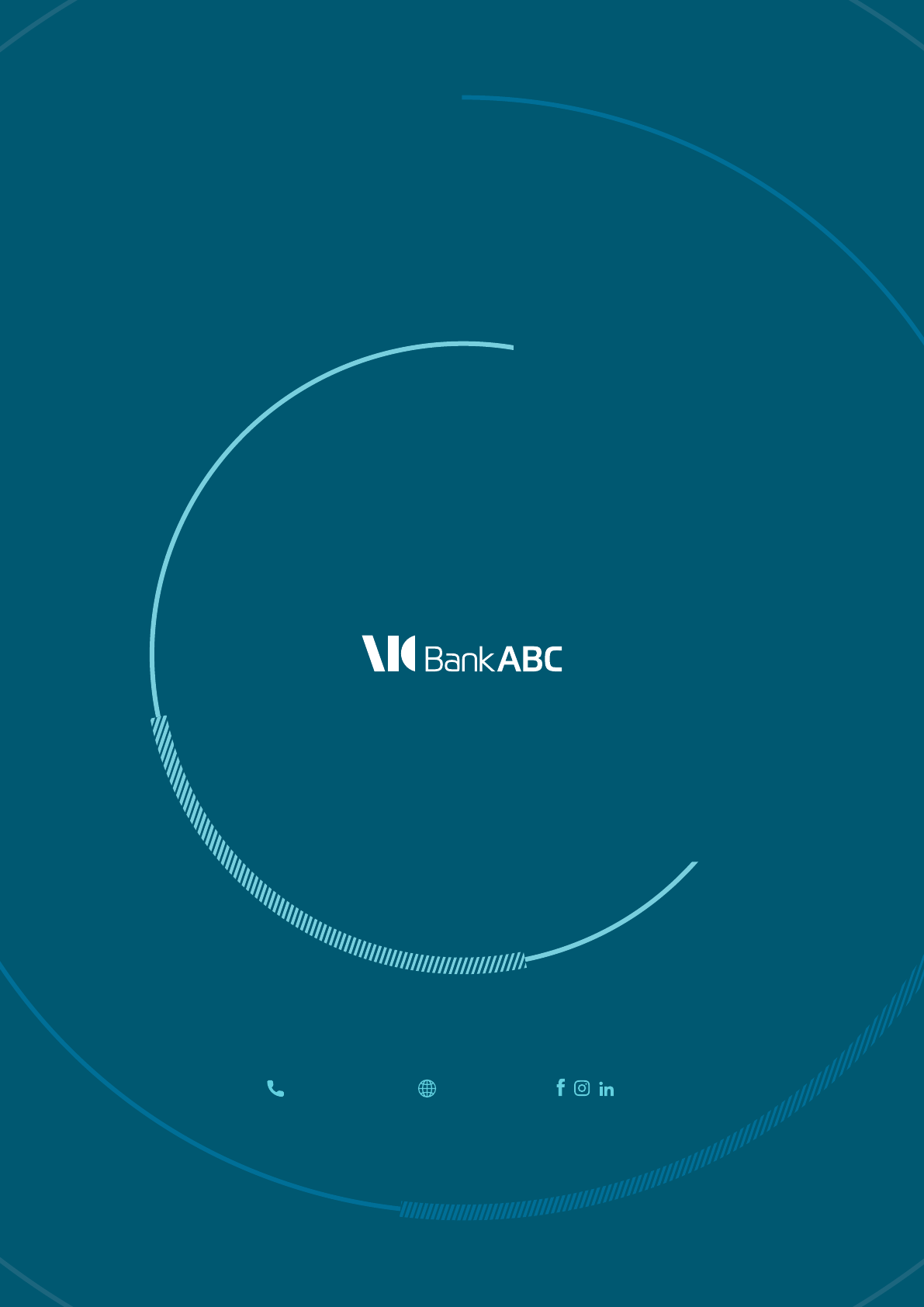
+962 6 5633 500 bank-abc.com @BankABCJordan
